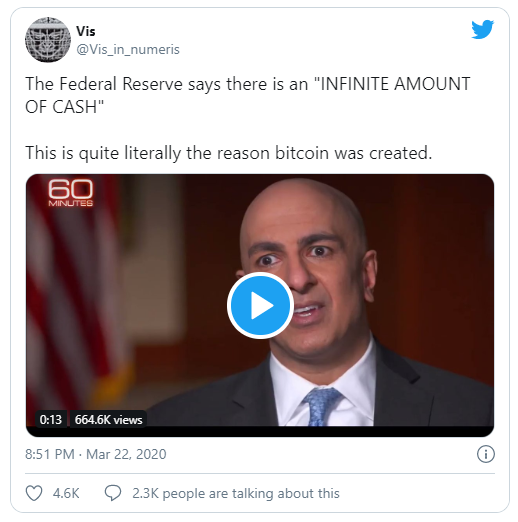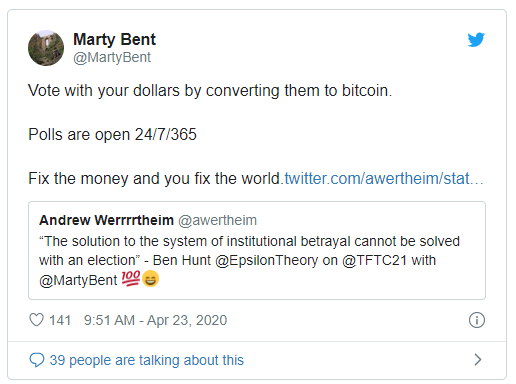 WORDS is a monthly journal of Bitcoin commentary. For the uninitiated, getting up to speed on Bitcoin can seem daunting. Content is scattered across the internet, in some cases behind paywalls, and content has been lost forever. That’s why we made this journal, to preserve and further the understanding of Bitcoin.
WORDS is a monthly journal of Bitcoin commentary. For the uninitiated, getting up to speed on Bitcoin can seem daunting. Content is scattered across the internet, in some cases behind paywalls, and content has been lost forever. That’s why we made this journal, to preserve and further the understanding of Bitcoin.
Donate & Download the April 2020 Journal PDF
Remember, if you see something, say something. Send us your favorite Bitcoin commentary.

Cover Art by Van
A big thank you to Van for allowing me to use your work on the cover of this month’s journal. Van is part of the crypto art movement and is exploring digitally scarce artwork through NFT platforms. Visit Van’s website for more information.
Van is a digital artist and graphic designer from Italy with an interest in abstract digital art, whose work showcases new ways to mix and blend design and art with a touch of bright contrast colors.


The Political Theology of Bitcoin
By Erik Cason
Posted March 29, 2020
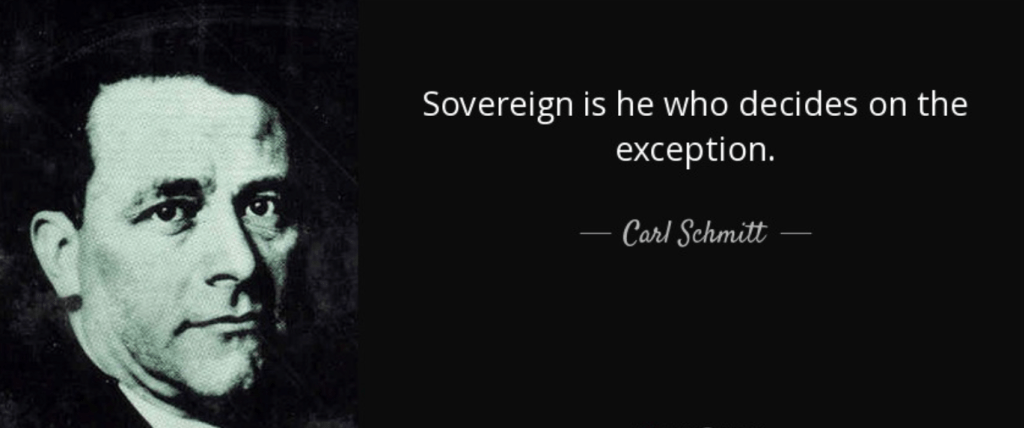
This is the famous opening statement of Political Theology: Four Chapters on the Concept of Sovereignty published by Carl Schmitt in 1922. This statement offers the fundamental axiom of how all sovereign power functions, and how the sovereign exception found in emergency legal decrees allows for any sovereign to overcome and dispose of the law. In the essay the political theology of crypto I explain how cryptography negates the possibility of the sovereign exception through the banishment physical and identifying power, which thereby erodes all forms of contemporary state and legal power. I have also wrote an essay on how the metaphysical tensions between any sovereign and any subject will always result in a power dynamic that where the sovereign decision will always over come any law in times of sincere crisis or emergency, and how cryptography negates this form of power. In this essay I would like to expound more deeply upon the explicit theology of bitcoin, its formula of power, and what it means for the fate of humanity in these darkest of times.
Bitcoin as Subjectivity
While bitcoin is inherently an object of war, it is also an object of art. Art because it is only an expression–an object of non-tangibility, and subjective individual human values according the society we live within. However, through a Hegelian synthesis of art and war; bitcoin spills out from the noosphere as a damnation of all fiat currencies of the world of flesh and steel, and the redemptive answer we seek to rescue and restore law, economy, and order from these crises forced upon them. Through the power of cryptography, and the systems of truth that it demands; Bitcoin expresses a form of truth that no human, institution, or organization is any longer capable of anywhere the physical realm or legal jurisdictions.
This artistic power of war that bitcoin harnesses comes from a totalizing deterritorialization and reterritorialization (in the Deleuzian sense of the word) of the global order through the initiation of a new plane of immanence based upon cryptographic power. This plane of immanence is the renewal of a nomos (law, customs, or social cohesion) of humanity with the internet at its organizational core, and truth as the form of legitimacy. It is a novus ordo seclorum where truth, not authority, becomes the renewed source of legitimacy for all people everywhere. Through the exchange of the legitimacy of power through the sacrifice of authoritarian decrees for the truth of what is, bitcoin inverts the sovereign formula of power.
Both Schmitt and Agamben, two of the leading scholars on the philosophy of sovereignty, define sovereignty as a boarderline concept that is traced throughout the theory of the state. Both conclude that sovereignty finds its foundation in the authentic decision that IS the sovereign exception of the law (also know as ‘a state of emergency’ or ‘sovereign crisis’), not the norm. Schmitt surmises this as, “‘All law is situational law.’ The sovereign produces and guarantees the situation in its totality. He has the monopoly over this last decision.”
This is of great importance because it is through the sovereign exception found in emergency decrees all state law is doomed to the fascism inherent to it. There is no bearing or trace of truth in the sovereign exception; only the raw authoritative power that will justify any legal exceptions. The great father of the theory of the state himself, Thomas Hobbes surmised this in Leviathan rather flippantly as;
“Auctoritas, non veritas facit legem (authority, not truth makes legitimacy)”
Schmitt, whom is among the most esteemed of legal scholars on Hobbes and his theory of the state, further surmises this point of how authority functions within the sovereign exception:
“The exception, which is not codified in the existing legal order, can at best be described as a case of extreme peril, a danger to the existence of the state… It is truly a matter of extreme emergency and how the emergency can be eliminated… From the liberal constitutional point of view, there would be no judicial competence at all. The most guidance the constitution can provide is to indicate who can act in such a case… He [the sovereign] decides if there is an extreme emergency as well as what must be done to eliminate it. Although he stands outside of the normally legally valid system, he nevertheless belongs to it, for it is he who must decide weather the constitution needs to be suspended in its entirety… Whether one has confidence and hope it can be eliminated depends on philosophical, especially on philosophical-historical or metaphysical convictions.” Carl Schmitt, Political Theology p. 7
Bitcoin as Philosophical Conviction
Bitcoin is the philosophical cognition of a world that has lost its nomos, where truth no longer a fact, but an opinion of power. Only in a world where seditious guile rules opening, where money is but a tool for the politically powerful, does bitcoin present its radical antithesis to the current paradigm of law, order, and sovereignty. It is the fulfillment of a crypto-anarchist critique of state, money, and legal power.
It is this philosophical conviction–particular the philosophical-historical cognition of what cryptography is, how it was developed for total war, and what its development throughout the concourse of human history means; that we find a categorical imperative from which the sovereign exception can be totally and completely eliminated. Through the linguistic form that is cryptography; a demand is created that can only be answered in binary form of ‘yes, yes,’ or ‘no, no,’ and nothing else. It is a formula of true / false statements of output ownership protected by the magnanimity of cryptography, which creates the timechain of bitcoin, and the fulfillment of bitcoin’s oath to the cryptography that concretes it.
The sovereign legal form glitches out before naked truth and the total silent obligation that is the secret of all state power, arcana imperii:
“The obligation of subjects to the sovereign is understood to last as long, and no longer, than the power lasteth by which he is able to protect them. For the right men have by nature to protect themselves, when none else can protect them, can by no covenant be relinquished.” -Thomas Hobbes, Leviathan
A world that has lost its nomos is a world where no sovereign power, institution, or government can offer even the most basic protections or assurances that comprises of the dignity of life. While the law is suppose to be the fulfillment of the most basic promise of the social contract by the sovereign, we have entered into a territory where no such promise exist. The law today is little more than authoritarian approvals, appeals, rules, and decrees; lacking even the most basic contractual functions. Through the broken oaths of sovereign powers everywhere towards the most basic aspects of the social contract; all people everywhere have been forsaken, the truth of their laws and their justice corrupted in every way.
In this darkest of nights however, there is a spectacular gem of truth from which light gleams and points towards our exit from this hollowed and damned place. Bitcoin and the cryptographic breakthroughs that it has ushered in over the last decade offers us a totally new and novel strategy of human organization that breaks out of the sovereign form and can restore law, order, and economy to their rightful places. As Foucault warned us, “In political and social theory, we still have not cut off the king’s head.”
Bitcoin and cryptography is a form of power that is beyond any physical force and the brutishness of any form of authoritarianism for the very real truth it must contain in order to function, and the very real protection that the cryptography it contains offers. Bitcoin is the premonition of an idea whose time has come; of a humanity that is ready to rise to its task of the abrogation of the statism, and to restore the political to its rightful place at the forefront of any law.
Bitcoin is a new form of political, economic, and moral organization that raises truth to being the only sacrosanct of any law. It is the philosophical cognition of a world that understands the insipid greed of men, and the infinite vice that is power. Bitcoin has enables a new form of digital organization that banishes the prattling lies of men, and demands the proof of any claim. Bitcoin does this through returning truth to its preeminent place as the foundation of all social contracts, and the meaning of truth in such agreements through the cryptographic formula of verification.
Bitcoin as Political Theology
At the very end of Political Theology, Schmitt of all people, provides us with an anarchist’s critique of any sovereign decision by the very virtue of what any decision by a sovereign power must be and how it is decided:
“Every claim of decision must be evil for the anarchist, because the right emerges by itself if the immanence of life is not disturbed by such claims. This radical antithesis forces him of course to decide against the decision; and this results in the odd paradox where Bakuin, the greatest anarchist of the nineteenth century, had to become in theory the theologian of the antitheological, and in practice the dictator of an antidictatorship.” Carl Schmitt, the final paragraph of Political Theology
It is this radical antithesis that has us also decide against the decision as well. We are products of the late 20th century; grandchildren of the spectacle society where all forms of life that would not be subjected to the machine were liquidated long ago. Now under the grimace of the total corruption of law, the complete looting of the treasuries of all peoples by political and corporate oligarchies everywhere from ’emergencies’ of their own creation; we find the reason for us to rise against, and choose to reclaim that which is only ours. This the reactivation of the political as the struggle for life, and the right to die trying; opens the truly political (polis) once again.
We understand how Bitcoin makes for the oddest of paradoxes; with anarchism becoming in theory the greatest form of ‘capitalism’ against all states, and in practice, a dictatorship of privacy and pseudonymity which unrelentingly will not give itself to anyone but the individual.
Bitcoin rings with a thunderous crack, “Vires In Numeris” and becomes more powerful and fervent with each seeker that we convert. It is a political theology that restores truth as the final weapon against a system of lies, fear, and exploitation to renew the nomos of humanity, and for us all to discover that there is still a political to be claimed, but only for those who are willing to take the risk.
The Revolutionary Truth Hidden in Bitcoin
Having witnessed the twilight of humanity befall idiotic and empty slogans under the barbarism of statism’s vacant chanting of idiotic lies; the spectacle has envelopes all. In all of its grandeur of stupidity and lobotomization, state capitalism has fused with the totalitarian eye of the internet; idiotically unaware of the beast it was unleashing, the prophecy it was fulfilling.
From the very outset, we can see the fundamental contradiction between the idea of sovereignty and the functions of cryptography. Cryptography is completely unanswerable to any sovereign power, as it lack the capacity to understand anything beyond its binary language of true or false, nor does it capitulate to any form of violence. The only laws that cryptography understands are the laws of mathematics which animates their functions.
By the very nature that no sovereign power can overcome the laws of mathematics that animate cryptographic systems, it points to the very nature of what crypto is and its hidden encrypted meaning. There is no emergency, war, pandemic or crisis that can stop bitcoin. Now there is only the real state of emergency to be introduced, and the final struggle in which we take our rightful place as the owner of ourselves, our political systems, and our wealth for those whom we hodl in common.
This is the political theology of Bitcoin, the radial promise of a machine of truth that can only speak in a binary of true or false, documenting its own claims of just that. From the outset of the creation of the timechain of Satoshi’s; Bitcoin has been nothing more than a mechanization of truth-telling of what address owns what bitcoin, and how many joules of energy were used to produce those bitcoins.
With each block that is built on the bitcoin timechain, it resounds and echos louder and louder against the backdrop of man and his fallen world of lies, deception, and deceit. Only in a time where man has become an insipid beast of guile and sophistry, where politicians and gangsters openly fraternize and discuss how to rape the world with no consequence to themselves, does the theology of bitcoin and the promise it cointains move from revolutionary to messianic.
There is no longer any government anywhere that can offer the same promise as that of Bitcoin does. There is no central bank, no commodity form, no currency, no ‘crypto‘ outside of bitcoin that can offer the same assurances or security as bitcoin. The theological promise of bitcoin is that there will never be more than 21 million coins, and that there is no way to alter the supply schedule, or know exactly who owns what outputs. It is a new social contract based upon the inverted form of the sovereign dictum, with truth–not authority–being the legitimate maker of the law that is bitcoin’s blockchain.
In a world where governments across the globe have promised to create infinite monetary units, swore everlasting loyalty to corporations and melomaniacs before their own citizens; the only thing left to do is refuse their broken social contract they call law, and create new ones better and more fitting for our times. Through the power, glory, and grace that is bitcoin, and for the magnanimous promise that Satoshi Nakamoto has delivered to us; bitcoin is the theological answer to the crises of our time. Its heliotropism directs us towards a world where we use cryptographic systems to verify the truth of all things, and utilize such a power to renew and recreate our systems of liberty and justice for all.
Satoshi Nakamoto’s promise of a money that does not change for the light and transient causes of mortals, nor bend to the callous and pathetic will of politicians around the planet has given us a light to follow in these darkest of times. It is the oath of the cryptographic machine to itself, and its total intransigence to change for any crisis, emergency, or state of exception. Though this most wonderful and theological of tasks, Satoshi Nakamoto has created the machine of economic redemption that we need to renew our world, to free ourselves from the chains of debt and bondage that governments around the globe have forced on to all of us. It is a method to renew the social contract to its original form, and what the promise of a social contract under the rubric of truth really means.
“Every man having been born free and master of himself, no one else may under any pretext whatever subject him without his consent.” –Jean-Jacques Rousseau, The Social Contract, 1762
Bitcoin Correlation to Gold Jumps in 2020
By Gabor Gurbacs
Posted April 3, 2020
Quick take:
- Long-term, bitcoin correlations with traditional asset classes remain low.
- Short-term, the market sell-off induced by the COVID-19 pandemic increased bitcoin correlations with traditional asset classes—particularly gold, potentially hinting at bitcoin’s increasing safe-haven status.
- A small bitcoin addition to a 60% equity/40% bond blended portfolio significantly reduced portfolio volatility during the recent market sell-off. While there are no U.S. bitcoin ETFs available today, we believe such products may have significantly reduced volatility for 60% equity/40% bond blended portfolios.
Our analysis shows that bitcoin correlation to gold remains low long-term. However, during the most recent COVID-19 induced broad market sell-off, bitcoin correlation to gold has increased significantly.
Bitcoin’s Correlation to Gold
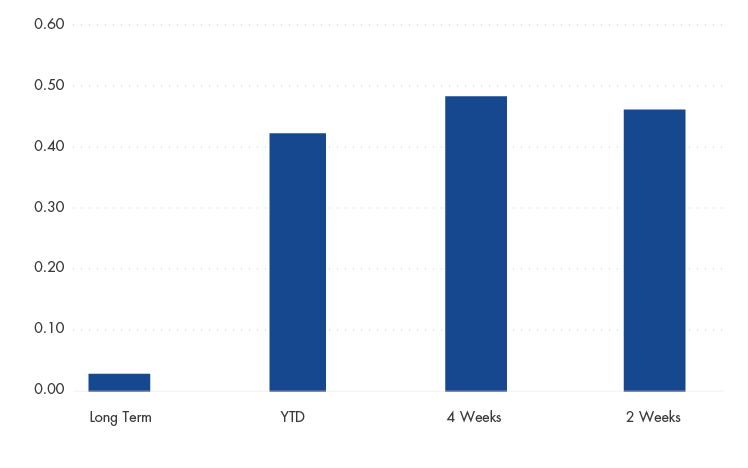
In The Investment Case for Bitcoin, we discussed how bitcoin may potentially increase portfolio diversification because of its low correlation to traditional asset classes, including broad market equity indices, bonds and gold. As shown in our year-end long-term correlation table, this thesis has held up well. Here we examine bitcoin’s correlation to traditional asset classes during the most recent COVID-19 induced market downturn and the months leading up to it. In our long-term study, considering correlation data between 2012 and late March 2020, bitcoin exhibits low correlation to traditional asset classes. Bitcoin falls into the -0.1 and 0.1 correlation range with most traditional asset classes.
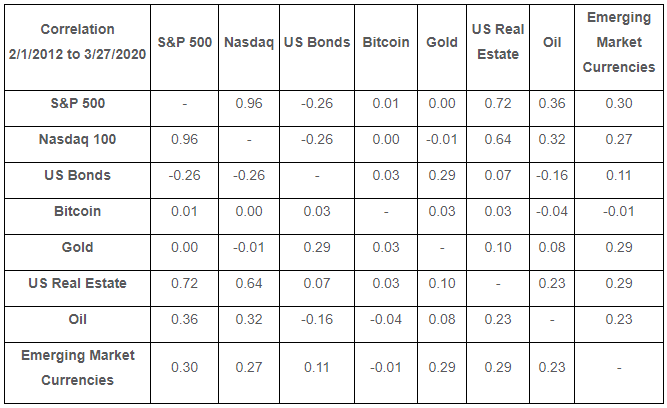
Looking at more recent correlation data, we note that bitcoin’s correlations with traditional asset classes have begun to increase during the COVID-19 induced global market sell-off. Most notably, bitcoin’s correlation with gold has reached levels never before seen. We believe this may further cements its relationship with what is commonly viewed as safe haven assets and may bolster its potential as “digital gold”. We also note that bitcoin correlations with U.S. bonds increased significantly. U.S. bonds historically served as safe-haven assets during equity market sell-offs. Specifically, from March 13 to 27, bitcoin’s correlation with gold was 0.47 and 0.13 with U.S. bonds while -0.25 with the S&P500, -0.18 with the Nasdaq 100 and only -0.12 with US real estate. Bitcoin showed no correlation with emerging market currencies and 0.15 with oil.
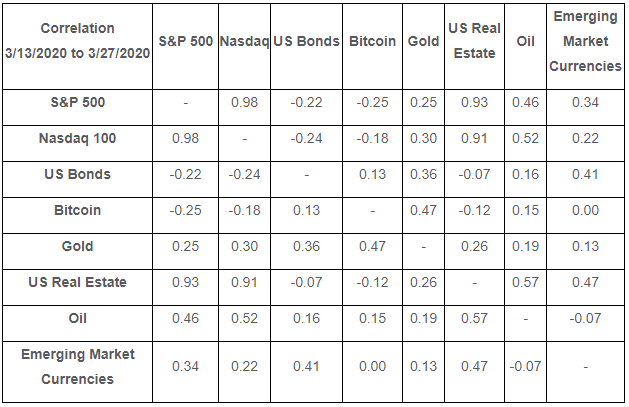
After expanding that timeframe to four weeks, bitcoin’s correlation with gold was 0.49, 0.17 with U.S. bonds, 0.15 with the S&P 500, 0.19 with the Nasdaq 100 and only 0.18 with U.S. real estate. Bitcoin showed a 0.31 correlation with emerging market currencies and 0.27 with oil.
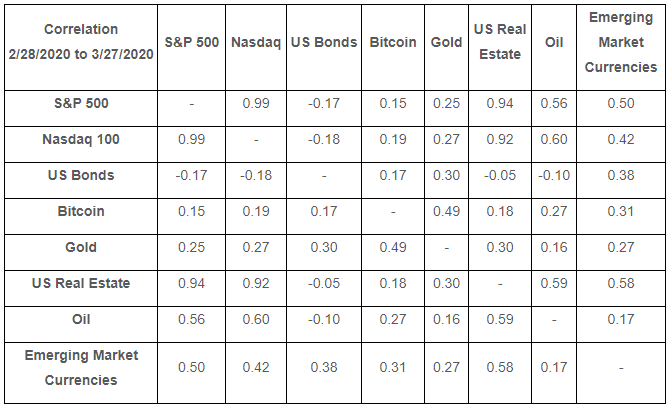
Year to date, bitcoin’s correlation with gold was 0.42, 0.13 with U.S. bonds, 0.13 with the S&P 500, 0.16 with the Nasdaq 100 and 0.15 with U.S. real estate. Bitcoin showed a 0.29 correlation with emerging market currencies and 0.29 with oil.
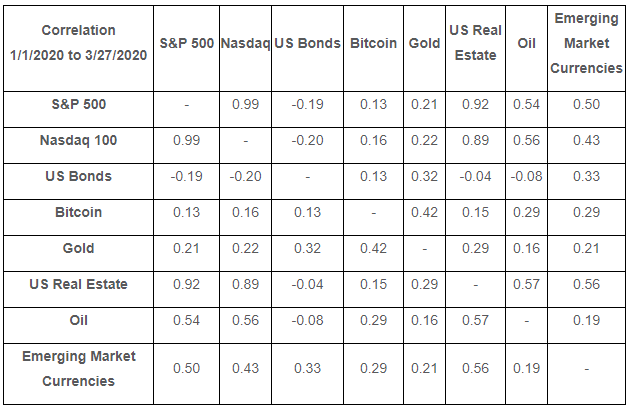
We also looked at the proportional addition of a 0.5%, 1% and 3% allocation to bitcoin to a 60% equity/40% bond blended portfolio. While YTD portfolio performance with a bitcoin allocation only held up slightly better than the 60-40 blend, we noted that a small addition of bitcoin significantly reduced the volatility (as measured by standard deviation) of the 60-40 blend.
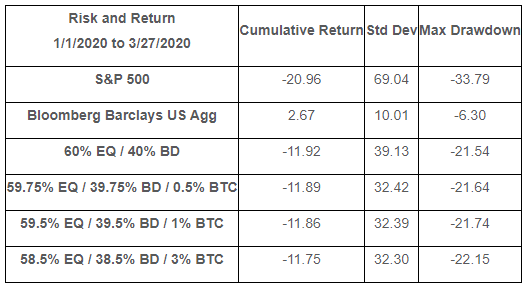
During the market selloff beginning on 2/20/2020, we saw that the volatility reduction of the bitcoin-included blended portfolio was even more pronounced than YTD figures.
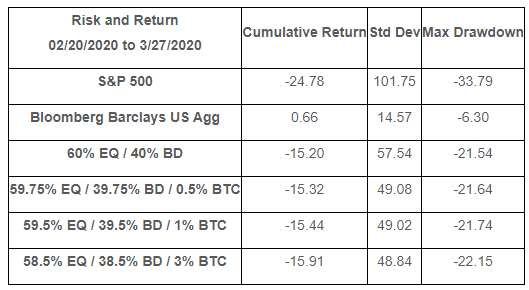
We conclude that while long-term bitcoin correlations with traditional asset classes remain low, in the short-term, the COVID-19 induced market sell-off increased bitcoin correlations with traditional asset classes. In particular correlations with gold increased during the sell-off, potentially hinting to bitcoin’s increasing safe-haven status. We also note that a small bitcoin addition to a 60% equity/40% bond blended portfolio may help to reduce portfolio volatility during the recent market sell-off. While there are no U.S. bitcoin exchange traded funds (ETFs) available today, we believe such products may have significantly reduced volatility for 60% equity/40% bond blended portfolios.
Source for all tables: Morningstar. US Bonds is measured by the Bloomberg Barclays US Aggregate Index; Gold is measured by the S&P GSCI Gold Spot Index; US Real Estate is measured by the MSCI US REIT Index; Oil is measured by the Brent Crude oil spot price, Emerging Market Currencies is measured by the Bloomberg Barclays EM Local Currency Government Index.
DISCLOSURES This is not an offer to buy or sell, or a solicitation of any offer to buy or sell any of the securities/financial instruments mentioned herein. The information presented does not involve the rendering of personalized investment, financial, legal, or tax advice. Certain statements contained herein may constitute projections, forecasts and other forward looking statements, which do not reflect actual results, are valid as of the date of this communication and subject to change without notice. Information provided by third party sources are believed to be reliable and have not been independently verified for accuracy or completeness and cannot be guaranteed. The information herein represents the opinion of the author(s), but not necessarily those of VanEck. All indices are unmanaged and include the reinvestment of all dividends but do not reflect the payment of transactions costs, advisory fees or expenses that are typically associated with managed accounts or investment funds. Indices were selected for illustrative purposes only and are not securities in which investments can be made. The returns of actual accounts investing in natural resource equities, energy equities, diversified mining equities, gold equities, commodities, oil, industrial metals, gold, U.S. equities and U.S. bonds strategies are likely to differ from the performance of each corresponding index. In addition, the returns of accounts will vary from the performance of the indices for a variety of reasons, including timing and individual account objectives and restrictions. Accordingly, there can be no assurance that the benefits and risk/return profile of the indices shown would be similar to those of actual accounts managed. Performance is shown for the stated time period only. The S&P® 500 Index: a float-adjusted, market-cap-weighted index of 500 leading U.S. companies from across all market sectors. The Bloomberg Barclays U.S. Aggregate Bond TR Index: is a broad-based benchmark that measures the investment grade, U.S. dollar-denominated, fixed-rate taxable bond market. The index includes Treasuries, government-related and corporate securities, MBS (agency fixed-rate and hybrid ARM pass-throughs), ABS and CMBS (agency and non-agency). The Bloomberg Barclays EM Local Currency Government TR Index: is a flagship index that measures the performance of local currency Emerging Markets (EM) debt. Classification as an EM is rules-based and reviewed annually using World Bank income group, International Monetary Fund (IMF) country classification and additional considerations such as market size and investability. The MSCI US REIT Index: is a free float-adjusted market capitalization index that is comprised of equity REITs and represents about 99% of the US REIT universe and securities are classified in the Equity REITs Industry (under the Real Estate sector) according to the Global Industry Classification Standard (GICS®). It however excludes Mortgage REIT and selected Specialized REITs. The S&P GSCI Gold Index: Is a sub-index of the S&P GSCI, provides investors with reliable and publicly available benchmark tracking the COMEX gold future. The index is designed to be tradable, readily accessible to market participants, and cost efficient to implement. The MVIS CryptoCompare Bitcoin Index measures the performance of a digital assets portfolio which invests in Bitcoin. The MVIS CryptoCompare Bitcoin Index is the exclusive property of MV Index Solutions GmbH (a wholly owned subsidiary of the Adviser). The NASDAQ-100 Index includes 100 of the largest domestic and international non-financial companies listed on The NASDAQ Stock Market based on market capitalization. All S&P indices listed are products of S&P Dow Jones Indices LLC and/or its affiliates and has been licensed for use by Van Eck Associates Corporation. Copyright © 2018 S&P Dow Jones Indices LLC, a division of S&P Global, Inc., and/or its affiliates. All rights reserved. Redistribution or reproduction in whole or in part are prohibited without written permission of S&P Dow Jones Indices LLC. For more information on any of S&P Dow Jones Indices LLC’s indices please visit www.spdji.com. S&P® is a registered trademark of S&P Global and Dow Jones®is a registered trademark of Dow Jones Trademark Holdings LLC. Neither S&P Dow Jones Indices LLC, Dow Jones Trademark Holdings LLC, their affiliates nor their third party licensors make any representation or warranty, express or implied, as to the ability of any index to accurately represent the asset class or market sector that it purports to represent and neither S&P Dow Jones Indices LLC, Dow Jones Trademark Holdings LLC, their affiliates nor their third party licensors shall have any liability for any errors, omissions, or interruptions of any index or the data included therein. All investing is subject to risk, including the possible loss of the money you invest. As with any investment strategy, there is no guarantee that investment objectives will be met and investors may lose money. Diversification does not ensure a profit or protect against a loss in a declining market. Past performance is no guarantee of future results
Money Printer Go Brrrrr: Bitcoin’s Solution to the Federal Reserve
By Conner Brown
Posted March 31, 2020
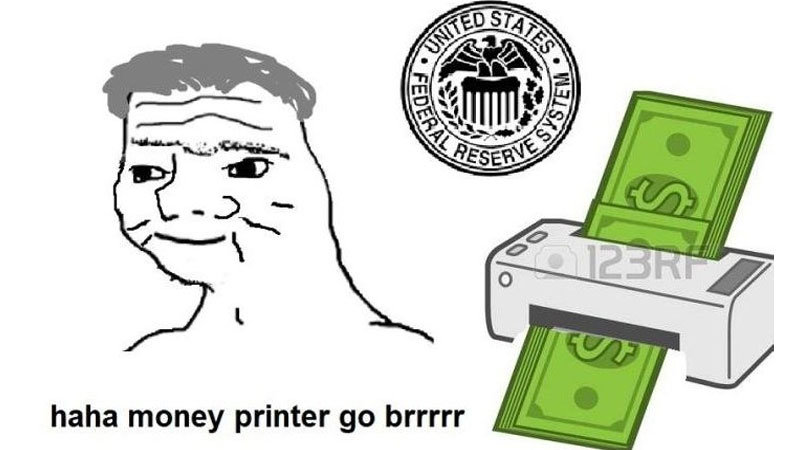
Money printing is an age-old problem. History is littered with societies that attempted to print their way into prosperity. Despite lessons from the past, this confusing ritual still continues to this day, courtesy of central banks like our Federal Reserve.
As a solution to the damage dealt by money printing, Bitcoin was born. In the depths of the financial crisis, Satoshi Nakamoto created Bitcoin as an alternative to the broken monetary system. Bitcoin was designed with a hard cap of 21 million coins which will be mined over the coming decades.
We are witnessing a second serious financial crisis now sparked by the coronavirus. Stocks are in free fall, currencies are swinging wildly, and credit markets are frozen. In an attempt to calm the financial system, the Federal Reserve has been printing money like never before.
What began with a few billion dollars has now morphed into trillions of dollars per month in “liquidity injections,” quantitative easing, and credit facilities. On top of this, Washington is pumping in trillions of fiscal stimulus.
Meanwhile, Bitcoin’s monetary policy remains untouched and as strong as ever.
For someone without a finance background, the actions by authorities may appear confusing and arcane. Where exactly does this government money come from? This article aims to clear that up. I’ll begin with a breakdown of how money printing works in the legacy financial system and then compare that to Bitcoin’s solution.
A Peek Behind The Federal Reserve’s Curtain
The Federal Reserve System (“Fed”) is our Central Bank. It is operated by a series of twelve Regional Reserve Banks with economists and financiers who follow the decisions of its leadership, the Board of Governors.
It is often said that the Fed can “print money” — however, this is not spinning up the printing presses and putting that money into the hands of whoever wants it. The process is a bit more involved.
First, remember most dollars are not physical. Physical banknotes are only a small amount of money in circulation and are created by the U.S. Treasury at the discretion of Regional Reserve Banks. Most of the time, money is created in the Federal Reserve System with a stroke of a keyboard.
So how exactly does the Federal Reserve print these digital dollars? The secret lies in its balance sheet. To explain, let’s quickly review some accounting basics.
A balance sheet is a record of the assets and liabilities of an entity. For example, a business may have assets such as: cash, inventory, and property. It’s liabilities would be: rents, loans, wages, etc. The balance sheet is a snapshot that records these totals and ensures a company is properly managing its budget.
Banks also have balance sheets. On the assets side of their balance sheet, banks have generally have: cash (known as reserves), loans (the expectation of future payments), and financial instruments such as bonds. On the liability side, banks have: deposits (money to be paid upon request) and equity. This is how banks make new loans. When a borrower needs a loan, the bank will place virtual dollars in their account and record that transaction as both an asset (the expected repayment of the loan) and a liability (deposits).
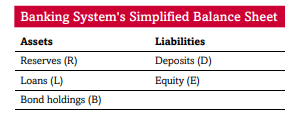 Credit: Paul Sheard, Chief Global Economist of Standard and Poor’s
Credit: Paul Sheard, Chief Global Economist of Standard and Poor’s
So, if new credit is both an asset and liability, what stops banks from making unlimited loans? Capital Requirement Ratios. These are rules and regulations that prevent banks from expanding their balance sheet and taking on excess risk and lending.¹
Central banks hold the money of commercial banks, and they also have a balance sheet. On their balance sheet they have assets on one side such as government bonds and cash, and reserves on the other which is where commercial banks have parked their money.
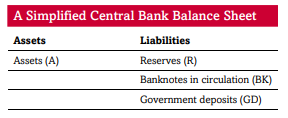 Credit: Paul Sheard, Chief Global Economist of Standard and Poor’s
Credit: Paul Sheard, Chief Global Economist of Standard and Poor’s
Now, what’s special about the Federal Reserve is that their balance sheet is unlimited. They can buy as many government securities as they want at any price and simply place it on their balance sheet.
For example, lets say the value of mortgages fell by 40% and banks need a boost. The Federal Reserve can bail them out by buying those mortgages at whatever they deem to be the “correct” price and placing them on their balance sheet. It’s that simple. And this is exactly what happened in 2008 when the Federal Reserve purchased over $600 billion of government-insured Mortgage-Backed Securities to artificially increase the value of mortgages (and thereby reduce the cost of borrowing).
That program was just the beginning. Over the past decade, the Federal Reserve has purchased trillions of dollars of government securities and placed them on its balance sheet. This has, in effect, manipulated markets and monetized the U.S. national debt. Below is a chart of the Federal reserves total assets on its balance sheet. After an initial jump in 2009, it has continued to make new highs for a decade.
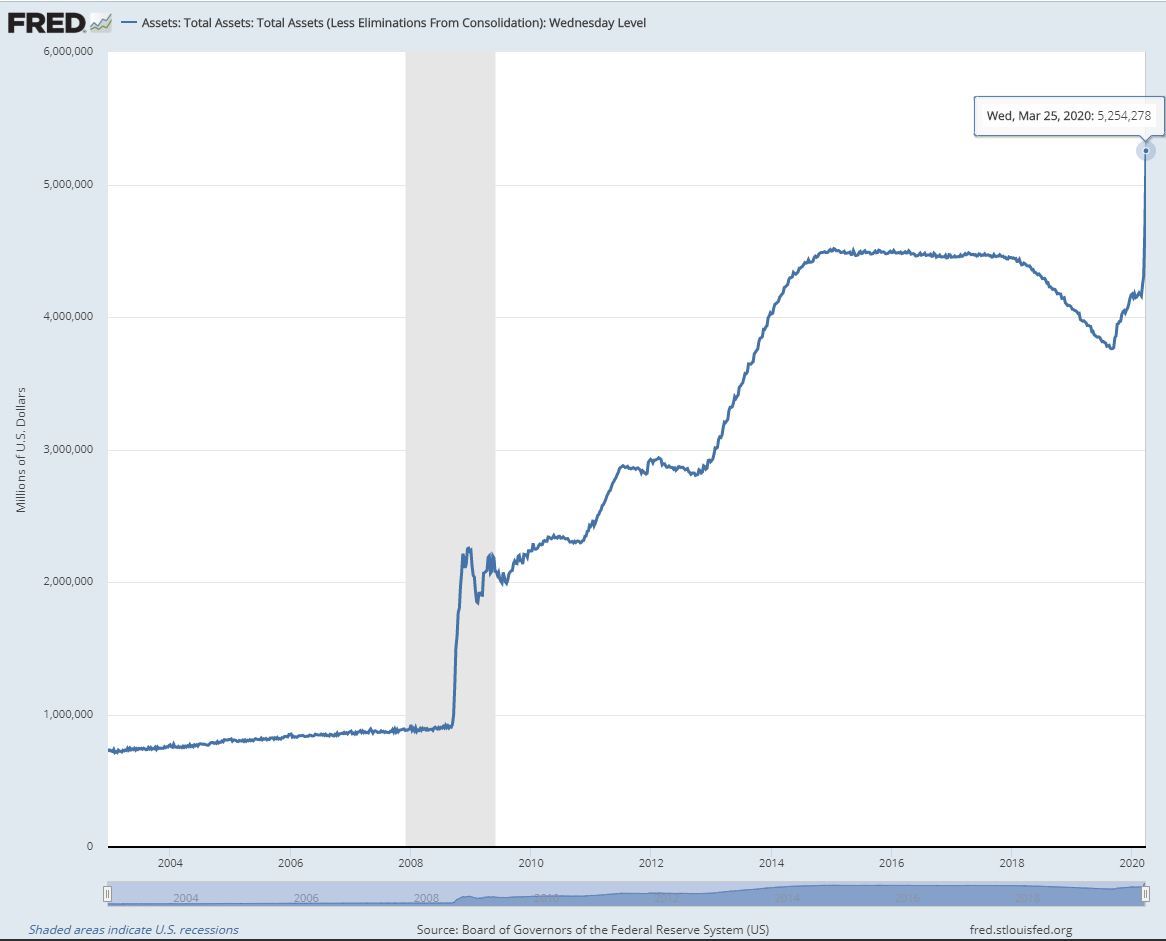
The latest spike is due to the variety of programs the federal reserve has instituted to prop up markets. Just last week, the Federal Reserve stated it will purchase $625 billion per week in government securities and established multiple special (questionably) legal vehicles to purchase commercial paper, asset-backed securities, and corporate bonds. All of this will go onto the Federal Reserve’s infinite balance sheet to 1) bail out institutional investors that took on too much risk, and 2) pay for trillions of dollars of stimulus from the federal government.
Each addition is printing money. Full stop. And as the Federal Reserve has just assured us on national television, “there’s an infinite amount of cash at the Federal Reserve.”
While these actions may provide short-term stability, like any stimulant, they bring a nasty set of side effects:
- Asset price inflation and wealth inequality from cheap debt. As the money printing pushes the costs of borrowing artificially low, corporations have taken on massive amounts of low-interest debt to finance trillions in stock buybacks. The stock indexes have increased several hundred percent while economic growth has been lackluster causing massive inequality and social unrest. This phenomenon, where those closest to newly created money see disproportionate benefits, is known as the “Cantillion Effect.”
- Economic stagnation by protecting poorly managed firms. Bailouts prevent capital to be reallocated to more sophisticated and careful management. This rewards poor decisions and and creates unproductive zombie companies which linger for years. For reference, see Japan’s Lost Decade and the sluggish economic growth of the past 10 years.
- Erosion of purchasing power by devaluing the US dollar. As money is printed and currencies lose their value, this most severely impacts the savings of average citizens. This punishes people who use their money as a savings vehicle and creates strong incentives for excessive consumption.
- Unsustainable deficits through manipulation of interest rates. As the Federal Reserve purchases trillions of government bonds, this drives interest rates below the natural rate. Thus, the government is able to borrow larger and larger amounts of debt at the cost of future generations.
- Systemic fragility by centralizing financial institutions. Printing money to bail out “too big to fail” banks, while letting smaller financial service providers go bankrupt, centralizes our financial system. With fewer competitors, this makes the remaining players even more powerful and fragile. This perverse system of incentives all but guarantees future bailouts down the road.
In the eyes of many concerned citizens with longer time-horizons than the upcoming election cycle, this is the wrong path. Sacrificing our future to pay for the present will only usher in an era of poverty and disrepair. Thankfully, Bitcoin provides another way.
The Bitcoin Solution
Bitcoin is a virtual currency created in 2008. What makes Bitcoin unique is that it is the first scarce digital asset without a centralized owner. The bitcoins are created, sent, and received over a peer-to-peer protocol without any intermediaries. Bitcoin uses a form of database called a blockchain which creates a linear history of changes to the ledger that cannot be undone. (For a technical introduction, see this video)
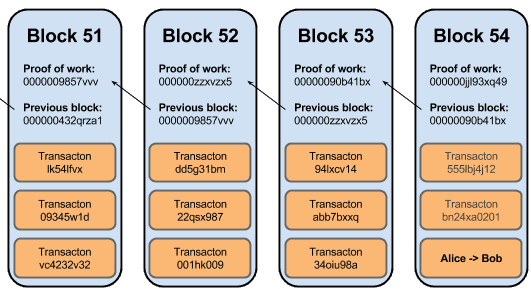 An image of the structure of Bitcoin’s blockchain.
An image of the structure of Bitcoin’s blockchain.
This linear history is created by a series of blocks of transaction data. These blocks are “mined” and propagated about every 10 minutes. Mining is a process where computers around the world compete to solve a math problem which generates the next block. Miners spending their computing power are compensated in newly minted bitcoins which are called “block rewards.”
The number of bitcoins for each block reward is based on a simple function. Every 210,000 blocks (approx. 4 years), the block reward is cut in half. For the first 210,000 blocks, the rewards were 50 bitcoin per block. At block 210,001 rewards were cut in half by the protocol to 25 bitcoins per block — which also cut the inflation rate in half. This event is known as a halving.
Soon, Bitcoin will enter into its 4th halving era where miners will receive 6.25 bitcoins per block. This process will continue until around year 2140, as shown below.
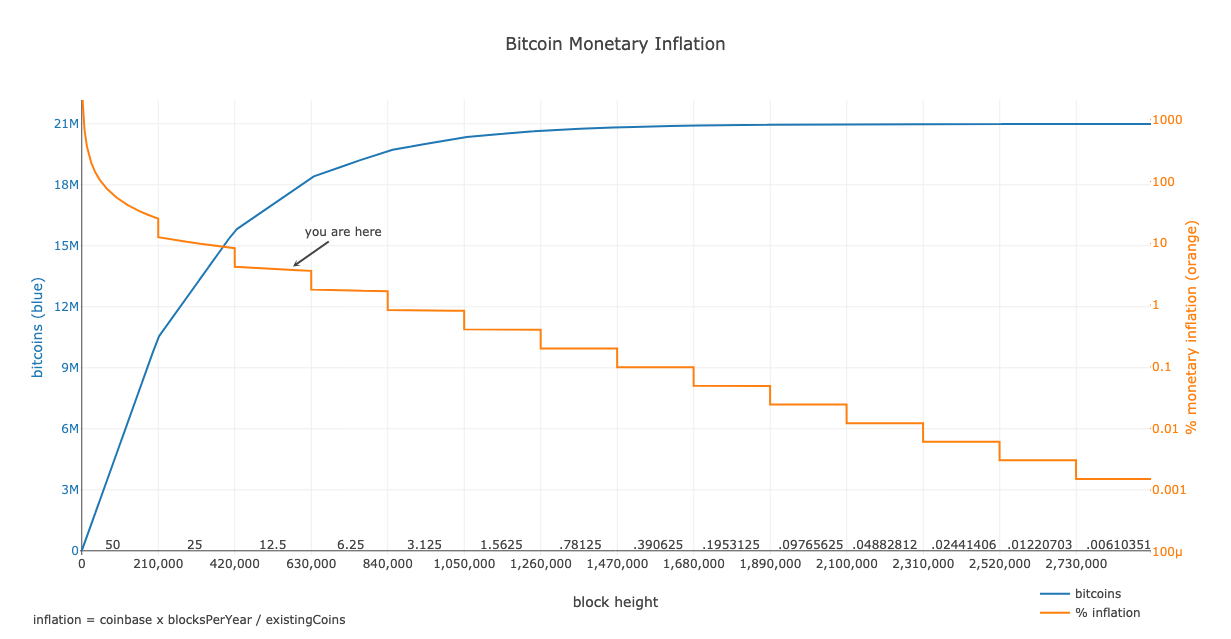
As you can see Bitcoin’s monetary policy is strictly set to 21 million coins. No more, no less. Because Bitcoin is decentralized, no entity can print money, bail out their politically-connected friends, or dilute the value of your time.
With a predictable supply, Bitcoin’s monetary policy is ideal for market participants. Under a Bitcoin standard, money no longer decays over time. Ordinary people would not have to invest in risky financial instruments to preserve their wealth. This brings profound benefits and motivates individuals to plan their future and protect their savings.
Money can also be thought of as a measuring stick of value. By having a steady measurement, Bitcoin allows prices to freely fluctuate to the supply and demand of the market. Powerful countries could no longer manipulate trade and currency to the detriment of the developing world. No country would have the luxury of global reserve currency status. This shift would cut out legions of financial middlemen and the world could speak one global language of value.
Conclusion
We are witnessing the late stages of a confidence game. Those in power can grease the palms of their friends at the expense of everyone else. It has brought decades of economic stagnation and inequality. While the future is far from certain, we now have an escape hatch. With Bitcoin, there is no lever. There is no committee. There are no printers. There is a level playing field of 21 million, cold, hard coins — and that’s the way it should be. A big thank you to my charming editor Karina.
Footnotes
- Note that this is commonly confused with “fractional reserve banking”. Fractional Reserve banking has not been in practice for quite some time. See, “Repeat After Me: Banks Cannot And Do Not ‘Lend Out’ Reserves” by Paul Sheard.
Controlling the narrative: how defining problems and framing causal stories of harm leads to immutable policy institutions
By Francis Pouliot
Posted April 5, 2020.
I graduated the M.A. Public Policy from King’s College London in 2012, and the following essay was my dissertation thesis. This essay focuses on the prohibition of cannabis as a case-study and covers the institutionalization of public policy. However, it can and should be applied to a much broader context, such as the Bitcoin blocksize wars, the so-called “climate emergency” and, more recently, the public responsive to the Covid19 outbreak. The goal of this essay is to help people dissect the different narratives being fed to them by the media.
INTRODUCTION
Since the publication of Erving Goffman’s influential _Frame Analysis _in 1974, the concept of frame as an analytical device in the public policy scholarship has gained tremendous popularity.
Developed as a response to the failures of the major forms of analysis, particularly the models of decision making centred around instrumental rationality, framing is about understanding how the way individuals make sense of complex political realities affects their decision making process. Ultimately, it is about making sense of the intersubjective nature of social experience and how it might affect the formulation of policy problems and the decision making process for solutions.
By focusing primarily on how political communication affects public opinion at the agenda setting stage of the policy cycle, we believe the explanatory powers of framing have been underexploited.
Moreover, framing remains to this day a “scattered concept”, from which no unifying analytical framework has managed to surface. We argue that framing provides a powerful explanation of the long-term stability of policies and their apparent immunity from change. We are concerned primarily with explaining the resistance of policies from critical evaluations and lack of bargaining and negotiating between the political actors advocating for policy change and the ones promoting the status quo.
The policy process can be conceived as an ongoing conflict between different interpretations of policy problems, in which actors attempt to make their definition of a particular problem the dominant one.
Policies, we argue, are embodiments of causal theories about how a problem will be solved. Problems, on the other hand, are construed in a political setting according a particular interpretation of the mechanism by which harm is inflicted from one set of individuals to another.
The existence of a policy is only justifiable to the extent that the mechanism by which it aims to solve the problem reflects the dominant definition of what the problem is and how it is brought about. When a frame becomes dominant, it limits the scope of acceptable solutions according to the criteria by which the problem is defined.
The purpose of this research is to elaborate an analytical framework from the concept of framing that can be used to identify the different frames present in a policy area, in a way that highlights why they are incompatible with each other. This will enable us to understand how framing can explain the long-term stability of existing policies.
The method by which the framework will be elaborated is by reviewing the different conceptions of framing and assessing their conceptual strengths and weaknesses. A conception of framing that centers around the construction of policy problems according to their causal interpretation will be argued to be the most conceptually adequate.
The new framework proposed by this research shows to which degree compromise between frames is possible and what precise characteristics of frames make them incompatible with others. The framework has been conceived as a hierarchical set of three mutually exclusive axioms of dichotomic value.
The fundamental causal story is the central novel axiom this research developed which combines the unanimously recognized criteria of frames and problem definitions, causality, with a new variable, the causal direction of harm. Not only does this axiom highlight how the frame supposes harm is being created, it clearly makes the distinction between harm created by individual behavior and harm created by policies.
The second axiom this research created was dubbed the precautionary approach to harm. The usefulness of this axiom is that it combines a vague and general criterion, the precautionary principle, and the perception of the substance of cannabis. This allows the framework to identify the specific explanation that frames imply for the justification of government control of cannabis.
The third axiom this framework uses is the criterion of intent of the harm creators. This research has argued that the normative criterion of intent is not sufficient to separate frames that otherwise share the first and second axioms to a degree that they will not support the same policy. Indeed, the perceived intent of the harm creators may lead the frame to support different policy goals, or may lead advocates of the frame to use a different rhetoric, but it will not lead to a change substantial enough to be considered a rupture of stability.
This framework will enable the analyst to identify the particular elements of problem definitions that make them incompatible with each other. This research will argue that long-term stability of policies will occur when the scope of political conflict is constrained by an institutionalized agreed upon problem definition to which the current policy is the only possible solution. To demonstrate how the framework can be used as an analytical device, we will apply it to the policy making process of the U.K.’s drug policy towards cannabis.
We will conclude that conflict in this policy area is limited between two competing frames, the Health and Safety and Harm Reduction frames, both of which define cannabis related social problems in a way that implies that prohibition is the only acceptable solution.
FRAMING THEORY: THE NATURE AND FUNCTION OF FRAMES
Many models of decision making that could explain the apparent non-rational behavior of actors in policy controversies have been developed. A large number of these models, according to Dye, assist us in understanding “why is the policy making not a more rational process”? Answering this fundamental question, Herbert Simon came up with the concept of bounded rational. It argues that individual choice “takes place in an environment of ‘givens’ — premises that are accepted by the subject as bases for his choice; and behavior is adaptive only within the limits set by these ‘givens’”. These “givens” frame the process of choice, and individuals operating without this “bounded rationality” are motivated by “satisficing, rather than maximising”, which means that they make decisions which are not derived from an examination of all the alternatives. On a larger scale, the rationality of the policy process is also bounded by such constraints. Understanding the nature of these constraints and the mechanism by which they limit the rationality of the policy process is fundamental goal of this research.
According to Rochefort and Cobb, the primary constraint on rational decision making in policy is “the intersubjective nature of social experience and its impact both on issue initiation and policy formulation”. This refers to the inability of different individuals to perceive, understand and make sense of the otherwise same objective reality. People experience the world through a lens, an organised system of belief, perception and appreciation, according to which they assign meaning to events, issues and occurrences. This “lens” is what has become commonly referred to as a frame.
The origin of frames can be traced to the concept of “schema”. Following major developments in neurology and psychology regarding the perception of stimuli and experiences by the human mind, notably from Henry Head’s Studies in Neurology (1920), _the german Gestalt Psychology school and Jean Piaget’s _The Language and Thought of the Child, the concept of schema emerged as a way of explaining how information, either as physical stimuli or social experience, is organized and managed by the human mind. Frederic Barlett used this concept to develop his theory memory as being constructive rather than consisting of the storage. From this follows the idea that an individual “has an overmastering tendency simply to get a general impression of the whole; and, on the basis of this, he constructs the probably detail”. The schemata, or frame, can be conceived as on organized set of criteria, much like a template, which guides how individuals fill the blanks.
The concept of the schema transcends scientific borders and derives its usefulness in the social sciences because the perception of the world is not an individual affair. It a great society, it is practically impossible to have such a proximity to an issue that we have all the information necessary to form an opinion, let alone all political issues. Instead, we receive information about the world primarily through communication with others and not through stimuli form our own senses. As human communication is primarily conveyed through language, the way that a phenomenon is talked about, that is the particular language used in the discourse surrounding that phenomenon, can influence how people come to think about it. Consequently, language that describes social problems can be manipulated tactically by actors of the policy process in order to influence how people view these problems, and potentially what solutions to these problems they will come to accept as adequate. This idea is eloquently expressed by Murray Eldeman in Constructing the Politcal Spectacle:
“The critical element in political maneuver for advantage is the creation of meaning: the construction of beliefs about events, policies, leaders, problems, and crises that rationalize or challenge existing inequalities. The strategic need is to immobilize opposition and mobilize support. While coercion and intimidation help to check resistance in all political systems, the key tactic must always be the evocation of interpretation that legitimize favoured courses of action and threaten or reassure people as to encourage them to be supportive or to remain quiescent […] It is language about political events, not the events in any other sense, that people experience; even developments that are close by take their meaning from the language that depicts them. So political language is political reality; there is no other so far as the meaning of events to actors and spectators is concerned”
From a policy process perspective, the use of framing as an analytical device can be traced back to sociologist Erving Goffman, who defined frames as a principle of organization “which governs the subjective meaning we assign to social events”. Von Gorp characterizes frames as organization principles that transform fragmented information into a meaningful whole, thereby selecting some parts of reality and omitting others. In media, a frame is “the central organizing idea for news content that supplies a context and suggest what the issue is through the use of selection, emphasis, exclusion and elaboration”. McCombs defines frames as the dominant perspective use to organize news presentations and personal thoughts about objects, delimited as a special sets of attributes about that object. Gamson and Modigliani argue that every policy issue has a culture, perpetuated by a discourse, which provides interpretative interpretations or packages. At the core of the package, they say, is a central organizing idea, the frame, that makes sense of events and suggest what is at issue. Schön and Rein describe framing as “a way of selecting, organizing, interpreting, and making sense of a complex reality to provide guideposts for knowing, analyzing, persuading and acting. A frame is a perspective from which an amorphous, ill-defined, problematic situation can be made sense of and acted on”. There is thus a shared understanding that frames are essentially ordering devices.
Initially, framing was developed to explain the disproportionate prominence of certain items on the political agenda relative to their observable importance, usually determined by the degree of harm to society they caused. It remains to this day one of the major theories of agenda setting. It was subsequently observed that the prominence of certain attributes of these issues and the way they were described had an effect of decision making. Robert Entman, in his 1993 essay Framing: Towards Clarification of a Fracture Paradigm, attempted to bring together the different conceptualizations of framing, in order to synthesize its disparate usage and construct a theory of political communication, by making explicit common tendencies. His synthesis of frames and framing has become somewhat of a standard definition. He defines the process of framing as “to select some aspects of a perceived reality and make them more salient in a communicating text, in such a way as to promote a particular problem definition, causal interpretation, moral evaluation, and/or treatment recommendation”.
FRAMING AS THE DEFINITION OF PROBLEMS
Entman’s four functions of framing — problem definition, causal interpretation, moral evaluation and treatment recommendation — are described as being independent of each other. He explicitly states that a frame may or may not perform these functions simultaneously. The methodology he proposes for analyzing political discourse involves assessing its different aspects according to these four functions. It makes the task of identifying the frames difficult, for it may lead to treat different aspects of a frame that perform different functions as distinct frames. For instance, arguments proposing moral evaluation or causal interpretation, while in reality being inextricably linked, may be analyzed as different frames. Moreover, there is also no frame that does not, either tacitly or overtly, imply some form of treatment recommendation: the cognitive and normative interpretation of a policy problem determine what should be done and how it can be done. In order to have a parsimonious and clear framework to identify frames and their distinct components, it is preferable to limit frames to the problem definition that they support.
Problem definition is a concept that has been developed on its own, without reference to framing, to the extent that it is now a very developed policy concept. Hogwood and Gunn provide us with an excellent definition of the concept from a public policy standpoint:
problem definition is “the process by which an issue (problem, opportunity or trend), having been recognized as such and placed on the policy agenda, is perceived by various interested parties; further explored, articulated, and possibly quantified; and in some but not all cases, given an authoritative or a least provisionally acceptable definition in terms of its likely causes, components and consequences”
The policy process is driven first and foremost by the recognition of a problem. The idea that some things are problematic and they can be fixed by human intervention is the most basic rationale of policy-making. Invariably, policy aims at the modification of human behavior. In the natural world, occurrences are “unintended, unoriented, unanimated, unguided, ‘purely physical’”. While we may understand the causation that leads to these occurrences, they are beyond the realm of policy because they cannot be subjected to human control. As causation in the natural world can be viewed as “a sequence of events by which one thing leads to another”, events in the social world are the product of human behavior driven by will. Most importantly, human behavior and will can be altered through policy, making it possible to prevent things from happening or to make them happen. All policies are based on a set of beliefs about how their activities are expected to bring about the desired change. They aim preventing occurrences deemed undesirable from happening either by modifying the undesirable status quo resulting from the “natural” behavior of actors or by rectifying modifications of behavior caused by other government interventions. In other words, policies not only aim at influencing behavior for the purpose of fixing problems: they are theories about the nature of problems, their solutions, and appropriate intervention.
Problems, then, are frames applied to issues and conditions. The existence of a policy is justifiable to the extent that the problem definition that it implies is the agreed upon definition. The long-term stability of a policy is caused by the ability of its advocates to promote a particular definition, and they do so via the process of framing. This highlights the idea that framing is a means, and not an end in itself: the ultimate role of the frame is to push forth a new policy or maintain stability for an existing one. March and Olsen’s influential study Ambiguity and Choice in Organization provides a clarification of this point. According to them, an organization, in our present case the government, “is a collection of choices looking for problems […], solutions looking for issues to which they might be the answer, and decision makers looking for work”.
The ability to include or exclude issues in the policy process, and to make their definition stick, has been described by Schattschneider as “the supreme instrument of power”.
Similarly, James Jones argued that “whosoever initially identifies a social problem shapes the initial terms in which it will be debated”. From conflict approach, social conflict is a process of competing problem definitions thriving for domination. Gusfield’s notion of problem ownership emphasizes that individuals or groups that defined the problem do so in order to claim the situation as their exclusive domain of action. (1981, p. 10–11)
Problem definition itself inherently performs the three functions of framing at the same time. Moreover, problem definition is the most important aspect of framing, for it is the element that provides the internal logic of the frame and justifies its existence. The normative and symbolic aspects of the frame are derivatives of the problem definition, because problem definition identifies first and foremost who is to blame. While the overall “image” of problem definition, the frame, can be manipulated strategically to be more sensible to different audiences at a given time, its internal logic is provided by the problem definition. Thus the only function we need to analyse is problem definition, and we can refer to the framing of a policy issue as “problem framing”. Not only does this not take away any of framing’s explanatory as an analytical model, it enables us to focus on explaining stability and change in a policy area. There are two main reasons for this. Firstly, when analysing the stability of a policy, we are first and foremost concerned in explaining its continuing existence, that is, the absence of termination or radical change. A policy will usually be terminated if the problem it is meant to solve has been solved or when it is not perceived any longer as solving the problem. Thus if the definition of the problem that justified the policy changes, the policy is bound to change as well.
The simplicity of problem definition, as opposed to Entman’s framing, enlightens us on the concept of discursive affinity. As Maarten Hajer suggests, a single frame may produce a plethora of arguments, or what he calls discursive clusters. These arguments “are held together by discursive affinity: arguments may vary in origin but still have a similar way of conceptualizing the world”. We consider problem definition to have the same effect. The concept of frame is usually understood in symbolic and linguistic terms, where objects, issues or individuals are stereotyped and presented in a biased manner. There can be two radically different normative presentations an issue which are actively debated on equally normative terms, but if they share a common problem definition, it matters not which side of the normative debate wins: if they share the same cognitive appreciation of what the problem, normative or symbolic differences will only result in marginal differences of the same policy.
THE INSTITUTIONALIZATION OF FRAMES
A major conceptual problem of Entman’s conception of framing is his account of how frames affect the policy process, which is a problem this research has discovered to be similar in most of the framing literature, a conclusion shared by Rocherfort and Cobb which identify the lack of a clear relationship between problem definition and policy outcomes as a major gap in the study of problem definition. As a communications scholar, Entman was most preoccupied by understanding the shaping of public opinion towards particular policies through frames conveyed by the media. Most of his work tacitly assumes that stability and change are caused by fluctuations in public opinion. Moreover, he focused a lot of his work on support for new foreign policies, and his framework is more suited for explaining support for new policies than the stability of long-lasting existing policies. Entman, as well as Edelman and McCombs, take in this Walter Lippman’s concept of “the picture in our heads”, which argues that the public will adopt the dominant frame suggested by the media, which will steer public opinion to favour policy solutions that fit that frame. In light of public opinion polls and of the sizable mobilization of the reform movement concerning the legal status of cannabis, we cannot assume that the public has overwhelmingly adopted the frame that supports prohibition.
Maarten Hajer stresses the fact that “social constructs do not ‘float’ in the world; they can be tied to specific actors and institutions. If a discourse is successful — that is to say, if many people use it to conceptualize the world — it will solidify into an institution, sometimes as organizational practices, sometimes in traditional ways of reasoning”. He argues that there are two conditions a frame has to fulfill in order to become dominant. First, it has to dominate the discursive space. The discursive space is the forum whose members have legitimate control of the policy process intellectual output has influence on the decision-making process. Secondly, the frame has to be reflected in the institutional practice of the policy domain. The policy process is conducted according to the logic of the frame, and that logic is perpetuated by institutions that have adopted it.
While the relationship between frames and institutions has been hinted at by framing and problem definition scholars, it has never been formally made explicit. A recurrent theme is the ability of frames to penetrate and influence institutions, as the ability of institutions to promote and advocate for their own frame. This point has been ably demonstrated by Janet Weiss in her 1989 study of government paperwork policies in America. At the heart of the political conflict is the struggle to promote a problem definition, that struggle is conducted mostly at the institutional level. She identifies three roles of problem definition. First, as the overture to the political process, a particular problem definition makes it possible to promote policies which, under other definitions, would seem odd and irrelevant. It enables for a policy to be considered. Secondly, problem definition has the ongoing power of shaping the dynamic relationship between intellectual understanding the formation of institutions. A problem definition does not “stick” on its own, it must penetrate the institutional arrangement in such a way as to be embodied as a pattern of normal though and behavior across different policy communities. Through this institutionalisation, a problem definition gains a sense of normalcy around which common ground can be achieved between different factions.
Problem definitions succeed when their adherence becomes a requirement to participation in the political process.
Finally, problem definition is a policy outcome in its own right. As it creates a particular language for talking about issues and as it creates responsibility for problems, it puts some groups on the offensive and others on the defensive and mobilises support around the symbols it highlights. It does not only penetrate existing institutions, it becomes an institution.
Scholars of problem definition have recently started to shift their attention to the institutional mechanisms by which frames become dominant. Hoffman and Ventresca, in analysing the institutional framing of the environment v.s. economy debate, argue that “institutions […] are centreal in the basic framing of policy issues such as the environment and economics relationship. Institutions present normative and contextual constraints that alter individual and organizational perspectives on relevant issue”. According to Scott (1995), there are three possible characteristics of institutions: regulative, normative and cognitive. The regulative aspect refers to the ability of institutions to create legal sanctions without a democratic process for reasons of expedience. The normative aspect of institutions refers to their ability to make moral judgement to which actors in the policy process will comply. Cognitive aspects refer to “the collective constructions of social reality via language, meaning systems, and other rules of classifications embodied in public activity”. According to Zucker (1983), the cognitive aspects explain the taken-for-granted beliefs that organisations will follow out of convention, habit, risk-aversiveness or some sense of obligation. The normative and cognitive aspects of institutions bear a striking resemblance to the normative and causal functions of problem definition. A frame’s embodiment in an institution not only provides normative guidance for actors to make moral judgements and cognitive guidance for actors to develop causal interpretations of complex realities, but when the institution in question has legitimate control of the policy making process, it has the ability to enshrine them into law through regulatory decisions. Meyer and Rowan (1977) conceptualise the output of institutions as “rationalized building blocks” in the form of recognized structures, policies and practices available for decision makers in the decision making process. They thus perpetuate and solidify frames through time. They legitimize cognitive biases by using education, advice or coercion, by providing an authoritative base for the definition of policy problems, norms of appropriate policy actions and regulatory frameworks that create incentives for particular decision making outcomes.
IDENTIFYING FRAMES
Most of the research on identifying different problem definitions derives from Deborah Stone’s interpretation of problem definition as the elaboration of a causal story for harm. The intent of her framework being similar to the one proposed in this research, categorizing potential problem definitions to predict their likely policy outcome and strategic use, we will start by reviewing her framework. We will correct what we perceive to be the flaws of her framework by proposing our own.
Stone describes problem definition as
“a process of image making, where the images have to do fundamentally with attributing cause, blame and responsibility […] Political actors deliberately portray [conditions] in ways calculated to gain support for their side. And political actors, in turn, do not simply accept causal models that are given from science or popular culture or any other source. They compose stories that describe harms and difficulties, attribute them to actions of other individuals or organizations, and thereby claim the right to invoke government power to stop harm”.
Causal stories have an empirical or cognitive dimension: they are a hypothesis of the mechanism by which harm is created by human behavior. But they also have a normative dimension; they assign different degrees of blame to certain individuals for causing harm according to their intention. Taken together, these attributes of causal stories justify policies in terms of their desirability as well as their appropriateness or effectiveness. According to Stone, causal stories can be distinguished according to two axioms: the purpose of the perceived harm creator’s actions and the intent or and the intent of the action’s consequences. These two axioms create a framework in which four causal story templates are established: accidental, mechanical, inadvertent and intentional. With each of these causal stories, a particular ligc that guides policy is implied.
As it stands, we consider Stone’s framework to be inadequate to the study of drug policy for two main reasons. The first is the lack of an axiom that distinguishes between policies aiming at correcting naturally occurring human behavior, meaning human behavior that is not substantially modified by the current policy arrangement, and policies aiming at correcting perceived policy failures, or at least at modifying or replacing the current policy arrangements. We call this causal direction of harm. Combined with the mechanism by which harm is brought about, it creates what this research dubs the fundamental causal story. The direction of the causality of harm is mentioned in her framework, but it is done in a trivial and anecdotic manner: it is only mentioned that causal stories can be applied to both individual behavior or policies. For instance, the difference between intentional causes and inadvertent causes which both would consider the current policy to be the source of the problem would be that, under intentional cause, the policy would be considered a deliberate conspiracy and, under inadvertent causes, the policy would be considered to have unintended consequences. Because causal direction is not clearly conceived as a defining characteristic along which an additional axiom can be derived, her categories are not mutually exclusive.
The second problem is that the distinction between accidental and mechanical causal stories is not particularly useful for drug policy. Stone proposes that causal politics is “centrally concerned with moving interpretations of a situation from the realm of accident to one of the three realms of control”, which are mechanical, intended and inadvertent causes. As discussed earlier, policy aims at the modification of behaviour, thus for an issue to be considered as a political problem, human action must be present as an element in the causation of harm. Thus, at minimum, accidental causes must be given some kind of intent and be brought into mechanical causes for policy intervention to be possible. Mechanical causes usually refer to machines, trained animals, “brainwashed people”, or any form of intervening agent, that bring about someone’s will indirectly. The intervening agent is the cause of harm, but it bears no responsibility for intent. The consequence is intended, although the action that brings about that consequence is done by the proxy of the agent. The central tenant of the mechanical cause being the inanimate or animate intervening agent, “things that have no will of their own but are designed, programmed, or trained by humans to produce consequences”, we face a predicament about the classification of causal stories relating to drugs and drug policy. Indeed, the particularity of drugs, and especially naturally occurring drugs such as cannabis, is that they are inherently intervening agents. Drug related harms which justify policy intervention are almost exclusively portrayed as having drugs themselves being the intermediary agents, or the primary source of harm. Similarly, natural drugs do not cause any harm unless they are an intervening agent in a causal relationship: usually, they cause harm only when they are consumed. This distinction is important in the strategic framing of policy problems: problems that have to do with “natural” phenomena must be framed as mechanical cause if the invocation of government power is to be justified. However, because the human element of consumption is an inevitable part of drug related problems, the possibility of control is inherent. The criteria of the possibility of control is thus of no use to this research.
Additionally, she describes the main focus of mechanical causation as defining the “exact nature of human guidance or control”, but the criteria for assessing that nature seem to be regarding the intent rather than guidance. She herself highlights this by using the case of malnutrition as examples of two mechanical causal stories that differ on the degree of human guidance. The “liberal” story would argue that people are not aware of the consequences of eating junk food, the intervening agent that brings about harm, or eat junk food as an unavoidable consequence of dealing with a limited budget. The “conservative” story would argue that people know the consequences of malnutrition but actively decide to pursue it anyway. This research argues that this distinction is not fundamentally different than the one caused by a difference in intent. The mechanical causal story is not mutually exclusive with the inadvertent and intentional causal stories.
It is not surprising to see that the categories are so permeable with each other. Stone’s argument rests on the fact that problem definitions are used in a strategic manner to push blame and responsibility onto somebody else and to challenge existing distributions of power and resources. Problems definitions, under that conception, are not constraints for rational decision making but instruments to further a group’s interests. She claims that, “in the struggle over problem definitions, the side will seek to stake out the strong positions but will often move into one of the weaker position”. Regardless of whether the move from intentional to inadvertent causality is out of strategic considerations or because of genuine intellectual change, it remains that these two categories are too permeable to justify the characteristic deadlock of drug policy. The permeability of categories with each other, as well as the lack of a clear axiom for the causal direction, can be resolved by considering these criteria of problem definition as separate levels of problem definition.
A HIERARCHICAL MODEL TO ANALYZE FRAMES
In order to understand how the stability of drug policy is achieved in the U.K., we need to identify the different frames present in that policy area. As stated above, we will use problem definition as the defining element of the frame. The explanatory power of our model rests on the idea that the causal categories mutually exclusive. To show why frames are impermeable to one another, we must also identify the smallest common denominator among different frames as the extent to which compromise is possible. In other words, we are looking for the specific differences in problem definition that make their implied policy solutions irreconcilable. The novelty of the analytical framework that we propose is that by using hierarchically organized, mutually exclusive axioms that we believe to be the defining elements of problem definition, we will arrive at a series of templates for potential problem definitions of any given issue. Policies being the solution that naturally evolves from a problem definition, compromise is conceived as the point to which different frames will support a policy while potentially disagreeing on technical aspects such as policy tools. If, in any given policy area, conflict is limited to frames that nevertheless imply the same policy logic, policy stability will occur.
To do so, our model is supported by three axioms: fundamental causal story, precautionary approach towards cannabis and intent of the harm creators. The axioms are hierarchically organized according to their priority. This enables us to achieve categories that are mutually exclusive while also identifying a possibility of three levels where distinctions between frames can be made. Our model is visually represented in Table 1. The model is to be read vertically. The three axioms are represented on the left: the first one is fundamental causal story, the second one is precautionary approach towards cannabis and the third one is intent. The criteria for the axioms are presented corresponding horizontally aligned boxes: the fundamental causal story is determined by the causal direction of harm. The precautionary approach is divided as either weak or strong, and the intent is divided as either intentional or inadvertent.
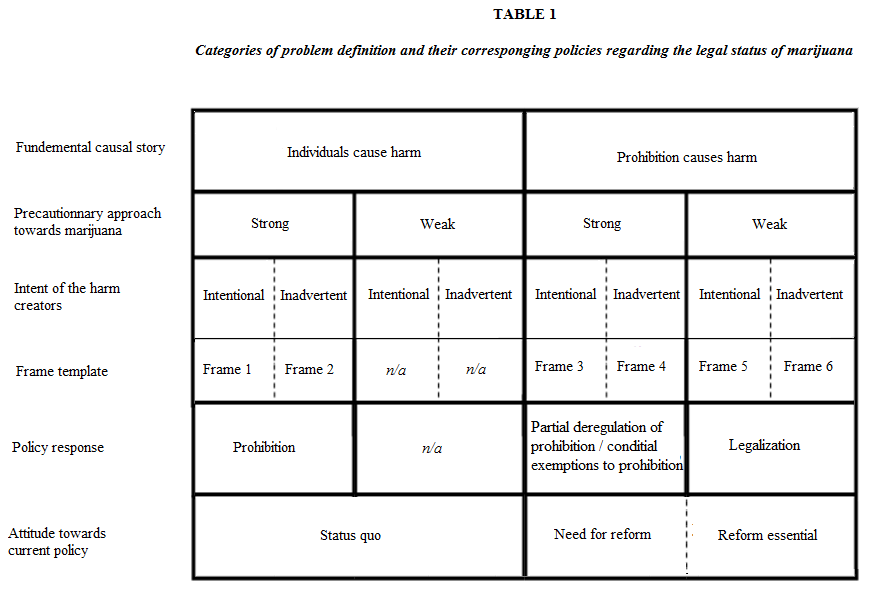
The thick vertical lines represents irreconcilability, while permeability is shown by dotted lines. As Table 1 shows, irreconcilability is present
- At the fundamental causal story axiom between the “individuals cause harm” and “prohibition causes harm” categories
- At the precautionary approach towards cannabis axiom between the “weak” and “strong” precautionary approaches
- At the frame level between frames 1–2, frames 3–4 and frames 5–6, as well as between frames 3–4 and frames 5–6
- At the policy response level between each of the policy responses
- At the attitude towards current policies level between status quo and reform
Permeability, represented by a dotted line, is shown in Table 1 to be present
- At the intent axiom between intentional and inadvertent causes
- At the frame level, between frame 1 and frame 2, between frame 3 and 4 and between frame 5 and frame 6
- At the attitude towards current policies level between “need for reform” and “reform essential”
Each policy response is compatible with two frames, which highlights that the essential aspects of policy will be determined according to the two first axioms of problem definition. Between the two frames that correspond to a policy response, the permeability means that they will agree on the policy’s logic and objectives, while disagreeing on specific policy tools or rhetorical arguments according to the indent. This highlights the importance this research concedes to correctly identifying frames not solely on the particular policy technicalities or according to the rhetoric or discourse with which it is presented to the public. The permeability between “the need for reform” and “reform essential” means that at this level, there is agreement about the need for reform, albeit to different degrees. This means that frames 3, 4, 5 and 6 can show common ground, at the maximum, in their desire for change.
The reader will note that out of a possibility of 8 problem definitions, only 6 are presented. Indeed, where frames 3 and 4 should theoretically be, we have left the category as void, as well as the policy response that would have corresponded. Our framework is designed, first, for analysing the specific frames related to the regulation of harmful substances or activities, in this particular case cannabis. It is also designed to analyse frames in a policy area where the problem has already been recognized politically and dealt with via a policy, which has remained unchanged for a long period of time. There cannot be any problem definition that has a weak precautionary approach towards cannabis while still concentrating on individuals being source of the problem since the current policy, prohibition, has a strong precautionary approach towards cannabis. These categories are thus inherently self contradicting and are bound to be void, but they are nevertheless portrayed in the framework for the sake of symmetry. While it is possible to concede that these categories may have been filled by frames based on religious or moral principles which might warrant an exception to a weak precautionary principle as a basis for prohibition, the interpretation of problems would be based on beliefs that are inherently irreconcilable with rational argument.
If cannabis was a new drug, thus creating opportunity for new problem definitions in a policy area where the problem has not already been dealt with by a policy, our first axiom would be of little use and would potentially have to replaced by a “cannabis causes social harms” axiom divided by a straightforward yes/no variable. There would nevertheless be void categories in the “individuals do not cause harm” subdivision because it is highly unlikely that a problem definition that supports that no harm is being done would have a strong precautionary approach towards cannabis, provided there is a minimum of intellectual consistency involved. This element is a purposeful addition to our framework in order to accurately reflect the reality of frame conflicts, and we have not so far found any reason to believe that it would consist of a conceptual flaw.
The multi-level structure of the framework
The idea that frames are found on different cognitive levels is not novel. For instance, there is a consensus as to the existence of metaframes and subframes. The difference between frames and metaframes is that a metaframe can be used to give meaning to complex realities that are radically different from each other. To some degree, they are similar to ideologies or strong political principles. For instance, the liberty or security as a principle guiding policy would be a metaframe. Subframes are also mentioned throughout the literature as frames whose differences with each other are not significant enough to be considered as distinct, fully fledged frames while being too great to be considered the same frame. Subframes have for common denominator the central tenants of the frame from which they derive, and distinctions between subframes can be conceived as small normative/cognitive differences that can be easily resolved through negotiation.
The division of ideas, belief systems or schemata is not unique to the concept of framing. Political scientists’ use of ideas, Vivien Schmidt argues, usually occurs at three levels of generalities. She presents the first level, the most specific, as being the actual policies or policy solutions proposed by policy-makers. In this sense, it is the “final” product, the logical conclusion of all previous normative and cognitive processes. The second level is composed of the programmatic ideas that support the policy. She describes these ideas as being, for instance, the underlying assumptions or organizational principles orienting policy, as programmatic beliefs, as policy cores providing sets of diagnosis and prescriptions or as problem definitions. This level determines “define the problems to be solved by such policies; the issues to be considered; the goals to be achieved; the norms, methods, and instruments to be applied; and the ideals that frame the more immediate policy ideas proposed to solve any given problem”. The third level of generality refers to public philosophies, public sentiments or deep core beliefs underlying the policy and programmatic ideas, such as basic values, the nature of knowledge, the human condition, fundamental economic theories, etc.
Paul Sabatier and Hank Jenkins-Smith, in developing their influential Advocacy Coalition Framework, have also approached the tripartite belief structure. While this research does not necessarily agree with the composition of functional use of their framework, the belief structure elaborated by Sabatier and Jenkins-Smith is a useful heuristic device that we can learn from in order to identify frames and their precise characteristics that make them irreconcilable with each other. Their tripartite structure can be thought of as being divided according to capacity of the beliefs to resist change. The deep core beliefs are highly unlikely to change, akin to religious conversion. Of the characteristics of such beliefs that Sabatier and Jenkins-Smith, the ones are the most resonant to our understanding of problem definition and frames are: the relative priority of various ultimate values such as freedom, security and knowledge and the basic criteria of distributive justice such as whose welfare counts the most and the relative weights of the self, primary groups, all people and future generations. This is similar to the concept of metaframe. The major difference between the ACF and this research’s framework is that latter does not use deep core beliefs on their own as a criterion, but rather the application of deep core beliefs towards a particular issue. For instance, a precautionary approach to regulatory policy would, in theory, be a sufficient deep core belief. However, there may be inconsistencies when the precautionary principle is applied to different issues: actors may have different precautionary approaches towards weapons, pollution, bio-medicine, technology and drugs. Some actors can have a considerably negative perception of drugs while still adopting weak precautionary regulatory policy making in general, while others have strong precautionary approach to regulation in general but simply do not believe that cannabis is harmful at all.
What this researcher wishes to incorporate from the ACF is the hierchihcal order it assumes. The policy core beliefs are somewhat less likely to change and comprise the overall seriousness of the problem, the basic cause of the problem and the ability of society to solve problems. They argue that although the deep core beliefs are held stronger, it is in fact the policy core beliefs that are the “glue” that holds coalitions together. When policy core beliefs are in dispute, the lineup of opponents and allies tends to be stable for over decades. A coalition’s consensus on issues relating to the policy core are stronger than consensus over secondary aspects. Actors will give up secondary aspects before giving up policy core beliefs. In our framework, this correspond to the first axiom, the fundamental causal story. This research also uses the same distinction between major and minor changes to policy as the ACF. Minor changes, according to Sabatier, are constituted by changes in the secondary aspects of policy beliefs, which corresponds to this research’s concept of permeability between the “intent” criteria of frames and their different implications for policy tools or policy rhetoric while nevertheless implying the same policy logic. Secondary aspects are indeed the ones that are up for negotiation between coalitions include notably the various importances of causal factors in specific locales. While Sabatier states that major change occurs at the policy core level, this research believes that major change is also determined at the second axiom, the precautionary approach, of the same nature of metaframes and deep core beliefs. So while the major changes towards status quo operate at the first axiom, the second axiom also represents major changes between the options for reform.
First axiom: fundamental causal story
The causal stories describe the nature of the causal argument as a cognitive interpretation of a relationship of harm. First and foremost, causal stories assign blame by identifying the origin of harm. Because we are attempting to create templates of problem definition, it is of little importance, at this stage, to specify exactly what type of individuals cause harm how the categories of harm creators are defined. We are also looking to identify how problem definitions relate to each other by starting with the greatest common denominator to the smallest. We believe that the greatest division between problem definitions is whether the problem is caused by a policy or by the behavior of individuals. Although in different framing and problem definition frameworks the fundamental causal interpretation of how the problem is brought about is interpreted or used in different ways, there is overwhelming unanimity as to its importance. Entman, Gamson and Modigliani, Eldelman, Stone, Rocherfort and Cobb all emphasize that the basic cognitive interpretation of causality that people assign to issues and conditions is the defining factor that determines what policy they will be inclined to support. The causal direction axiom enables us to distinguish between personal and impersonal causes when facing long-lasting policies. Indeed, the traditional conflict between impersonal and personal causes is one of the defining characteristic between conservative and liberal approaches which propose radically different solutions to any given problem. Normally, impersonal causes have to do with culture, socio-economic structure and environment as factors that determine human behavior. When a policy has been in effect for a long period of time, one cannot refer to the time before the policy for comparison for the data is unavailable or so distant that it is irrelevant. In this case, impersonal causes are attributed to the incentive structure and policy culture that determines human behavior, in opposition to personal causes that blame individuals and does not take into account the distorting effects of the current policy on behavior.
Over time, proponents of a policy will present it as the solution and its implementers as virtuous. Individual actions that cause harm will be depicted as rising in severity and incidence, with a rising proximity towards ordinary citizens, will be presented as crisis or emergencies, with variations of the same problems depicted as novelty that warrants continuing intervention. Policy failures are presented as caused by inadequate funding or partial implementation of the policy which allows individuals to perpetrate harm unchallenged. The debate within that problem definition will be concentrated on the best implementation techniques, introducing innovative strategies, varying the distribution of resources, setting different targets and other technical aspects of policy making.
Compared to the criteria of the other categories, the direction of the relationship is the most powerful. Using this axiom, we can arrive at two positions that are inherently irreconcilable. The first is that individual behavior causes harm to individuals and to society, and that the policy is the solution. The second is that the policy causes harm to individuals and to society, or that individual behavior that causes harm is itself determined by the distorting effects of the policy, and that a replacement policy, or a return to a state of nature, is the solution. The notion of blame, responsibility and who must bear the burden of reform cannot be more radically distinct than between actors who believe that the policy is the problem and the ones that believe the policy is the solution. It also has the analytical advantage of categorizing, first and foremost, problem definitions that call for the maintaining of the status quo and the ones that imply the need for reform.
Second axiom: strength of the prudential approach and the justification of control
Being established that any causal story of drug problems is in the form of mechanical causality, we must identify characteristics of that causality that justify government control of intervening agents, in this case cannabis. Whereas the division between accidental and mechanical causes was about the possibility of control, we are concerned with the justification for control.
The most important criterion in justifying government control is the strength of the precautionary approach to the intervening agent. This involves, first, the acceptance of the precautionary principle of regulatory decision making and, second, that such a principle applies to a particular intervening agent. As a principle of decision making, the precautionary principle is quite recent as it has been primarily articulated for environmental policy since the 1990’s. However, the debate surrounding the need for precaution and towards what issues precaution should apply has always been a fundamental component of regulatory decision making. There are many interpretations of the precautionary principle. The Wingspread Statement on the Precautionary Principle defines it as
“When an activity raises threats of harm to human health or the environment, precautionary measures should be taken even if some cause and effect relationships are not fully established scientifically. In this context the proponent of an activity, rather than the public, should bear the burden of proof ”
According to the Healh and Safety Executive, a U.K. non-departmental public body, the purpose of the principle is to establish an impetus to make a decision that seeks to avoid harm where there is scientific uncertainty. The precautionary principle is to be invoked when
- There is good reason to believe that harmful effects may occur. “Good reason” can be demonstrated by empirical evidence, analogy to another similar activity or product that which has been show to have substantial risk or by demonstrating a sound theory of how harm may be caused
- The level of scientific uncertainty about the consequences or likelihoods of harm resulting from an activity or product is insufficient for confident decision making. Harmful effects can be gauged by factors of severity, irreversibility, uniqueness, incidence, numbers affected and knock-on effects.
More importantly, one of the tenants of the precautionary principle is that the absence of evidence of risk cannot be confused with the evidence of absence of risk. Not only does the burden of proof shift from the regulator to the “hazard creator”, but the hazard creator must be able to prove beyond any doubt that the activity or product is not harmful. Another tenant is the emphasis on the intensity of the consequence, rather than the likelihood, of harm (especially if the harm is irreversible).
There are different degrees of precautionary approaches which have a direct impact on how the problem will be defined. A “weak” approach allows for preventive measures but does not make them a requirement. Evidence of likelihood must be provided along with evidence of intensity of harm. Other factors than scientific uncertainty, such as economic costs, can be invoked. The burden of proof is less categorically imposed to the creators of hazard. A “strong” approach does not take into consideration economic costs, and does not allow for any cost-effectiveness account to affect decision making. It does not take into consideration the likelihood of harm, and assumes the inherent causality of harm of an intervening agent unless proven otherwise.
The nature of the intervening agent and the degree to which it produces harm are aspects of problem definition that reflect the strength of the precautionary approach. For instance, one can accept that the association of a probabilistic harmful outcome to an intervening agent is the demonstration of a cause-and-effect relationship. Emphasis on the irreversibility and destructiveness of the harm, for instance by invoking irreversible schizophrenia as a possible consequence, may also lead actors to accept the precautionary principle towards cannabis. In opposition, emphasis on the low probability of harm and comparison of cannabis to other equally risky products of activities are characteristics of a weak precautionary approach.
Regardless of the causal direction, the degree of the precautionary approach towards the particular intervening agent is the criterion that determines the particular policy to solve a problem. Rocherfort and Cobb have outlined some criteria of the nature of problem definition which we can use to detect the strength of the precautionary approach. Severity of the problem is the most defining aspects, because it allows opponents to have intense disagreements about a so-called objectively recognized problem. Thus a common causal interpretation of the problem can lead to radically different problem definitions. For instance, rival political factions may have the same causal interpretation of global warming, it can be conceived as not severe enough to warrant correctives that may affect economic development or too severe for economic considerations to even be considered, leading to two radically different policy approaches. Incidence is the second defining characteristic of a precautionary approach.
First of all, the relative degree of importance between incidence and severity is a good clue as to whether proponents have a weak or strong precautionary approach, where the latter will emphasize on severity rather than incidence.
Secondly, rising incidence creates pressure for quick public action or justifies continuing government policies. Incidence can measured but is subjected to a mix of politics and available information: the presentation of incidence in absolute or relative terms, as well as the particular causes of rising or declining incidence, allow for different and irreconcilable interpretations of the same objective reality. Incidence can also be located in different population cohorts, with particular emphasis on rising incidence amongst vulnerable populations such as children and minorities carrying more normative weight. Proximity is the third defining characteristic.
Problem definitions always attempt to expand the scope of the problem, thus expanding victimhood to the largest population possible. Personal relevancy is a highly strategic component of problem definitions, as people who feel personally victimised by a problem will have a personal interest in having that problem resolved. In drug related problems, this aspect of problem definition is highly visible. The idea that the harm resulting from personal consumption of drugs is not a personal or family issue but a community or national problem is based on the idea that personal harm trickles down to the rest of society.
Similarly, the idea that prohibition creates harm on the entire national economy and hot only personal hardships to consumers and distributors is a powerful incentive for new policy. Regarding cannabis, the idea that harm, thus risk, is imposed on the whole society makes for a strong precautionary approach. Finally, the presentation of a problem as a “crisis” is a culmination of a rise in severity, incidence and proximity.
Third axiom: normative interpretations of intent
The third criterion of problem definition is the perceived intent of the problem creator. Division at the level of intent will cause disputes as to the appropriateness of the policy tools, but the overall logic of the policy will not be affected by intent: the origin of harm and the precautionary approach towards a particular activity or substance, at this stage, have already determined the policy goals. Intent serves two different functions according to the causal direction of harm. If the problem definition is centered around individuals as the creators of harm, intent will determine what kind of policy tools are appropriate as solutions. If problem definition is centered on the policy as the problem, the intent of policy makers is used as a rhetorical device to promote reform.
According to Schneider and Ingram, “public policy almost always attempts to get people to do things they might not otherwise do; or it enables people to do things they might not have done otherwise”. For a policy to work, they argue, individuals must take action in concert with policy objectives. The intent of the harm creators is understood as the potential rationale of why they may not comply to policy goals. The use of certain policy tools thus depends on the perception of intent behind the harm creator’s actions. Debate surrounding the intent of a harm creator cannot be solved through reason or appeal to evidence, unless the intent is publicly stated.
Teleological fallacies are a strategic device to portray consequences as intentional, because “the person who turns out to have willed the harm while concealing his malevolent intent is a doubly despicable character; the symbolism of the disguised malefactor is a powerful rallying cry” Intentional causes reflect that individual that cause harm are in doing so freely and without constraints on their decision making process. They are aware of the consequences but decide to actively pursue the harmful activity regardless. The infliction of harm is thus a conscious choice. When the consequences are deemed bad, intentional causation is a story of oppressors and victims. The policy tools that assume intentional causation are incentive tools, usually as negative incentives for the pursuit of a harmful activity such as sanctions. Sanctions, in this sense, depend on the belief that individuals have the ability to be deterred, thus that individuals cause harm willfully. Indeed, according to Ingram and Schneider, they imply
“disproportionatly sever penalties for failure to comply […] to extinguish certain kinds of behavior by raising the costs far above the proportional value of the behavior itself through fines, deprivation of life or liberty, or social control techniques”
Inadvertent causation is about unintended consequences or constrained choices. This can describe harmful side-effects of an otherwise well-intended, or at least not explicitly malevolently intend, action or policy. Another criterion for inadvertent causes is constraints on decision making such as lack of information or the presence of incentives to pursue the harmful behavior. For instance, addiction is a powerful account of inadvertent causes of harm, as individual as physically incapable of putting a stop to their harmful behavior. The “gateway drug theory” of cannabis is also an example of inadvertent causes. Assuming that “hard” drugs such as cocaine and heroin are the most harmful, consumers of cannabis that do not intent to consume hard drugs may find themselves inadvertently getting “hooked” to hard drugs, making it an unconscious decision. Capacity tools that provide information, training, education and resources are likely to be consequences of such an interpretation of intent. Ingram and Schneider call them “capacity tools”, but can also include symbolic tools that aim at re-orienting social cultures that are believed to be constraints on individual decision making. These tools have the same goal as sanctions: preventing an individual behavior with harmful outcomes for happening.
CASE STUDY: PROHIBITION OF CANNABIS IN THE U.K.
In 1928, after a debate lasting less than five minutes, an amendment adding cannabis to the Dangerous Drugs Act of 1920 is passed in Parliament. However it is labelled, the policy is today essentially as it was back in 1928: the possession, distribution and manufacture of cannabis are prohibited by law. The government’s goal remains the same: reducing, if not eliminating, the consumption of cannabis. The different developments of drug policy have all aimed at making prohibition more efficient, less costly and less harmful. The focus on cannabis is due to the prevalence of its use, being the most popular illicit drug in the U.K., public support for a reform of its legal status and the presence of well-organized social movements for the reform of its legal status.
The specificity of the U.K.’s cannabis policy that makes it an attractive case against which to test our framework is its immunity to be challenged by rational inquiry, critical analysis and reference to factual evidence. It is almost as if any legitimate challenge to it is treated as a curiosity or a mere requirement of democracy, ultimately being rejected on the grounds that it is irrelevant, unfounded or simply “wrong”. There is, a very high amount of critical evaluations of prohibition that present it as a failed policy, argued on the grounds that it is un-implementable, ineffective and producing high net cost to society. The general consensus of critical evaluations is that a large number of drug-related social problems are not solved, and are even caused, by prohibition. The disproportionality of criminal prosecution, the creation of a black market controlled by a violent cartel of drug suppliers and the denial of medicine (medical cannabis) to seriously ill patients, and claims that the prohibition of cannabis and not of alcohol and tobacco is discriminatory towards individuals who enjoy cannabis are common arguments that can be found in the drug policy related discourse. This research will attempt to understand where these arguments stem from, why they are not translated in policy reform and why they are not synthesized in a single movement for reform.
Indeed, another characteristic is the stubbornness of the different policy positions in the debate, as well as their impermeability towards each other. This translates, in practice, by the absence of compromise between, on one hand, proponents of the status quo and reformers and, on the other hand, the different factions that advocate for reform. Three main policies concerning the legal status of cannabis, prohibition, heavy and/or conditional regulation and legalization, are each backed by varying but considerable support from public opinion, advocacy groups and research institutes. It is worth mentioning that a pluralist account of the policy process is also insufficient in explaining the stability of drug policy. While prohibition of cannabis has historically been a generally popular policy, public opinion has gradually shifted to a notable propensity to favor reform. A recent poll shows that 58% of Britons are in favour of a review of drug laws. The same poll indicates that, concerning cannabis, 25% are in favour of some form of decriminalisation and that 20% are in favour of legalisation. Under these circumstances, we would expect, following a pluralist view of politics, that there would at least be a debate in parliament about the possibility of reform or, at least, some kind of compromise.
It is thus surprising that there has little compromise or alliances between the advocates of different policies and, ultimately, no meaningful reform of policy towards marijuana. Regardless of whether it is through mediation, coalition formation using ambiguity or disjointed incremental moves, decision making models that based on a concept of instrumental rationality fail to explain this situation. As framing authors Schön and Rein argue, “if the players of the political game are rational actors, why should some disputes prove stubbornly resistant to settlement by means of bargaining and exchange”?
Cannabis-related frames in the United Kingdom
Frame 1: the Health and Safety frame
The Health and Safety framefundamental causal story is that individual consumption of drugs inherently leads to severe physical and mental health illness harms for the user which imposes costs on society as a whole, as well as direct harms to society in the form of public intoxication and violence. The availability of cannabis is the cause of its consumption, which leads to significant harms to users which trickle down to society. Similarly, producers and distributors of cannabis, by being agents that cause the availability, allow consumers to harm themselves and society while not suffering themselves the costs of their actions. Individual consumers, in their pursuit of pleasure, thus cause harm upon themselves, harm which “trickles” down to their families, communities, and eventually the entire public. The harms in question are, first, physical. Cannabis consumption is believed to cause heart disease, asthma, lung diseases and cancer. The mental health harms are much more severe: acute intoxication, impairment of judgement, loss of psychological and psychomotor performance, schizophrenia, anxiety, depression and other psychotic illnesses. These illnesses can cause direct harms to others, particularly the impairment of psychomotor functions that may lead to accidents when operating vehicles or heavy machinery. There is a firm belief that individual consumption inherently creates harms to society, either in the form of economic costs resulting from loss of productivity or healthcare costs or social harms resulting from intoxication either as “breaking down the social fabric of families and communities” or public nuisiance and violent behavior. There is a tacit consensus amongst politicians that there is a causal link between individual consumption of drugs and crime. While cannabis is no longer considered to cause crime, the “gateway drug theory” is used to associate the consumption of cannabis to a later consumption of other drugs, considered hard drugs, which are firmly believed to cause crime. This frame clearly corresponds to our “individuals cause harm” axiom, as there are no mentions of the potential harms of prohibition, which is portrayed as a virtuous enterprise to preserve public health and safety. The precautionary approach is very strong. There is emphasis on the irreversibility and severity of mental illness resulting from consuming cannabis, particularly schizophrenia. This very low probable outcome is, in policy terms, considered to be a indicator of the causality between cannabis and mental illness. There is a strong emphasis on the perceived rising potency of cannabis. This leads to continuous appeals to novelty in which today’s cannabis cannot be compared to previous generation’s cannabis. Skunk, the political term from stronger cannabis, is said to be the now most prevalent type and is considered deadly, which reinforces fears for youth health. The prevalence of skunk is described in terms of “plague” or “scourge”. The burden of proof resides solely on advocates of reform, and there is explicit mention that until it can be proven that cannabis is in fact safe, policy must “err on the side of caution”. As for intent, the consumption of cannabis is conceived to be a conscious choice either resulting from lack of will, inherent deviant personality or lack of disincentives. It is believed that users prefer the pleasure of cannabis to its harms, and that their personal calculs is distorted by the fact that society absorbs a large part of the harm they create (for instance by the provision of healthcare). Any lack of information as to the nature of cannabis’s harms that might affect user behavior is compensated by prohibition, which is deemed to be a message that “if drugs are illegal, it is because they are harmful”. By forcing users to commit a criminal act in consuming cannabis, they become aware that their behavior is wrong and are thus considered to be knowledgeable about the fact that they are creating harm. This is reflected by a unshakeable beliefe about the deterrent effect of the threat of coercion.. Stopping the causal chain of harm means stopping the act of consumption. This is done by two policy tools: coercion as a negative incentive to distort the consumer’s rational calculus by adding disproportionate costs to his activity and coercion of suppliers physically eliminate the supply of cannabis.
Frame 2:the Harm reduction frame
The Harm Reduction frame shares the fundamental causal story of the Health and Safety frame in that it accepts that individual consumption creates harms to the individual which trickles down to society. It also has a precautionary approach, albeit not on the same basis as the Health and Safety frame. It argues that government control is justified not specifically because of the severity or incidence of cannabis consumption and potency, and it does not have the same propensity to associate probable outcome with causation. Rather, it argues for government control to protect the user from the harmful effects of cannabis rather than for the elimination of consumption. In essence, while it implies that cannabis is a harmful substance, it argues that it is rather its misuse that causes the most harm. In this sense, they do not immediately associate cannabis use with cannabis misuse. In any case, government control is justified primarily because it accepts low standards of control of regulation of potentially harmful substances and not on the basis that cannabis is very harmful. What separetes Harm Reduction fromHealth and Safety is that it accepts cannabis consumption as an inescapable fact. This results from a perception of the user’s intent as being inadvertent rather than an intentional pursuit of pleasure.
Consumption is seen as being determined by lack of information, environmental factors that determine the propensity to drug use such as poverty community setting and emphasises on addiction as being a constraint on free choice. This translates in divergence from the Health and Safety frame in the appropriate policy tools. Harm Reduction, while still accepting the need for the reduction of supply and demand, argues that the reduction of supply and demand on its own cannot occur if unaccompanied by capacity policy tools such as training, information and treatment. Because users inadvertently harm themselves and society, they do not have the capacity to act rationally in the face of coercive disincentives. Harm Reduction emphasizes that intentional harm can be located at the supply level rather than at the consumption level, specifically by referring to addiction as a constraint on consumers to change their habits, a constraint which is exploited by drug suppliers. They thus advocate for a enforcement towards supply as a method of reducing demand, thus not having demand reduction as the primary focus of policy.
Accepting drug use as a fact, harm reduction suggests that when provided with accurate drug knowledge and treated as responsible citizens, drug users will behave responsibly and rationally.
When properly informed and respected as a free individual, the drug user will seek to reduce potential harms to him or herself and others.
Frame 3: the Medical Cannabis frame
The Medical Cannabis frame’s fundamental causal story is that the current legal status of cannabis, which is prohibited regardless of its use and is not recognized to have any medical value, causes harm to patients afflicted with illnesses that could be cured or relieved with cannabis consumption. By reducing the problem definition to the scope of medical use, this frame reduces the notion of harm as the deprival of pain alleviation and cures for ill patients. The current policy arrangement classify drugs according to their harm but also according to their clinical use. This implies that the most harmful drugs (Class A) can be legally used in a clinical setting. For instance, opioids, methamphetamine, ketamine and GHB (sometimes labelled the date rape drug) are Class A drugs that are legally available for treatment of patients. While cannabis is believed to help the treatement and recovery of patients suffering from numerous ailments, notably Glaucoma, Multiple Sclerosis, HIV/AIDS, various forms of cancer and opioid dependence. It is also estimated to alleviate pain, nausera and vomiting associated with heavy medical treatments such as chemotherapy and pharmaceutical drug dependence such as insulin. It is also recognized as a pain reliever for minor but painful physical ailments such as back pain and migraines. The precautionary approach of the Medical Cannabis frame is strong. As with most pharmaceutical drugs and medical treatments, this frame believes that the harmful effects of cannabis are real and can be severe. It assumes that prescription by a licensed medical doctor and purchase from a regulated supplier is the only acceptable use of cannabis, and that cannabis should not be used recreationally. However, this frame tries to emphasize that the category of patients that are victims of prohibition is expanding, with new research finding new ailments that can be treated by cannabis, thus continuously adding elements of novelty to the problem. It thus shares the same precautionary approach as the Harm Reduction and Health and Safety frame, albeit for recreational use only. The Medical Cannabis frame defines the harms of prohibition towards patient as intentional. This is articulated in two different ways. First of all, there are very few institutional and knowledge constraints of decision makers to allow the medical use of cannabis. Policy makers, it argues, have enough access to information about medical cannabis to make an informed decision, especially consideration the legal precedents in Canada, the United States. The decision to prohibit medical cannabis is taken without the mitigating circumstances that would make prohibition inadvertently harmful. The frame also highlights the possible reasons behind the intentional harm as being, first, in the form of a “conspiracy that works” in order to protect the interests of the pharmaceutical industry and, second, in order to protect the integrity of the official discourse of cannabis which labels the substance as inherently dangerous. The policy is seen as oppressive, while patients are labeled as victims. The problem definition implies a simple policy solution: a conditional legalizing of cannabis for medical purposes only alongside a prohibition for recreational use.
Frame 4: the Decriminalization frame
The Decriminalization frame’s fundamental causal story is that by criminalizing the possession cannabis, prohibition causes harm to users and to society. The problem is defined in terms of the justice system and criminality. The causal story of harm to users is that arrest, prosecution and incarceration are more harmful than the act of consumption itself. Incarceration is considered to be a great risk for physical and mental health, employability and self-esteem. The categorisation of consumers into criminals undermines their human rights by turning them into criminal outcasts and constraining their access to finance, housing and education. Prohibition is also harms users by forcing them to have proximate contact with an unsafe criminal environment in which they can be exposed to violent treatment and even death. Prohibition is also seen to harm society by diverting policing resources away from more harmful activities, by overcrowding the penal system with possession and minor distribution charges and by adding fiscal pressure and the tax burden. By expanding the scope of victims from users to society as a whole, the decriminalisation frame uses the same, albeit reverse, logic as the Health and Safety frame: harm to users eventually trickles down to society. This frame nonetheless has a precautionary approach towards cannabis. It shares the same beliefs about the harms of cannabis all the previously described frames, and consequently argues that consumption of cannabis creates severe harms to the user and to society. The main difference from the previous frames is that it doesn’t believe in the deterrent effect of coercion and does not accept the idea that it will decrease consumption and its harms to society. Government restraint of use is thus justified, but coercion is seen as a disproportionate and ultimately counter-productive measure. The reduction of availability that a precautionary approach entails is believe to be satisfied by administrative and civil sanctions rather than criminal sanctions. The Decriminalization frame considers the intent of policy makers that argue for prohibition to be inadvertent. Indeed, the harms resulting from the crimininalization of users is perceived as a foreseeable but ultimately unintended consequence of a well intended policy. The belief in the deterrent effect of criminal sanctions, it argues, was founded upon the idea that users would reduce their consumption in the light of the threat of coercion. The policy response to the decriminalization frame is, unsurprisingly, the replacement of criminal sanctions for cannabis consumption with a heavy regulated regime of administrative and civil sanctions.
Frame 5: the Free Market Frame
The Free Market Frame’s fundamental causal is that prohibition inherently harms individual users and society as a whole. Although it is essentially argue on economic terms, it depicts health, crime and social problems related to drugs as being caused by prohibition. It argues that the concept of prohibition itself is harmful because it is an inherent negation of individual liberty and, as a policy, prohibition should be very parsimoniously, if ever, applied. Prohibition causes the rise of a black market bound to be dominated by cartels in which the only means of competition for clients are through the control of territory, in most cases fought for with violent means. Drug-related crime is thus directly caused by prohibition. The Free Market Frame supposes that prohibition reduces the quality of cannabis while driving up its costs, making its consumption more harmful. It disables consumers from accessing information about the particular cannabis and have little or no ability to assess a products quality before purchase. The black market is also believed to make cannabis more accessible to children, because drug suppliers have no incentive discriminate between consumers according to legal age standards. Social problems are caused by high prices, decreasing quality and incarceration, which in turn are the result of prohibition.
The Free Market Frame has a weak precautionary approach towards cannabis. This is not the result of a particular positive perception of cannabis as a substance but rather as a general belief that precaution should not be a principle that nominally guides policy. It implies that harm to the consumer does not trickle necessarily trickle down to society, at least not to a degree that would necessitate a breach of self-ownership. While the mental and physical harms of cannabis to the user are recognised, the social harms depicted by other frames are caused by the policy.
The Free Market Frame does not assert that the harms caused by prohibition are intended by policy makers. The unintended consequences of harms to users and society are believed to be inherent to prohibition, but policy makers make decisions are invalid economic beliefs such as consumer behavior, the inelasticity of cannabis demand and general misguided beliefs about the ability of government to distribute resources in a more efficient and just manner than a free market regime. It is lack of understanding and information regarding free market principles that ensure that policy makers are unable to forsee the predictable harms of prohibition. The policy solution is very simple: the removal of prohibition and the establishment of a free market for cannabis. In order words, this frame’s implicit policy response is legalization of cannabis.
Frame 6: the Discrimination frame
The discrimination frame’s fundamental causal story is that prohibition causes harm to users by disabling them to pursue an activity which they value. The nature of harm is a discriminatory denial of the right to pursue pleasure. While the denial of pleasure is a harm in itself, this frame concentrates of the harms consumers of cannabis face by being subjected to the criminal environment that surrounds drug supply and the harms resulting from the possibility of prosecution and incarceration. It shares the same fundamental causal story of the Decriminalization and Free Market Frame but concentrates of the civil rights of users aspect.
This frame has a weak precautionary approach to cannabis. The nature of the approach is different from the Free Market Frame because this frame supports the precautionary principle as guiding public policy, but it does not believe that cannabis causes harm to users or society. Rather, it perceives cannabis as a substance which has substantial benefits to the user while producing little or no harm to anyone. This frame supports a non-discriminatory precautionary principle in which the measures of harm are equally applied to all substances and activities without regard to cultural preferences or historical precedent. If the same precautionary approach towards cannabis that prohibition entails, alcohol and tobacco should also be prohibited. Discrimination thus stems from the fact that a stronger precautionary approach towards cannabis is being used as a principle for public policy regarding its legal status. It implies that precautionary approaches should be based on scientific evidence alone, and that the same criteria should be applied to all drugs, either currently legal or illegal.
This frame defines the problems created by prohibition as being caused by the intentional discrimination of policy makers towards cannabis users. It supposes that policy makers conceal their intent to persecute cannabis users for moral reasons, religious or ideological reasons with health and safety rhetoric. Some of the presumed secret motives of policy makers include the immobilization of hippy and other reformist movements of the 1960’s and 1970’s whose members were publicly know to be users of cannabis. They portray policy makers as oppressive and patriarchal who want users to conform to conservative moral standards. The policy response that this problem definition entails is the provision of civil rights to users equal to the rights of alcohol drinkers and tobacco smokers, which is to be achieved by the legalization of cannabis.
The institutional framing of the Health and Safety frame in the U.K.’s drug policy
The policy making process in the U.K.’s drug policy, essentially consisting of determining the statutory legal status of drugs and policies to enforce it, is institutionally constrained as an ongoing conflict between the Health and Safety frame and the Harm Reduction frame. The scope of the problem is thus limited by the first and second axioms of the framework, meaning that acceptance that drug related social problems are caused by consumption of drugs and their control by government is justified by a precautionary approach are two agreed upon elements of problem definition that limit the scope of policy solutions. Perhaps because it reflects the general risk aversiveness of policy makers s or their desire to reduce social problems to the simplest definition possible while avoiding blame, the government, in particular the Home Office, is the institution in which the Heal and Safety frame has been anchored. On the other hand, the Advisory Council on the Misuse of Drugs, the expert body tasked with providing advice about drug policy, produces policy advice according to the Harm Reduction frame. The institutional arrangements between these two institutions can be considered permeable albeit conflictual channel of negotiation and compromise between the two frames.
In 1971, the Misuse of Drugs Act (MDA) is passed to make new provisions with respect to dangerous or otherwise harmful drugs and related manners: it establishes ABC classification system of drugs, a legal framework in which the possession, use, production or sale of drugs bare different legal consequences depending on the class. Although a preliminary classification is provided, the act states that “her majesty may […] make such amendments […] as may be requisite for the purpose of adding any substance or product to, or removing any substance or product from, any of Parts 1 to 3 [of the preliminary classification]”. The Health and Safety frame’s application consists of continuous pressure by government to add more drugs to the classification system, to maintain the original classification. Any modification to the original classification consist of moving drugs from the lower classes to higher classes when new harms are discovered. The Harm Reduction frame’s application consists of the ACMD’s continuous attempts to move drugs from the most harmful categories to the lesser categories, to slow down the process by which drugs are added and to lobby for the concentration of government resources towards education, learning and addiction treatment. The logic of prohibition being confirmed by the two first axioms of both frames, it matters not who gets the upper hand in the frame conflict: prohibition would remain justified either way.
The MDA is quite unique in that it enshrines in statutory law the institutional arrangement between the Home Office and the ACMD by legally defining the acceptable source of advice that guides drug policy. The advice is to be scientific in nature, limited to identifying drugs whose effects are harmful enough to cause social problems. The act also creates the ACMD, which is to be given a quasi monopoly of the provision of scientific advice, in order to:
“keep under review the situation in the United Kingdom with respect to drugs which appear to be misused or appear to them likely to be misused and of which the misuse is having or appears to them of having harmful effects sufficient to constitute a social problem, and to give to any one or more of the Ministers, where either the Council consider it expedient to do so or they are consulted by the Minister or Ministers in question, advice on measures […] which in the opinion of the Council ought to be taken”
Because its advice is compulsory before making changes to the MDA, it enjoys a particular status amongst advisory NDPBs. Other advice can come from “other published research, consultations with key stakeholders, and the advice and experiences of practitioners within the drugs field upon whom the issue of classification has a direct effect”, but Government has acknowledged that the ACMD was the provider of the “key advice on the classification of drugs”. The Home Office Minister Vernon Coaker also stated that the fact Government seeks advice from the ACMD ensures that drug policy is evidence-based. The Report by the House of Commons Science and Technology Committee concludes that “the Government’s total reliance on the ACMD for provision of scientific advice on drugs policy gives the Council a critical role to play in ensuring that policy in this area is evidence based”.
While it may be true that policy is evidence-based, the type of evidence considered and how it is used in a political setting is determined by the frame: evidence is limited to evidence of harm from to consumers and society resulting from cannabis use, and the degree to which evidence justifies government control is used in a discretionary manner by policy makers. Indeed, the criteria of harm of the ACMD are divided in three categories: the physical harms of drugs (acute, chronic or intravenous), drug dependence (intensity of pleasure, psychological dependence and physical dependence) and social harms (intoxication, other social harms — which includes drug-related crimes such as acquisitive crime, and health-care costs resulting from treatmenent of drug harms). Harms resulting from prohibition are explicitely excluded as guiding advice for drug policy.
The institutional arrangements between the science and policy can be characterized as Jürgen Habermas’ “decisionist model”, which states that experts are left with a primarily instrumental function: providing rational justification for government policies, while politicians are known to favor advice that support their convictions . In contemporary policy making, “politicians use the results of research selectively and sometimes in the pursuit of their own interests, while scientific discoveries and their political consequences hardly gain a hearing in public and in the political decision-making process”. Science, as an institution, is a crucial arbiter empirical claims that justify causal stories. By _de facto _delegating regulatory decisions to a scientific body whose expert status gives it the ability to identify uncontestable truths, the Health and Safety frame becomes immune to the criminal, economic, justice and civil rights considerations of the competing frames. These considerations would appear if the ACMD had not been institutionalized as the only source of input advice. The scientific body in question is tasked by government to consider drugs according to “the degree to which drugs consumption harms society”, which translates into advice as to which category drugs should be classified in while completely escaping the fundamental question that other frames wish to ask, “should the drug be illegal at all?”. Moreover, as deciding the appropriate legal sanctions for each drug class is not in the competence of the ACMD, and as there is no other major source of advice, the appropriate legal sanction is effectively immune from any change, expect if other frames were to become dominant within government.
Stability as the reduction of conflict
The conflict between Harm Reduction and Health and Safety, when looking at the framework, is clearly trivial: the outcome of the conflict is bound to lead to the same policy. Stability is thus guaranteed as long as the conflict remains reduced between these two frames. The conflict itself appears, however, to be very intense. It creates a real social debate about the degree of harm of certain drugs that monopolises public and media attention while relegating other frames as mere curiosities. Indeed, the resistance of government to concede major points to the ACMD’s decisions, notably by reclassifying cannabis from a class C to a class B drug, or the reluctancy of government to declassify MDMA (ecstasy) as a class A to a class B drug, has lead the controversial sacking of professor David Nutt and numerous resignations from ACMD members. The nature of the conflict is limited to the third axiom of the framework: while the ACMD visibly lobbies for policy tools to be guided by the inadvertent criteria of the Harm Reduction frame, the government argues that the belief in deterrence and that coercion “sends a message” to users to modify their behavior should be the principle guiding policy tools. The stability of the U.K.’s prohibition policy towards marijuana is thus achieved by limiting the conflict over problem definitions to problem definitions whose policy solution remains essentially the same. Problem definition is clearly an instrument of power in achieving stability, and the ability to set the debate in Health and Safety terms and to institutionalise those terms through statutory enshrined institutional arrangements is, according to this research, the reason why the U.K.’s drug policy towards cannabis has achieved a high level of stability.
CONCLUSION
As an analytical device, framing derives its use not because of its internal consistency, its simplicity or verifiability. Rather, it has the remarkable ability to turn the conceptual weakness of rational models of analysis, the constraints on rationality resulting from the intersubjective nature of social problems, into a coherent explanatory concept. By focusing primarily on the agenda-setting phase of the policy process and the effect of framing on public opinion, the framing literature has not yet fully exploited to power of framing theories. By interpreting the policy process as an ongoing struggle for dominance between frames, this research concludes that framing indeed explains the mechanics behind a policy achieving stability.
Instead of keeping the traditional conceptions of framing, this research attempted to elaborate a conception of framing that centers on problem definition. This makes the identification of frames easier and ensures that frames can easily be reduced to their most simple form. To exploit the full potential of the concept of framing, the main focus of this research has been to elaborate a framework from which an analyst can identify the different frames present in a policy discourse in a way that shows the nature of their relationship with one another. The alternative framework proposed by Deborah Stone is conceptually flawed and does not enable policy analysts to accurately identify the different frames present in a policy discourse. Her research does not take into account whether harm is being caused by individuals and by existing policies, which this researchbelieves is the most fundamental difference possible between competing frames. It has, because of this flaw, no practical use, which still leaves framing under exploited.
The new framework proposed by this research shows to which degree compromise between frames is possible and what precise characteristics of frames make them incompatible with others. The framework has been conceived as a hierarchical set of three mutually exclusive axioms of dichotomic value.
The main reason for this was to achieve mutually exclusive templates for frames: by separating the criteria for identifying frames according to their level of generality, this research aimed at correcting the flaws in Stone’s framework. Moreover, separating the framework in a hierarchical manner is what enables the analyst to identify the point of rupture at which frames become incompatible with each other.
The three axioms that this research chose to use were: the fundamental causal story, the precautionary approach towards cannabis and the intent of the harm creators.
The fundamental causal story is an axiom this research developed which combines the unanimously recognized criteria of frames and problem definitions, causality, with a new variable, the causal direction of harm. Not only does this axiom highlight how the frame supposes harm is being created, it clearly makes the distinction between harm created by individual behavior and harm created by policies.
The second axiom this research created was dubbed the precautionary approach to harm. The usefulness of this axiom is that it combines a vague and general criterion, the precautionary principle, and the perception of the substance of cannabis. This allows the framework to identify the specific explanation that frames imply for the justification of government control of cannabis.
The third axiom this framework uses is the criterion of intent of the harm creators. This research has argued that the normative criterion of intent is not sufficient to separate frames that otherwise share the first and second axioms to a degree that they will not support the same policy. Indeed, the perceived intent of the harm creators may lead the frame to support different policy goals, or may lead advocates of the frame to use a different rhetoric, but it will not lead to a change substantial enough to be considered a rupture of stability.
Frames that are only separated by the axiom of intent are thus able to engage in negotiation with one.another and form coalitions to support an essentially similar policy.
This research ended with a discussion of the theoretical relationship between frames and institutions, on which was predicated the clear identification of mutually exclusive frames. Using framing as an explanatory device for the study of stability indeed required a framework that can identify the different frames and the degree to which they are compatible with other. Stability, this research concludes, is achieved when the institutional arrangements of the policy process reflect a single frame or two frames that are permeable.
Our theoretical framework thus demonstrates the ability to show how the initial framing of a policy problem shapes how the problem will be debated, and how the control of the dominant problem definition is the key factor in deciding which policy will be used to fix it.
Falling empires, Corporate Fiat and the fate of Bitcoin
By Mariana Trip
Posted April 7, 2020

In his 1978 book “The Fate of Empires and Search for Survival”, the decorated British historian and Luitent general, Sir John Bagot Glubb, found the same attributes ran as thread through the fate of substantial number of past empires. Some of the most noticeable attributes are:
1. They’ve been around for about 10 generations or 250 years
2. They went through the same six stages:
a) The age of outburst (or pioneers).
b) The age of conquests.
c) The age of commerce.
d) The age of affluence.
e) The age of intellect.
f) The age of decadence.
3. The later stages of all empires saw an increase in immigrants knocking on their borders and welfare dependents seeking for better life, both groups are the consequences of the Empire’s conduct throughout its reign
Celebrities, Sex and consumption, lessons taught by history
The final stage before any empire’s collapse, the age of decadence and gluttony, is very interestingly characterized with sexual promiscuity, celebrity centered culture, turning chefs and athletes into wealthy dignitaries (for example, Diocles, a Roman carriage driver whose financial value at the last days of the Roman empire, was equivalent to $ 15 billion today) and an excessive consumption culture among others.
The age of decadence symbols the end of common faith and purpose that moved pioneers to conquer the unknown, while building their communities and social connections, making way to the “me era”, which results in individuals, groups and adversaries ripping through the Empire’s flesh, claiming their part of the crumbling empire.
And congratulations to the American empire on turning 244 years old this July.
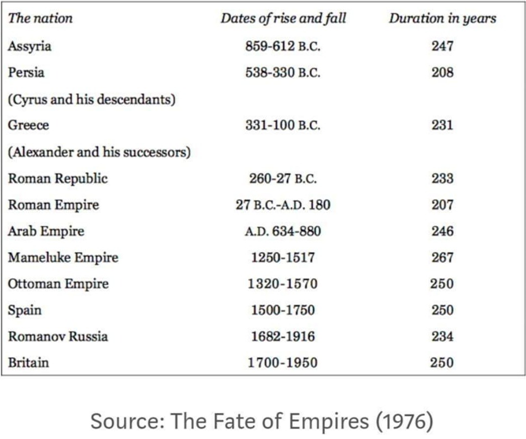
Money, money money
Decline of an Empire is commonly accompanied with the decline/devaluation of its currency. Going out of business sales.
We learn from history that this occurred on numerous occasions, most notorious were the roman empire’s corrupt senators and emperors, who at the decline of the Empire minted low quality metal coins mixed with gold or at times, even painted them with gold, spiraling their economics and money supply to hyper-inflation and currency devaluation.
The same procedure has started with the Bretton woods agreement, that basically paved the way to the dominance of the American empire and Dollar as the global currency, through free trade agreements and globalization, overwhelming post WWII financial supremacy and bottomless appetite for consumption.
The 1971 “Nixon’s shock” which detached the $ from the gold standard, turning it to Fiat currency and amplifying the inflation of money creation, was the pinnacle of the said procedure. (or maybe the money printer goes brrrr will be its pinnacle)
The Nixon shock primarily forced on the American government in order to finance the Vietnam war (wars — the mother of all debts and currency devaluations), opened the gates to a flood of debt accumulation by governments and individuals alike
debt economy has major implications on the freedom of nations and individuals and their free will, since debt was historically means to control and enslave both, stripping them of assets and dignity.
The introduction of fractional reserve banking that gave the power of “printing” money to commercial banks whenever they lend the public’s deposits and life earnings, just took this super sonic boom of money creation to the moon (but not to the right moon)
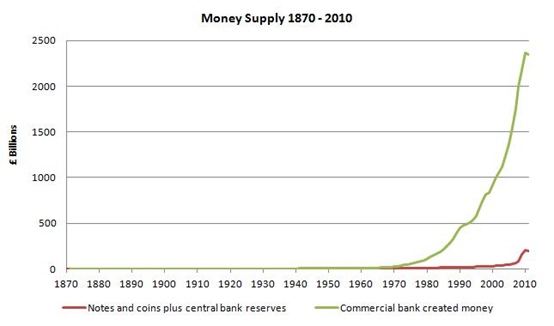
An oversimplistic explanation of how this money production frenzy is affecting all of us: Imagine that the whole financial market is 100$ and you have 1$ than you have 1% of all the money supply.
Than imagine that a multiple interest, malicious and orange octopus of a president, a fragile, obedient federal reserve that join hands with commercial banks, to print without warning additional 900$ to cover their enormous debts and hidden interests.
You now have 0.1% of all money supply….your money is worth less, you can buy much less and no one asks you if you’re down with that shit
The documentary that made me think
I was introduced to Glubb’s work, fractional reserve banking and other enchanting terms like Economical assassins and trickle down economy, corruption of the IMF and central banks, in a documentary I really recommend, “the 4 horsemen of the apocalypse”, an amazingly enlightening movie that tries to provide a different perspective and understanding, on how the world really works, featuring interesting speakers, quite a few of them are Nobel prize winners. Beware of entering the rabbit hole
https://www.youtube.com/watch?v=5fbvquHSPJU&t=47s
The movie ends with thought provoking statement, that the next empire is already upon us and to me personally, it is more frightening than Attila and Genghis Khan rampaging crazy on Cocaine
The Corporate Empire
International corporations are already governing and manipulating significant parts of our stands, thoughts and wants in a scalable manner, generally ignored by the public.
They have created and cultivated their own kind of capitalism to facilitate their goals….surveillance Capitalism[1] empowered by behavioral economics and game theory practices, not just to monitor your behavior, but also to alter it to their needs.
Corporates, unlike people, have no souls (most people anyway), or inherit moral standards. It’s a feature, not a bug
Their bottom-line centered interests and goals, which dictate their conduct, are influencing the fabric of society and its culture from every possible aspect, utilizing the earth’s resources, while changing the climate of our world and its destiny, to promote excessive, mindless and irresponsible consumption culture necessary to feed the beast of constant growth Capitalism
Those corporate interests are promoted by the ruling power through a standardize mechanisms of creative corruption (who said tax havens), lacking transparency and stake holders concern, safe guarded by armies of Lobbyists, lawyers and anyone else who can make a profit.
Add to the mix Trade agreements that are constructed and written right now, under a screen of confidentiality as a part of an ongoing process aimed to give big corporations the power to frolic around unaccountable to the rules of states and interests of the public and you got yourself an award-winning horror movie.
Corporate fiat — the final stage towards world domination
First you control the media, than money and finally the army.
Fiat is a Latin word that basically means, it is so because I fucking said it is so. Fiat money is a government expression, a promise to back its financial obligations and means to collect taxes and encore life enslaving debts, painted on paper notes and upheld by force and guns.
Facebook, Google and their likes, don’t need guns (for the time being), they have their own stealthier and sinister weapons to make first their workers, suppliers, clients and then the rest of us, Fiat our asses off. They already mastered the practice of Propaganda, thought manipulation and the design of wants in their commercial endeavors. Their almost monopolistic power is just the icing on the cake.
Facebook’s Libra is scheduled to launch in 2020, Baidu will be launching its coin and I believe, Amazon, Apple, Alibaba, Google and many more (not necessarily from the tech sector) will follow short after.
The vast commercial, regulatory and financial incentives that come with the ability to create, monitor “money” and especially governance, will be hard to pass by those corporate giants, who get their assets value decreased like the rest of us while the money “printing” machines go brrrrrrr….Rumors are already roaring
If you are skeptical about the chances of corporate fiat to be a real thing, since the FCC and the American senate is flexing its muscles to Libra, just consider that one of the major expenditures of all big tech companies is lobbying. Be it via campaign contributions or downright brute force lobbying, law and regulation are an American commodity sold by crocked merchants in disguise of civil servants.
Amazon alone is employing more than 90 fulltime lobbyist roaming the corridors of D.C, fortifying the power of corporations over states and individuals
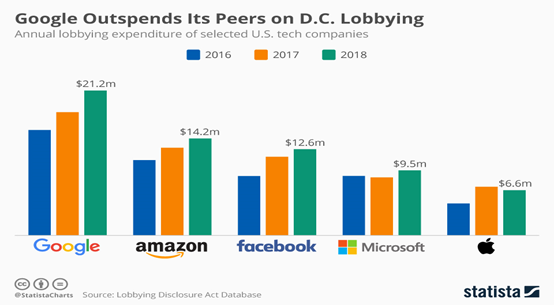
The revenge will be served cold
When you put all this headache together with the fact that too many regimes like the Chinese and Russians, Iranian and Venezuelans with their already existing Petro are fed up with the chokehold of the all mighty $, Petro-dollar dominance, sanctions and tariffs, it becomes clear why an alternative settlement and monetary standard is American Empires worst nightmare.
All of them and many other countries are examining blockchain technology and the way it can help their global ambitions. Corporations are doing the same, much more efficiently and with a greater capability to exploit the new era we are facing.
The average life span of a Fiat currency is 27 years and the $ has surpassed this life span by almost double the time.
can it be that we are on the verge of a brave new and refreshing (like dragon’s breath) Fiat era? Corporate Fiat
The countries (Iraq, USSR, Pakistan, most of south America, south Africa and many more) ruined and bashed by the American empire, stripped from their dignity and assets sold to corporate America by Milton Friedman’s Chicago boys, encouraged by the American Empire and enforced by brutal and evil shock therapy, will be glad to kick the corpse of the American Empire in the face, now that it’s on its knees, nearing its demise.
One Bitcoin to rule them all
Deutsche bank has got it!
In their Imagine 2030 report, they have indicated that cryptocurrency is a reasonable and possible solution to the money inflation scheme that is about to explode, viewing it as a viable future by the year 2030
Moreover, Bitcoin fundamentals are perfect as global monetary standard for the digital age and for the support of future innovations
with its final cap of 21M coins (last mined in 2140), deflationary economy supported by the “halving” (which decreases the money supply by half every 4 years), censorship resistance, consensus and pseudo anonymous, transparent ledger are perfect as a trusted and unbiased monetary system, governed by algorithm rather than the weaknesses of human beings as standard for all future cryptocurrencies and beyond.
nations and corporates will enjoy the same attributes along with certainty based financial system and settlement platform that will allow design of independent governance eco-system not apologetic and subordinate to the American Empire
Covid-19, the pin, the bubble, the perfect excuse
The Covid-19 virus which halts the world economy at the moment, seems to be the cause for the upcoming depression and collapse of the American Empire.
It is not!
It is only the prick in the greatest debt bubble in history. The catalysator for the inevitable crash of an evil, corrupt and deliberate system and ideology that widened the gaps between the many and the few to unpresented levels, dried up public sector and promoted a society that celebrates profit over human life and well-being.
Extreme capitalism, Neo-liberalism, consumerism or just plain greed culture, call it what you will, the system based on the few trickling down shit on the many has failed the many and the virus will be used sinisterly just as an excuse for the few to inflict shock[2] therapy, eliminate human rights and spread surveillance capitalism and martial law to protect their positions and to bury the truth by despairing the masses, making them pay for the mistakes and malicious conduct of the few.
A glance to the future (existing only in my head)
Bitcoin will be the global monetary standard. Inevitable.
Corporate Fiat is also coming
If sheer lobbying (bribing) and donations contributions (bribing) won’t crumble the FCC’s resistance to corporate Fiat, the fact that most tech and retail giants create their own coin as part of a financial arming race, will do the trick.
Baidu’s and wechat efforts on one hand and Japanese giants like Rakuten into the crypto space will serve as the catalyst for the American congress and FCC to allow American corporations to join the party and present an overwhelming competition to Fiat currencies. A trojan horse of a kind
When one will buy decorated N95 masks on Amazon, that costs 25 Amazonium with Libra the conversion will be in Satoshis and not the manipulated, outdated and the monopolized $
Aftermath
Since humans discovered fire, they used any technology invented, to eventually, kill, enslave and rule over their fellow human beings.
Blockchain platforms have great potential for salvaging the world, making it more just and suitable for all of us, the greedy billionaire as well as the stoner hobo whose only wish is to smoke weed and watch Netflix. It can give legitimacy to any way of life with no financial justification. Especially with the ever-changing future workforce and our robotic competitors
When men stop drooling about the shiny new toy that can make money out of thin air, it will be understood that blockchain platform that has only the ability to transfer money is useless (so many better competitors). The strength and viability of the platform will be measured by the apps built on top of it and consequently the number of entities residing in its eco-system.
Crypto currencies are programmable eco-systems. You can program the financial regime and governance to be communist, social capitalist, or even social libertarian (just kidding, I’m eccentric not crazy), or any other kind of delusional set of rules you want to introduce. Eventually people will use the platform most suitable to their needs and in fact will be probably apart of numerous blockchain platforms.
There are projects today that are working on digital global identity solutions that will allow individuals to cut their connections to their homeland and live their lives as global citizen with a digital identity. The future is coming
Blockchain technology is a path with two potential roads. one can lead us to totalitarian, surveillance society where every move you make, every decision you make and every interaction in your life are monitored, recorded and calculated to determine the sheer “quality” of your citizenship, the other can take to digital freedom as global citizens living in a brave new world
Red pill or blue pill, which one will you choose?
[1] Zuboff, Shoshana (2019). The Age of Surveillance Capitalism: The Fight for a Human Future at the New Frontier of Power. New York: PublicAffairs.
[2] The Shock Doctrine by Naomi Klein
Consequences of Money
Consequences of Conviction
By Zach of Earth
Posted April 8, 2020

A THOUGHT EXPERIMENT
Suppose you were given the opportunity to hand over all of your bitcoins, all of your satoshis, today, right now, and in return, the next day when you awoke the world would be on a bitcoin standard. However, if you do not hand over the corn, the chances of the bitcoin standard outcome remain as they are today, highly likely yet, not a certainty, and you will therefore continue on in this quagmire of fiat, with increasing annual returns on your bitcoin stash.
Would you, knowing the tremendous wealth that you would be handing over, do so, if the loss of that wealth meant the guaranteed success of bitcoin, with bitcoin the base monetary layer, and store of value for the entire world, the very next day.
This is, obviously, only a thought experiment. First of all, there is unfortunately no such ability to turn the world into a bitcoin standard overnight. Although I can envision scenarios where the transition could potentially happen in a very short time frame. And secondly, handing over your bitcoins to someone or some group could not miraculously activate this transition to a global bitcoin standard. Nevertheless, the thought experiment is vitally important.
For the answer — YES I would give up all my bitcoins, or NO I would not give up all my bitcoins — opens up a window into the mind of the respondent, providing, (A) a clear picture of the respondents understood importance of a bitcoin standard, and therefore the respondents convictions to achieve this bitcoin standard, and/or (B) the respondents lack of moral character.

ANOTHER THOUGHT EXPERIMENT
Suppose you were given the opportunity to hand over all of your bitcoins, all of your satoshis, today, right now, and in return, your life would be spared. However if you do not hand over the corn, you will have this one final day on Earth before you will be killed, painlessly, but nevertheless, terminated.
Now, what would you choose?
Presumably most every sane person in this world would choose the former and fork over the sats to save their hide. How about a twist, how about instead of not your life but instead the lives of all the people of Asia, or Europe, or Africa, or the Americas. How about then?
Would you give up your precious future wealth to save BILLIONS of lives? Maybe? Probably? How about if the public knew that you decided to keep your corn in exchange for the loss of billions of lives. Would that social pressure push your cowardly little mind into the morally bankrupt direction of savior?

UNDERSTANDING A BITCOIN STANDARD
I like to give people the benefit of the doubt, that their ignorance is the reason for their lack of conviction. For if you understood the colossal changes that will occur within a market built upon a sound monetary base, my mind lacks the ability to understand how, with this understanding, anyone would forgo living in that world over the current state of affairs we find ourselves writhing in. For the poorest person in a bitcoin standard would be miles off better than the wealthiest person in a fiat standard.
As a simple example, the poorest of people living in a bitcoin standard world will have orders of magnitude lower chances of being killed by seasonal pandemics or errant asteroids than the wealthiest person living in the current fiat standard.
How could that be?
There are two primary drivers for this reasoning. First, we must consider the magnitude of the amount of labor/time that the whole of humanity possess, their cumulative daily potential labor/time, and second, we must consider how this tremendous amount of labor/time, this awe inspiring resource is applied, within a fiat standard, and within a bitcoin standard.
Where do many of the smartest engineering students go to work after completing their education? Is this labor/time applied to the development, improvement, and advancement of society’s needs? Or instead is this labor/time working at highly sophisticated casinos, gambling with equities, debts, and the derivations thereof?
When doctors finish their medical educations, and they begin their practice, do they spend their labor/time discussing their patients eating, sleeping and exercise habits, or are they incentived to push pills, elective surgeries, and lab tests?
When school teachers present their lessons to their students, are they spending their labor/time teaching the students to learn how to think critically, or to learn how to listen and repeat?
When the millions of wage earners around the world are spending their labor/time on assembly lines, are the products that they are making designed for a lifetime of use, or are the products designed to fail after a short time frame because of planned obsolescence?
What happens when engineers are incentivized to engineer, when doctors are incentivized to doctor, when teachers are incentivized to teach, when workers are incentivized to work?
And what happens to all the people of all the world that can enjoy the benefits of the engineers new technologies, to the healthy patients of the world reducing healthcare costs, to the thoughtful students of the world becoming better engineers, teachers, doctors, and workers, and to all of the fulfilled workers of the world building new long lasting products developed by the engineers?

I spend most of my day working in an office. My job is to make sure the government collects the required tax from businesses. Essentially, I make sure the guys with guns take enough from the guys without guns until they are satisfied. What a phenomenal waste of my labor/time. And how many millions of people have the same shite jobs or have no jobs thanks to this corona plague and economic apocalypse.
Fiat has incentivized my labor/time to this profession of navigating complex tax laws, all of which are simply nothing more than theft and misappropriations of someones wealth to someone else. Its my fiat mining day job, don’t judge me.
And what would I be doing on a bitcoin standard? What would everyone do?
In the fiat standard, everyone is required to work because no one owns anything. It doesn’t matter if you own a home, because you still have property tax rents to pay. No one owns a vehicle because their is annual registration fees. And if you want to have any modicum of normalcy and not be shunned from society as a weirdo to have a normal social life you need to spend some amount of fiat money on stuff, stuff which never lasts more than a couple years, because it was designed to break, because a fiat standard necessitates producers to maximize a scarcity of quality to achieve maximum profits. Whereas with a bitcoin standard this necessitates producers to maximize an abundance of quality to achieve maximum profits. Which means products that last for lifetimes. See Consequences of Money — An Introductory Primer.
And what happens when products like your cell phone last a lifetime? You only need to buy it once. And what happens when cars and homes last a lifetime? You only buy them once. And what happens when homes and cars and all other assets no longer have a monetary store of value premium? They all become cheaper. And what happens when money is a fixed supply, everything else becomes cheaper to buy. And what happens when your money goes farther, you have fewer things to buy, and you have more free time?
You do shit you are interested in.

DOING INTERESTING STUFF
Why did the engineer get his engineering degree? Why did the doctor get his doctoring degree? Why did the teacher get his teaching degree? Why did the worker not get a degree?
They did these things because that is what they were interested in. And what will all of these people do all around the world when they get to spend less time working? Well, they will do what interests them. The engineer is gonna engineer. The doctor is gonna doctor. The teacher is gonna teach. The worker is gonna work on whatever he wants to work on.
They are going to be, we all are going to be, incentivized to do what interests us. If you are interested in virology and documenting all of the types of bugs that could kill us, your gonna do that. And you are going to be proud and fulfilled with your work, and your gonna share it with your engineering friends and your doctor friends and your teacher friends. And they are going to build networks for testing and notifications through layers of bitcoin networks, and people will be armed with facts, because the producers have incentives to maximize quality, including quality of facts.
Astronomers are going to collaborate and folks interested in not getting smashed by an asteroid are going to contribute, in the monumental amount of spare time that we will all have with a bitcoin standard.
Living in a bitcoin standard market, or world, whatever terminology you want to use, will be much less burdensome. If you have an interest in studying bugs or astronomy, I guarantee their will be free or damn near free housing and lodging available for those interested in contributing.
The idea of “work” will fade away in a bitcoin standard word. The idea of hobby or past-time is more accurate. People “work” because they must. People enjoy a hobby or past-time because it interests them. And we all have the same interests in a fiat world as we do in a bitcoin world. Folks that like to build roads are still gonna build those bitch ass roads.
Folks that like sharing with the needy are gonna still be sharing with the needy in a bitcoin standard world.
What people seem to not grasp, when they are presented with the question, would you give away your bitcoin today to guarantee a bitcoin standard tomorrow, is the radical change the world will take on. Not because people change, not because a utopia will well up from the depths of the oceans, or because heaven miraculously falls from the sky, but because the incentives that drive peoples actions under a bitcoin standard, would radically change the current fiat incentive structures.
Just as bitcoin has already dramatically changed those of us it has touched, it is our incentives that have changed, not us, we are the same greedy selfish people we were and will be. These traits have allowed us to dominate the Earth. And that will continue. However, what will change, is the efficiency with which we will do it. A limited money incentives collaboration and understanding. It enforces property rights, through an eloquent consensus structure of sovereign individuals as opposed to sovereign states.

LIVING WITH CONVICTION
In the bitcoin standard world, the poor man is not poor. The poor man is free to choose his life’s interest. Their will be people willing and able and wanting of your help with whatever mutual interests you share. And the wealthy man that shares your interests will share his wealth, for the wealthy man understands, that it is the collaboration of us all that is the source of his wealth, and it is the poor mans partnership with him to work together on shared interests that will not only improve the poor mans position in life but will simultaneously improve the wealthy mans life.
The fiat standard is a dog eat dog world. Giving all of my bitcoin away today (although I actually have none because of a tragic boating accident recently) for a bitcoin standard tomorrow is a simple answer, yes, unequivocally YES!
To those that would prefer to wallow in a fiat standard — where there is a much higher probability of mass extinction of the human race by some unknown, because fiat has got us killing each other and wasting time in what truly is a breathtaking and awe inspiring, unbelievably magnificent universe — for a 99% chance of someday attaining a bitcoin standard where you will along the way obtain your uberwealth, you good sir can kindly, FUCK. OFF.
21 Million is Non-Negotiable
By Phil Geiger
Posted April 9, 2020
In the bitcoin world, there’s a nagging question that has persisted for far too long. On the surface, the question seems plausible. It has even confused prominent bitcoin technologists and researchers into keeping an open mind about the answer. Will bitcoin be secure once the block reward subsidy ends?
Bitcoin has a fixed supply of 21 million coins, which are released on a schedule on average every 10 minutes, starting at 50 BTC every 10 minutes for the first 4 years, decreasing to 25 BTC per 10 minutes for the next 4 years, and continuing to be cut in half every 4 years, in an event commonly referred to as the halving, halvening, or more recently, as “Quantitative Hardening.” This release schedule, or block subsidy, is set to occur until all 21 million bitcoin are available for people to transact via private keys, somewhere around the year 2140, thereafter there will be no block subsidy. Additionally, bitcoin has a fixed amount of data that it can process every 10 minutes. This creates a bidding war to get transactions processed, known as the transaction fee market.
Today, bitcoin’s network is secured primarily by the value of the block subsidy (12.5 BTC/10min), which in effect is value paid for by all holders of bitcoin, socializing the cost of network security. But at some point in the future, as the number of bitcoin released per block continues to be cut in half, bitcoin will primarily be secured by the value of transaction fees paid by individuals facilitating bitcoin transactions. Today’s socialized security cost mostly paid for with value extracted by bitcoin savers is slowly transitioning into a privatized cost paid for by future bitcoin spenders. Historically, this transition process has played a part in increasing miner revenue measured in USD (and has therefore increased overall security) while has decreased the overall cost of security as a percentage of the bitcoin economy.
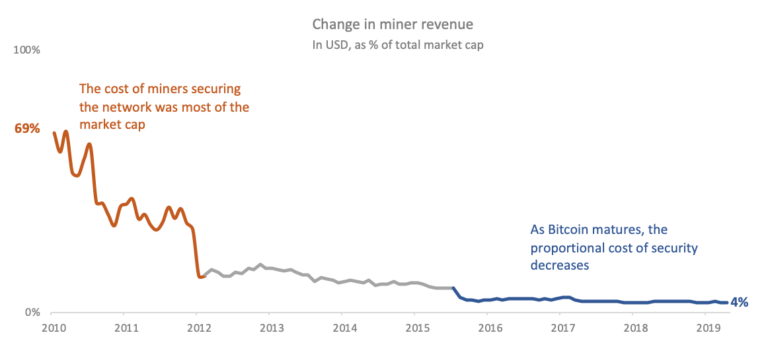
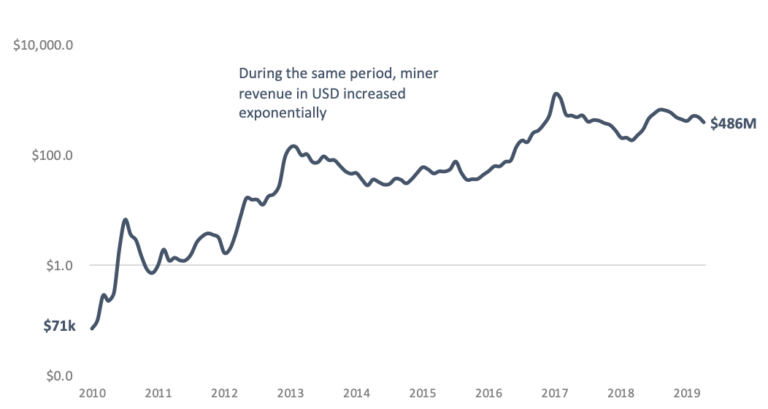
Many who are unsure about the future viability of bitcoin’s security suggest that bitcoin’s transaction fee market security model is untested, and therefore in the future, bitcoin may need to have a certain amount of terminal inflation in order to adequately secure the network. They are really suggesting that at some point in the future, we may have to again socialize bitcoin’s security costs by changing bitcoin’s total supply and by reintroducing or increasing the block subsidy.
This argument is often used as an example to explain that altcoin X “prioritizes security over a fixed monetary policy.” Rather than operate with a fixed supply and a fixed supply schedule, the currency issuance needs to be variable in order to pay for adequate security, or so the story goes. This article intends to demonstrate that these arguments start from provably false assumptions, and then will build a counter-argument using axiomatic assumptions.
The following exposition assumes that bitcoin is alive, which you can confirm is axiomatic by checking for yourself before continuing. Before understanding why bitcoin will be secure in the future, we have to understand why bitcoin is alive today.
If bitcoin is alive, keep reading. If bitcoin is dead, good game and thanks for playing.
Why is Bitcoin still alive?
Bitcoin is still alive today because some individuals subjectively deem it valuable enough to keep alive. If nobody valued bitcoin, it would be dead. Whether or not you personally agree that bitcoin is valuable is irrelevant. Bitcoin is alive because people find it valuable, and there are a number of ways the network is kept alive. Some bitcoiners keep it alive by using bitcoin as a savings technology – storing value in it. Some of those individuals run full bitcoin nodes, meaning that they are verifying that each block of transactions follows the network consensus rules. Others write code that they hope will be run by individuals operating full nodes and storing value in bitcoin. It’s certainly the case that not everyone that stores value in bitcoin runs a full node or writes code, and it might be the case that node operators and coders don’t store value in bitcoin. They are all contributing to keep bitcoin alive regardless.
And then there are miners. Miners are also bitcoiners that keep the network alive, and they do so by selling electricity to the network (in the form of as many SHA-256 hashes per second as possible). By doing so, these bitcoiners are helping secure the network’s monetary policy and processing transactions for the network. In return for their electricity, miners are paid in bitcoin. Miners get to choose to whom they sell electricity – they can sell hashed electricity to people who pay a lot to make transactions (high fees), or they can donate their electricity to people who don’t pay for transactions at all (zero fees). They can even choose to sell electricity for empty blocks without any transactions, in which case the only compensation would be in the form of the block subsidy (currently 12.5 BTC every 10 minutes). There is no coercion. Miners are allowed to sell their electricity to whomever they choose. Finally, they don’t have to sell their electricity to the bitcoin network at all, which is what a vast, vast majority of energy producers choose today.
Nobody that participates in bitcoin (including miners) knows exactly how much bitcoin is going to be worth in the immediate future; however, most bitcoiners believe that it will increase in value over time, which is the fundamental reason why anyone would accept it for value exchanged in the present. Still, no one knows what the value will be tomorrow. Fortunately, there’s a clever function within the bitcoin network that ensures that as long as bitcoin is valuable to some universe of people, there will always be an economic incentive to sell electricity to secure the network and to ensure that the monetary policy is upheld despite fluctuations in value – bitcoin’s difficulty adjustment. The difficulty adjustment calibrates the network to maintain bitcoin’s fixed monetary policy and its 10-minute average block intervals completely independent from the value of the bitcoin network measured in any other currency, or from the number of participants in the network. All it does is rebalance the amount of hashed electricity the network demands (every 2016 blocks) to ensure that the block time and supply is maintained on a fixed schedule.
For people regarding the network externally, this generally means that if the value of the network increases, the amount of electricity demanded by the network increases, and if the value decreases, the amount of electricity demanded by the network decreases. This calibration ensures that it is always profitable for someone to sell electricity to the network, regardless of the price of bitcoin measured in other currencies. We can confirm that this is working as intended today because, as we’ve previously established, bitcoin is still alive and has maintained its average block cadence, despite wildly fluctuating in value, hashrate, and difficulty over the last 11 years.
All bitcoin network participants have voluntarily opted into this system for many reasons, one of which is that bitcoin is a currency with a finitely scarce supply. In fact, it might be the only form of absolute scarcity humanity has seen thus far, which is a primary reason why bitcoin is valuable. A fixed supply of 21 million is how bitcoin derives value and explains why there is any value in the first place with which to pay for security. Without a fixed supply, there would be nothing valuable enough to secure. But, its security is only made possible by aligning individual incentives through clearly defined rules, math, and code.
This scarcity is reinforced as the network increasingly decentralizes over time. As more people understand this scarcity and deem bitcoin valuable to protect, they choose to opt in to one or more of the above methods to protect it, which makes it more valuable, which encourages others to try it out. It’s a feedback loop that relies on bitcoin’s incentives functioning correctly.
The Transaction Fee Market has been tested for 11 years
The pervasive marketing that bitcoin has an “untested security model” is false. Bitcoin has been alive and constantly tested for 11+ years, and the rules have been known to all participants interested in learning them for its entire existence. Clear rules that all participants can verify individually are necessary to maintain its supply. Its fixed supply is one of the primary drivers of bitcoin’s increase in value, and when bitcoin increases in value, more people choose to sell electricity to the network. Bitcoin holders pay electricity producers the market rate for security, which is recalibrated every 2016 blocks by the difficulty adjustment. Energy producers will only continue to sell electricity to bitcoin holders if what they receive in return is sufficiently valuable. By function of
- more people storing value in bitcoin
- the difficulty adjustment
- the increasingly trusted monetary policy of 21 million
- the competitive bidding for block space
The amount of hashed electricity securing the network increases over the long-run. Meaning, the value of bitcoin has increased so much that despite the current nominal block reward being lower than any other time in bitcoin’s existence, it’s more secure than ever. The purchasing power (or real value) of the block reward continues to increase, despite the nominal block reward consistently declining.
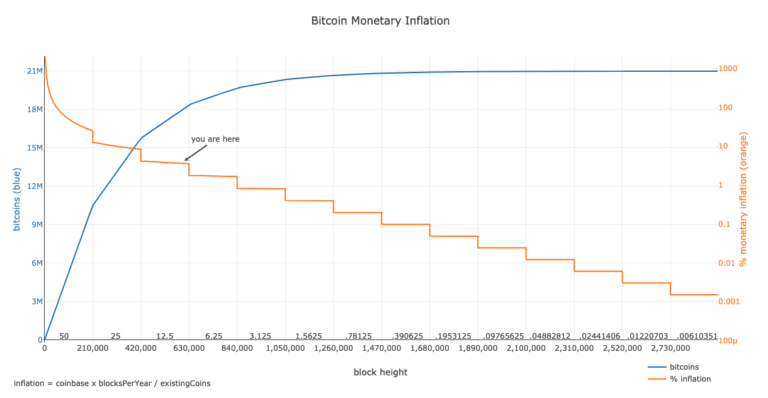
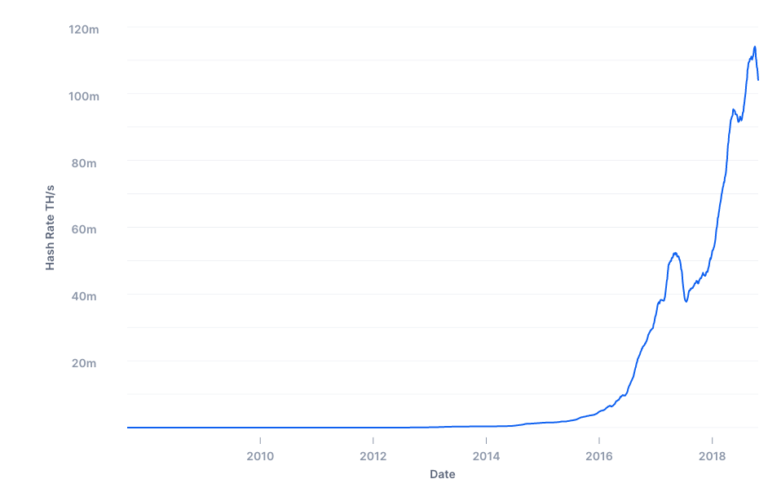
But let’s look at the specific point that skeptics are trying to make: today, the block reward, which is a socialized cost paid by all holders of bitcoin, covers a majority of the value that is paid to miners in return for hashed electricity. What happens when transaction fees are the only incentive for miners to sell electricity? Many skeptics say something like:
“Assuming $X value of bitcoin, transaction fees will need to be at least $Y to cover today’s mining expenses without the subsidy.”
This theoretical transaction fee estimate usually sounds pretty scary, but the above statement is subtly making three outrageous assumptions that rely on an ingrained tendency to view and measure bitcoin in another currency!
Bad assumption 1: Assuming $X value of bitcoin. Bitcoin will never have a totally stable value. Value is subjective, and during the bootstrapping phase of bitcoin in which we all find ourselves living, is extremely volatile. The difficulty adjustment recalibrates the network’s demand for electricity to ensure holders pay a market rate for security.
Bad assumption 2: transactions fees will need to be $Y. What’s the value of a dollar? Today’s value? Why are we trying to measure the future in today’s dollar value? Transactions historically have become cheaper over time measured in Satoshis as people find creative ways to send around smaller amounts of data.
The bitcoin network has no capacity to understand the value of bitcoin measured in another form of currency. There is only what bitcoin transactors choose to bid in order to be included in blocks, and what miners choose to sell electricity to earn, all of which are calibrated to establish consistent block times and find a market equilibrium by the difficulty adjustment.
Bad assumption 3: Using the current mining expenses to estimate the future. We know empirically that hashes individually become cheaper as ASICs improve, and we know that the value of bitcoin is unpredictable in the future. The inputs of this system are electricity (in the form of hashes to earn something valuable) and the difficulty adjustment which calibrates itself so that it is always profitable for someone to sell electricity to the network. This is how the market value for security is discovered. We also know that a vast, vast majority of energy producers are not yet choosing to sell their excess electricity to bitcoin holders. As they come to realize that the bitcoin network can be used as a vent to monetize their excess electricity, the value of a hash will continue to drop substantially.
If bitcoin is still alive today, the value of bitcoin and the number of participants is constantly fluctuating, the pool of cheap electricity and supply of ASICs is massive and getting larger, and the difficulty adjustment calibrates bitcoin to ensure people are always paying a market rate for security, what’s the final input to consider?
Are people transacting today and paying any transaction fees denominated in BTC? If the answer to this question is yes, then the fee market and bitcoin’s security is working as expected.
As an example to break this down further, in 2010, Laszlo famously paid 10,000 BTC for 2 pizzas. A lesser known fact is that he paid a 1 BTC transaction fee. 1 BTC was worth ~$.004 at the time and the hashrate was 0.000075 Terahash per second. The total block of 51 BTC including subsidy and fees paid to miners was worth around 20 cents of hashed electricity. In today’s prices, just the fee he paid is worth ~$7,300. Most of the electricity at the time was donated by hobbyists because bitcoin had very little value, except to the few people using it as an experiment. 10 years later, a completely full block 625027 had 28 million Satoshis (.28 BTC) of transaction fees, worth around $2,000, and was processed with an overall hashrate of 104 million Terahash per second. These transaction fees might be worth $20,000, $200, or $200,000 in the future.
Ultimately, the argument boils down to the fact that we can’t predict the future value of bitcoin, so the network might demand less security than it demands today if the value decreases. But the bitcoin network was designed so that the value of a given sat doesn’t impact how it functions, unless the value is absolutely zero, and as a result, it chugs along regardless of the price or amount people pay in satoshis for transactions. The future value has no impact on how the network functions, only on the amount of hashed electricity demanded.
Inflation as a “solution” to security
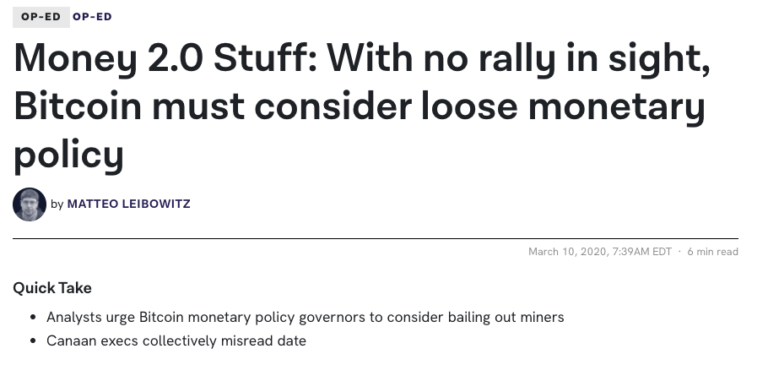 Source. Bitcoin is a currency that is unable to make decisions. Bitcoin’s monetary policy governors are anyone who stores any amount of value in bitcoin. There are an estimated 10s of millions of bitcoin monetary policy governors internationally.
Source. Bitcoin is a currency that is unable to make decisions. Bitcoin’s monetary policy governors are anyone who stores any amount of value in bitcoin. There are an estimated 10s of millions of bitcoin monetary policy governors internationally.
We’ve established above that bitcoin does not have a security problem because the incentives are aligned to always pay the market rate for security based on its present value, but let’s make the faulty assumption that many make. Let’s assume that bitcoin might be insecure (and is not dead somehow). Even if it was insecure, the suggestion of changing the fixed supply to improve security is extreme Keynesian economics logic with no basis in reality.
It stems from a faulty basic assumption that adding additional units of a monetary good increases value. “Number go bigger equal everybody be bigger happy” might be a phrase uttered by an altcoin marketer, nobel prize winning economist, or president of a Federal Reserve branch.
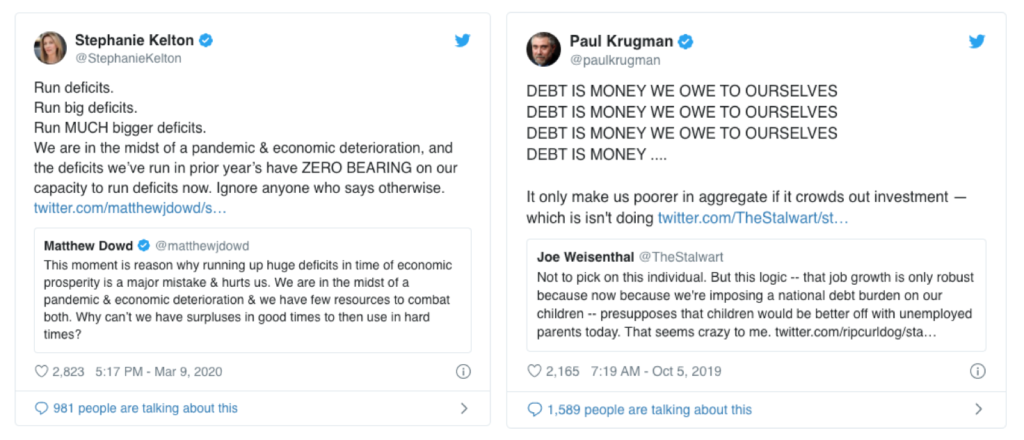
Unfortunately, introducing monetary inflation can’t make anybody “be bigger happy” except for those with the power to print currency and their closest friends, thanks to the Cantillon effect. The Cantillon effect describes how the knowledge of a currency’s debasement spreads throughout society unequally, granting an advantage to those with the power to print money, and causing economic hardships for those furthest away from the printers. Currency is non-productive – it isn’t a company. Having more total supply just means that each individual unit is worth less, and value is transferred from those who hold the currency to those who create more units and distribute them before the rest of the population understands that their savings have been debased.
A currency’s utility comes from storing and communicating value effectively. Value is stored and communicated effectively when the supply and rules are transparent, and no advantages are granted to certain participants. Distorting supply only serves to distort a currency’s ability to perform its job of storing and communicating value; it can’t make a currency more valuable or secure.
A Fixed Supply Increases Security
The current block reward is a fee paid by every bitcoin holder to energy producers that sell hashed electricity to the network. It’s worth it to pay this subsidy today because All 21 Million Bitcoin Already Exist, and if anything about the supply changes, holders of the out-of-consensus fork can sell the new token for more bitcoin, ensuring that the supply of bitcoin is upheld.
The bootstrapping phase of bitcoin grants miners selling electricity to the network the option of not including any transactions (for a time), because everyone holding bitcoin is paying the fee with the value stored as block subsidies. Make no mistake, all bitcoiners are paying for each processed block today, regardless of if they participate in a transaction.
This arguably leads to a tragedy of the commons scenario during bitcoin’s bootstrapping phase, as individuals get to spend BTC (the horror!) with their transaction fee subsidized by everyone, and miners are still paid even when they process empty blocks. As the subsidy decreases, it will become more expensive for miners to sell electricity for empty blocks – the value of a mined block transitions away from being paid by everyone to just those that need to make transactions. This is ok though because even at today’s scale, we have full blocks with individuals paying transaction fees. If we already have full blocks at bitcoin’s current adoption level, adding more users will likely serve to increase the value of the currency and the scarce block space even further. That said, we can never predict the future value of bitcoin, we can only see that the network is functioning as expected despite a fluctuation in value.
As selling hashed electricity to the network gets more competitive, this will serve to increase specialization in different areas of the energy production industry. Certain individuals will focus on ASIC chip production, other individuals will seek out and exploit the cheapest electricity sources, and other individuals will need to optimize how bitcoin transactions are grouped to maximize profits. Finally, entire bitcoin mining derivative markets may develop to help this system weather shocks to any of the inputs, like what we see with the derivative energy markets in Texas.
As a result of fixed rules, fierce competition, increasing scale, and specialization, bitcoin mining becomes more decentralized over time, which further increases security. Changing bitcoin’s supply, assuming everyone just went along with it (terrible assumption), would break these decentralization incentives by reducing the need for miners to find more efficient electricity, improve ASIC chip technology, and process as many transactions as they can. If everyone is paying electricity producers regardless of how well they’re performing at the job, it allows room for rent seeking, which costs every user of bitcoin more for security than they should be paying!
Send it
Adding inflation would destroy the value proposition of bitcoin altogether by proving yet again that it’s trivial to print currency and create copies of things that are digital. Look at every other currency.
Digital scarcity is a one-time phenomenon.
The best protection bitcoin has against all other currencies is its unyielding monetary policy, which is enforced socially and technically by every individual that stores value in bitcoin. There will likely be inflation bugs, hard forks, and new currencies printed throughout the marathon of bitcoin’s ascendance. Social consensus will kick in during these times to ensure the 21 million policy remains intact. What does social consensus look like?
If you still feel that bitcoin has an insecure monetary policy, just create a fork that includes inflation. It’s trivially easy to do this; it’s permissionless money, and all ideas can be tried in open competition.
That said, when more copies of bitcoin are created, I will do what I have done with all forks, airdrops, and infinitely inflating currencies – convert them to more bitcoin, which is truly scarce. This process transfers wealth from those who do not understand economics to those who do. Adding units of currency does not create value, it merely transfers it. I’m personally optimistic that the process of transferring wealth from those who don’t understand these concepts to those who do will lead to positive outcomes for humanity in the future.
It’s easy to create as many units of another currency as you’d like. In bitcoin, 21 million is non-negotiable.
Views presented are expressly my own and not those of Unchained Capital or my colleagues. Thanks to Parker Lewis, Will Cole, and Alex Smith for reviewing and for providing valuable feedback.
Choose your Fiction
By Arthur Hayes
Posted April 9, 2020
 Forky (Source: Pixar Animation Studios)
Forky (Source: Pixar Animation Studios)
Shazaam! You snap your fingers and COVID has disappeared, you can exit lockdown and continue on with your life. How do you feel? Are you as optimistic as you were in January? Do you trust your government to put your health and safety first? Do you trust your government to tell you the truth in a timely manner, or will it juke the stats when it suits them? Do you trust the media to speak truth to power? Will you wash your hands once an hour furiously, or blithely touch your eyes, nose, and mouth with zero fucks given?
If, once we’re out of this, you can honestly say that everything has gone back to how it was in early January of this year, then happy days. It may well be that we are in for a V-shaped economic recovery. But if, as I believe, your world view has fundamentally changed, the fictions that underpinned your life have shifted dramatically. As we consider the most important price, the price of money and its nature, predicting the collective fiction we believe in becomes of utmost importance.
Money, true money, which is divorced from industrial utility, is nothing more than a fiction which allows us to exchange labour and capital efficiently so that real goods and services can be produced. Without this fiction … the conveniences of modern society would cease to exist. There are three prevalent monetary fictions whose interrelationships post-COVID will completely change.
Government Fiat, aka The USD = Fiction + Violence
We know the USD has value because contracts and taxes owed will be collected at the barrel of a gun if necessary. The dollar derives value from a strong belief the United States can raise taxes to pay back its debts.
Gold = Fiction + Physical Scarcity
Gold has no widespread industrial use case. It is just shiny, physically scarce, malleable, and has captivated human attention for millennia. Therefore it has value.
Bitcoin = Fiction + Cryptographic Scarcity
Bitcoin has value because a piece of open source code is collectively run by many guarantees that only 21 million units will ever exist. Therefore it has value.
After the senseless destruction of human lives in WWII, the victors sat down in Bretton Woods and created the modern financial system underpinned by the USD. We still are under the yoke of the USD today.
The USD used to be worth its weight in gold, $35/oz to be exact until 1971. Tricky Dick wanted to fight a war while giving out goodies at home. “Free Shit, Vote for Me!” That’s the best way to win any election. However, he couldn’t stomach a run on the nation’s gold so he severed the relationship. Since then, the value of USD has depended entirely on trust.
Fast forward to January 2020. The US has the most liquid financial market and is completely open to all capital. All major commodities and trade is priced in dollars. Therefore if you are a country or company doing international business you must have access to those dollars.
That’s great for everyone when the beat is going strong. The Federal Reserve has a global obligation to keep dollars in good, cheap supply. That is why they have FX swap lines with the major central banks. The world is short on the dollar and only demure academic-looking Federal Reserve governors can provide them.
Countries and companies can easily earn dollars by selling knick knacks to rich Americans. 70% of American GDP is driven by consumption. It makes the world go round. Hundreds of millions of peasants have been lifted out of abject poverty so that they can produce cheap iPhones, AirJordans, or F150s, all so the parent “American” company can enjoy record profit margins.
Europeans are not far behind in their consumption. Europe and America combined represents the global demand for goods. Absent them, who the fuck is going to buy this dog shit at insane markups?
Deng Xiaoping on his Southern Tour unleashed the Chinese upon the world after a hundred year hiatus. They began powering the luxury goods, travel, and education sectors after gaining serious wealth from the offshoring of manufacturing from West to East.
Sorry for waxing philosophical, I’m no modern day Thoreau and I certainly don’t live on a pond. Keeping it simple: China sells shit in dollars that Americans and Europeans buy.
Uh oh, COVID… China shut down production to fight the virus, meaning no dollar income. Then Americans and Europeans caught it and shut down their economies, meaning no more demand.
Once China “opened” again for business and started making stuff, there were no orders from the West as they were all watching PornHub at home and ordering GrubHub. If they aren’t vegging-out, they’re worried about when their next paycheck will arrive to pay for fuck-off expensive medical care. The moral of this sorry tale is that China ain’t earning dollars.
And they are not alone. No major manufacturing or services hub is earning any dollars. But they need them to pay for raw commodities and to pay back their dollar liabilities. It would be all gravy if their central bank could print dollars, but Mon Dieu! They cannot lah.
A mini EM currency meltdown occurred at the tail end of March. The Fed’s response was to offer swap lines to additional central banks, but not China. That has eased the pressure a bit. But take a look at the CDX EM HY CDS spread. It looks like a West Hollywood blowout hairdo.
The conventional wisdom is that the Fed can print money until the dollar gets cheap enough. But US banks tend to hoard USD and refuse to lend. There are a variety of regulatory reasons why they cannot, and why take the risk during a global depression. Better to be safe and make sure your balance sheet is rock solid.
Simple simple. The Fed can print as much USD as it likes, but the companies and countries that need it the most will not get it. The most important one is China. China’s currency is not convertible and in the eyes of Western Europe and America, it was responsible for this virus. Whether that is true or not is not the point. Do you think for a second any US politician would stand up and ask the Fed to print money so the Chinese economy can survive the COVID pandemic?
The virus supposedly originated in a Wuhan live animal market. The West believes Beijing downplayed or lied about its severity. Then, all of a sudden, it shut the country because it was a serious problem. Too bad a few million infected Chinese travelled the world and started the party. Truth is not the point here; the narrative rules all. This is an election year, and China bashing is in full swing. Cue The Seinfield Soup Nazi, “No dollars for you”.
The USD is STRONK and will destroy the global economy.
The only country which can credibly enact the appropriate amount of fiscal stimulus to weather the storm is the US. No other country has the option to depreciate their currency to the degree necessary to generate economic activity at a level which honours the credit in the system and promises to their plebes. Remember that all raw commodities are priced in dollars, if you print too much money to monetise your government debt, your currency craters and inflation runs rampant. At that point, the Jacobins enter the street and you better not be munching on a cake.
That summarises how I see events playing out over the next decade. I have no idea on timing, but the strong USD will break the back of the global economy and force a reset. The question is what the new system will look like.
Gaze into my portfolio to see my soul:
Long USDCNH 2y 8.00 calls Long USDKRW 1y 1600 calls Long CDX EM CDSI Sprd (I don’t have this on yet, but I’m waiting for my levels on the rebound in markets)
Central banks will devalue against a hard digital asset. What that digital asset is, I have no clue. But, it may include a linkage to bitcoin. The USD fiction is over.
It’s time for a new mental crutch.
Do you believe in Physical or Cryptographic scarcity?
After a societal fetish for all things fiat, the pendulum will swing wildly towards what is hard and scarce. Traditionally investors expect a weak gold or bitcoin price when the dollar is strong.
But dollars cannot be had, and trust in government Frankenstein currencies will evaporate. Gold is the historical best choice. It also is widely owned by central banks. The best way to rebase a currency is an extremely high gold price. This happened during the 1970’s oil crisis, and the Fed raised interest rates to a level where it became silly to own gold when you could earn 20% investing in US Government debt.
This time around, the Fed cannot raise rates. That would destroy the finances of the USG who must hand goodies to all. Remember this is now QE 4 Da People / QE 4eva. The US electorate will not tolerate another exclusive financial services bailout. They will get paid to sit at home, watch NetFlix, aka the Tiger King, and refrain from using their assault rifles to initiate a modern day Whiskey Rebellion.
Therefore, there is not an alternative asset which entices people away from gold as the legacy of Bretton Woods system breaks down. The stock market of the Land of the Free will become a political tool. The US Treasury, powered by the Fed, will buy all government and corporate debt. They will buy equities. They will buy consumer loans. You would think that stocks are the place to be if the government is buying the Index. But let’s remember the Nikkei in 1989. The BOJ now owns upwards of 30% of the Japanese equity market, and the Nikkei is still 50% below its ATH. And I’m only speaking in nominal terms. Try deflating that by the BOJ balance sheet … REKT.
The once mighty US stock market will be a corral of zombie big corporates who had the connections to suck from the teat of the US tax payer. That wouldn’t be so bad if inflation can be kept at bay. However, as the world recovers we have an infinite amount of fiat currency chasing a finite supply of real goods. SMEs represent 60 – 80% of most countries’ economies. These companies, due to their small size and limited connections, pay a high price for credit if it can be obtained. Even with all the well meaning government SME lending programs, a large portion of SMEs will no longer be in existence by the time they can actually access the funds. Complex systems do not recover in a linear fashion.
Therefore, an infinite amount of pledged fiscal and monetary assistance will chase non-existent supply. That leads to inflation. Global stock markets will also become political tools, not efficient allocators of capital. The wrong signals will be sent, the wrong goods will be produced. Can the hipsters handle a $40 smashed avo toast?
The best inflation hedge of human civilisation to date, gold, will be repriced higher. It’s the only thing you can own if you believe in Fiction + Physical scarcity. How high can it go? Take the ratio of the total amount of credit to base money. That multiplier serves as guidance to a possible future for gold. Another possible outcome is the creation of a digital financial non-USD dominated system.
If they dare to come out in the open field and defend the [dollar] standard as a good thing, we shall fight them to the uttermost, having behind us the producing masses of the nation and the world. Having behind us the commercial interests and the laboring interests and all the toiling masses, we shall answer their demands for a [dollar] standard by saying to them, you shall not press down upon the brow of labor this crown of thorns. You shall not crucify mankind upon a cross of [the USD]. -Satoshi Nakamoto’s Democratic Convention Speech 2020
Will a cabal of central banks rebase their currency using a digital hard crypto? Maybe. Could there be a basket of digital fiat currencies where the central banks hold a sufficient amount of gold? Maybe.
All I know is the setup for bitcoin, the hardest form of digital money, could not be better. All manners of trust have evaporated. In order to solve for demand and supply destruction, governments will embark on the greatest fiscal stimulus binge the world has ever seen. It will not be paid for by tax receipts, it can’t be because 30% of the population is out of a job, it will be paid for by the printing press. The kicker is that, in order to hand money directly to the people, governments will have to digitise their currencies. That will educate the populace on digital money. Once they understand fiat digital money, they will seek out the hard version to avert the ravages of inflation. If you believed that Libra could educate the masses on the joys of digital currencies, just imagine when everyone on Basic spends their food stamps via a mobile app.
Remember, the supply of goods will be insufficient because of the SME destruction during the global shutdown. Inflation in what you need, deflation in what you want. Digital finance meets wealth preservation equals Bitcoin. ‘Nuff said.
That was a lot of words to get to that conclusion. Now let’s trade it.
Correlation One
In a global margin call, the market will find leverage and punish it.
In a global margin call, all liquid assets will be sold to finance holdings of illiquid ones.
In a global margin call, correlation = 1.
We are in the midst of a global margin call on all risky assets. The reason why every asset class gets the stick is that weak hands used leverage to juice their short volatility strategies.
The BitMEX open interest halved. Leveraged traders got carried out. Platforms who lent dollars to miners against bitcoin (errbody needs dollars), force sold as the market puked.
Leverage was punished, just like in every other asset class. However on a relative basis, Bitcoin in Q1 still outperformed the S&P 500. Its correlation with SPX reached a local high.
Leverage was extinguished on the downside. The BitMEX XBTUSD swap open interest is rebuilding slowly and, as traders get their sea legs and inflation expectations adjust, the search for inflation hedges will begin in earnest.
This is Act One of a global rebalancing. Every pocket of pricing distortion brought about by leverage will be exploited. Buy the dip at your peril.
Bitcoin will be owned unlevered. Could the price retest $3,000? Absolutely. As the SPX rolls over and tests 2,000 expect all asset classes to puke again. As violent as the Q1 collapse in asset values was, we have almost 100 years of imbalances to unwind the ancien régime. My end of 2020 price target remains $20,000.
Everyone knows the shift is upon us, that is why central bankers and politicians will throw all of their tools at this problem. And I will reiterate, that is inflationary because more fiat money will chase a flat to declining supply of real goods and labour. There are only two things to own during the transition to whatever the new system is, and that is gold and bitcoin.
If you think I’m full of shit, or a stark-raving Cassandra, remember what you believed in pre and post-COVID. Can your mental model revert back to January 2020? I will take my inflation adjusted pocket rockets (gold and bitcoin), and call your Bretton Woods seven two off suit. All in, mother fuckers.
The Onion Model of Blockchain Security – Part 1
By Hasu
Posted April 11, 2020

Public blockchains are empirically secure. For most of their (admittedly, short) history they did what they were designed to do, processing transactions without any hiccups. That we can observe. It is harder to come up with a theory of why it’s the case.
Individuals typically explain their pet project’s security with whatever they personally understand and value the most. Depending on who you ask, a public blockchain is either secured by economic incentives, by globally distributed hashpower, by full nodes, or by a rabid community upholding a shared set of values. That’s not entirely surprising: The law of the instrument suggests that we over-rely on tools that are already familiar to us. If your only tool is a hammer, to tend to treat everything as a nail.
I don’t think any of the above factors can explain the phenomenon all on their own. It is too easy to come up with attacks that succeed in spite of perfect protection in one particular area. For example, in a network where all users run a full node, a miner could still replace the entire blockchain with an alternate one where he controls all of the coins. So it must be the combination and interplay of the different parts that generate the amount of security needed for a permissionless digital cash system.
The onion model of blockchain security
The model I propose hopes to synthesize the individual elements of security into a coherent picture. The goal is to look at public blockchain more holistically, detect strengths and weaknesses, and allow the comparison of different blockchains. The security of a public blockchain resembles an onion, where each layer adds additional security:

To permanently destroy a public blockchain, it is necessary to destroy the faith of users in its ledger state (the list of ownership) as well as the ability to reliably update that state going forward. All higher layers serve to prevent this from happening.

Attacks have to pass through this funnel of defensive layers before touching the core. We now discuss the layers one by one.
Cryptographic guarantees
The outermost shield is provided by cryptographic guarantees. Cryptography gives the most reliable form of guarantee, so we want it to do the heavy lifting and prevent most attacks from the get-go. Cryptography ensures, among other things:
- No printing coins from thin air: All blocks (and hence all block rewards) must have a sufficient proof of work attached to them.
- No spending other people’s coins: Digital signature schemes ensure that only the valid owner of a coin can spend it.
- No retroactively changing the contents of old blocks: Hash pointers ensure that an attacker has to change all blocks built on top of any old block he wants to change.
All of these attacks are rejected by the first filter:

But while cryptography is very powerful, there are other assurances it cannot provide. For example, it cannot decide which of two equally long blockchains is the “correct” one (that would require knowledge about the real world, such as “which of them will other people switch to” and “which of them has the higher market value in the long-term”). It also cannot force miners to mine on a specific block, publish a block once they found it, or even ensure they include specific transactions.
Consensus guarantees
Some of the attacks that pass the first layer will be stopped in the consensus process. In Nakamoto consensus, nodes constantly observe the network and automatically switch to the longest (most expensive) chain. Miners only get paid if their blocks end up being part of that longest chain, so they need to converge with the other miners. As a result, there is a strong bias for miners to work on the tip of the blockchain because that’s where their block is most likely to become recognized by everyone else.
If a rogue miner wanted to mine on a previous block, he would enter a race condition with the rest of the miners who continue to work on the tip of the chain. Only if he finds several blocks faster than everyone else combined, he can catch up and then pull ahead. But depending on his share of hashpower, he is very unlikely to succeed with even a very shallow reorganization.

For an attack to work reliably, an attacker needs to first obtain control over the consensus layer. That means controlling either >50% of hashpower in proof-of-work, >33% of stake in BFT-based proof-of-stake, or >50% of stake in longest-chain based proof-of-stake.
The operational difficulty of this is often underestimated. For example, large governments are typically seen as the largest risk to public blockchains. However, if they wanted to buy the necessary hardware on the primary markets they would quickly find that annual production is capped by chip foundries in China, Taiwan, and South Korea. And their capacity is further capped by rare-earth mining in Australia, wafer production in Asia and Africa, and so on. There’s only a limited amount of capacity available every year, even for a highly motivated buyer. Acquiring the necessary hardware that way could take at least 2-3 years, and would not go unnoticed.
Only China could get to 50% hashpower by confiscating existing hardware or possibly coerce pool owners into launching a single attack. This could work, but only until individual miners start to notice and direct their hashpower elsewhere. While an attack like this is very unlikely to work against Bitcoin anytime soon, smaller networks command respectively smaller shares of hashpower or stake. In that case, the space of possible attackers can include smaller (rogue) governments as well as the entire private sector.
Economic guarantees
I’ve previously argued that thanks to economic guarantees, blockchains don’t immediately break if a single entity controls the consensus layer. By setting the right incentives, blockchains can associate a real-world cost with misbehavior. The ability to due that comes from the native token, introducing a concept of digital scarcity (and hence value) that can reward good behavior (with block rewards and fees) and punish bad behavior (either by slashing security deposits or by withholding future rewards.)
The size of these incentives scales with the level of control an actor has over the consensus layer. An actor who controls a lot of hashpower (even a majority) has proportionally more to lose from destroying the system. Thereby, attacks are discouraged with economic punishment for the attacker.
If a rogue miner wanted to mine on a previous block, he would enter a race condition with the rest of the miners who continue to work on the tip of the chain. Only if he finds several blocks faster than everyone else combined, he can catch up and then pull ahead. But depending on his share of hashpower, he is very unlikely to succeed with even a very shallow reorganization.

Not all economic incentives are made equal. A network with a larger block reward relative to network value is more secure because it forces miners to have more skin in the game. (This is why the declining block subsidy poses a risk to Bitcoin’s security).
Miners also have more skin in the game when hashing requires specialized hardware (so-called ASICs) that cannot be repurposed if the network disappears. It is no coincidence that all mining attacks to date have happened to smaller networks that subscribe to a fallacy called ASIC-resistance, where control can be acquired with little, or even no skin in the game (e.g. by renting hashpower).
Social guarantees
Previously we said that to permanently destroy a public blockchain, it is necessary to destroy the faith of users in its ledger state (the list of ownership) as well as the ability to reliably update that state going forward.
This is necessary because blockchains are not the ends itself. There’s no reason to pack up and go home because some parts of it failed temporarily. A blockchain is merely a means to automate the process of establishing a social consensus between its participants, a tool to maintain and update a shared database. The state of that database has value to the participants, and they are strongly incentivized to restore the system when it breaks.
For example, if the cryptographic hash function breaks, the social layer can come to a manual consensus (guided by technical experts) to replace the broken part:
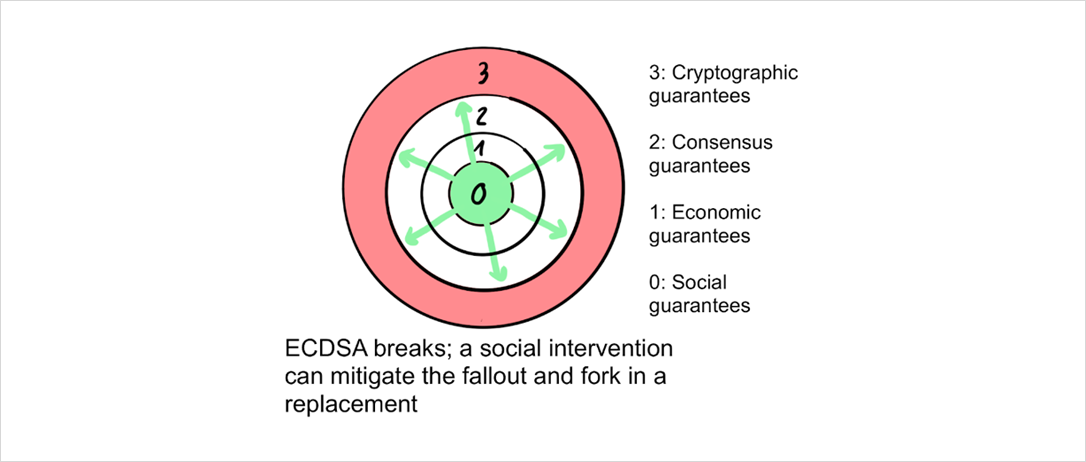
Likewise, if a consensus attack makes it past the stage of economic guarantees, the social layer can still manually reject it. If an attacker with majority hashpower started to DOS the network by mining empty blocks, in full acceptance of the economic damage to himself, then users could decide to change the PoW function and thereby remove that miner’s control manually.
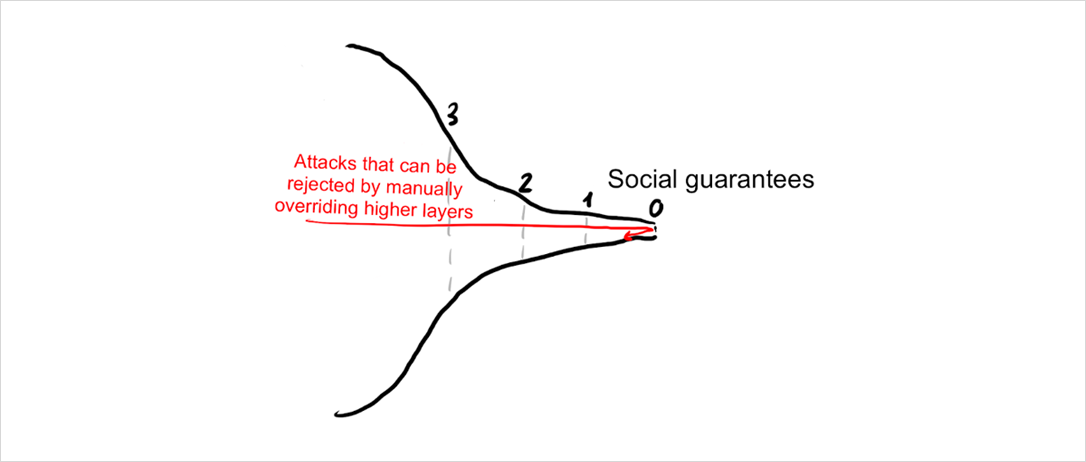
As we can see, the only way to kill a blockchain for good is to either make users lose interest in the ledger state itself or damage the system to a degree that it cannot possibly be fixed.
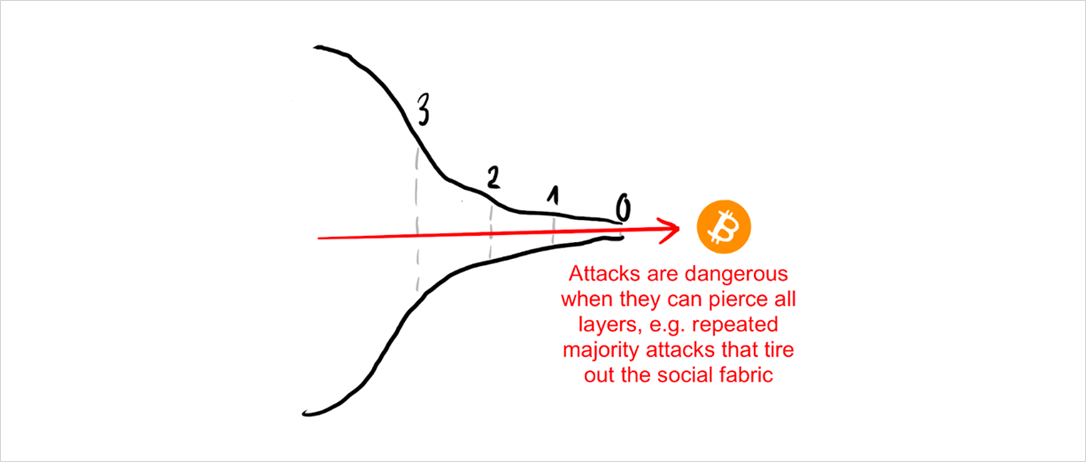
Attacks are dangerous when they can pierce all the layers and ultimately wear out the social core of the system until it can no longer override damage to higher layers and heal.
For both the healing and the manual intervention to work, the communities of each project need strong social conventions around their project’s main properties. In the case of Bitcoin, these core values are irreversibility of transactions, censorship-resistance, no backward-incompatible changes, and the 21m token cap. They serve as action blueprints for when social intervention becomes necessary, and create Schelling points around what needs to be fixed and what doesn’t.
These core values of a project are perpetually renegotiated, and not all users agree on all properties. However, the stronger the agreement around a particular value, the more likely it can be upheld during times of hardship.
Looking at the social layer as ground zero of any blockchain, we can see that social engineering attacks are a big threat. Higher layers become more vulnerable if rogue developers can sneak in detrimental code changes without supervision, particularly in projects with frequent hard-fork policies (recommended read on the topic).
Conclusion and future parts
I find the onion model useful to see how individual layers of a blockchain can create a secure whole. In some ways, it builds on my previous article on Bitcoin’s social contract: Any public blockchain starts from a set of shared values at the core, a blueprint for what the system hopes to achieve.
That set of values must be translated into rules of interpersonal behavior (the protocol!). Then we enforce these rules automatically, creating different types of guarantees: economic, consensus, and cryptographic. By constraining the behavior of its participants, the system becomes socially scalable, thereby enabling cooperation and hence wealth creation in low-trust environments.
Stay tuned for future parts, where we start applying the model to specific projects, starting with Bitcoin.
Proof of Progress: Bitcoin anarchism meets the establishment
By Daniel Frumkin
Posted April 12, 2020

“Everybody who deeply understands Bitcoin also owns some Bitcoin.” — Bitcoiners
The Bitcoin industry is full of lots of really smart and conscientious people. Computer scientists, financial analysts, investment fund managers, and even a human rights activist or two.
Something that many of these participants have in common is that they’ve rarely, if ever, encountered somebody who understands Bitcoin really well and who doesn’t buy into it. There are a few famous pundits who serve as exceptions to the rule, but even those can be explained as having conflicting interests, such as running a business that sells gold to people, for example.
Ever since I dove down the rabbit hole in 2016, I have known an entirely obscure cryptocurrency researcher whose status as an exception the rule concerned me far more than the aforementioned famous pundits did.
His Bitcoin skepticism has troubled me deeply because I know he’s ridiculously smart and he understands Bitcoin well. When I was learning about the technical aspects of Bitcoin, he was the one helping me grasp concepts like hash functions and Merkle trees. After I wrote an article explaining the Lightning Network to laypeople, he read it and gave me some tips to improve it. When I got more interested in economics, he came through with lots of cool insights and useful resources. Hell, he even went through real-world examples he thought up to help me understand game theory better. And to top things off, he doesn’t work in the legacy financial system, sell gold to people, or otherwise have a conflict of interest that prevents him from “seeing the beauty of Bitcoin.”
He has understood Bitcoin as well or better than a lot of Bitcoiners do, and he still came to the conclusion that it will be a net negative for the world. Needless to say, this has caused me to spend a lot of time doubting my own beliefs about what it would be like to live in a world where Bitcoin is, at a minimum, in the same category as gold and USD.
The proof of work debate

One of the most fundamental concepts to understand about Bitcoin is proof of work. This is what incentivizes miners who validate blocks to do so honestly (i.e. to not confirm any invalid transactions).
I’m not going to explain proof of work here because this article is going to be long enough as is.
If you understand proof of work, then you know that it inherently incentivizes more and more resource consumption the more valuable Bitcoin becomes. Resources include energy, but also the materials that go into the machines that do the mining, ASICs. Even in a distant hypothetical world with 100% renewable energy, there would still be a lot of raw materials being mined from the earth to produce Bitcoin miners. My friend, being pro-environment (for lack of a better way to say it), has always viewed proof of work as unsustainable should Bitcoin scale to the same market cap size as gold and major fiat currencies.
Back in the day, I tested his anti-PoW stance with whataboutisms. For example, what about the amount of environmental damage caused by mining physical gold? Or what about the cumulative environmental impact of all the banks in the world that Bitcoin could replace? Sadly, none of these things changed the fact that proof of work is still inherently wasteful, so his stance didn’t budge.
More recently, after having worked in the mining business for the past year, I’ve been pushing back pretty hard once again. I sent him articles like Proof of Work is Efficient. I talked about how Bitcoin mining can lead to renewable energy arbitrage and act as a grid-stabilizer to the benefit of energy producers. I shared business models like that of Upstream Data Inc., a company that works on bringing Bitcoin mining to places where excess natural gas is being flared, preventing methane emissions in favor of less damaging carbon dioxide.
Most of all, I’ve stressed that the benefits that Bitcoin provides to society are more than worth the costs of proof of work. Especially considering that the miners with the best chance to survive long-term are those using energy which would otherwise go to waste (i.e. Rejected Energy in the graphic below), as that will always be the cheapest energy available.
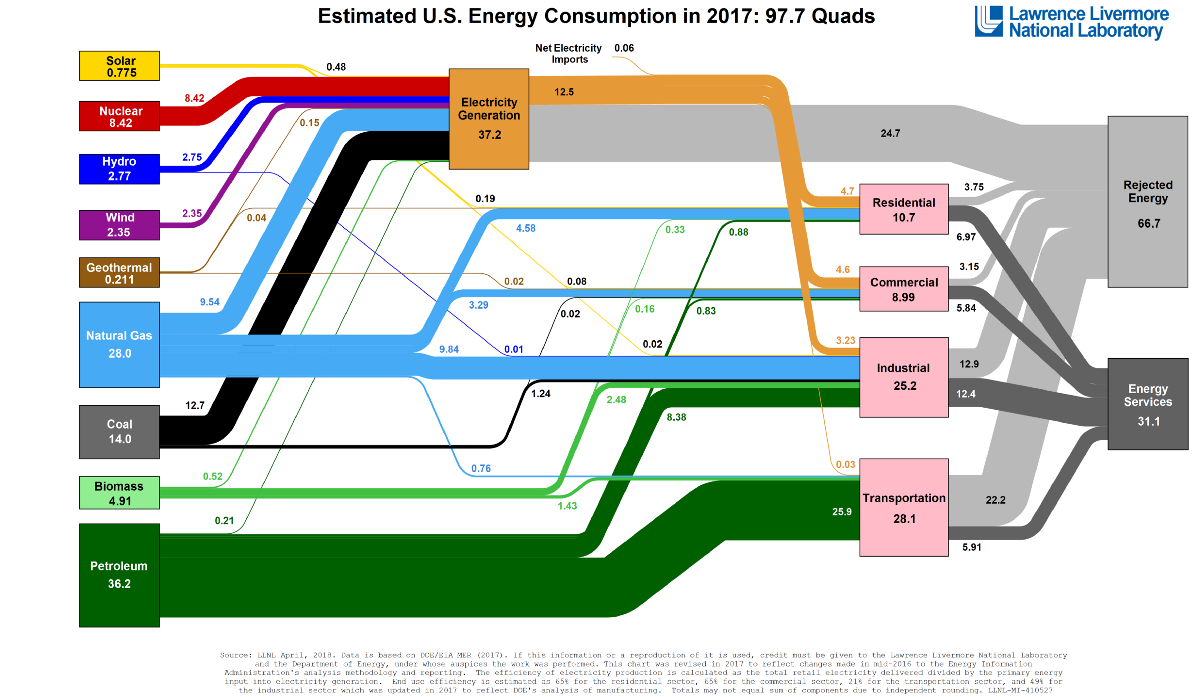
Ultimately, I thought that making him see Bitcoin as a relatively green technology that could scale to mass adoption without causing an environmental disaster would be enough to win him over. I was wrong.
When we took proof of work out of the equation, he still didn’t believe a Bitcoin future would be a better future.
The case against Bitcoin
I hope what I’ve explained so far about my friend makes clear that he doesn’t need to read the article You Don’t Understand Bitcoin Because You Think Money Is Real. He’s not debating _if _Bitcoin can succeed, as he agrees it can — at least in growing far beyond the place it is now. Rather, he’s debating how good it would be for the world if Bitcoin _does _succeed.
Before I get into that, I want to mention that this discussion was mostly focused on the US. When I brought up that Bitcoin can provide censorship-resistant, unconfisctable money to people who need it in many less fortunate countries around the world, he didn’t disagree. But our debate wasn’t whether Bitcoin can make life better in Venezuela, as it obviously can. Rather, our debate was whether Bitcoin could make life better in the place where the current global reserve currency heralds from, the USA.
Let me start by explaining some of my positions coming into the conversation.
I believe that Bitcoin will help solve the problem of growing wealth inequality in the United States and around the world. I believe that unchecked inflation is a significant contributor to wealth inequality, and that “hard” money that can actually retain its purchasing power over time helps the lower and middle class because those people are less likely to be invested in things like stocks that can outperform inflation. (See the Cantillon effect.)
Furthermore, I believe that an economy based on hard money is much easier for the average person to understand and succeed in because basic financial literacy is not taught in schools. For example, does the typical person know to factor in inflation when determining their annual wage increase? Or, in a slightly different case, does the minimum wage earner understand that minimum wage is actually worth less each year unless the government steps in and raises it? (For what it’s worth, my friend and I both agree that having a government-mandated minimum wage is not nearly so good for low income people as it’s usually made to seem by politicians.)
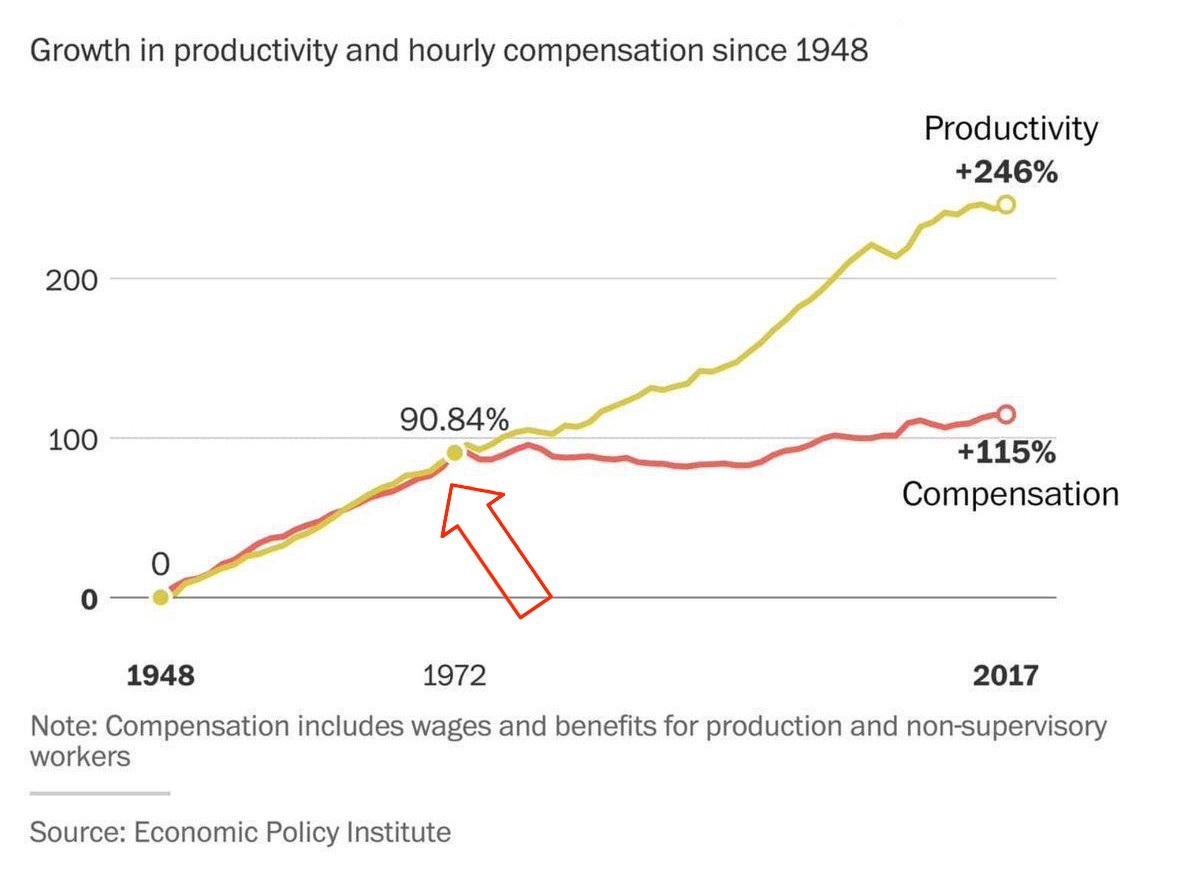
This graph from wtfhappenedin1971.com shows how real wages have stagnated relative to production since the 70’s, when Nixon got rid of the gold standard once and for all. My belief is that Bitcoin helps fix this.
My friend’s stance is that Bitcoin at best partially addresses this, and that it doesn’t solve more substantial problems. Where I was looking at the chart above and seeing the loss of the gold standard as the primary explanation for rising wealth and income inequality, my friend offered 4 other explanations:
- Convoluted tax codes ripe with loopholes and support for tax havens.
- Insufficiently regressive taxes since the Reagan tax cuts of the 1980’s. A common example for this is that Warren Buffet pays less taxes as a percentage of his net worth than his secretary, which is because long-term capital gains tax is at most 20%.
- Unnatural monopolies. An example here would be pharmaceutical patents, which are meant to enable companies to recover R&D costs, but which have been used in conjuncture with intense government lobbying to set ludicrous drug prices and make enormous profits.
- Special interest lobbying. Money and politics go hand-in-hand, hopefully I don’t need to say more.
While Bitcoin can improve monetary policy and help reign in the Cantillon effect, the points listed above aren’t addressed by Bitcoin in any direct way.
At the same time, we had a fundamental disagreement about one of my favorite features of Bitcoin: it’s ability to make government smaller. You see, being in the Bitcoin world everyday, I’m constantly seeing stories about censorship and mass surveillance that make me believe that — given the trend of cash becoming less and less common — the alternative to a future Bitcoin world is a world without much financial privacy or economic freedom for anybody except the ultra-wealthy.
My friend looked at it from an entirely different angle. In his view, the Bitcoin world I was raving about would be one where governments can’t enforce tax policy and thus they would no longer be able to redistribute wealth and provide public goods, resulting in runaway inequality even more extreme than the inequality of today’s society. In his words,
“All of the bank bailouts in the world are a drop in the bucket compared to the compounding interest that the wealthy elites are compiling all the time.”
Now, I’m not writing this article to debate the merits of free markets vs. regulation and taxation. I’m not an economist or a financial analyst and I didn’t even really understand how the Fed works until about a week ago.
The reason I’m writing this article is that I think most of the libertarians and Austrian economists of the world have already found Bitcoin. And for as diverse as the “no-coiners” may be as a group, one thing that most of them seem to have in common is a striking lack of cryptoanarchy in their veins (Hong Kong and Taiwan being the most notable exceptions.) Just as few people outside the Bitcoin world are still actively outraged by the bank bailouts of the 2008 financial crisis, not many of the no-coiners I see in today’s mass-quarantined world seem to care as much about (or even understand) airline and cruise ship bailouts as Bitcoiners do.
If I could find a narrative that would appeal to my friend who knows all about Bitcoin and still doesn’t like it, then maybe that would be a much better narrative to share with all the people who still don’t know about Bitcoin at all.
Censorship (resistance) and inflation
 Screenshot from the popular game Animal Crossing, which is now being banned in China because of the presence of Hong Kong protest slogans like the one shown.
Screenshot from the popular game Animal Crossing, which is now being banned in China because of the presence of Hong Kong protest slogans like the one shown.
I want to reiterate here that my debate with my friend was not about whether or not Bitcoin would become much more valuable in the future. It was about what the consequences of Bitcoin becoming much more valuable would be.
When it comes down to it, we actually agree about way more things than we disagree about. In fact, we agree about so much that I’m going to save some time and just skip straight to the only two things that we disagree about: censorship resistance and inflation.
As I explained above, my friend wants the government to be able to collect taxes in order to redistribute wealth and provide public goods. In other words, the inability of governments to censor Bitcoin means that they will have a harder time collecting taxes in a Bitcoin world and, in his view, this can lead to runaway inequality and a lack of public goods. He also believes that inflation is a necessary feature of currencies because it’s what enables cheap credit.
I’m going to write a second article about the inflation part because it’s too big a topic to include here. But I do want to mention that my friend and I agree that people wouldn’t stop spending money if inflation was swapped for deflation. The idea that people would suddenly starve themselves, become homeless, or otherwise destroy the economy by spending less over 1–2% annual deflation is frankly quite dumb.
Nonetheless, my friend and I have diametrically opposing views on those two aspects of the ideal future. In my view, censorship and inflation are similar to secret backdoors in some communication software… they may be meant to “fight terrorism” or prevent other crimes, but they’ll inevitably harm innocent people.
To put it another way, I’ll quote Blackstone’s ratio:
“It is better that ten guilty persons escape than that one innocent suffer.”
Sure, censorship might be used in the majority of cases to enforce tax policy, but it will also be used to continue things like unjust civil asset forfeiture and other crimes against innocent people. As long as the mechanism for censorship exists, it can be used for evil, and therefore my ideal future is one where money is censorship resistant.
At the same time, inflation may be an important or even necessary feature for currency in order to have a useful credit system (stay tuned for Part 2), but it is also a mechanism that the wealthy can use to enrich themselves while the lower and middle class suffer. What’s worse, inflation doesn’t occur overnight (unless there’s a ‘hyper’ in front of it), so most people don’t even really know it’s happening or understand how it’s impacting them. At least taxation is transparent.
To summarize this section, my friend and I simply cannot agree about these two features. Therefore, we introduced a new currency that we could pit up against Bitcoin that shares all of Bitcoin’s features except for the censorship resistance and hard-capped supply. (Note that in place of the hard-capped supply is programmatic inflation of 2–3%.) We called this completely hypothetical currency Fedcoin.
Bitcoin v̶s̶.̶ and Fedcoin

If our debate had simply ended with an agreement to disagree about censorship and inflation, this wouldn’t have been worth the article. Yet, here we are.
As I mentioned two sections back, I found a Bitcoin-centric narrative that actually appealed to my friend. I didn’t change his views about censorship resistance and the 21 million hard-cap, but I re-framed my vision of a Bitcoin future to show how it would fit into my friend’s vision of a Fedcoin future.
I sent him the following message:
I agree that this hypothetical Fedcoin sounds cool and would be a big upgrade on the current financial system. However, let me now present a somewhat hybrid future that I think is slightly more realistic than your ideal version of Fedcoin and also not as bad (in your view) as the full-blown Libertarian version of a Bitcoin future.
Imagine that Bitcoin continues to grow in value over the coming years, especially as inflation hits due to QE and the like. More people get on-boarded to Coinbase, Square, etc. Eventually, some small startups with international teams move their payrolls onto Coinbase (or a similar platform). Everything is KYCed, and taxes can be collected by all the governments involved. After receiving their payments, the employees can either leave them in their insured and easy-to-use Coinbase wallets, or withdraw them to any other wallet of their choice. Gradually as Bitcoin’s utility and infrastructure continue to grow, this trend picks up steam. More and more international commerce occurs with Bitcoin, and less and less occurs through Swift/PayPal/Western Union. (Almost) nothing changes on the surface for the typical person or company. They are basically just using a different system to manage their finances and it happens to be the same for everybody, regardless of their location in the world.
Problem: The wealthy elites and ultra-libertarians will be able to evade taxes by owning their own private keys, using privacy features, and being extremely careful with how they transact on-chain to avoid incrimination by chain analysis.
Final point: How is the problem stated above worse than an incredibly over-complicated tax code with tons of loopholes, corporations moving offshore to avoid taxation and regulation, and individuals using cash under-the-table to avoid taxes?
In my view, if we make this transition, we’ve upgraded from an inefficient banking system to a modern and global one that treats everybody mostly equally, we’ve made it easy to integrate billions of people into this financial system who otherwise wouldn’t have access to a decent currency or financial infrastructure at all, and we’ve solved the problem of hyperinflation. We’ve separated state and money / monetary policy, without eliminating the state’s ability to fund itself and provide public goods to its citizens. And we did it all peacefully through markets that continually pushed us towards the money with superior properties.
This is where my friend and I were finally able to agree on the merits of a Bitcoin future. He doesn’t believe that full-scale Bitcoinization is going to be good for the world, but he can see how partial-scale Bitcoinization can help us get to his ideal future with Fedcoin.
We still disagree about the ideal endgame, but we can find common ground on the transition to it. To me, this conversation helped clarify how I want to present Bitcoin to my no-coiner friends. Not as some unstoppable ultra-libertarian utopia that’s coming whether they like it or not. No.
Bitcoin is simply progress.
It’s a technology incubator for things like zero-knowledge proofs, the Lightning Network, smart contracts, and more. It’s competition for banks and governments that have had little incentive to improve for the past several decades. It’s a country-agnostic currency that gives everybody an opportunity to participate.
Most people today may not understand Bitcoin. But if you asked them if they’d like to have a financial system that’s more transparent, borderless, cheap, fast, secure, and private, they’d say yes. They just wouldn’t care what it’s called.
Thanks for reading. I know the custodial vs. non-custodial debate is a heated one and Coinbase in particular is a controversial company, so I might receive some flack for this. (If so, bring it on.)
Ever since COVID-19 turned into a global pandemic, I have been thinking about how to use this opportunity to educate my friends about Bitcoin and the economy in general. I’ve been posting lots of Instagram stories and making myself available to talk to anybody who has questions. But this is really nuanced and complicated stuff, so it’s been more challenging to create content than I expected. I hope that this article (and Part 2 on inflation vs. scarcity) are helpful to others as they try to explain Bitcoin to people who may not actually want / understand / believe in the potential future it presents.
Bitcoin mythbusting
By David Parkinson
Posted April 14, 2020
Ever wanted to know why the media and ‘economists’ get it so wrong about Bitcoin? Here’s the Genesis Node point of view on some of the most fundamental topics that regularly appear about Bitcoin in the mainstream media, which are typically biased or poorly presented.
 Photo by Elijah O’Donnell on Unsplash
Photo by Elijah O’Donnell on Unsplash
Bitcoin is private and can be used by criminals and terrorists
This is a favourite of the media and hostile regulators. The fact is that Bitcoin operates using the most transparent, verifiable, and traceable accounting ledger that has ever existed. It is true that identity verification is not always required to create a wallet and send or receive transactions so in this regard there is a level of masking that is provided, however, blockchain forensics is a new and emerging capability that could help to track and trace any funds being used for illegal purposes. Danish police made the news in 2017 when they traced criminals through their Bitcoin transaction activity. It is worth remembering that the current banking system is still the most effective means of laundering money in the world with an estimate of $3 Trillion being laundered through the US system annually, so it seems somewhat hypocritical for lawmakers, media and financial services firms to lay the ‘Bitcoin is used by criminals and terrorists’ argument at the door when the current system is guilty of much worse.
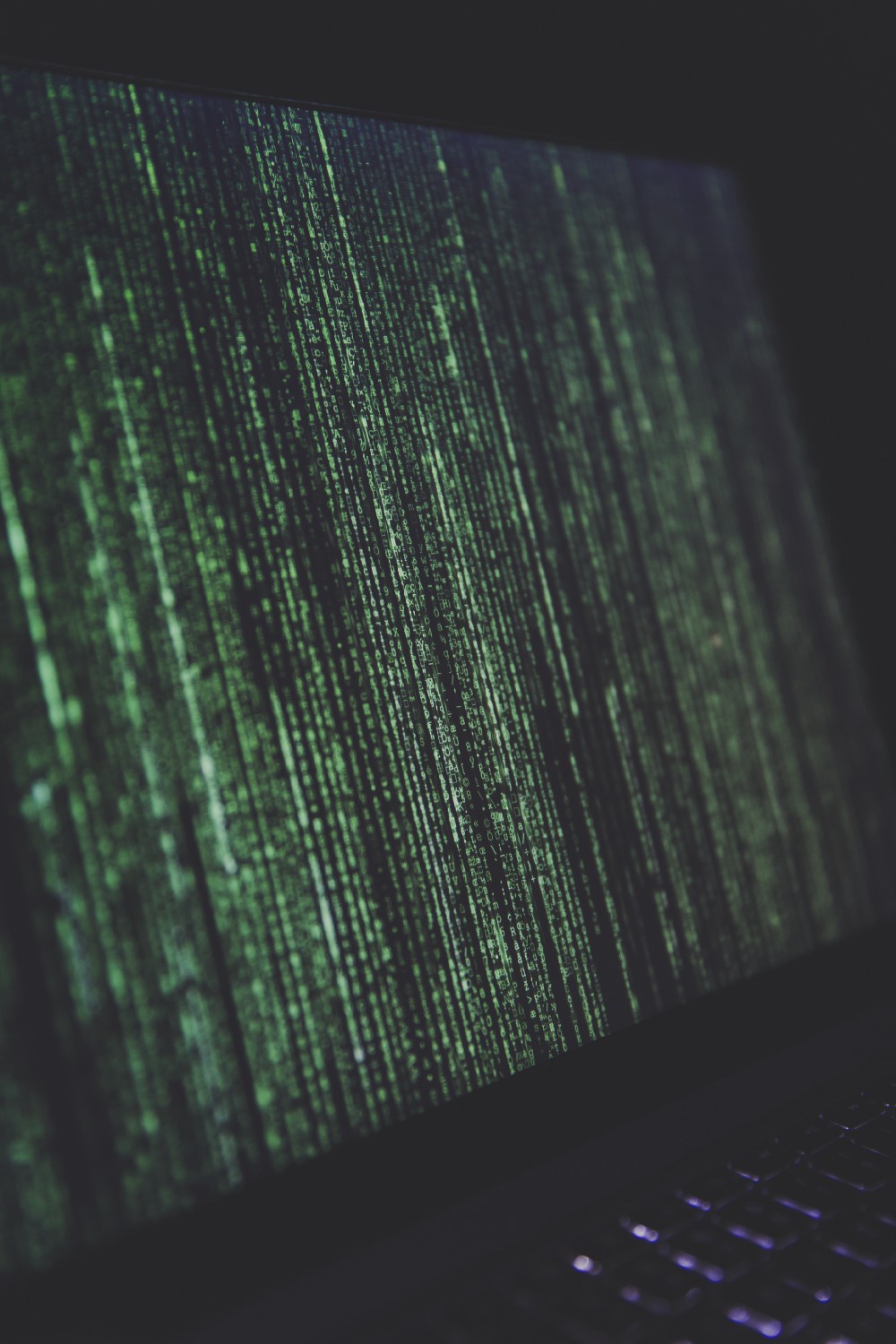 Photo by Markus Spiske on Unsplash
Photo by Markus Spiske on Unsplash
There are other cryptocurrencies such as ZCash, Monero, and the newly developed MimbleWimble protocol that underpins Grin and Beam, which use privacy features to obscure the sender and the recipient. There is certainly a theoretical case to be made that these protocols would be more effective at money laundering, however again, transaction volume analysis suggests that any illegal activity funding taking place over these networks is incredibly small if at all present compared to the volumes being transacted through USD.
At a more philosophical level, here we can also return to whether censoring money is an attractive trait. Ultimately, in a free society, an individual ought to have the ability to transfer value for whatever means and ends they desire and any attempt to monitor, trace or prohibit this can be viewed as censorship…any society where a nation state tries to impose censorship and de-platforming upon its citizens is a society where the citizens desperately need the means to transfer value as required, unencumbered.
Bitcoin mining wastes energy
 Photo by American Public Power Association on Unsplash
Photo by American Public Power Association on Unsplash
This is a particularly sensitive topic and one which the recent trend of climate change activists are sure to latch onto. The truth is that yes, Bitcoin energy consumption is huge, roughly the same as the annual consumption of energy in Ireland or the Czech Republic. The equally huge counter to this that is an uncomfortable truth is that a large percentage of this energy consumption uses green/clean or renewable energy, estimated between 30–70% clean. The range is so high as data is very difficult to verify and as such, allows biased narratives to be deployed by the media.
Further to the country comparisons, it has been reported that the US military alone is the 58th largest consumer of energy in the world — where is the media outcry against this energy consumption?
Whilst that seems a lot, let’s consider some other data points:
- The USA Christmas lights consume more energy annually than some developing countries at around 6.63 billion kilowatt-hours whilst countries like El Salvador uses 5.35 billion kilowatt-hours per year
- The streaming of X-Rated videos from the internet globally is believed to consume as much energy as countries such as Belgium, Bangladesh, and Nigeria contributing c4% of greenhouse gas emissions globally and could rise to 8% of global emissions by 2025
The above are simple examples but the oft used phrase is “we could use that energy for something else.” The challenge here becomes a question of libertarian ideology as there is no royal “we” to centralise and co-ordinate energy consumption globally, ultimately if a user pays for the energy they consume and the market is willing to produce and supply it then what that energy is used for is entirely up to the discretion of the consumer.
The incentives of the Bitcoin network align so well that they promote efficient deployment of capital and operational resources by Bitcoin miners. In other words, Bitcoin miners locate their operations in parts of the world that offer the most cost-effective access to energy and to this date there is no market whereby energy consumers pay more/less for the end, usage of their electricity and until a market develops, which ensures that Bitcoin miners need to pay a higher rate for electricity then they will continue to consume at the market rate. Typically, this is either through use of green or renewable energy sources, which explains why Iceland, with its abundance of geothermal energy, is a key global Bitcoin mining centre.
It is often the case that unused electricity is deployed for use by Bitcoin mining entities, by ‘unused’ we refer to electricity that is generated by a power station, typically through hydroelectric power but an excess capacity is created over and above the required demand so the electricity is lost as it transmits throughout the network, eventually going unused. In this instance, mining companies set up their operations in remote locations in countries such as China and strike deals for excess energy directly with the energy provider themselves. So whilst a popular argument is — “but the human race could use that energy to much better effects” in many cases, much of it is already going to waste, and it cannot be transmitted for use over vast distances anyway. In a somewhat philosophical view, one could counter-argue that such ‘lost’ electricity is actually turned into a commodity money (Bitcoin) and sent globally over the internet making its utility, production, and shipping costs infinitely superior to other global commodities.
In an example of well-aligned incentives a Canadian mining company ‘Upstream Data’ recently developed a product that allows oil drillers to attach a Bitcoin mining rig to their methane gas flares in oil and gas fields to convert the excess energy burned off to power a mining rig and re-use some of the energy by-products of drilling that would have otherwise been lost — incentive alignment works.
As Saifedean Ammous, author of the Bitcoin Standard writes in his research blog:
“Everything in our lives is related to energy. Transportation, manufacturing, cooking etc. requires energy. Thus, efficient energy production is essential to our everyday lives. Bitcoin incentivizes efficient energy production and therefore sets the correct incentives for the energy system as a whole.
In addition, Bitcoin is a serious alternative to the current financial system. Bitcoin has the features to be a qualified, stateless, world currency since it is censorship-resistant, permissionless, and trustless and since it provides instant settlement. The network is open and censorship-resistant through proof of work. Essentially, Bitcoin is a common good from the people for the people.
The correct incentivization inherent in the Bitcoin protocol and the importance of Bitcoin as an alternative to the financial system justify the massive use of energy for mining.”
Bitcoin can’t be used to buy coffee (micro-purchases)
 Photo by Clay Banks on Unsplash
Photo by Clay Banks on Unsplash
Anyone using this argument is focussing on the wrong metrics and not comparing like for like and even worse, being dragged into the somewhat fanatical and disingenuous world of the white paper title outlining that Bitcoin was intended to be ‘peer to peer electronic cash.’ Over time, Bitcoin has developed and grown to becoming more akin to a form of digital gold, and to an extent, is a ‘heavy’ digital asset to use as it takes longer than others to confirm transactions on the network. So whilst this comment is partly true as it could take an hour or more to confirm the transaction, it is wrong to compare Bitcoin transaction speed and scalability to that of the Visa, PayPal or Venmo networks.
Essentially Bitcoin is a network for final settlement — it probably is not important to use the Bitcoin network to record your coffee transaction on the most immutable and transparent ledger…for ever.
As Bitcoin and blockchain researcher and thought leader Nic Carter states, Bitcoin is best thought of as a large container ship transporting expensive goods over long distances rather than the local postman delivering letters and parcels over the final mile.
When humans began to deploy fiat or paper money for use in an economy in place of a specie backed currency such as the gold standard, this can be referred to as a ‘Layer 2’ technology. Use of precious metals in direct exchange is layer 1, the addition of a 1:1 backed paper is the second layer making portability much easier. Layer 2 or 3 solutions on top of Bitcoin such as the Lightning network, may well deliver the scalability in Bitcoin that many are asking for so it can be used for micro-purchases. Even a bi-metallic standard equivalent digital asset protocol that is less energy intensive than Bitcoin and serves as a ‘Silver’ or a ‘Copper’ to Bitcoin’s gold could develop.
Ultimately there is a cost to write transactions on the Bitcoin blockchain, in future, this may rise, and as such, these transactions may be pooled and netted off on a less frequent basis in a similar way that central banks settle balance of payments deficits today.
In summary, comparing Bitcoin to Visa, PayPal and Venmo is the wrong comparison to make at this point, but over time, Bitcoin may well have additional layers of technology to solve the scalability challenge, and this may also extend to the inclusion of some form of privacy.
Bitcoin isn’t backed by anything / has no intrinsic value
 Photo by Jacek Dylag on Unsplash
Photo by Jacek Dylag on Unsplash
Since 1971 and the complete separation from the gold exchange standard, the US dollar has not had anything backing it. Fiat currency is an established medium of exchange, however, in some countries, it does not serve its purpose well as a store of value or a unit of account due to hyperinflationary challenges. However, if we set these to one side, the notion that fiat currency is backed by anything is a severely misguided notion. It is true that governments mandate the use of fiat currency and as such, they ‘back the use by Law.’ This does not give fiat currency any real value, however, and if the government and central bank mismanage the economy, they undermine the value of the currency and cause inflationary challenges as we saw in countries such as Argentina, Zimbabwe and many others throughout the 20th century.
Money is a collective belief system and anyone who wants to argue that fiat currency is ‘backed by fundamentals’ is essentially saying, they don’t really understand how money works, they trust central banks and governments because they haven’t researched or analysed any other potential system, their belief systems, frameworks, and mental models allow them to shortcut thinking and analysis of this nature by buying into the notion that ‘the gold standard failed’ and that we now live in a modern banking world. These arguments will ignore the failures of old that are creeping back into the system today and may very well lead to a Roman Empire style collapse of the global economy. We know for certain what the monetary policy and scarcity of the Bitcoin network will be for the next 120 years — we have no idea what any central bank or government may do to monetary and fiscal policy from one week to the next.
If anything, Bitcoin is ‘backed’ by the laws of mathematics and code and unlocking these laws costs time, resource (both human and capital), and energy. Whether Bitcoin has any value is determined by the market forces, and the Austrian economics school theories of Mises and Menger with their notions of subjective value theory and the regression theorem of money — ultimately we view Bitcoin as a Veblen good, and it has only ever served the purpose of value transfer.
Bitcoin could be hacked
 Photo by Clint Patterson on Unsplash
Photo by Clint Patterson on Unsplash
Hacking Bitcoin is next to impossible. It has been in existence for 10 years, and any kind of threat or attack that exists that could disrupt it has already been attempted. It is reported that eccentric millionaires have even paid teams of hackers $1m over the course of a year to hack the network, and they have not been able to yield any success.
When we discuss hacking Bitcoin, there are two obvious options:
- To hack the software itself
- To undertake a 51% attack
Hacking the software itself is next to impossible as a result of the verification and mining consensus rules any attempt to alter the software will be rejected by each miner running an up to date version of the software and similarly any attempt to process a fraudulent transaction will be detected by each node and rejected.
People often wonder what makes the Bitcoin blockchain secure, and it is often said that a key risk to Bitcoin is the fact that it is software and software could just be hacked, if not now, then in the future with a quantum computer. The reality is that the Bitcoin blockchain is secure as a result of the multiple different failsafe mechanisms that guard against attack, the energy, and computing power used to continue the longest chain of transaction records and the game theoretical nature of the outcome of such an attack.
To unpick this further, Bitcoin uses complex and advanced cryptographic techniques to guard against a 51% attack. That is the idea that if enough miners grouped together 51% of the total mining resources, then they could unpick the blocks one by one and change the history on the digital ledger to move transactions to other accounts that they hold the private keys for. Such an attack is virtually impossible as the size, cost, and complexity of the attack would require a large number of nation states to work together — a level of cooperation which has never happened in history aside for coalition forces during world war 1 and 2.
To firstly gain access to the necessary computing power and energy required to undo the confirmed transactions would be no mean feat and would effectively result in a split or a fork of the chain as the history and record would now be different from the original. The actors would then need to undertake the attack all the while being watched and monitored by the other 49% who would continue confirming blocks on the original chain. This means that for the attack on the original chain to be successful, the attackers would also need to amend all the new blocks confirmed every 10 minutes since the attack began — otherwise, the attacked chain of the network would have no value. So the attacker would then need to continue spending money on computing power and energy to catch up to the rest of the 49%, which would be a long drawn out process and would likely bankrupt the malicious attacker. It is estimated that a 51% attack on the Bitcoin network would cost an attacker almost $600,000 per hour.
So, in summary, the incentive to launch a 51% attack and change the ledger is just not present. Similarly, any actor attempting to exploit the code or vulnerabilities in the network will have their attack rejected as each node runs a copy of the Bitcoin client and as such, any attempt to make a change to the code will be rejected by the network as all the other nodes will be running a copy of a different software.
Another popular example the media likes to use is that Quantum computing would break the Bitcoin private key encryption — this is akin to saying that you don’t need to worry about ageing because someone will invent time travel before you die. Quantum computing is at least 30 years away and the current claims regarding quantum computing are overstated. That said, the entire Bitcoin development community are already considering how to respond to quantum computing threats and how to embed quantum resistant cryptography into the core software so by the time a legitimate quantum threat exists it is highly likely that a legitimate quantum resistant defense will emerge and the entire Bitcoin code, network, and mining equipment will shift to adopting quantum resistant technologies.
Bitcoin is too volatile to be a store of value
 Photo by Claire Satera on Unsplash
Photo by Claire Satera on Unsplash
We are only 10 years into its lifecycle, so speculation and large holders could manipulate price movements, however, it is important to remember the concept of how commodity money goes through various stages of development. Bitcoin has successfully transitioned from being a collectible to the early stages of a store of value. Once more liquidity comes into the Bitcoin network, then it will be harder for large holders to manipulate the price. At some point, these holders will sell and take their profits to spend on whatever they please. Those coins will then be available on the market for new entrants, and in turn, these individuals may well hold for a long time to watch their value increase and more liquidity comes into the system, again, at a certain point, these people will sell their holdings. The pattern will continue, and there will be severe price appreciations and declines, however, these will become less severe as liquidity increases — once this happens, the store of value stage will be complete, and Bitcoin can then progress to becoming a Medium of Exchange and a Unit of Account.
So at present, volatility attracting new market entrants all the time, however over the long term, the rollercoaster needs to settle into a more traditional, long term market cycle for institutional investors to feel comfortable allocating a significant portion of their assets into it.
For others around the world though, Bitcoin already operates as a store of value in countries where governments and money have failed. Countries such as Venezuela, Argentina, Zimbabwe, and Turkey have all seen appreciations in Bitcoin purchases, and despite price declines from c$20k to $3k, this has been a better place to store wealth than the local currency.
Bitcoin is not regulated and governments will just kill it
 Photo by Sebastian Pichler on Unsplash
Photo by Sebastian Pichler on Unsplash
Regulation doesn’t solve problems entirely. There is no government in the world that can actually regulate the Bitcoin network. Governments can take action around the edges of the network, but even officials within the US Government finally recognise that they cannot stop the Bitcoin network or Bitcoin transactions.
Governments are, however, able to regulate the edges of the network such as the fiat on/off ramps which are typically subject to ‘know your customer’ regulations and ID checks. Governments are also able to regulate activities such as Bitcoin ownership and Bitcoin mining if they wish. Some governments have banned Bitcoin mining as an activity, and others have gone as far as to outline that only the state is allowed to provide Bitcoin mining facilities.
What is clear is that as a protocol, Bitcoin cannot be shut down. Governments do not have the ability to stop it or come anywhere close to killing it. What regulators are looking at and in particular, US regulators is the introduction of investment-friendly vehicles. These will serve as fiat on/off ramps and will allow institutions access to Bitcoin. A key concern is the notion of custody, who will hold the private keys to access the funds on the Bitcoin network? There are proposals in place at present, and it won’t be long before a Bitcoin ETF (Exchange Traded Fund) exists so in some form or another, a regulatory framework will emerge for Bitcoin and the entire cryptoasset industry.
Bitcoin has no CEO

Photo by Hunters Race on Unsplash
That is exactly the point. The decentralised nature means the network is upgraded by consensus and any miner that disagrees with the update can choose to ‘fork’ and continue a separate chain. Not having a CEO means there is no single person or entity that can choose the direction and design of the protocol without vigorous debate with the whole community first. A CEO can be called in to testify in government hearings or pursued for mismanagement of funds — without a CEO the Bitcoin network becomes an entity that is not subject to the normal laws of power, control, coercion, intimidation, manipulation, and corruption — this is one of its greatest assets.
Bitcoin is the first and first doesn’t always mean success
Bitcoin is the 5th iteration since 1990s of a digital money, and it is the first to fully succeed in generating a system that removes centralised 3rd parties and creates digital scarcity. Bitcoin draws upon other previous protocols such as eGold and Hashcash and implements it in a fully decentralised way.
Bitcoin is opensource so it could just be copied/forked and improved
The game theory involved in creating a fork of the Bitcoin code is such that any fork is unlikely to take a significant amount of value, network, or mining power away from the core BTC code. In 2017 a disagreement about transaction scaling ensued where one group wanted to maintain a low block size at around 1 Mb per block, and another group wanted to increase the block size which would, in turn, increase the throughput and speed of transactions. In principle, the idea seemed logical however an entire debate and discourse erupted around the broader risks and challenges that ‘big blocks’ present. One key issue is that the mining ecosystem would no longer be possible for single and small entities, rather it would start to require a more industrial size and scale — this would put control of mining operations more in the favour of large, server farms and corporations who could afford the CAPEX set up and open running costs of such a huge operation. To maintain decentralisation the original chain was maintained whilst a splinter group forked the Bitcoin blockchain and continued transactions using bigger blocks. This was called the Bitcoin Cash or BCash chain. Not long after, further divisions occurred within the BCash community and this chain then split into BCash ABC and BCash Satoshi’s Vision. Needless to say, all of these actions have been almost catastrophic for these chains as they now have next to no value being transferred over them and the mining rewards and incentives are not there as the value of the coins on these chains is very low — the low hashpower as a result also opens up these chains to a 51% attack. The hourly cost to launch a 51% attack on Bitcoin is estimated at $600,000, the equivalent for BCash is $7,500 per hour.
It is by studying the outcomes of chain forks that the beauty of the Bitcoin network, game theoretical reward mechanisms and the in built self-reinforcing incentive mechanisms that one can really appreciate the brilliance of the system.
Conclusion
If you have managed to stay focussed and read through to this section then you deserve a medal! But more importantly, you should now be able to see how and why the media gets the coverage so wrong. The cornerstone of so many articles is put in the wrong place and often intentionally so to present a biased view of ‘why Bitcoin is a failed experiment’ without informing readers or viewers that there is a different viewpoint. For many, Bitcoin is just too complex to understand and they are happy to accept the word of elected officials at the Treasury or Government regarding what money is and how they should interact with it. Typically, economists find it hard to reconcile that commodity money and Austrian economic principles may actually be a better option than the fiat, state-controlled, centrally managed monetary system that is in place globally which they are likely to have studied for 10+ years and committed a significant portion of their time and energy into contributing to. For these people, the truth that Bitcoin is the most effective form of money the world has ever seen is too painful to accept and as an American writer, Upton Sinclair once said,
“it is difficult to get a man to understand something when his salary depends on him not understanding it.”
About us: Genesis Node is an executive training organisation focussing on helping businesses and individuals to understand Bitcoin, digital assets, blockchain, smart contract technology, how they fit into the world and how they might disrupt existing operating models. For more information please contact david@genesis-node.com regarding future webinars and face to face seminars in London, UK.
The Halving or Halvening…
By Aleksander Svetski
Posted April 14, 2020
A philosophical overview
NOTE: This was mostly written in Jan, prior to Corona really breaking out, so I’ll add a section near the end about how that impacts things…and no…Corona will not delay the halving😉
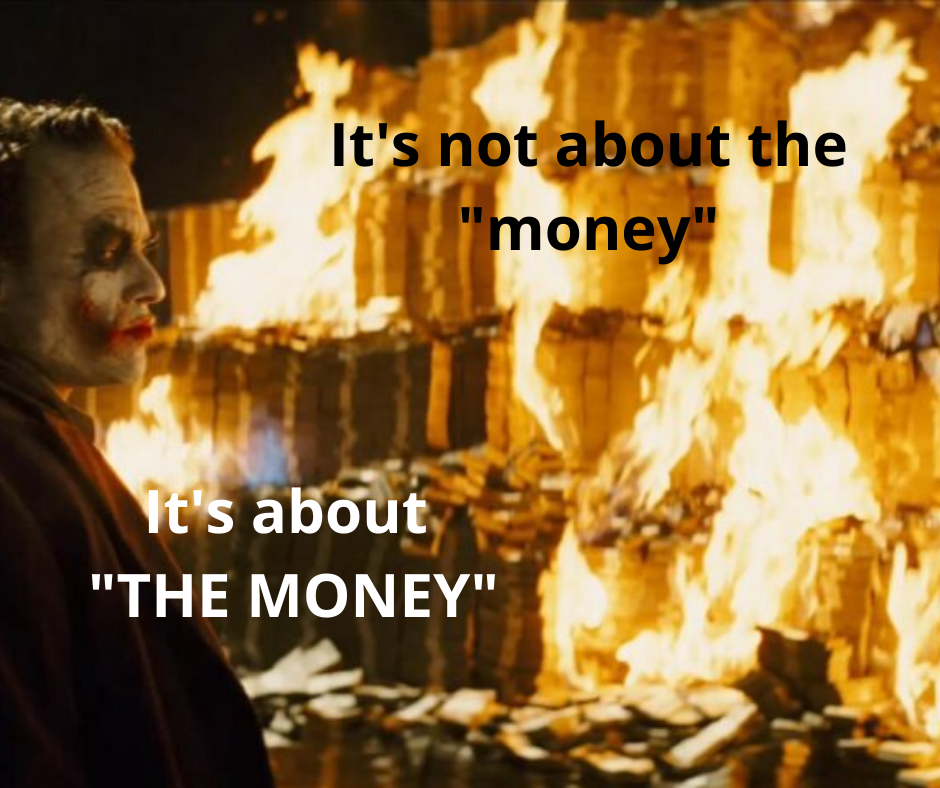 It was always about fixing THE MONEY.
It was always about fixing THE MONEY.
There is an event coming up, which happens every four years (or 210,000 blocks in Bitcoin speak), that many people have been talking about.
It’s known as the Halvening, or the Halving, depending on who you ask. In fact, many have said we should call it the Halfining in honour of Hal Finney, a computer scientist, Cypherpunk and the earliest proponent of Bitcoin other than Satoshi himself (unless Hal was actually Satoshi).
If you’ve heard of it, it’s probably been via some great models built by quantitative analysts such as PlanB and his “S2F” (stock to flow) model, which we will discuss below & link to, but the angle of this article is more fundamental, and an exploration of what the halving represents.
This event is significant, not only in the Bitcoin ecosystem, but on a global scale, as the Bitcoin “social experiment” continues against a backdrop of monetary & fiscal excesses, cheap, abundant credit, soaring asset prices, worldwide political tensions, and most recently, the new coronavirus which has blatantly uncovered the fragility of our over-leveraged system.
The global norm has become one of “more, more, more”, “now, now, now” and “blind excess” with complete disregard to the consequences, costs, ethics & sustainability of the decisions we make today, all which come at the expense of the future.
Bitcoin, and its hardcore proponents, stand almost alone as a pillar of low time preference, built on a foundation of scarcity & transparency, in which the future is not so heavily discounted over an “easy” or “cheap” present.
This upcoming halving event is incredibly symbolic.
It’s a philosophical divergence to the madness of modern times, and it is history in the making.
The Zeitgeist of our time
So what is the halving and what does it really represent?
I believe it represents the growing zeitgeist of our time. It’s a defining moment in history where an entire generation will have the opportunity to rise up, and in the process of claiming their own sovereignty, influence the direction of, and pave the way toward a future that can last.
A future where we stop robbing our kin, their kin and the planet for the blind excesses of the present.
Bitcoin is the ONLY thing halving, whilst everything else in the world is doubling, tripling and expanding without regard to it’s cost.
Fundamental laws of nature & the universe tell us that every action has a reaction, and all decisions come with a cost. When we pay those costs is a function of how long we may be able to kick the can down the road, but ultimately, the road too comes to an end, and when it comes time to pay the piper, those who have to foot the bill may find that there’s nothing left to pay with.
With Bitcoin, we have a chance to fork the road ahead, and then create an alternative end to the path we’re currently on.
Bitcoin and the up-coming halving represents so much more than just some “opportunity to make a bunch of money”. It represents a difference in the core philosophy of how the world unfortunately runs today. It’s a reversion back to appreciating that which is precious, scarce and unique.
Life is precious because it ends. We know day, because we have night. Scarcity has and always will be the defining characteristic of life, and of anything that we value. It’s at the core of how we’ve evolved to understand value, and without it, we lose a big part of what makes us human.
Bitcoin brings scarcity back to the most important human invention (money) and forms a basis upon which we can build a society for us all to value, today and into the future.
A low time preference
Time preference is an economic term, that in the last few years of Bitcoin, has been popularised in circles outside of economics, and almost become a meme (well; it’s definitely a meme amongst bitcoiners, and now spreading beyond).
We can probably thank Saifedean Ammous for that. His book, The Bitcoin Standard is a must read and gives a much fuller explanation of time preference, although I will touch on it here.
Time preference relates to how you value time, and on what temporal scale you prefer to operate on.
It’s best understood via a simple example.
Having a low time preference means:
- You think long term
- You value the future over the present
- You try to leverage/invest time & energy today to have more in the future
Having a high time preference is the opposite:
- Thinking & planning is for the short term
- Now is more important than the future
- Live for today, figure out the future later
Both actually have their place, but in very different contexts, and as with all things in life, one can take each to the extreme, where they can experience detrimental effects.
The below is a view of the benefits & draw backs of a different time preference, and a rough idea of how context may change the way one should approach it.
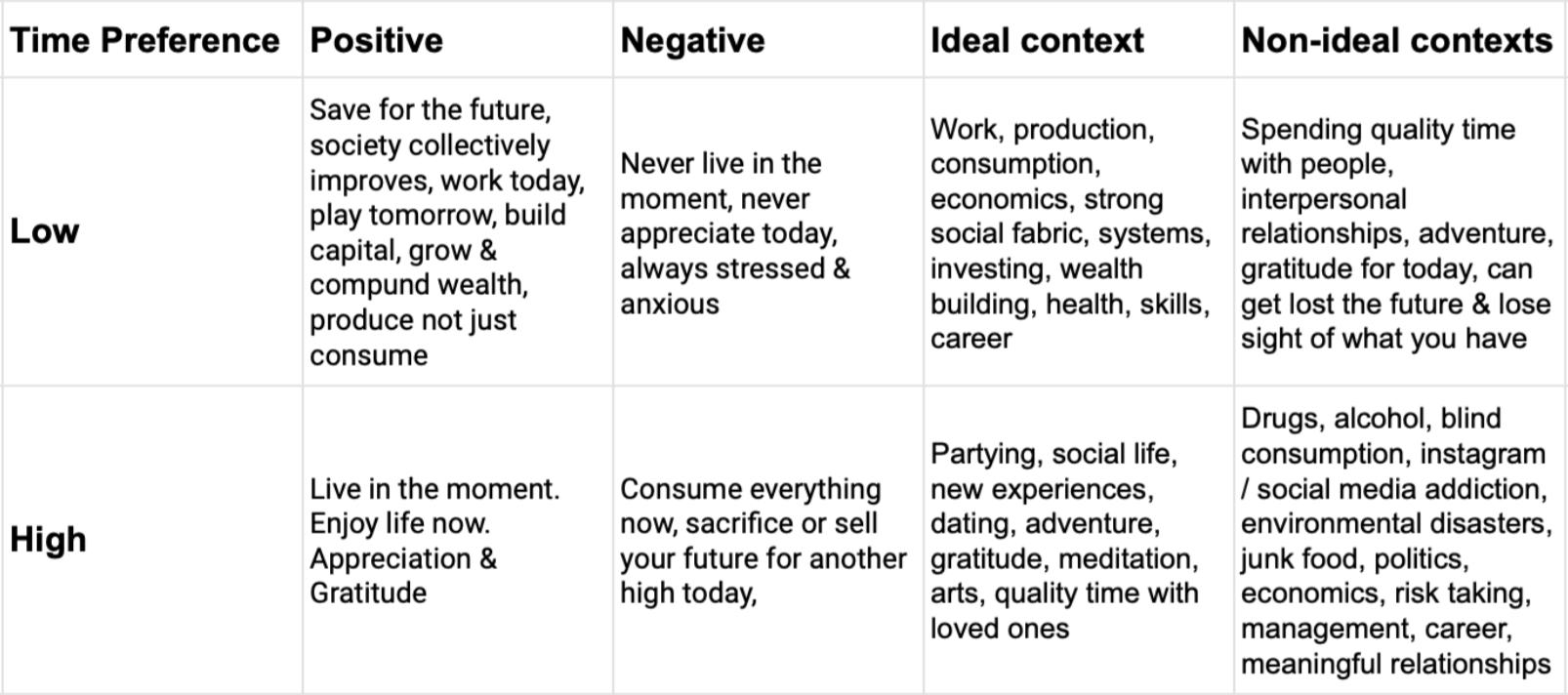 Some trade offs with time preference.
Some trade offs with time preference.
It’s important to note that no rule in life is absolute. For example, with time preferences, one can actually still live in the moment & enjoy today, whilst having a low economic time preference, which will help ensure the capital, resources, and options for a better tomorrow (not just for yourself, but for society as a collective).
This is the game of life. Knowing how to behave & when.
The problem we have today is that economically, we are not given a choice. At scale, society is skewed toward a high-time-preferenced-consume-at-all-costs infrastructure that is not only burning us out, but robbing our future generations of their chance at prosperity.
Economics is the mechanism via which we (humans & society) function at scale. At a collective level, the preference should be low, assuming we want to have a better future. This is a noble goal, and one the so-called “leaders” of today have no concept of.
Greed
As our friend Gordon Gecko said; “Greed is good”.
It’s a fundamental human drive, not only for reasons of survival, but for thriving. Prosperity is inherently linked to greed, but when left unchecked, it can completely skew time preferences & collectively lead us to ruin (ie; the path we’re currently on).
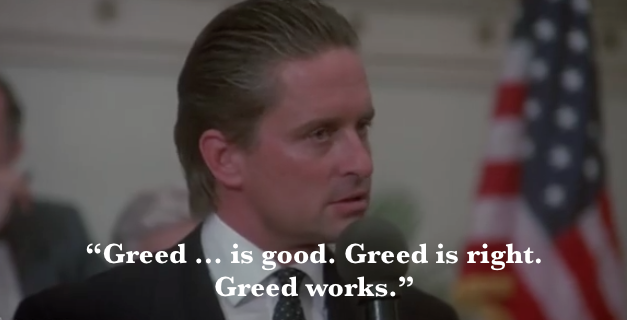 It is & it does. But….
It is & it does. But….
The problem with greed unchecked, is that power concentrates, and those who’ve managed to amass it can construct the system in a way where they have an unfair advantage (again, like our current crony-socio-capitalist system). This is very much a problem with today’s version of “the state” and the medium via which society functions (money & economics).
Things have gone awfully awry, and the only way to fix it is to make changes at the base. Anything we do at the top or on the surface is just playing musical chairs, or games of intellectual sophistry.
If we want a future where freedom is respected, property & prosperity remain rights, and where the best in each of us is rewarded — the economic system needs to change. That can only truly be done at scale with an economic tool like bitcoin.
Something that has no owner, but is owned by us all. Something that cannot be changed, cannot be compromised, and cannot be bent to anybody’s will. Something that grows, from nothing into something, not by decree, but by its very merit.
This is why Bitcoin is the check and balance to the blind excess running rampant in the world today.
It’s the antidote to a consumption-focused high-time-preference society that’s always chasing the next hit.
It’s the contrarian philosophical viewpoint that represents sense, stability, sanity & transparency in a world that’s lost its moral compass.
It’s the antithesis to the Keynesian madness, best exemplified by charts such as these:
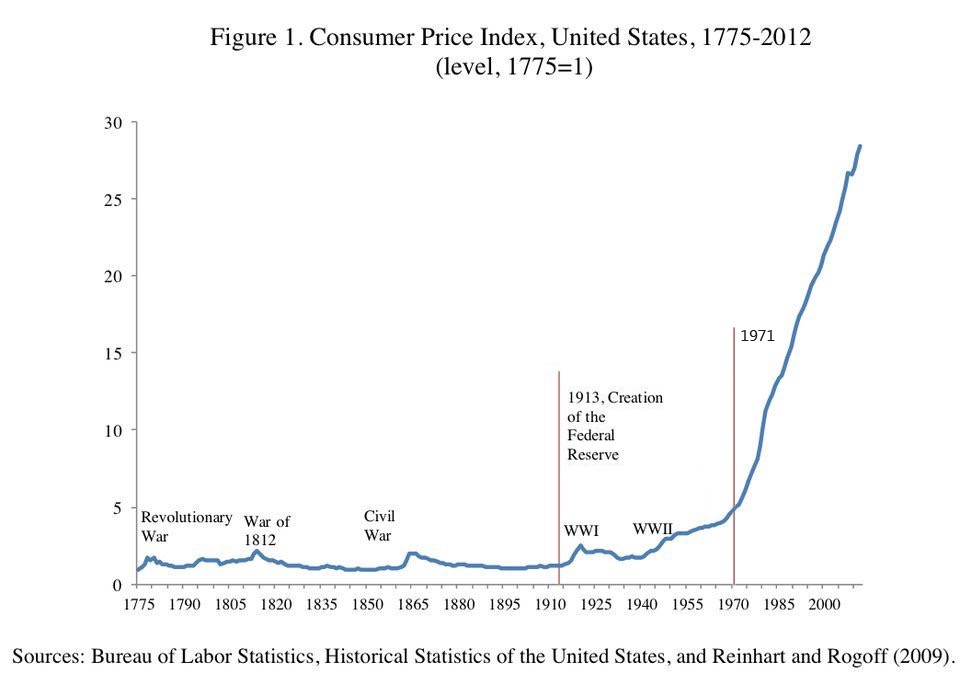
All courtesy of wtfhappenedin1971.com
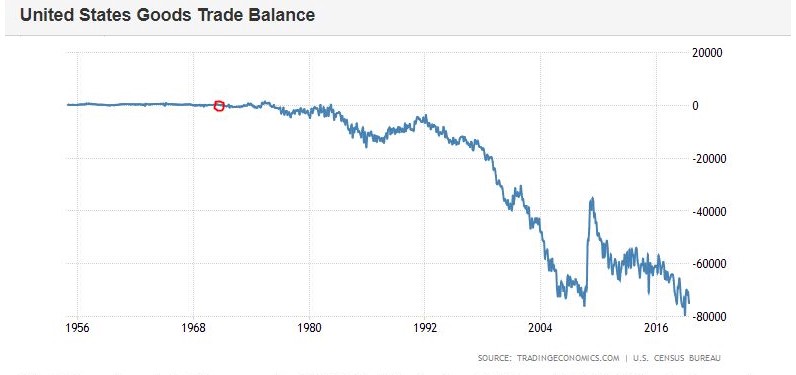
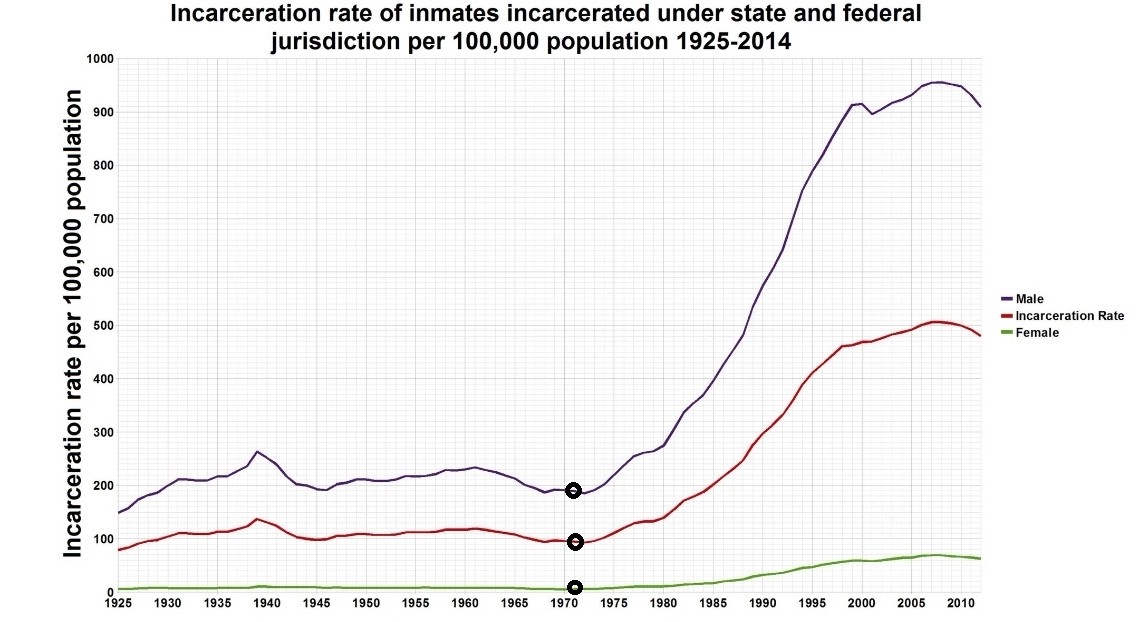
And one which, since this Corona cluster fuck, is going to make the RHS of the chart look like the LHS very shortly:
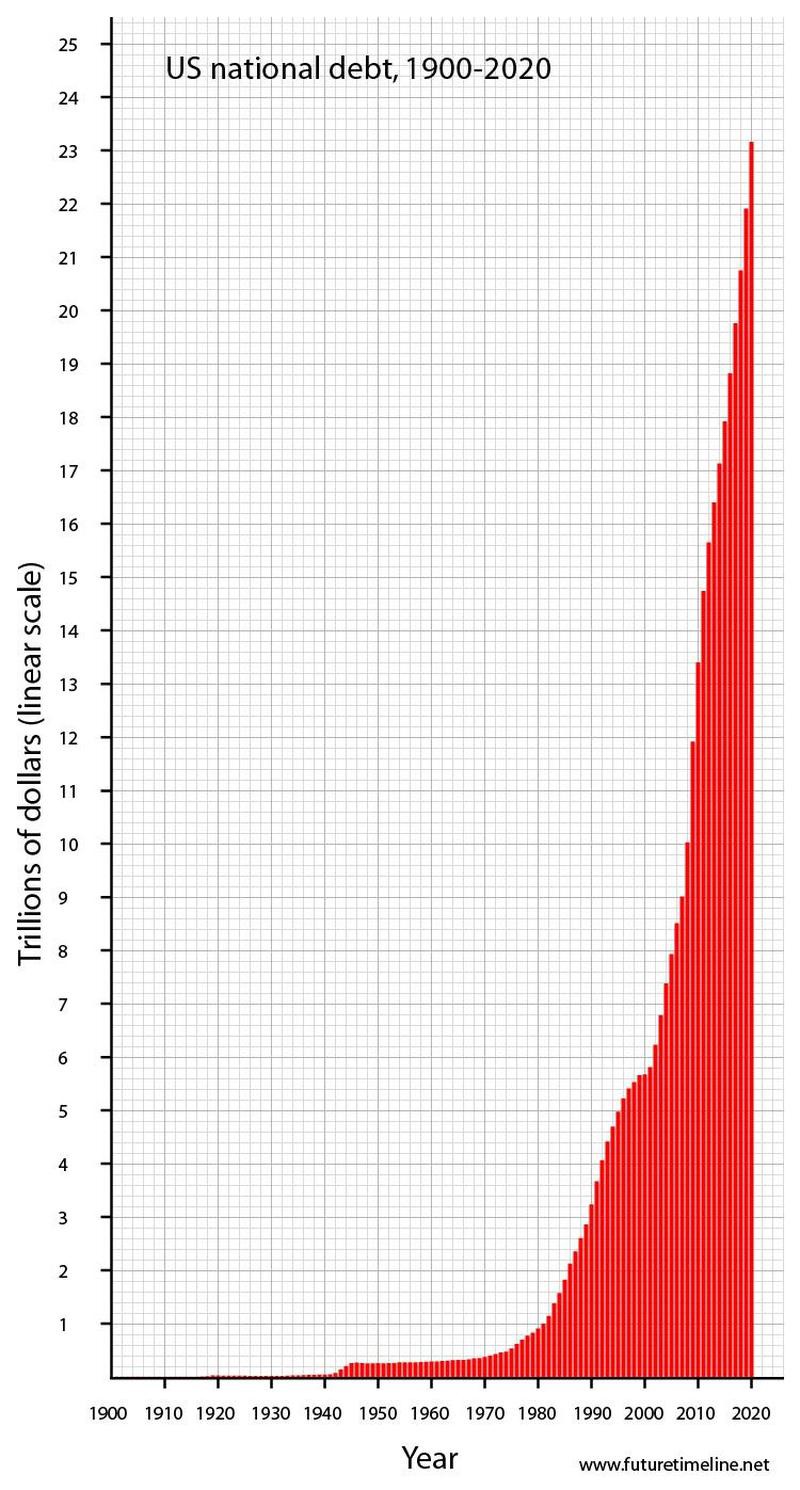
In our desire for abundance, we’ve vilified scarcity — and in the process eroded our notion of value.
It’s sad, but luckily, there’s a lifeboat → and it’s called Bitcoin. But before we go there, let’s understand scarcity a bit.
Scarcity & Value
Scarcity is inherently linked to our understanding of value.
Let’s use a quick set of examples.
- Family
- Trinkets
- Art
- Time (although fungible)
Why do you care about (value) your friends & family so much?
Heard the saying: “You only have one mother / father / brother / sister”?
Your family members & friends are unique. They are something you cannot replace, duplicate or just “print” more of.
We value them because they’re inherently & verifiably scarce.
The same goes for a special trinket handed down to you by your great grandparents (as an example). It’s rare / scarce / unique. Or art. We all know why a piece of art goes up in value once the artist dies.
*Corona Update* A more recent example of “things we value” include masks or hand sanitiser. Hospital beds, ventilators, trained staff? Yep; if you think value has nothing to do with scarcity; think again.
How about the most scarce (fungible) resource we know of?
Time.
We all know we can’t make more of it. We all know of adages like “you can’t make more time”.
It’s the same concept, although time is a little different because the aforementioned items / people / etc are not fungible. Time is more akin to energy, or money as a unit or resource that is both scarce and fungible, and that we (at least the more intelligent of us) value highly.
If as you read this, you consider how much you personally value time, then you should ask yourself the same re: Bitcoin.
Scarcity is at the core of “value”, and it’s evident when we analyse something like money:
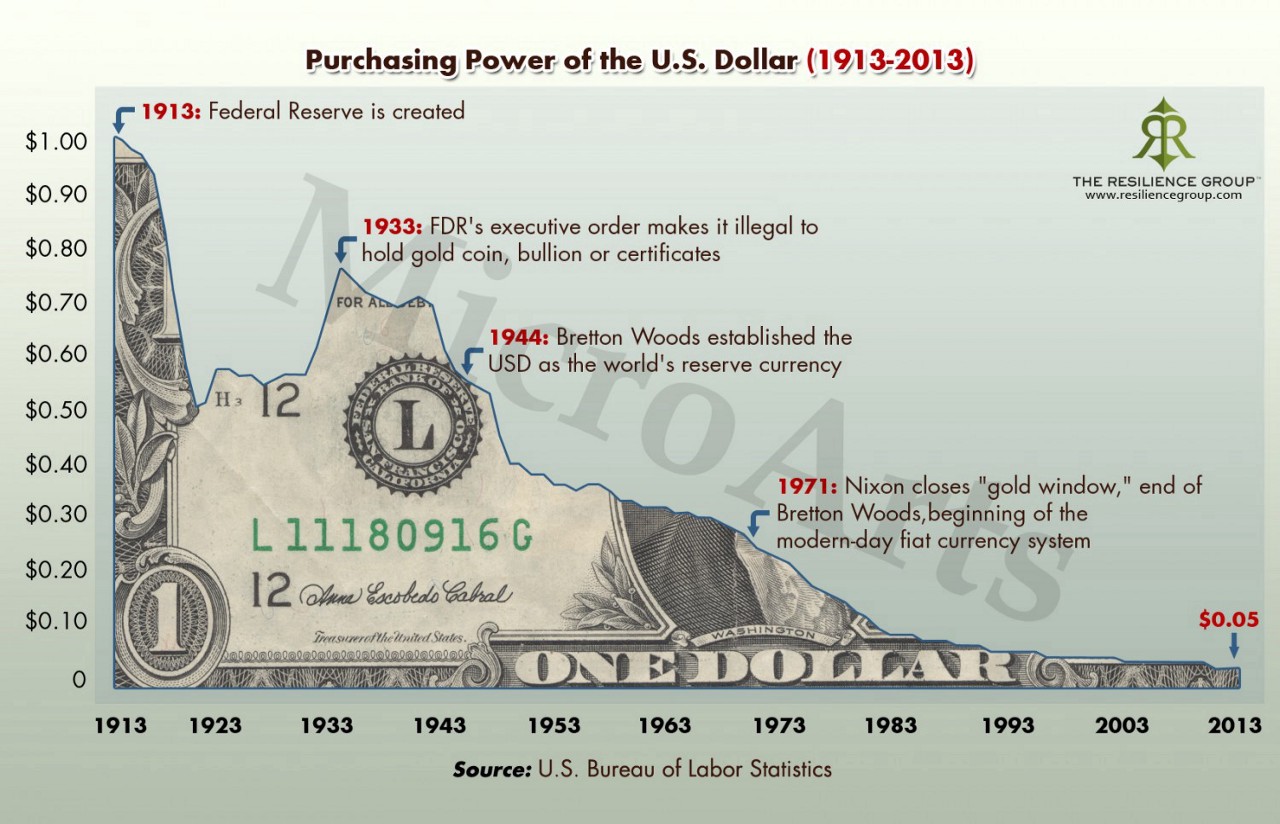
For something to maintain “value” over time it must be scarce
Value, always ties back to scarcity, in some way. And unfortunately, in a world where we’ve lost our sense of scarcity, we’re also losing our sense of value (as relative & subjective a term as that may be).
We’ve not learnt the lesson, and have spread the ideology to many other areas of life. An approach which is not sustainable as it erodes the foundation upon which true value is built.
But again, my hope is that Bitcoin bucks this trend, and inspires the world to think in a new vein once again.
Let’s move onto things more tangibly related to the halving. If you’ve enjoyed this topic, you can read more here:
Supply & Demand Basics
Systems with feedback loops function by finding equilibrium when different forces interact.
They help regulate each other much like a governor does on a steam train, or a thermostat on an air conditioner.
Supply and demand are one of these systems and it drives the most important element of an economy, ie; information, or as you may more broadly know it; price.
In fact, supply & demand are probably the central pillar for a system [society] of collaboration amongst market participants [free people], at a micro level and [fractally] through to macro levels.
Price is the key piece of information that not only results from a complex, interconnected set of inputs in a functional economy, but is also (and simultaneously) the carrier of said information, in yet another form of feedback-loop-driven-system.
Saifedean Ammous has a great section in his book, where he discusses how price is the mechanism via which a market will re-stabilise the production of Copper after a natural disaster.
Markets & their information superhighway (price) are incredible things, and I urge you to study them further.
How does this relate to Bitcoin and the halving? Well…
Bitcoin is unique, not only in this world, but anywhere else we look because it exists at a time when demand for a unconfiscatable, uninflatable & uncensorable asset is increasing, and all the while, its supply schedule is tightening.
This is unprecedented.
In a world of fiat, excess debt, inflation eroding our purchasing power, multiple asset bubbles (the everything bubble), inability to find yield anywhere, the never ending chase of marginal yield, the now “muh exponential” coronavirus and every other bit of insane chaos, people’s desire to hold something that’s finite & defined will continue to increase.
This demand, as it continues to rise, will put further pressure on a system whose supply faucet is ever decreasing.
The only “give” in the system is price, and the pressure is upward. Significantly upward.
This cannot be stressed enough.
Fixed Supply Asset.
Bitcoin is the world’s first “fixed supply” digital asset.
The closest analogy I can think of in the physical sense is land. You can’t just “make more of it” and as a result, as both global population & wealth grow, the inherent value of scarce land increases.
We’ve never had a digital corollary to this.
Traditionally, any digital item has been able to be copied or duplicated ad-infinitum. There was no cost to do so.
Bitcoin fundamentally changed this and not only gave us “digital scarcity” but something far more important, ie; monetary & information scarcity.
This is a profound concept when you really take a moment to think about it.
Aside from “time” or “energy”, Bitcoin is actually the only fixed supply, fungible unit that exists, and the fact that it was designed to be a form of money and now exists in a time of not only blind excess, but exponential chaos & monetary expansion, what lies ahead for it will be unlike anything we have seen in humanity’s entire history.
Bitcoin, Not Shitcoin
Bitcoin is extremely unique, for many reasons. We’ve done our homework, and it’s why Amber is a Bitcoin-Only company.
The one concept I’ll touch on here is the idea of digital scarcity.
By definition, digital scarcity can only happen once, and it occured with the advent of Bitcoin.
Bitcoin’s protocol and network has ossified around this strict definition of scarcity in the form of a fixed supply cap, and as a result, the market has imbued it with & reinforced its value as a scarce asset.
The community have optimised for this supply cap and it’s become Bitcoin’s core tenet, whilst all other copy-cat-crypto’s have optimised for elements that the market clearly doesn’t value, ie; transaction throughput, transaction speed, [apparently] decentralised applications, world computers, or whatever other farfetched ideas.
Bitcoin and the bitcoin community understood that it’s architecture was, from the beginning, about censorship resistance via decentralisation for the purpose of delivering an un-inflatable, un-confiscatable and uncompromisable form or money.
The fact that Bitcoin is now too entrenched, and so widely held, with so many stakeholders at so many different levels (ie; users, holders, node operators, developers, miners, exchanges, wallets and more) means that the core rules are now a social consensus which cannot be changed.
Those core rules include:
- 21m bitcoin
- 10min Blocks
- Halving every 210,000 blocks (~ 4yrs)
Along with some more technical ones that are outside the scope of this article.
This idea, this consensus, these always on, always verifiable rules are what make Bitcoin Bitcoin, and why no shitcoin can ever change that.
You can copy everything from Bitcoin, but you cannot turn back time, you cannot go back to 2008 & let the cat out of the bag again, you cannot re-plant the seed and disappear (thank you Satoshi). You cannot replicate the historical record. It’s done.
Ubiquitous, verifiable digital scarcity is a one-time event, and Bitcoin is the result.
Stock to Flow
I won’t spend much time here, because PlanB’s work does it far more justice.
Modeling Bitcoin’s Value with Scarcity
But suffice it to say, there is some form of correlation (and/or causation) between bitcoin’s stock to flow ratio, and its price.
In simple terms, stock to flow just means the ratio between how much “stock” is currently available / on hand, and how much “flow” or new stock is being produced.
To date, Gold has had the highest stock to flow ratio of just about any element or unit we know of — at least in a monetary / commodity sense, and that’s largely thanks to the fact that we’ve been hoarding it & storing it for thousands of years.
Bitcoin is about to catch up to Gold’s ratio, and it’s only been around for 11yrs. This is a significant thing to come to terms with.
It’s taken >5000yrs of accumulating Gold to reach a stock to flow ratio of 62. That means it would take another 62yrs of mining to produce as much Gold as we apparently have in reserve. For reference, Silver is said to be at around 22.
Bitcoin is at 27 right now, and will double to 54 in less than 6wks. The higher that number, the greater the scarcity.
Now…The (very critical) difference between Bitcoin and Gold (or any other commodity for that matter) is that no matter how many years one “mines” Bitcoin, its total supply is pre-determined. There’s no catching up. And furthermore, that supply schedule will continue to tighten.
Here’s the halving, in action;
- 2009 — Bitcoin mining rewards start at 50 BTC per block
- 2012 — The first Bitcoin Halving reduces mining rewards to 25 BTC
- 2016 — In the second Halving, mining rewards go down to 12.5 BTC
- 2020 — This halving will now bring us down to 6.25BTC every 10min.
- 2024 — After this halving, Bitcoin will have the highest stock to flow ratio that we know of.
- 2140 — The 64th and last Halving occurs and no new Bitcoin will ever be created
Just to blow your mind a bit, the last Bitcoin will take more than 30yrs to mine. Yes. THIRTY years.
Here’s what this schedule looks like in a graph:
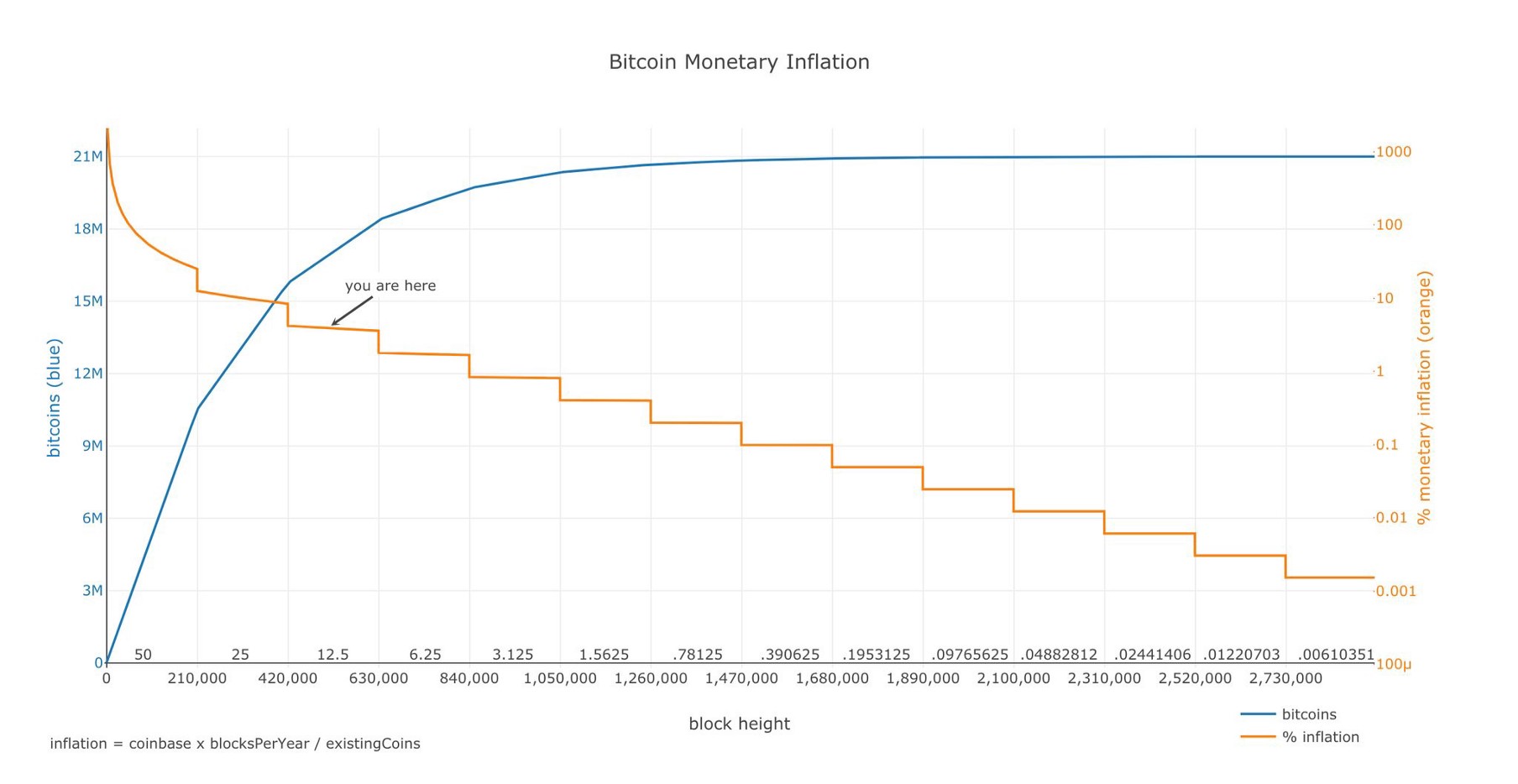 This is an unprecedented development in the history of humanity. Do not take it lightly.
This is an unprecedented development in the history of humanity. Do not take it lightly.
I’ve said it enough times now, but this is not only significant because there’s a chance to “make some money”. This is significant because it’s never before happened, and it represents a Zig, when the whole world is “Zagging”.
It’s a profound contrarian bet, that the rest of the world will have to take at some stage — the question is; when will you decide to take it?
Bonus Section: Bitcoin, Corona & Exponentials
If you’ve followed me at all recently, you’ll know my stance & skepticism about this entire Corona mess, and in particular the draconian social & political measures being taken to apparently “stop the spread”.
That’s to say nothing of the absolutely ridiculous attempts by the central bankers to flood the markets with so much fake money that the last 100yrs of monetary expansion will like a mole-hill next to a mountain.
These are truly strange times, and how it’s all lined up around the Bitcoin halving is eerie to say the least.
Whilst the virus goes “exponential”, along with people’s fear, panic, toilet paper purchases and irrationality, Bitcoin and the true bitcoin hodlers stand alone as a bastion of solidarity & hope.
The one place where it’s business as usual, where it’s “tick tock, next block”, and where nothing has changed but the distance until the halving, is Bitcoin.
It’s an extraordinary thing to watch play out in real life.
There has never been a storm more perfectly (and violently) formed around something — and as I described before, there is but ONE valve available for release in the Bitcoin ecosystem, and that valve is price.
A price that reflects the ever growing desire of everyone who wants to hold onto something precious, valuable and scarce in a world that’s gone mad with exponentials & blind abundance.
Bonus Section II: Two Trillion Dollar Coins
As if everything above wasn’t convincing enough, just as I was about to publish this, the following popped up:
Two $1 Trillion Coins’: Rashida Tlaib Proposal Calls on US Treasury to Fund Coronavirus Recovery…
Bitcoiners have been saying it for years now, and everyone said they were crazy. Here we are….
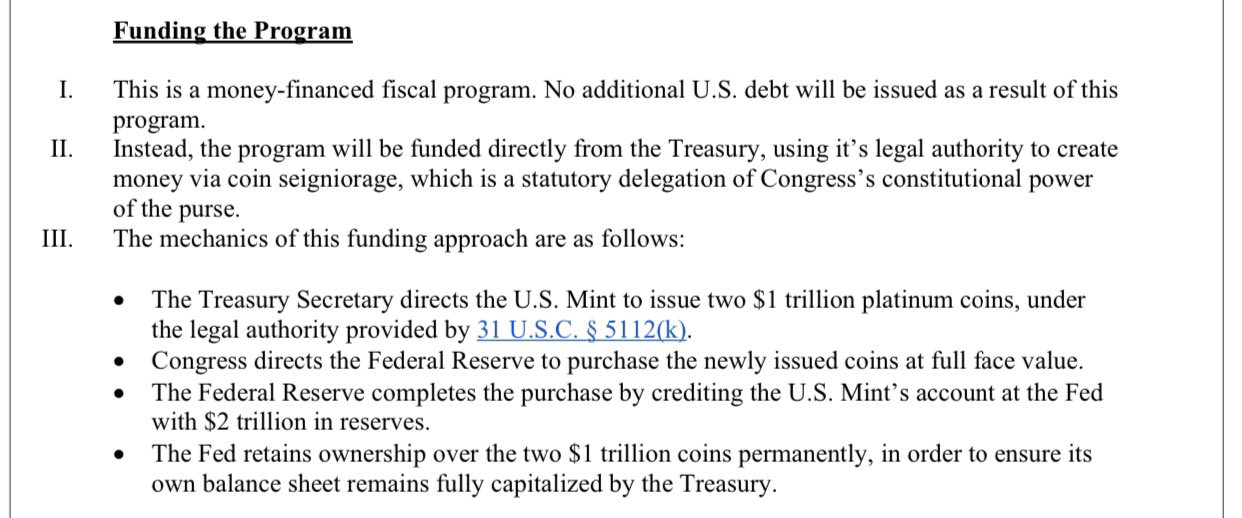
And they call Bitcoin “made up funny money”…
I have no words. There are no words…
In Closing
Whilst everything else in the world is measured via runaway excess, Bitcoin and the up-coming halving stand alone as symbols of hope for all those who believe in the value of something scarce and precious. For all those who understand that you can’t make something from nothing, and that if we keep continuing to rob our future for the sake of prolonging our present highs, there will come a time where we’ll collectively default & the results will be cataclysmic.
When everything is overblown and excessive, Bitcoin remains calm, collected and measured.
Whilst everything is being flooded, Bitcoin is becoming more scarce.
Whilst everywhere we turn, we hear more, more, more, now, now now — oblivious to the cost, or quantity of the “more” — Bitcoin is about growth for a purpose, and over a long period of time, arriving to a point of natural equilibrium & stability.
It’s this sort of contrarian opportunity that can only come around once in a millennium.
Make no mistake about it. Bitcoin is far more important than the internet, and its effects will be profound on a magnitude we are yet to understand or fathom.
Bitcoin represents an entire shift in thinking. No longer discounting the future for the present, but building today for a better tomorrow.
It’s about thinking, behaving and living for the long term once again.
Whilst it’s important to live today, it’s ridiculous to do it at the detrimental expense of tomorrow.
The world we’ve grown up in has its incentive mechanisms designed to encourage you to sell your future for a fake happiness and a fleeting high today.
The halving is a moment for us all to think about the way we live. It’s a reminder and a symbol for a better way.
In the years & decades to come, more and more people will come together to celebrate the halving, and use it as a reminder of how the future can be better. I believe long term it will become a more important event than Christmas & Thanksgiving.
What can you do?
The single most important thing you can do is simple. Accumulate Bitcoin.
And to avoid worrying about price fluctuations and timing the market, you can do this by Dollar Cost Averaging (DCA).
What is DCA? Buying at regular time intervals for the same dollar amount. For example, purchasing $100 of Bitcoin every week. If you bought Bitcoin using DCA from it’s all-time high price (17 December 2017), you would have 3x more Bitcoin today than if you had bought the same dollar amount at the all-time high.
I helped found Amber to automate this, but there’s lots of similar services around the world that can help, for example River Financial & Swan Bitcoin in the USA and GetBitter in Europe.
Thankyou to a few special people for reviewing this before it was published, including Gigi, Kalara Bonello and a couple others I can’t link to on here..
Follow them on Twitter too! @dergigi, @kalarabonello
If you enjoyed this article, make sure you “give it the claps”. Jokes aside though, it means more people will see it.
Likewise share it around, on twitter and the other socials you’re on (including, god forbid, you still share via that thing called email 😜)
And if you’d like to read more from or learn more, see links below.
Thanks again!
Written by:
Aleksandar Svetski [₿] Aleksandar Svetski — Medium
Shout out to @ Amber Labs
Amber | Invest Anywhere Amber #stackingsats ⚡️
Thanks to Gigi and Arthur Tkachenko.
Bitcoin Highlights the Virtues of Quantitative Hardening
Bitcoin Quantitative Hardening is to be contrasted with the Quantitative Easing led by the Fed.
By Sylvain Saurel
Posted April 15, 2020
Since the beginning of the coronavirus crisis, you have probably heard several times about quantitative easing. If you find the economy, and particularly the monetary and financial system, too complex, you may not have reacted immediately when you heard this term come back into the limelight.
However, the unlimited quantitative easing program conducted by the Fed since March 23, 2020 will have a strong impact on your daily life in the weeks and months to come. The inflation of the money supply in U.S. dollar that this will necessarily induce is likely to lead to a strong currency devaluation.
The U.S. dollar being the world’s reserve currency, the United States will once again export its inflation. Other central banks have already started to conduct quantitative easing programs.
If we are far from the $8T of liquidity printed by the Fed, the European Central Bank is already above $1.3T printed, and the Bank of China is close to $500 billion.
You must therefore absolutely try to understand what quantitative easing is in order to prepare yourself as well as possible for the consequences that it will have on your daily life in the weeks and months to come.
Quantitative Easing Is the Fed’s Systematic Approach
First of all, I’m going to start with a little bit of theory. Quantitative easing, often abbreviated to QE in the literature, is a monetary policy that can be followed by a central bank.
Quantitative easing involves buying a predetermined amount of government bonds or other financial assets in order to add money directly into the economy.
This unconventional monetary policy requires the central bank in question to first set the stage by lowering interest rates. As you may recall, this is what the Fed did in March 2020 by lowering interest rates by a total of 150 basis points.
With interest rates at zero, the Fed was in an ideal position to conduct a policy of quantitative easing, which is like printing the U.S dollar.
In fact, it had no choice once interest rates had been lowered to the previously taboo level of zero. Indeed, if the Fed had not acted, it would have intensified the liquidity crisis we experienced in mid-March 2020.
This liquidity crisis was exacerbated by the fact that we were at the end of a bull market cycle in financial markets such as Wall Street.
At the end of such a cycle, the majority of people have no more cash on hand because they have invested everything without keeping a minimum of cash on hand.
With its unlimited quantitative easing program, the Fed will probably happen to exceed $10T of liquidity injection in the coming weeks.
This quantitative easing monetary policy had already been the solution adopted by the Fed and other central banks at the end of the previous crisis. Nevertheless, at the time, the bill was more like hundreds of billions of dollars.
Quantitative Easing Produces Fewer and Fewer Tangible Effects
Unfortunately, quantitative easing is a monetary policy that comes with its own set of drawbacks. The first disadvantage of quantitative easing is that the induced increase in the money supply will lead to currency devaluation.
Thus, people who own the majority of their wealth in cash will be penalized compared to those who own real estate, gold, or shares on the financial markets.
For an individual, fighting against the effects of quantitative easing therefore consists in spending his cash to buy illiquid assets, share, or gold. Unfortunately, a lot of people are unable to do this.
Again, these are mainly the poorest people.
People who are already rich and who have this kind of assets will be enriched by a quantitative easing policy. It will not surprise you to know that the powerful at the head of the monetary and financial system are in the situation where they have a lot of assets that will increase in value under these conditions.
A quantitative easing policy will therefore hit even harder those who would need even more support in times of economic crisis such as the one we are about to experience.
The second problem with quantitative easing is that it only postpones the problems to later. During the economic crisis of 2008, the world’s major economic powers preferred to resort to this easy money policy rather than attacking the root of the evil.
The result is disastrous because the problem will return in the future in an even more violent manner.
The economic crisis we are experiencing today is therefore only the unfortunate and logical continuation of the 2008 crisis, which was not really resolved, but merely postponed.
What complicates things is that with each postponement of the problem, the amounts to be injected within the framework of quantitative easing will increase greatly.
If hundreds of billions of dollars had been enough in 2008 to plug the leaks on the ship, we are talking trillions of dollars today.
With the quantitative easing programs being followed by the major central banks today, it is quite conceivable that in the next economic crisis 10 years from now we would be talking in quadrillions of dollars.
So you have understood that these quantitative easing policies are just a never ending story, which only pushes back the problem without really solving it. With one constant: with each postponement of the problem, it becomes even bigger the next time.
Quantitative Hardening Is the Other Possible Route
Now that you have become aware of the problems associated with quantitative easing, you must ask yourself if there is an alternative. Contrary to what powerful people in the monetary and financial system try to make us believe, an alternative to quantitative easing does exist.
The alternative to quantitative easing (QE) is quantitative hardening (QH).
Quantitative hardening consists in reducing the liquidity injected into a market over time by reducing the daily supply available. In this way, each unit of that market gains in value over time.
This policy is clearly the opposite of quantitative easing where the daily supply keeps increasing, which further weakens the value of the units available on the associated market.
As an example, the U.S. dollar money supply, represented by the M2 Money Stock Index, increased by 6.7% in March 2020 alone as a result of the Fed’s liquidity injections:
 M2 Money Stock and inflation, over 6 months in 2020
M2 Money Stock and inflation, over 6 months in 2020
If you imagine that you had $10,000 in cash at the beginning of March 2020, what you own has gone from $10K on $15.5T to $10K on $16.6T.
You immediately understand that the purchasing power associated with your $10K will necessarily be reduced thereafter.
Bitcoin Has a Quantitative Hardening Monetary Policy
Now, the big question you have to ask yourself is what solutions exist with a quantitative hardening type policy. You must have heard about this solution for several years now: it is called Bitcoin.
Created by Satoshi Nakamoto following the 2008 crisis, Bitcoin should be seen as a response to the excesses of the monetary and financial system.
Bitcoin has a unique monetary policy:
- A maximum supply known in advance and set at 21 million.
- A maximum offer that will never change.
- An inflation of new Bitcoins produced on a daily basis that will continue to decrease over time.
In addition to these unique properties, Bitcoin’s monetary policy is automatic. It is written in Bitcoin’s source code, and therefore does not depend on any human decision, which by definition would be arbitrary.
With Bitcoin’s monetary policy, everything is predictable.
The Bitcoin reward that is paid to miners who validate a block of transactions is what allows the creation of new Bitcoins. In order to decrease the inflation of the Bitcoin supply over time, this reward is divided by two for every 210,000 blocks of transactions added to the Blockchain.
This decrease of the reward is called Halving.
In order to ensure that this happens approximately every 4 years, the difficulty for mining new blocks on the Bitcoin Blockchain is adjusted every 2016 blocks, so that one block is added approximately every 10 minutes.
Originally, the Bitcoin reward for miners was 50 BTC. After the first division of the reward amount in 2012, it was decreased to 25 BTC. After the second Halving in 2016, the reward decreased to 12.5 BTC.
In May 2020, during the third Halving of Bitcoin, the reward will decrease to 6.25 BTC.
Thus, with an average of 144 mined blocks per day, the production of new Bitcoins will now be around 900 per day, compared to 1800 since 2016.
This Bitcoin monetary policy will lead us to an annual inflation of the Bitcoin supply below 2% as soon as 2021. It will then be 1.8%:

Bitcoin supply and inflation, over time
Bitcoin’s quantitative hardening policy will bring the annual inflation of the Bitcoin supply below 1% as of 2024 at the fourth Bitcoin Halving.
This inflation will continue to trend towards zero, reaching zero around 2140 when the 21 million Bitcoins will have been mined.
Bitcoin Highlights the Virtues of Quantitative Hardening
Quantitative hardening is a concept that will intrigue more and more people in the months and years to come. This monetary policy, which is Bitcoin’s policy, corresponds to a total paradigm shift from the current fiat system.
Bitcoin encourages you to save what you own because it values your Bitcoins over time.
Since the inflation of the Bitcoin supply is constantly decreasing over time, each unit of Bitcoin becomes more valuable as demand increases. The principles of the law of supply and demand explain this clearly.
It is therefore in your interest to keep your Bitcoins for the long term. By becoming a Bitcoin HODLER, your support for the Bitcoin revolution will be rewarded with the appreciation of the price of each unit of Bitcoin.
Bitcoin HODLER One Day, Bitcoin HODLER Forever
As you read this article, I hope that you have understood that there is another way out of the current monetary and financial system. This alternative path emerged as a result of the economic crisis of 2008, and it is our best solution in the face of the crisis that is now beginning.
Bitcoin, which represents this other path, will still be there during the next economic crisis in 10 or 15 years, but I have a feeling that its price will no longer be $7K as it is today.
To tell the truth, I think Bitcoin price will already be over 6 figures when the next economic crisis will occur in 10 years.
Why? Simply because of its quantitative hardening policy which will give day after day, block after block, Halving after Halving, more and more value to the units of Bitcoin in circulation.
Nevertheless, during the next economic crisis in 10 years, when central banks’ liquidity injections will be counted in quadrillions, you may unfortunately no longer have such an interesting opportunity to opt-out of the current system by buying Bitcoin.
As always, the decision is yours. The most important thing is that you educate yourself properly in order to make the best decisions for your future so that you will have no regrets in 5 or 10 years time.
Welcome to prepping, Bitcoiners
By Preston Byrne
Posted March 31, 2020
Posted on March 31, 2020 by prestonbyrne
I’m a Bitcoiner, libertarian, and somewhat of a prepper. There’s a lot of overlap between the three communities. I’m not quite sure why.
Part of it might be down to the fact that these groups tend to look upon large-scale structural features of our societies, such as central banks or sovereign debt piles, with a considerable degree of suspicion, correctly identifying that debt is itself a form of political risk reallocation and, as with all risk, increasing the amount of risk in a system makes it vulnerable to stress.
With that in mind, I think it’s OK to now say that mild prepping is no longer some loony fringe hobby. As we see that the basic, “boomer” assumption that modern, technocratic government will always have the capability to handle a crisis is wrong, we also see that individual people and companies who were prepared for this crisis were in the best position to assist with ending it. See, e.g., MyPillow, GE, and GM at the corporate level, or people who got off of the streets and went into quarantine in the first week of March on a personal level.
Companies that carried large debt loads or frittered away their cash on stock buybacks appear fragile and brittle in the face of a 12-standard-deviation demand shock. This will likely set a new baseline across our society – both in business and personally – where savings, thrift, and resiliency, even if inefficient, become higher priorities among individuals, businesses, and governments.
Comprehensive risk management is, when applied to individual life, referred to as “prepping.” The benefits of “prepping” are that when a global disaster like Covid-19 strikes, the only errands you need to run are (1) to a low-tax liquor store on the Delaware state line and (2) to one’s local Staples to pick up printer ink, rather than joining the hordes of Americans fighting over the last boxes of rigatoni and minute rice.
On a personal level, I am sure – Twitter reveals all – that many of you in the Bitcoin world are now venturing into the preparedness universe for the first time.

Neeraj is the crypto meme master. He is not a farmer. And he’s totally into this. Then there’s his colleague, Peter:
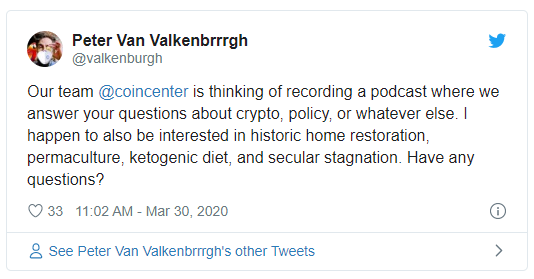
Originally I thought Peter was a neophyte to this but I’m now advised he’s been into permaculture for awhile.
This is awesome. People are getting into self-sufficiency and people who are into self-sufficiency are starting to talk about it more.
New people should be warned, however, that there is an entire industry dedicated to prepping and, more particularly, selling you a bunch of preparedness crap that you probably don’t need. In keeping with the financial preparedness piece of the equation, you shouldn’t spend a penny more than you need.
To paraphrase the Adam Smith Institute’s Madsen Pirie, before Covid-19, prepping was considered lunacy. In the future, it is likely to be policy, at all levels of society.
It’s something I’ve tried to apply in my personal life. Here’s how I went about it.
1) Eliminate debt loads.
The best thing you can do from a preparedness perspective is to eliminate all debt, particularly if it carries a high rate of interest. This will allow you to save and invest.
2) Preparedness is a way of life, not a line-item.
Until recently I ran a small law firm on my own. During that time I kept my burn rate very low by, e.g., setting up shop in Connecticut rather than New York. My aim was to always have several months’ worth of opex in bank so I could survive if the phone stopped ringing for a few months.
Fortunately, that never happened. At the outset of the Covid-19 crisis, I was a little shocked to learn how narrow other businesses’ margins were. (Although admittedly when I first started working for myself I wasn’t planning for demand shocks, either.) I learned the hard way that runway is life during (a) my days as a startup founder, where survival and successfully closing venture investments was highly correlated and (b) my days after running a startup when I had to stretch out my savings while requalifying as a lawyer in the United States and unable to work.
After realizing that whatever safety net you thought you had by virtue of living in a modern, Western country was a figment of your imagination, you’re never quite the same. You cannot fix this problem with a single transaction. You have to change the way you do business. All of American society is now experiencing _austerità _for arguably the first time in nearly 100 years, and realizing that it, too, under certain circumstances, has no safety net.
“Money printer go brrr” may be working this time, but it can’t work forever. It is not a sound basis for society-wide risk management. I predict that, once this crisis is over and people begin getting back to work, saving rates will soar. With good reason.
3) Start small by building an EDC loadout.
De-risking is the accumulation of many small decisions rather than a few big decisions. Like stacking sats, except you’re stacking stuff.
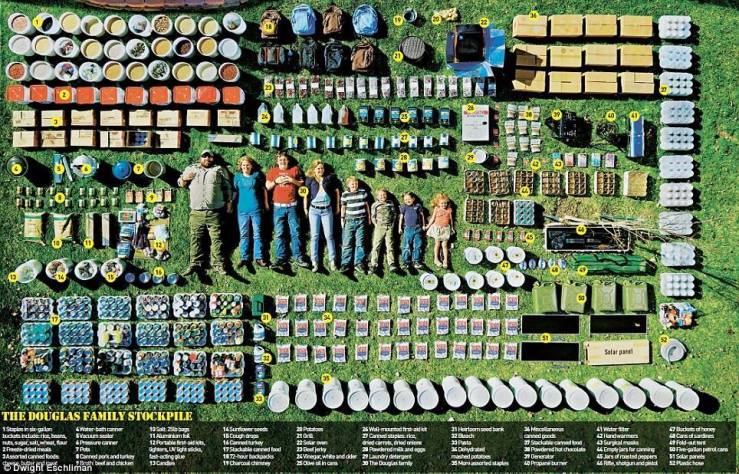 This is a lot of work. Don’t try to do this overnight.
This is a lot of work. Don’t try to do this overnight.
You have to be cheap enough, but not too cheap. There are limits to cheapness. When I was in London during the Great Recession of 2008-09, for example, one law firm was rumored to have decided to slash costs by sending all mail via Second Class post, which was not a good idea (this decision was, apparently, swiftly reversed when the firm realized that the postal/mailbox rule in England only applies to First Class post).
Fortunately, you don’t need a ton of gadgets and junk to be ready for most situations. You should have some tools.
I recommend that folks who are totally new to this start with only a handful of things by building what I call an everyday carry, or EDC, loadout. This includes basic stuff like hex keys, a multitool, a flashlight and spare batteries, a utility knife if laws in your jurisdiction permit (in England or NYC, for example, this would not be a smart idea), a lighter or two, maybe something for water filtration, and a small case in which to keep these things.
If you’re not accustomed to having any of these things around, after doing this, what you’ll find is that situations start coming up where before you didn’t have the right tool but, suddenly, now you do.
 My typical EDC loadout. A flashlight identical to this one is on my person at all times. The rest of this stuff is usually nearby, either in a bag or the center console of my truck.
My typical EDC loadout. A flashlight identical to this one is on my person at all times. The rest of this stuff is usually nearby, either in a bag or the center console of my truck.
Keeping a toolbox in your car or office is also probably a good idea. Car kits can be built out with useful, but bulkier, things that you might not want to drop into a briefcase or backpack but would want nearby, like jumper cables, 12 volt DC-AC converters, spare battery packs, and small electric air compressors. You will wind up using them at some point.
To be perfectly frank, a multitool, a good set of allen wrenches, a flashlight, and a set of jumper cables was enough to handle virtually any real-world problem I had until Covid-19. My guess is that the same will be true for you.
4) US government guidance is woefully inadequate, and purveyors of survival kits, citing that guidance, will try to rip you off.**
FEMA’s official guidance states that every person in the United States should keep at least 72 hours’ worth of non-perishable food and other necessities (batteries, etc.) for themselves and their families immediately available.
By implication FEMA also says that businesses should also be prepared for 72 hours’ worth of disruption. As the current crisis shows, however, 72 hours is simply not enough to deal with crises of the scale modern Americans may expect to face. From a business perspective, if you can’t cover your expenses for more than 72 hours, you need to cut expenditures somewhere or open up a revolving liquidity facility.
From an individual perspective, your first task on your prepping journey will be to assemble these supplies. One thing you may encounter as you embark on your preparedness journey is a concept known as a “bug-out bag” which holds 72 hours’ worth of stuff and a first-aid kit. You should have one.
In online prepper circles, bug-out bags are a serious topic of conversation, because these bags are regarded as the ultimate grab-and-go survival tool you’re able to have with you at all times. I keep mine in the back of my truck. Much digital ink has been spilled over what the exact contents of these bags should be, how much they should weigh, or even what they should look like, with some adherents preferring tacticool MOLLE bags and others preferring more subtle I’m-weekending-in-the-Hamptons-nothing-to-see-here duffels.
Some companies sell luxury 72-hour bug out bags full of generic crap for $500 or more.
 Overpriced
Overpriced
You do not need these expensive kits. You can build them on your own, with better equipment, for a fraction of the cost and with negligible effort using sites like Amazon.com (although I always recommend going to local shops first if you possibly can). Check out sites like The Prepared or graywolfsurvival to see how the prepper OGs developed their “bare minimum” supply lists. What works for them may not work for you. Decide what works for you.
FEMA’s 72-hour guidance is, very clearly, obsolete. That doesn’t mean you shouldn’t follow that advice as an absolute bare minimum level of personal risk management.
In my opinion you should probably keep enough on hand to survive for two weeks rather than 72 hours, and you should store it in a trunk rather than a bag.
Part of “bug-out bag” theory is that it’s supposed to be something you literally grab as you’re on the way out the door, fleeing a disaster. Unless your house is literally on fire, in the United States it is unlikely that a major crisis like Covid-19 will emerge so quickly that (a) you are unable to get to a vehicle and escape and (b) you’ll have no time to retrieve some belongings. Considering that grocery store supply chains are continuing to work even in the Covid-19 crisis, if you keep a bag in your car, and a trunk in your house or apartment, chances are pretty good you’ll be ready for most disasters life throws at you short of an asteroid strike or nuclear war.
More preparedness is better than less. My personal preference is to keep a bag in the car and few weeks’ worth of stuff in the house that I’ll actually eat, so nothing is wasted and it’s possible to rotate things out well before they expire.
5) Don’t over-prepare.
FEMA’s official guidance for the Pacific Northwest is beefier than its guidance for the rest of the country, recommending that all citizens there maintain a 2-week supply of life’s necessities. This is good advice and, in my view, a good objective for most Americans to have.
This determination was informed by a 2017 disaster preparedness exercise code-named “Cascadia Rising.” Cascadia Rising simulated the outcome of an extremely large, so-called “Megathrust” earthquake off the coast of Washington and Oregon. That earthquake – the occurrence of which, like a global pandemic, is an absolute certainty on a long enough timescale – is predicted to register an almost incomprehensibly large 9.0 on the Richter scale and is expected to completely destroy most of the PNW west of I-5.
In theory, it seems sensible to just order a ton of Mountain House freeze dried food, leave it in your closet and forget about it until disaster strikes. But this is expensive, and on Day 17 of lockdown, I have to say that the ability to eat real food – meat, vegetables, fruit – is really rather nice.
With this in mind, I don’t keep a ton of stuff stored 24/7/365. That would be a waste of effort and money. Instead, in the run-up to the U.S. outbreak I implemented what I referred to as a “ramp strategy” which, rather like the collateral management in finance, ramped up the level of security I had on hand as the risk of economic collapse increased.
To do this successfully you need to make information and time your allies. As long as you are a high-information citizen, you can spot threats ahead of time, and plan accordingly. As the risk of a catastrophe in the United States increased, my preparedness levels – which, admittedly, were somewhat higher than average – rose commensurate to the danger. When Wuhan was locked down, I prepared. When Venice was locked down, I prepared some more. When the U.S. crossed 100 cases, I prepared some more. As D.C. shut down, I added the finishing touches.
The following week, as America realized the jam it was in, I was fairly annoyed with the situation but was able to follow CDC guidance, stay home, and focus on work without needing to worry if I’d be short on crackers and tea.
The lesson from the Covid-19 crisis is not to run out and buy all the canned food in the world and allow it to languish in a pantry until the next disaster strikes. The lesson is to be flexible, which means clearing your debt load, living somewhat more frugally and to focus on tooling and capabilities (being able to filter and boil water, make a fire, charge a battery, change a tire) rather than stuff. Unless you’re trying to be 24/7/365 prepared for a surprise nuclear first strike which you expect to occur in the immediate future, keeping a permanent stock of food you’ll never eat isn’t a particularly smart idea.
If you’re smart, you’ll know ahead of time what you need to survive for [n] weeks and will be able to submit some very tailored orders via online shopping to address those needs before less-informed citizens begin to swarm grocery shelves. This should minimize the investment of time and the risks of unnecessary or wasted expenditures.
6) As bad as it is, Covid-19 is probably not “the big one.” It’s also probably the worst economic crisis you’ll ever experience.
As bad as this is, it could actually be worse. Covid-19 kills anywhere between 0.2% and 1% of those it infects. Contrast this with the plague, which kills 17% of those who contract it, or H5N1 influenza, which kills 56% of those infected. Ebola and Marburg viruses kill, in some settings, north of 80% of their victims.
That said, while being on Covid-19 lockdown is likely the worst thing anyone reading this blog post will ever have to experience, it almost certainly isn’t the last crisis we will ever experience – meaning we should take the opportunity to learn from it and build up resiliency in its wake.
A resilient society requires everyone to do their part to be personally prepared, so (a) you aren’t part of the problem when a crisis breaks out and (b) you have the means to remove others from the zone of danger when a crisis breaks out, both of which limit the burden on government and your reliance on government to continue carrying on your day to day life until normality is restored.
Bitcoin and The Business Cycle
By Ben Kaufman
Posted April 16, 2020

For centuries, production in capitalist countries seems to progress in some kind of “cycles”. Every few years, the economy experiences a period of sharp economic growth which is then upset by a collapse of businesses and a high unemployment rate — a recession. This cyclical movement of the market, repeatedly going from an economic boom to bust, is known as the “business cycle”. Social scientists of multiple disciplines have suggested numerous explanations for this phenomenon, from “under-consumption” to some psychological propensity. Yet, so far, no popular counter-measure pursued has solved this problem. Central banks have evidently failed to “cure” this alleged “market failure”, and despite the enormous, continuous growth in their power and influence, we once again seem to be at the beginning of a devastating recession.
Despite the confidence on the side of central bankers in their ability to handle this issue, it seems that, especially since the last crisis of 2008, the public is losing patience with the current system. People are getting fed up with footing the bill for the mistakes of the financial system, and very justly so. The scheme at work is already clear and visible. The economists grievously fail, and the taxpayer pays the costs (and their salaries)¹. It’s obvious that this system cannot continue. Yet, the right alternative — the solution — is still far from obvious. Nevertheless, the mainstream and most academia appear to agree on one thing, that money must be managed by the government, that is, through central planning.
They tend to look at the economy as a machine — some kind of a black box which is running on an engine fuelled by money. The more “fuel” you throw in, the quicker the engine will go, and the faster the economy will move. While the different economic schools and doctrines usually provide different theories and explanations, their practical controversies and disagreement are primarily around at what point injecting more “fuel” would cause the “machine” to run too fast, overheat and eventually blow up. That is, how much money would be too much for the economy and lead to problems or even to hyperinflation. Regardless of the many differences between the popular doctrines, the issue of money is where you will find their most enthusiastic agreement. The money supply² must always increase! Printing, bank credit expansion, “liquidity injection”, “quantitative easing”, public deficit spending, even outright handouts — just throw it out of a helicopter if that’s what it takes — but you must never let the inflow of money slow down!³
This approach of monetary “engineering” is undoubtedly the most popular, and has guided policies for more than a century. But, considering its failure to deliver on any of its promises⁴, there seems to be a good reason for questioning this approach. In fact, if there is anything to learn from the last hundred years, it is that government control over money, namely central banking, doesn’t promote prosperity. Expanding money and credit does not cure the problem of the business cycle (or any other issues for that matter) — this approach has failed every time. The common analogy that the economy is like a machine operated by the state fueling it with money might sound sensible to some, but does it really fit? Is the theory we have learned to accept, quite by default, actually correct?
In this article, I will present the “heterodox” approach of the “Austrian school” of economics. The Austrian school approaches the questions of economics from the view of individual actions and incentives, looking at the economy as an “organic” complex resulting from the many actions of individuals. Its theory of the business cycle is probably one of its central, though most controversial, achievements. The purpose of this article, however, is not merely to explain the Austrian Business Cycle Theory (ABCT), and certainly not to justify its validity. Many other books already provide such brilliant expositions⁵. The goal of this article is to discuss the possibility of economic reform which builds upon the theoretical works of the Austrian school. My aim here is to lay down the argument for how Bitcoin could be the key to preventing the business cycle — enabling greater and more sustainable economic growth.
Economic Growth
So to begin our discussion, we shall first look at how a healthy economy grows. Adam Smith, the “father of economics,” has attributed economic growth chiefly to the division of labor, that is, to the specialization of individuals in performing specific tasks. However, there is a much more critical aspect of human progress which Smith overlooked. As Carl Menger, the founder of the Austrian school of economics explained, it is the availability of “factors of production,” that is capital, on which economic growth is dependent, and which also sets the limits for the division of labor.⁶
Capital, or capital goods, are the goods which are not used for direct consumption, but are used in the process of producing other goods, eventually reaching to consumers as “consumption goods.” Menger has explained this difference by referring to different “orders” of goods. The goods which consumers directly use, like food, clothes, and cars, are the goods of the “lowest, first order.” If we take bread, for instance, then we could say that flour is a “second-order” good in the process of producing it. Wheat can then be called a third-order good, and the land on which the wheat grew upon a fourth-order good. The order of a good is nothing inherent in it, but is rather “a product of reasoning” based on how a person intends to use it. Therefore, the same good can be of different orders when employed at different stages of production. The point here is, of course, not the assignment of the specific orders of goods, but understanding that production is a structure with varying “depth”. Furthermore, as we will now see, the higher the orders of goods we use in a production process get, that is, the “deeper” our production structure is, the more we will be able to produce.
As an example, consider a lumberjack cutting wood with an ax, as compared to another one which uses an electrical chainsaw. Clearly, the latter will be much more productive at his work, as the capital good he employs is much superior to the one used by the former lumberjack. But, it is no less clear that the chainsaw requires the employment of much higher order goods to assemble, its production process is longer and more complex. While an ax could be produced even by primitive people, from quite simple raw materials, the chainsaw requires the use of industrial equipment, like an engine and a power source, which by themselves require the use of many other goods, and so on. In other words, the chainsaw necessitates the accumulation of much (much) more capital and the use of much higher orders of goods to produce — it needs a “deeper” production structure.
Menger’s student, economist Eugen von Böhm-Bawerk, has termed this property of increasing length and complexity of production, the “roundaboutness” of production processes. The more “roundabout” a production process is, the more and higher-order capital goods it means are employed. His choice of the term “roundabout” attempts to signify a crucial concept. To produce more and better consumer goods, we must first take the time to create more capital goods. By “deviating” from the straight line we wish to follow to get to our main goal of producing the final consumption goods (like firewood), taking the additional effort and going first to produce something else (the capital needed, like the ax or chainsaw), we can manufacture much better, or a greater quantity of, final products. The process of human progress, of improving welfare and material conditions of people, could most adequately be described as the process of capital accumulation. Our development and economic growth is dependent on and limited by the availability of capital goods for production. Thus, to understand the actual process of economic growth, the next step to look at is how capital accumulation works.
Accumulating capital means increasing the level of savings that a person holds. It means withholding consumption of goods and, instead, saving them and employing them in further production. When considering an individual working alone, like a fisherman building himself a fishing rod, the process of capital accumulation is quite straightforward. The fisherman delays his “production” of fish in the present and instead takes the time to build a fishing rod. He will need to postpone his consumption of fish while producing the rod but will later be able to use it to catch many more fish. Eventually, he will have more capital savings (the rod) and will be able to produce (fish) more efficiently. However, when discussed in the framework of the market economy, the process suddenly becomes much more “abstract” and harder to follow. Therefore, it is of the utmost importance to understand the specifics of capital accumulation in the market economy.
The market economy is a system of the division of labor. It is a “framework” in which private individuals own capital, exchange goods and services, and cooperate to achieve their ends. Its most important property is the existence of a pricing system for all traded products and services, denominated in a common medium of exchange — money. Therefore, the allocation of capital in the market economy is done mostly by using the money prices of goods.
Most people tend to confuse money and money prices. When we say, for instance, that our lumberjack saved 100$ by producing firewood, what we mean is that he created something priced on the market as worth 100$. If he decided to use the firewood for consumption, he may do so either directly — for example by using it to make fire, or indirectly, by selling it for 100$ of cash, spending that on something he will actually consume. If, however, he prefers to increase his savings, he could refrain from consuming the wood, storing it for later, or using it to make new work tools (capital). Or again, as the usual course of the market economy goes, he could sell it for cash, and either save that money to spend later, spend it now on buying more capital goods to use, or lend it to or invest it in some enterprise. The more capital goods people accumulate, either directly by owning them, or indirectly, through money savings, lending, and investing, the more will the economy progress.⁷
As we now see, the most important force of economic growth is saving and accumulating capital, which requires deferring consumption of the goods produced. Therefore, we now face a new question. How long will a man be willing to defer his consumption in order first to accumulate more capital? In other words, how does a man, and eventually the economy as a whole, decide the length of production? That is, whether to focus on short term production of relatively fewer consumer goods sooner, or longer-term production, employing more “roundabout” processes to produce more (or better) consumption goods later.
The answer is that people decide according to their time preference. It is a generally accepted⁸ that all else being equal, a person will always prefer to satisfy his needs sooner rather than later (as for every person time is finite and the future is uncertain). This means that, for people to defer their present consumption, the future output expected from taking longer (more roundabout) production efforts must be high enough to compensate for this delay in consumption. Put simply, people value time, they prefer to attain their ends sooner rather than later, and the extent to which they value the present more than the future is their level of time preference.
Having high time preference, a person will be less willing to defer his consumption, and will be more present-oriented in his economic activity. In contrast, a person with lower time preference will prefer to wait longer and take more roundabout processes, as they will sufficiently compensate him for the increase in production length. We may say that the time preference of people is what regulates the length of production in the economy.
The lower time preference is, the more future-oriented people are, and the more capital they save and accumulate to enhance productivity and develop the economy.⁹
Again, in the case of an isolated economy of a single individual, there will not be much further question of how the process goes. In such a case, the same person does everything by himself. Just to clarify, retaking the example of a fisherman, if his time preference is relatively high, we will not be willing to defer his consumption to make the fishing rod first. However, if he has a low enough time preference, he will prefer this more “roundabout’’ process of making the fishing rod while catching no fish at first and then use it to increase his productivity. But as we said before, the process looks different when we introduce the division of labor of the market economy. In the market, production is directed according to consumers’ demand¹⁰, reflected through the price system.
Time is a factor of production. In fact, it is the only factor of production without which no production is possible. As such, time, that is, the time preference of the consumers, also has its money price in the market, namely, the interest rate. The interest rate is the price required to withhold capital from others for a certain time¹¹. As people save more, thus lower their time preference, it means that they are willing to delay their consumption for a lower “compensation”¹² compared to what they used to, and will accordingly offer their funds at a lower cost (interest rate).
As the interest rate gets lower, capital becomes cheaper for entrepreneurs to obtain. Projects which were previously too long or too capital intensive to be profitable suddenly become viable investments, as more capital is available at lower costs. Thus entrepreneurs will find it profitable to expand their businesses and open new initiatives, and consequently will expand and deepen the production structure by taking more roundabout production processes. What happens is that, by taking on more loans (or investments) from savers, entrepreneurs will be able to purchase the capital saved by the people who lowered their time preference (as lower time preference means more saving). This is how new capital accumulated gets into the production structure of the market economy, how resources are mobilized and the division of labor taking place. Prices serve as the guiding indicator for producers in the market economy, and the price of time, the interest rate, serves as an especially important indicator, as it is present in all imaginable processes of production and regulates their length and use of the available resources.
As these more roundabout processes of production mature, there will be a greater supply of goods (could be both capital and consumption goods) in the economy. People will then be able to lower their time preference and increase their savings without diminishing (or even while increasing) consumption. In a sense, there is a positive feedback loop, where lower time preference and longer-term view allows production to expand, eventually making more goods available, allowing to reduce time preference even further and so on. This is the process of civilization, by which humans have raised themselves from poverty and destitution to the modern prosperity, relative to past generations, that we have today.
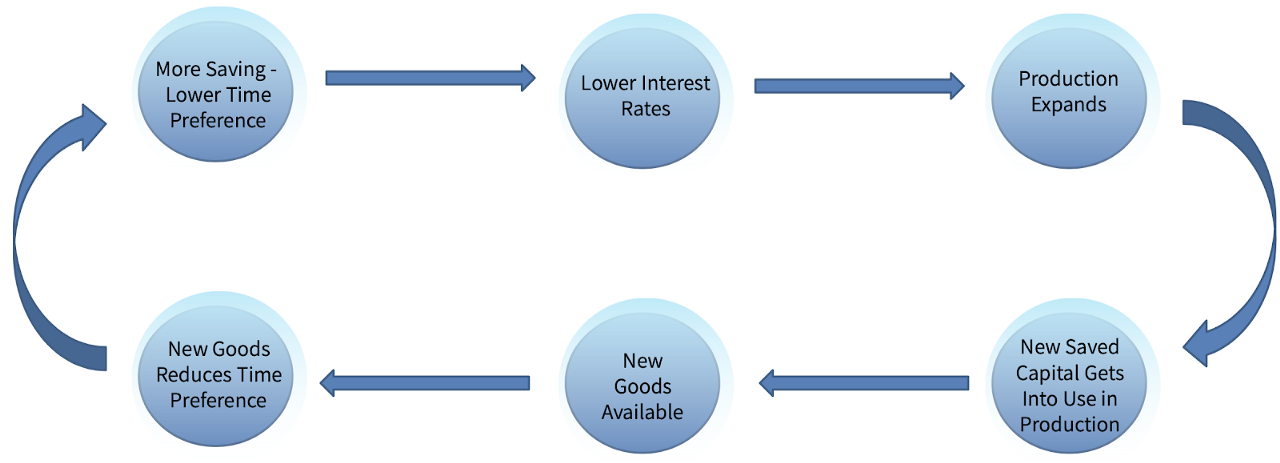
The Business Cycle
So far, we have not seen any issue which should lead to the appearance of the business cycle — the recurring periods of great economic boom followed by a collapse of projects throughout the whole economy. So now we shall turn to our main problem here, what, indeed, is the cause of the business cycle?
According to the Austrian theory, developed initially by Böhm-Bawerk’s student, economist Ludwig von Mises, the root of the problem is to be found in the intervention of governments and central banks with the money supply, more accurately, with their efforts to increase the money supply and expand credit.¹³ In simple terms, what credit expansion means here is the creation of money, out of thin air.¹⁴ There are many ways today by which governments aim to expand credit, like Quantitative Easing, fractional reserve banking¹⁵ — which is insured by the taxpayer (implicitly or explicitly) and fully regulated by the state, and various other accounting schemes and financial “tools.” Still, the essence of all those schemes is to increase the supply of money and credit in the economy, essentially out of thin air.
So what are the effects of such credit expansion on the process of economic progress we have discussed thus far? The initial effect from such credit expansion will be a drop in the interest rate. As the new money finds its way to (or, as usually happens, originates in) the banking system, banks will be in a position to offer cheaper loans, simply from having a greater supply of money available. This reduction of the interest rate has, for a long time, been the main (declared) objective of governments when pursuing credit expansion.
As we have seen, a lower (natural) interest rate is indeed correlated with economic growth, as it reflects lower time preference. From this, many economists have taken the leap to the conclusion that a lower interest rate promotes economic growth, and that it is therefore the government’s responsibility to push it as low as possible. However, we know that the interest rate is not like a metric on a machine, it is the reflection of the time preference of people. Attempting to promote economic growth by lowering the interest rate with credit expansion is like trying to “promote” rain by pushing down the pointer on a barometer. You will achieve nothing more than rendering the barometer defective and cause those who rely on it to make wrong projections. This is exactly what happens with the interest rate. As we said, entrepreneurs and businessmen rely on the interest rate to determine the length and complexity of their production efforts. The interest rate is their indication for how much capital is available to use for production. As central banks lower the interest rate, it lures entrepreneurs into expanding production and to commit to more roundabout processes than they otherwise would have taken. It distorts the economic data guiding entrepreneurs, leading them to make systematic errors, and ultimately misallocating capital.
At first, the expansion in production will cause an apparent economic boom, with more businesses opening, new constructions launching, wages rising and a general increase in economic activity. Nevertheless, this economic boom is necessarily unsustainable, as it relies on a defecting indicator for capital availability — the artificially low interest rate.
The essential problem caused by the artificially low interest rate is that it creates the illusion that there is more capital available for production than there really is. A “real” drop in the interest rate comes from a drop in the time preference of people, from the greater accumulation and saving of capital. The price system is the information system of the market economy, and the interest rate is the indicator informing entrepreneurs of changes in savings, in the capital available for production. However, when the government artificially lowers the interest rate, there is no change in the available capital. People did not reduce their consumption, nor did they increase their savings in any other way. There is no new capital to use in production, but with the artificially lower interest rate, entrepreneurs already rely on the existence of such additional capital in order to complete their expanded production processes. In other words, the increase in production started during the boom is unsustainable, it is impossible to complete, and will therefore have to end with a collapse.
But let us take a moment to see what this process would actually look like. With lower interest rates, as we said, entrepreneurs will expand production. They will take on new loans and use them to buy more capital goods. Now, since the supply of capital did not increase, but the demand for it from entrepreneurs rose, the prices of capital goods will have to rise to match the new demand. As the prices of the higher order goods rise, entrepreneurs will be forced to take new loans to obtain the capital they need to complete production. There will be a higher demand for loans and the interest rate, still artificially low, will be pushed back to the level where it corresponds to the true time preference of people. With the interest rate back up, and with the prices of capital goods adjusted to the new money supply, the shortage of capital to complete all production becomes apparent. The submarginal projects started during the boom, or malinvestments, as Mises called them, will again appear as unprofitable and will have to be liquidated. The final result of this process is a massive collapse of businesses across all the economy and a consequent high unemployment, that is, a recession.
During the recession, malinvestments are liquidated, and the capital invested in them is either lost or reallocated to more profitable projects. The recession is, in a sense, the re-adjustment of the market to the real capital and time preference of people. It is the market curing itself and recovering, wiping out the mistakes made on the basis of distorted information, stopping to waste scarce capital on unrealisable projects, and reallocating capital based on the corrected information.
In short, the business cycle is a period of unsustainable expanded production, induced by lower interest rates, followed by the realization that the expanded production is unsustainable, and the consequent collapse of businesses.
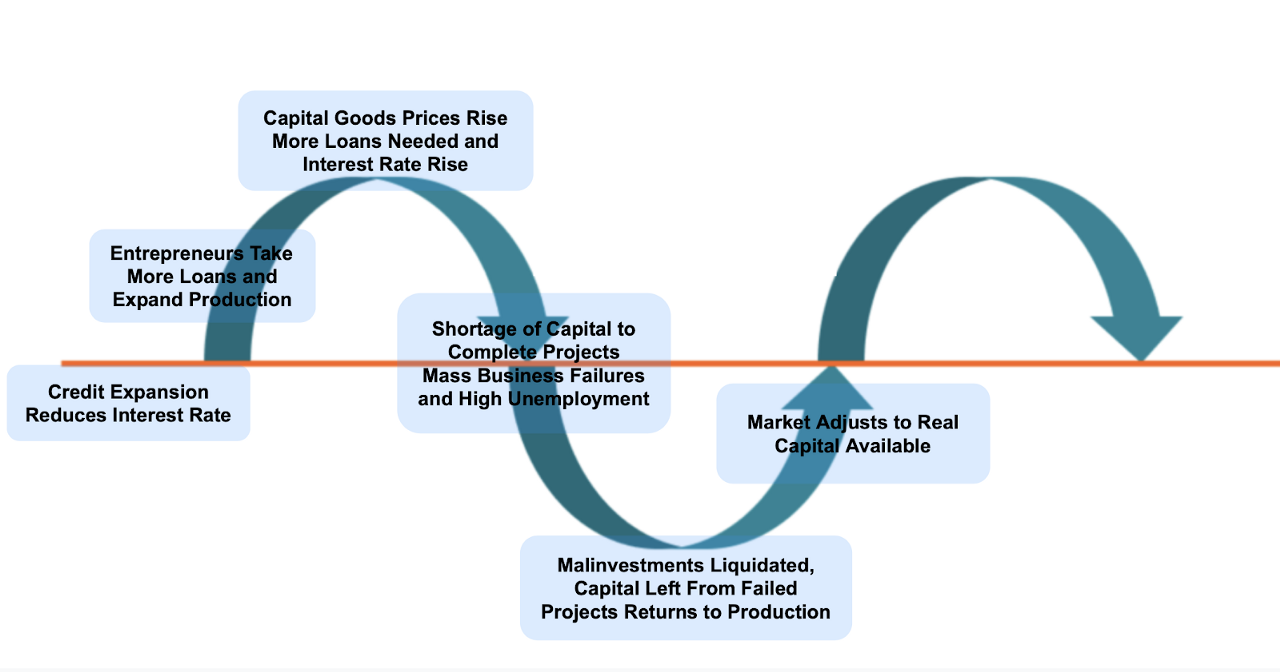
So what can we do to stop the recession? Unfortunately, once credit expansion has started causing the illusory economic boom, the eventual bust is inevitable. Capital is being wasted, and there is no way to make such malinvestments truly sustainable. Yet, basing their efforts on a different theory, governments and central banks still believe it is possible to artificially “combat” the recession by accelerating credit expansion even further. However, their repeated failures to handle those cycles leaves us a very good reason to question their theories and approach.
If the government pushes credit expansion even further, it will be able to reduce the interest rate again, essentially returning us to the first step of the cycle, but with the malinvestments made continuing to waste additional capital. Still, it is crucial to understand that they cannot do this forever. The boom is unsustainable, and preserving the malinvestments it induced by lowering interest rates at an accelerating pace will not change this fact, but only postpone it from being exposed, further delaying an amplified and inescapable market adjustment. Eventually, either capital is exhausted or a hyper-inflation ensues.¹⁶ Delaying the bust only aggravates the issue, causing a greater bust later, as it allows malinvestments to continue to waste scarce capital.
As the cycle becomes inevitable once the interest rate is distorted, the only way to stop the business cycle is to prevent interest rate manipulations. That is, we must prevent credit expansion from taking place. This is the approach taken by the Austrian economists, of which many, including Mises himself, suggested such reforms for preventing credit expansion. These were usually along the lines of returning to a rigid gold standard, having free market competition in money, or making large banking reforms, but among all their proposals, two, unfortunately contradictory, things are common.
First is their goal — their essence is limiting the power of governments and their control over money and credit. Second is their practical approach, which essentially amounts to limiting the government’s power *by asking the government* to limit itself. Such a thing is quite unprecedented. Governments will not voluntarily reduce their power over anything, nor will they admit of making such a huge mistake as causing business cycles for so many years, as adopting any such proposal must mean.
Many of the Austrian economists have realised this fault in their works to achieve any practical result, which led Friedrich A. Hayek, Mises’s most well-known student, to the following conclusion:
“I don’t believe we shall ever have a good money again before we take the thing out of the hands of government, that is, we can’t take it violently out of the hands of government, all we can do is by some sly roundabout way introduce something that they can’t stop.” — F. A. Hayek
This is precisely where Bitcoin comes in. While Hayek’s quote is from 1984, about two and a half decades before Bitcoin was invented, hardly anyone has ever described Bitcoin better than that. The idea of Bitcoin, as Satoshi wrote, is to create “a peer to peer electronic cash system”. That is, money which is operated by a global and open network, without depending on any central authority. No single participant or a specific group is necessary for operating Bitcoin — no one can shut it down, because there is no one Bitcoin depends on to continue to work. It is as Hayek said, a system which takes “the thing” (money) out of the hands of government, and that they can’t stop.¹⁷
This is the most important difference between Bitcoin and gold, which most Austrians still currently endorse. The gold standard was operated by governments and banks, and cannot work without such a system of a few central institutions holding most of the gold reserves. Without such a system, all gold payments will have to be physically delivered. Such an option was already impractical decades ago, but today, with all the digital payments made, it is just unthinkable. This means that the gold standard can only function if approved by governments, but is doomed as soon as the political attitude shifts unfavourably. It is this very weakness of the gold standard that enabled governments to effectively confiscate it (Executive Order 6102) and eventually completely remove it (Executive Order 11615). This weakness of gold is what Bitcoin aims to fix. It is “an unstoppable force” — money which does not ask for permission from politicians to operate.
Bitcoin and the Business Cycle
But assuming for a moment the use of Bitcoin as money, there is still the question of how would it help prevent the business cycle? Bitcoin has a few notable attributes in this regard.
First, Bitcoin has a predetermined fixed supply limit. It is produced by a mechanism of proof of work, a digital “gold mining” like process, and limited to 21 million units ever to be created. This is slightly different from gold, where mining can continue to unknown extent, but the important property they share is that their supply cannot be manipulated by government decree. No paper signed by politicians could make more Bitcoin or gold appear, unlike the system of fiat money we have today. This means that, with Bitcoin, governments will not be able to inflate the base supply of money. This is the first necessary step towards limiting credit expansion in the economy. But, while necessary, it is not enough by itself, as it still does not directly limit the ability of banks to expand credit.
This leads us to the second important way by which Bitcoin could help prevent the business cycle, and on which we have already touched briefly. It is the fact that Bitcoin works without intermediaries, it is peer to peer cash. It allows people to hold their money by themselves, without having to give (more correctly, lend)¹⁸ it to a bank to be able to make transactions. This will ensure a clear separation between money held by individuals for their regular expenses (as cash balances), and the money they wish to save and can be invested productively in the economy through the banking system. In other words, it could limit the part of the money, the reserves, held by banks, thus limiting their power to excessively expand credit. When people can use their money — without relying on financial institutions to make the transactions — they can choose what amount they wish to hold themselves to transact from, and what they prefer to save and invest in the economy, and entrust banks with managing the latter. Such a system will make sure that the supply of money and money substitutes (credit) in circulation remains stable, preventing credit expansion and the consequent business cycle.
Even if banking for “demand deposits”, that is for money held for regular expenses, continues, the fact that Bitcoin has a rigid supply will force banks to be responsible with their credit issuance or they will risk a bank run. Furthermore, since Bitcoin is a digital asset, it is much cheaper to store, verify and transfer than with physical assets. That is, Bitcoin does not need a Fort Knox to benefit from economies of scale in storing and handling it. Therefore, the barriers of entrance for new competing banks will be lower, and there will be better grounds for free competitive banking. This improved competition could force banks to be more responsible in managing reserves¹⁹, thus limiting credit expansion more effectively even in such a “free banking” scenario.
The Road Ahead
Now that we see the main economic reason for transitioning to Bitcoin, we can discuss how such a transition could take place. In fact, I would argue that this transition has already started. In just about a decade, Bitcoin has grown from being a mere idea on a mailing list to a global network serving millions of people, having cleared trillions of dollars worth of transactions. Many businesses have already started accepting it, people are hodling it, and we may even say that there is a new, alternative, financial system already developing around it. Despite the impression some people get from its short-term price volatility, the trend is clear, Bitcoin is going forward. It is not waiting for politicians to approve it (like gold or Libra do), or central bankers to adopt it, or for “economists” to embrace it — it is growing in spite of their current objections.
This present trend though is by no means inevitable. While it is unlikely that Bitcoin itself can be stopped, its adoption could very well be. In the end, Bitcoin is just a tool available for people, but it is the public which decides if they wish to pick it up and use it. Like with all other economic and political changes, the success of Bitcoin depends on public opinion. It is not enough that we have Bitcoin if people don’t see its benefits, or refuse to use it. Unfortunately, the most prevalent views of today, both in economics and politics, see Bitcoin as useless, harmful and even “evil”. The idea of money not controlled by the state is rejected by all popular doctrines of today, and the only view somewhat receptive to it, that of the Austrian school, has been on the losing side of public opinion for many decades.
However, it seems that together, by combining Austrian economics as a theoretical framework, with Bitcoin as the practical approach, we could have an incredible opportunity to sway public opinion. While the Austrian framework provides the theoretical explanations of the benefits of having sound, hard money, Bitcoin demonstrates them in reality. And while it is unclear what further consequences would result from adopting Bitcoin, the Austrian approach to economics can clarify that. The Austrian view is the only one which is able to provide an explanation for the success of Bitcoin, and even simply for its existence. In other words, Bitcoin exposes the public to the possibility of having a different kind of money, not controlled by the state, while the Austrian theory explains why such money can be so beneficial and desirable. Every day in which Bitcoin continues to operate is a slap in the face of the mainstream economists. It is a living proof that their theories might not be right after all. That the free market does not need the state to set and manage the money, and can produce a better monetary system by itself.
Conclusions
To briefly summarise, the unique properties of Bitcoin — being digital, peer to peer, unstoppable hard money, have the potential to make a real transformation in the economy, preventing the business cycle and allowing for sustainable economic growth.
For millennia, governments were entrusted to manage the money for their citizens, but history is flooded with examples where this power was abused.²⁰ While in the past, such abuses were shameful acts committed secretly by rulers against their citizens (like coin clipping), today — in the age of populism — the rulers are no longer ashamed of it, but to the contrary, they proudly announce those acts, backed by the “intelligentsia” providing excuses for how this is done “for the people” to “stimulate the economy”.
As Mises explained on the essence of sound money:
“It is impossible to grasp the meaning of the idea of sound money if one does not realize that it was devised as an instrument for the protection of civil liberties against despotic inroads on the part of governments. Ideologically it belongs in the same class with political constitutions and bills of rights. The demand for constitutional guarantees and for bills of rights was a reaction against arbitrary rule and the non-observance of old customs by kings. The postulate of sound money was first brought up as a response to the princely practice of debasing the coinage. It was later carefully elaborated and perfected in the age which — through the experience of the American Continental Currency, the paper money of the French Revolution and the British Restriction period — had learned what a government can do to a nation’s currency system.” — Ludwig von Mises
Money is the backbone of the market economy, it is what coordinates the action of everyone, which is why it must be neutral — resistant to manipulations and forced debasements. It is time that we take the thing out of the hands of the state, back into the hands of the people. It’s time to move to Bitcoin.
This article is based on a lecture given at the Value of Bitcoin Symposium which took place in March 2020, Vienna. The full video of the lecture is available here
Special thanks to Ben Prentice (mrcoolbp), David Lawant (DavidLawant_BTC), Emil Sandstedt (bezantdenier), Keyvan Davani (keyvandavani), Thibaud Marechal (thibm_), and Stefanie von Jan (stefanievjan) for all the feedback I received from their reviews, comments, and suggestions which helped me shape this article.
The State of L2 Investments
By Mohamed Fouda
Posted April 17, 2020
Courtesy of Token Daily
Part 1: Progress and Investability of BTC Off-Chain Solutions
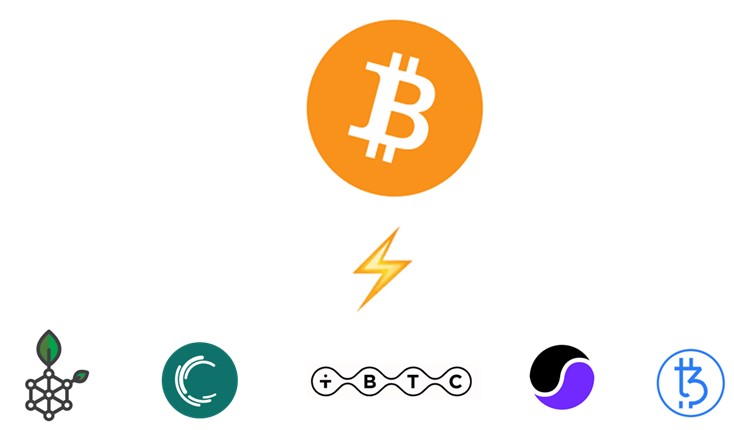
In 2017, the crypto bull run triggered explosive trading activity which stress-tested both Bitcoin and Ethereum networks. They each suffered congestion, delayed transactions, and higher fees. In response to these conditions, several scalability solutions were proposed or revisited with renewed interest in off-chain and layer-2 implementations. Entrepreneurs, researchers, and investors largely viewed L2 (Layer 2) solutions as having limited downside: they require only minor changes to the consensus layer and avoid centralization of the base-layer protocols. Meanwhile, their upside appeared uncapped. These solutions include Bitcoin’s Lightning Network and Ethereum’s Raiden, which can be described as true L2 solutions, and sidechains such as RSK for Bitcoin and Plasma Chains for Ethereum.
During 2018 and 2019, there was a healthy amount of activity around L2 development. On the Bitcoin side of things, the Lightning Network (LN) launched on mainnet in March 2018. In Ethereum, several L2 variants including state channels, e.g., SpankChain, and Plasma/Plasma Cash, e.g., Loom Network, also launched. However, as the bear market of 2018–2019 continued, we saw a significant dip in on-chain activity. You didn’t need to be particularly clever to figure out why: as speculative activity from these networks died down, there was weaker market demand for a scaling solution. As market conditions started improving in Q3 and Q4 2019 we saw more interest in L2 solutions — both in anticipation of a new bull run that would likely lead to congestion and for added functionality, like privacy, to base layer protocols.
In this series, we examine the current trends in off-chain networks and assess their investability. We also review off-chain solutions’ adoption and utility over the last two years. This is the first part of a two-part series. Part one will focus on the Bitcoin ecosystem, the second will focus on Ethereum’s off-chain trends.
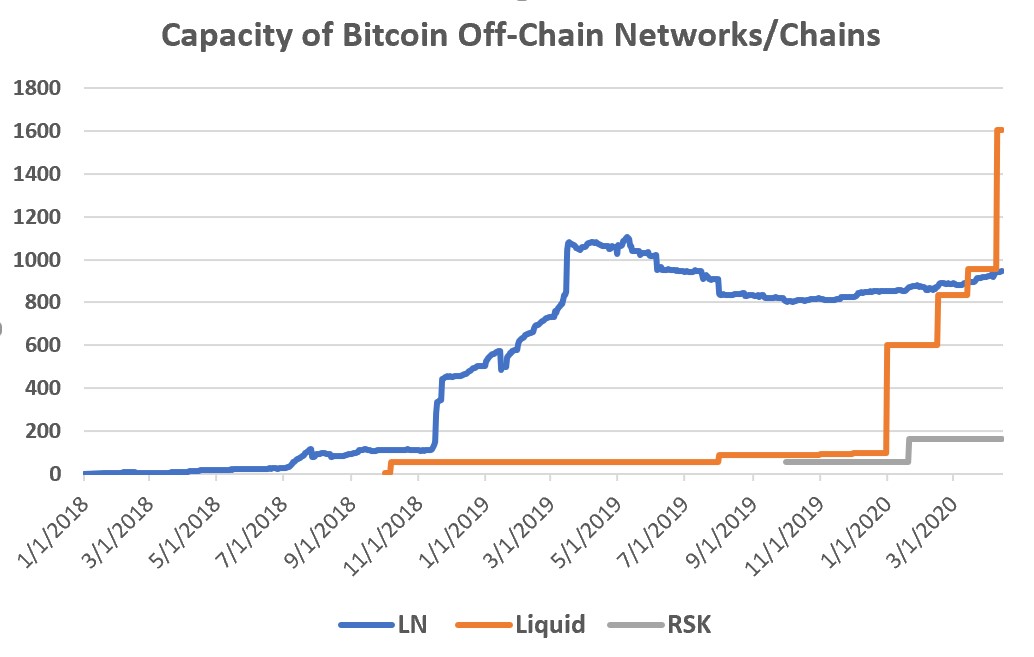 Comparison of the capacity of Lightning Network, Liquid Sidchain, and RSK
Comparison of the capacity of Lightning Network, Liquid Sidchain, and RSK
Lightning Network
LN is, by far, the most important and loudly discussed off-chain scalability project. Since the release of the 2015 Lightning paper, the project has been under intense discussion and debate. Since launch, there’s been impressive growth in the network in terms of the number of channels, network capacity, and use cases. However, entrepreneurs and investors are still figuring out which business opportunities make most sense in the LN ecosystem. The explored directions include: building liquidity hubs to collect routing fees, offering integrations and user services on LN, payment rails using LN, and finally investing in LN infrastructure.
Liquidity Provisioning in LN
Since LN’s aim is to create a payment network, especially for micropayments, building a business to do just that was low hanging fruit: offer several LN nodes with hundreds of channels, route payments and earn fees. The initial thought was this service would generate enough revenue to 1) cover the costs of operation and 2) generate risk-free profit.
Opponents of this view were quick to point to technical risks and the inherent capital inefficiency in LN that would require high fees or large transaction volumes to achieve this kind of risk-free profit. After two years in operation, the skeptics have so far been proven right. Today, it is not currently possible to build a profitable business just by collecting LN routing fees.
Theoretically, running nodes and routing payments on LN should be part of a profitable business, akin to running Bitcoin full nodes. That’s what teams like LNBIG, operators of the largest liquidity provider in LN, are counting on. LNBIG currently operates 25 public nodes and controls, roughly speaking, around 50% of the overall LN capacity.
According to LNBIG’s anonymous founder’s interview with The Block, LNBIG may be losing money on this investment now, but they are betting on long term adoption.
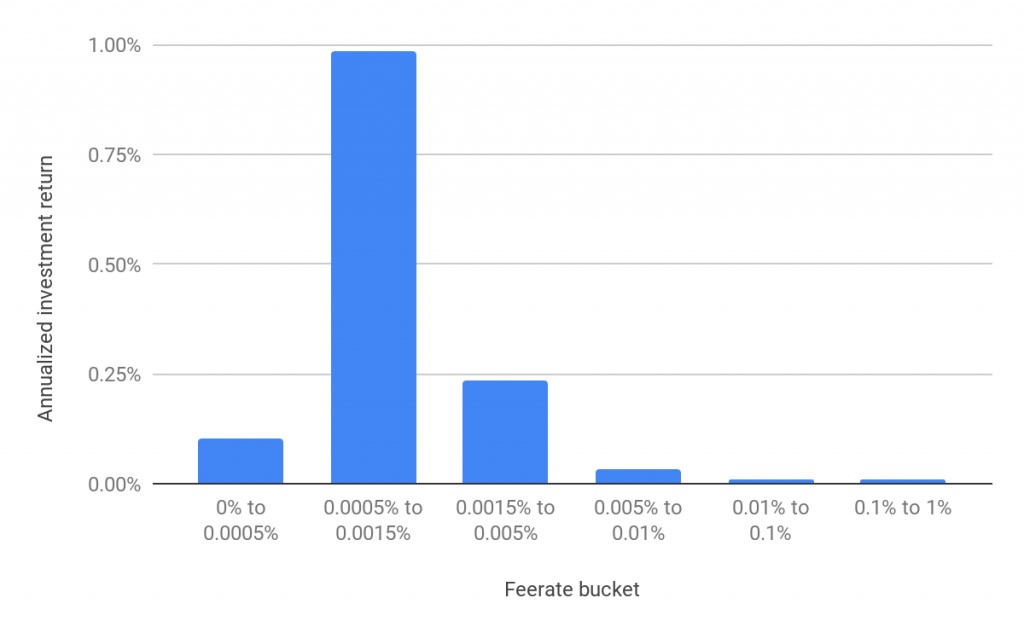 Annualized ROI for providing liquidity in LN during 2018. Source: BitMEX Research
Annualized ROI for providing liquidity in LN during 2018. Source: BitMEX Research
For those interested in more rigorous data on the economics of liquidity provisioning in the LN, BitMEX Research published thorough analysis in March 2019 on their own experience with LN fees. A major takeaway from the report is that for the first year of LN, under optimized conditions, e.g. channel fee rate, the annualized investment return was only ~1% from routing fees and this return does not include the on-chain fees required to open the channels.
LN User Services

The second type of investment in the LN ecosystem, and probably the most abundant, is the investments in user services. This is a broad category that includes all the services that interact directly with the consumer. We can categorize this sector into 3 major buckets:
- LN-enabled micropayments
- Financial services on LN
- Services that improve UX and integration with LN
The first type of LN services that organically appeared on the scene was “micropayment services,” largely because this was the entire point of the original LN narrative. Publishing platform Y’alls and the mobile-minutes service Bitrefill were the first services available for use on LN.
As LN started to grow, there was an uptick in tools that facilitated access to LN, including Lightning-enabled wallets such as Zap, Eclair, and BLW. Bitrefill also started to offer services to open channels for users like Thor channels. This allowed the LN ecosystem to mature, leading to the emergence of finance-focused LN user services like merchant services/Bitcoin cashback services (Fold), and LN-based BTC on-boarding (River Financial and the currently defunct Sparkswap), and LN-integrated exchanges (Bitfinex, LN markets).
LN user services sector is the most-heavily invested vertical within the LN sector for two major reasons.
- The number of companies being built in LN user services is larger than either of the latter two verticals. Statistically, more investment opportunities mean there’s a greater likelihood of those projects getting funded.
- It is likely that a winner in this vertical can also capture a market outside of crypto.
For instance, Fold’s focus on offering BTC-dominated cashback goes beyond the regular crypto community and targets a wider mainstream audience. LN here is use as a better UX tool to deliver the BTC rewards. This market direction allowed Fold to raise $2.5M last September. Similarly, Bitrefill managed to close $2M in VC funding to focus on expanding BTC merchant services using LN. Although there is general excitement for LN-based user services, this doesn’t come without challenges. Some companies, e.g., Sparkswap, which successfully raised VC money later found that they may have been too early and, in the land of startups, being too early is the same as being wrong.
Financial Rails Using Lightning
Though this is a relatively new direction in the LN ecosystem, it is likely to be a major trend in the near future. The goal here is to leverage LN features such as global coverage, instant settlement, and low fees to target users outside of crypto. In other words, these businesses use LN as a payment rail on the backend without the user necessarily knowing they are using BTC or LN. We can analogize this to Cash App or Venmo which use protocols like ACH and Swift under the hood to actually move users’ money around.
One of the earliest players in this vertical is Zap. Zap plans to use LN to settle everyday USD payments, such as merchant payments or individual cash transfers. The advantage of using LN as a settlement layer is the instant settlement capability and low fees which could replace traditional payments rails that charge up to 15% of the transaction size. Zap’s Strike product, for instance, achieves this goal without necessarily requiring the user or the merchant to use BTC at any time. This also solves major problems that hinder BTC adoption in payment systems, including price volatility and unfriendly tax laws around bitcoin payments.
LN Infrastructure
In crypto land, financing crypto infrastructure with venture capital, i.e., buying equity in companies developing protocols, is a highly contentious topic. The use cases, however, are clear. With Lightning, this means investing in the teams building and advancing the LN protocol. Three major startups working on this vertical are Lightning Labs, ACINQ, and Blockstream. As the critical pieces of the LN are already built, these companies focus on improving both the user and developer experience using the LN. For example, Lightning Labs developed tools like Loop and Faraday to help node operators smoothly manage their channels. Similarly, ACINQ is developing stripe-like API tools to allow businesses to easily integrate with LN.
When it comes to ROI, things get a little more complicated. For several crypto focused VCs, it is not clear if providing LN developer services will be enough to build profitable and sustainable businesses . Those who do not think infrastructure projects will be directly profitable are really paying for one of two things:
- The opportunity to get early access and insights to then invest in closed-source third parties that integrate LN.
- Leveraging their existing bitcoin position by supporting LN, which promises to usher in mass adoption by both users and merchants.
In spite of differing viewpoints, skeptics haven’t hindered either Lightning Labs or ACINQ from raising healthy series-A funding rounds in the past few months. Lightning Labs raised a $10M round early February, which brings the company’s raise total to $12.5M. Similarly, ACINQ closed an $8M series-A round last October.
Bitcoin SideChains
The initial focus of the LN was to support micropayments without the need for any trusted intermediaries. This focus excluded a number of exciting and desired features such as fast settlement of bigger Bitcoin transactions, confidential transactions, and the programmability of BTC transactions. This created an opportunity for other off-chain scaling solutions, namely sidechains, that could also posed as exciting investment opportunities in the Bitcoin ecosystem.
Liquid
Blockstream introduced Liquid in late 2018 to address the confidentiality of BTC transactions. Liquid saw slow growth over 2019, with less than 100 BTC locked in the sidechain. However, since January the sidechain has been receiving constant inflows of several hundred BTC each month, achieving a capacity of more than 1600 BTC in mid-April and surpassing the capacity of the LN.
 Liquid BTC (L-BTC) in circulation. Source https://liquid.net/
Liquid BTC (L-BTC) in circulation. Source https://liquid.net/
Blockstream currently lists 44 entities as members of Liquid, with more popular names only joining recently. So far, Liquid hasn’t gained significant traction among Bitcoin users. According to the Liquid block explorer, most of the sidechain blocks are empty or have a few single-digit transactions. Although Liquid’s main focus has shifted into tokenized securities, the tokenized assets on Liquid have tiny circulation caps. Tether (USDT) is currently the largest security issued on Liquid with a cap of only $16.5M. Liquid’s focus on asset (token) issuance doesn’t resonate well with many in the Bitcoin community who see the focus as an attempt to replicate Ethereum’s ERC-20 model. These low levels of adoption are definitely not what Blockstream’s $55M series-A investors have hoped for.
RSK
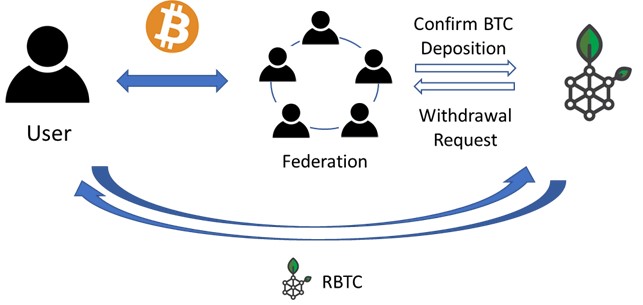 A Federation secures the two-way peg between Bitcoin and RSK
A Federation secures the two-way peg between Bitcoin and RSK
RSK’s ultimate vision is to replicate Ethereum on top of Bitcoin. To realize this goal, RSK has implemented a sidechain with a two-way peg to Bitcoin, and uses a fork of Ethereum’s smart contracts to implement programmability for the pegged Bitcoin asset, which is called RSK Smart Bitcoin (RBTC). Similar to Liquid, RSK uses a Federation to secure the two-way peg, the RSK Federation members are not publicly known and are only identifiable by public keys. Similar to Liquid, the sidechain is also struggling to gain any significant adoption. Despite the fact that RSK has been active since December 2018, it has only attracted ~160 BTC to the side chain. During 2019, the network had an average of only 50 BTC in the sidechain.
So far, RSK has been an underperforming investment , the company behind the project, RSK Labs, raised $7.3M in VC funding, according to Crunchbase. This does not include 22,000 BTC raised in a private token sale conducted by RIF Labs, which was merged with RSK Labs to create IOV Labs. What makes the situation worse is that RSK is now competing for attention with an ever-increasing number of projects that build interoperability between BTC and smart contract blockchains.
Interoperable BTC sidechains
For a while, many crypto investors believed that eventually every feature such as privacy and programmability would be built as layers on top of Bitcoin. For these reasons, Liquid and RSK sidechains may have sounded as good investments. Recently, this may have changed. For investors looking to add programmability to bitcoin, teams working on building bridges between BTC and Ethereum or other smart contract platforms have proven to be the better option. Just look to TBTC’s recent raise. The Keep/TBTC team announced a raise of $7.7M to accelerate project growth just a few weeks ago.
TBTC is not alone. In fact, it is safe to say that every emerging smart contract platform is already thinking of how to build a Bitcoin sidechain/bridge to its platform. In the Cosmos ecosystem, the Nomic Bitcoin Sidechain is an interesting project to watch. The project implements a Bitcoin sidechain using the Tendermint technology stack which would make Nomic BTC (NBTC) interoperable with other Tendermint assets when the Inter-Blockchain (IBC) protocol comes to life. Similarly, Tezos fans have started their own tzBTC project to mint BTC tokens inside the Tezos blockchain.
In conclusion, the past two years have witnessed a lot of experimentation and building in the Bitcoin off-chain scalability domain. Investments in LN, particularly in LN infrastructure and user services, has been growing significantly and is likely to continue growing over the next few years.
On the other hand, sidechains built on Bitcoin have struggled to gain enough traction or to capture developer imagination. The sidechain narrative has largely moved into the direction of interoperability. The logic here is simply “why rebuild it if I can just bridge to the same functionality but with more robustness and liquidity.”
To be clear, we are in the early days, and much of what we wrote above can and should change over the next year. However, we expect many of the developing trends that we are tracking now will form the backbone of our new financial system.
Bitcoin Is Not Slow – It’s Highly Secure
By Vlad Costea
Posted April 18, 2020

Poorly informed or disingenuous critics often point out to Bitcoin’s “slow” transaction validation time. Yet a truly decentralized and global currency needs to have a rigorous verification process which allows all nodes to validate and broadcast transactions.
The 10-minute block time is not just some cautious threshold that a concerned creator has added to an obsolete technology, in an era when internet speeds were slower. It’s a reasonable amount of time which allows everybody to be in sync with the rest of the network – from the miners who harness solar energy in the middle of the desert to the metropolitan node operators, all participants should have the capacity to download and validate ~1 MB every ~10 minutes.
Regardless of what shitcoin marketers will tell you, Bitcoin’s conservative monetary emission is nothing like the speed limit of a Ford Model T which shakes when driven on bumpy roads. It’s not slow, it’s just secure enough to avoid double spends and guarantee that no hidden inflation occurs.
One of the earliest and most famous cases of Bitcoin criticism belongs to Daniel Larimer. In 2010, he complained about the 10-minute block time and suggested that payment validation should be “as fast as swiping a credit card”.

Satoshi Nakamoto himself went on to argue in favor of a decentralized system in which users validate their own transactions, then dropped his famous “If you don’t believe me or don’t get it, I don’t have time to try to convince you, sorry” quote.
Bitcoin Security vs Banks
Speaking of transaction validations that happen as quickly as swiping a credit card, the concept of waiting ~10 minutes for the next block appears to be weird for people who come from traditional finance. In their minds, the currency of the internet should transfer instantly and confirm just as fast as their PayPal transfers.
This type of expectation is unrealistic in relation to decentralization. In order for a bank settlement to happen within seconds, there is a lot of institutional trust involved. The banks must trust each other, and the transacting parties are vetted by an intricate institutional setup that prevents double spends.
If Alice sends $1000 to Bob, then the confirmation happens instantly thanks to institutional agreements between their banks. The system relies on trust and is regulated by laws. Once confirmed, money transfer is not permanent and can be reversed or frozen at any time. Also, the actual settlement may take a very long time to happen, as banks keep tabs on each other and only move physical money when they think it’s necessary.
 In this thread, cypherpunk Nick Szabo beautifully compares Bitcoin’s security with the trusted and centralized assets.
In this thread, cypherpunk Nick Szabo beautifully compares Bitcoin’s security with the trusted and centralized assets.
Bitcoin is completely different in its design and requires specific security to preserve its qualities. First of all, Bitcoin is decentralized. This means that no central party has more authority than the other, and decisions are made with a consensus between nodes.
Secondly, confirmed transactions are final and irreversible. Attacking the network to reverse a transaction after one confirmation took place costs as much as 50 coinbases (312.5 BTC after the 2020 halvening), so the financial incentives are stacked against this type of action (using the same hash power to mine bitcoins generates a greater profit).
Thirdly, bitcoins are scarce and the Bitcoin network secures the emission at all times. If banks can get bailed out if they fail and new money can be printed by central banks to tax the wealthy through inflation, then Bitcoin operates outside of these political decisions. These concepts are hard to grasp by people who have spent most of their professional lives appealing to an authority that has decisive powers to make changes. But in Bitcoin you can’t appeal to a government or bank to revert a payment and you need proper security to make sure that transactions follow the rules.
Yet it seems like not even centralized exchange owners like Binance CEO Changpeng Zhao (CZ), who have been around the Bitcoin space for a while, seem to understand how the network works. So there’s no shame in trying to learn and understand.
Bitcoin Security vs “Fast” Shitcoins
If one was to document all the instances when altcoin/shitcoin proponents have pointed out to Bitcoin’s slowness, an entire encyclopaedia of misleading marketing schemes from the “blockchain industry” could could be written.
Every cryptocurrency derived from Bitcoin (with the exception of contentious forks that tried to identify as “the real Bitcoin”) has reduced the block time. Litecoin (created in 2011) releases new blocks every ~2.5 minutes. Dogecoin (created in 2013) generates a new block every ~1 minute. Ethereum (created in 2015) generates a new block every 15-20 seconds.
Yet there are lots of projects whose marketing departments (a concept that’s foreign to Bitcoin and any truly decentralized network) directly attack Bitcoin for being “too slow”. They’ll say that they can handle thousands and millions of transactions per second, they can compete with Visa and Mastercard, and they enable decentralization for mainstream adoption/institutions/a better future/whatever buzzword a marketing department can invent.
But the problem is that their definition of decentralization is very different. To many shitcoins, being decentralized only means lacking a central point of failure. Having a handful of nodes being operated by different actors is sometimes enough of a reason to engage in misleading comparisons with Bitcoin.
They don’t care as much about every user being sovereign and running a node to validate all transactions. They don’t educate users to download the reference client to verify the coins they’re receiving and increase their own privacy. It’s also likely that they will find excuses about full nodes being wasteful, expensive to operate, and unnecessary in their “revolutionary” and “decentralized” network.
 One useful resource that will help you understand network security and transaction finality is HowManyConfs.
One useful resource that will help you understand network security and transaction finality is HowManyConfs.
Most of the times, these shitcoins target audiences that feel disillusioned by the legacy banking system. So they will highlight their quickness by comparing themselves to Visa, Western Union, or PayPal, and then drop the “decentralized” argument. If they also include hype words such as smart contracts, DeFi (decentralized finance), AI, machine learning, and other terms that are popular in Silicon Valley, they might just attract the investments of clueless newcomers.
But how decentralized and secure is a network that is worth a few billions, but can be attacked for less than $10.000/hour? And what difference does it make if your shitcoin of choice receives a confirmation in 15 seconds, if it takes 5 extra hours to be sure that it’s as final as a Bitcoin transaction?
Also note that the case described is that of Ethereum, which has a reasonable amount of hash power to secure it – in the case of DASH you’d have to wait 8 days. If these network don’t improve their security with proper incentives, it’s likely that the gap will widen in the future.
Right now, the “slow” Bitcoin network is a lot faster if we consider security (which is the best metric for decentralized networks). And the 10 minute block time is just perfect to not discriminate between metropolitan broadband internet users and isolated individuals who use mesh antennae and have very slow connections. Everyone gets to be in sync with the network, everyone is encouraged to run a full node and can do it for less than $200, and every transaction that gets included in a new block is properly verified against double spends and inflation.
This “Model T” of cryptocurrencies actually turns out to be better according to the metrics that actually matter in decentralized networks. And for the scope of this analysis, only base layer transactions and security have been taken into consideration. The Lightning Network, Liquid, and other off-chain scaling solutions offer more privacy, speed, and scalability without minting new shitcoins.
So the next time somebody says that “shitcoin X” is faster than Bitcoin or claims that Bitcoin is slow, show them the criteria that truly count in a decentralized network. And when they claim to have invented the next Bitcoin, they better bring the network effect and security – or else it’s just a good idea that can be very well incorporated into the Bitcoin ecosystem as a sidechain.
 If you found this article useful, please consider making a donation to this address. 32vSnzJL45RKx5NRFGhjQbgyZkh6dpEcQf
If you found this article useful, please consider making a donation to this address. 32vSnzJL45RKx5NRFGhjQbgyZkh6dpEcQf
THE HONEY BADGER
By The Man in Black
Posted April
(Preview. 10min read)
SYNOPSIS The year is 2032. Bitcoin is now the global reserve currency, The rich live in walled citadels while the poor fight for survival in a neoteric wild west.
EXT. CITY SKYLINE(STOCK) - DAWN (2032)
INT. EMPTY CAFE – DAWN
A man wearing an eye patch and biker attire sits at a table while drinking coffee and eating steak. He looks at his watch – the time reads 07:59. The block height reads 1,238,960. A news bulletin broadcasts from a radio transceiver on the table.
RADIO NEWS REPORTER Breaking news this afternoon, in the early hours of this morning, an armed assailant forced entry into a small mining farm on the outskirts of town - killing one and injuring another. One man was pronounced dead at the scene, while the second man is said to be in stable condition. Immediately after the attack, the survivor broadcast a message via Bitcoin satellite - satnode. The message claims that the assailant stole a hard drive which once belonged to Bitcoin creator Satoshi Nakamoto.
The man glances at a small-black briefcase that sits next to him on a chair while cutting his steak.
RADIO NEWS REPORTER The message states that the hard drive holds the encrypted keys to Satoshi Nakamoto’s one million Bitcoin fortune and clues to the creators real identity. It is still unclear whether the drive is genuine, but one eye witness reports that shortly after the incident, THE HODLERS WATCH attended the crime scene and transported the unknown survivor to the citadel; escorted by their elite mercenary commando team - THE DREAD PIRATES. The Hodlers Watch declined to comment on the situation, although they are urging anyone with information to come forward. We will bring you more updates as the story unfolds.
The man takes a drink of his coffee. FREEZE FRAME on the man’s face. TITLE OVER - THE BEAR
RADIO NEWS REPORTER In other news, 18 people were killed last night as the freaks attempted a second siege on the citadel in just over a week. The casualties included 17 gang members and 1 citadel sentry. The Hodlers Watch say they will be increasing security along the perimeter wall due to the increased number of recent attacks.
The Bear puts down the knife and fork and chews his last piece of steak.
RADIO NEWS REPORTER Synthetic meat corporation – synthomeats - continues to expand. The corporation recently completed its latest development of a 5 acre super-lab in the Satoshi Springs district. The high speed rail network which connects the super-lab to the citadel, is due to be fully operational over the coming days.
RADIO NEWS REPORTER Scientists at the afterlife extension program have reportedly made a breakthrough after reanimating the first ever human being. The subject was said to have fully functioning speech but unfortunately died after 6 hours of reanimation. Our next bulletin will be at 2100 hours. Thank you to our sponsor Scav4sats America.
The Bear counts out 3 notes, each displaying 300 satoshis and puts them down on the table.
RADIO ADVERTISEMENT (over the top American salesman) Tired of being the same poor you? Tired of being out of sats and scavenging for your next meal? Hi, I’m Wade Goodwin – owner, operator and founder of Scav4Sats America, and I’m here to tell ya, you don’t have to be stuck with what you’ve got. One mans junk is another man’s treasure and here at Scav4sats America, we’ll turn your old into digital gold. With 4 locations situated around the citadel wall…
EXT. STREET – DAWN The Bear stands in a dirty, abandoned street. The sun is creeping up just below the horizon. Glimpses of orange light reflect from the windows of the high rise buildings. To the right – in the distance – a small group of men are huddled around a fire in a barrel. Steam slowly HISSES from a manhole cover in the middle of a pot-holed road. The Bear pulls out a cigarette from a crumpled packet. He strikes a match against the side of a match box and cups the flame while lighting the cigarette. He walks calmly down the street, croses the road and enters an alleyway.
EXT. ALLEYWAY – DAWN The Bear walks down the dark alleyway. An echo of a BOTTLE DROPPING and a SINISTER LAUGH rings out in the distance. The Bear pauses to look at a malnourished HOBO slumped in a doorway. he’s holding a piece of rotten cardboard that has an image of a QR code with the words “spare sats” written underneath. FREEZE FRAME on hobo’s face. TITLE OVER - ROGER.
The Bear takes out a handful of Bitcoin notes from the inside of his leather jacket and places them in an empty tin by the hobo’s feet.
ROGER Bless you…bless you fine gentleman.
As The Bear rises up, a mysterious shadowy figure stands before him. FREEZE FRAME on the mysterious figure’s face. TITLE OVER - THE BULL.
The Bull is wearing what looks like a SCUBA suit, with over layers of Kevlar bi-weave body armour covering the chest, arms, calves and thighs; hidden under a long trench coat. The hooded man has a gas mask attached to his face and his leather gloves house iron plated knuckles.
THE BULL I’m afraid you’re going to have to put the Lambo on hold.
THE BEAR Lambos are overrated, I’m holding out for a life extension plan and a ticket off this goddamn planet. THE BULL Hand it over, walk away, and I’ll let you live.
The Bear takes a drag on his cigarette.
THE BEAR I should have shot you when I had the chance.
>THE BULL
Could’a, would’a, should’a.
Both men silently stare at each other. The Bear takes another drag of his cigarette. As he pulls the cigarette from his lips, he violently flicks it at The Bull, the embers ricochet from his Kevlar armour like a spitting fire. The Bear draws for his holstered black, sawn-off, shotgun. As he raises the weapon, the Bull charges at him, deflecting the gun away. A shot discharges from the barrel, blowing Rogers head clean off. The blood soaked cardboard QR code now unreadable.
The pair tussle for control over the gun, but momentum flings it under a steel dumpster. A fist fight ensues. Both men are skilled fighters, neither land any clean blows. The pair clinch. The Bull forcefully throws The Bear against the dumpster. The Bear sprints and tackles the Bull and they both crash through a pane glass window of an abandoned pizza shop.
ANGLE ON shop front.
The sounds of men FIGHTING and BOTTLES BREAKING can be heard inside of the shop. A MAN wearing a blue azure boiler suit is thrown through a second pane glass window - landing in the alleyway. After a momentary pause, two GUNSHOTS are heard. The shop door swings open and a second man also wearing a blue azure boiler suit limps out holding the briefcase. THE LIMPER stumbles out of the alley towards the road.
The Bear runs out of the shop looking left and right. He runs towards the steel container, retrieving his shotgun from underneath. He heads down the alleyway and removes a pile of black-plastic trash bags to reveal a motorcycle underneath. He holsters his shotgun at the side of the motorcycle and kick starts the bike. He rides towards the road, briefly stopping at Rogers body. He reaches into the tin, taking back his donation and puts the notes into his jacket pocket. The tyres SQUEAL as he exits to the street. The licence plate reads NO2X.
EXT. CITY ROAD - DAWN.
The Bear cruises down the desolate road. In the distance he notices The Limper hobbling along the side walk carrying the briefcase. The Bear slows down and mounts the side walk on his motorcycle. As he approaches the Limper, he pulls out the holstered shotgun, takes aim and shoots him in the back. The Limper is blown forward off of his feet - landing on his face. The Bear stops beside him and dismounts. He kicks the Limper over on to his back and rests one foot on top of the his chest. The Bear cocks open his shotgun and loads two slugs into the barrel.
THE LIMPER Please…plea…
The Bear flicks up the shotgun and shoots the Limper in the face. He picks up the briefcase and puts it into a saddlebag attached to the side of his motorcycle. He holsters his shotgun and kick starts the bike. As he rides off down the road. The title credits role to the track JUNGLE BOOGIE – KOOL & THE GANG.
A Declaration of Monetary Independence
By Brady Swenson
Posted April 21, 2020

In unanimous Declaration of the decentralized Nodes of Bitcoin, when in the course of human events, it becomes necessary for people to dissolve the monetary bands which have connected them with another, and to assume the separate and equal station to which the Laws of Natural Money, and of Human Nature, entitle them, a decent respect to the opinions of humankind requires that they should declare the causes which impel them to separation.
We hodl these truths to be self-evident, that all humans deserve certain unalienable rights, that among these are Life, Liberty and Property. That to secure these rights, Bitcoin is instituted among humans, deriving powers from the consent of the Node Operators, that whenever any form of Monetary Policy becomes destructive to these ends, it is the right of the Node Operators to alter or abolish it, and to institute a new Monetary Policy, laying its foundation on such principles and organizing its powers in such form, as to them shall seem most likely to effect their Safety and Property.
Prudence, indeed, will dictate that Monetary Policy long established should not be changed for light and transient causes; and accordingly all experience hath shown, that people are more disposed to suffer, while evils are sufferable, than to right themselves by abolishing the forms to which they are accustomed. But when a long train of abuses and usurpations, pursuing invariably the same object evinces a design to reduce them under absolute Despotism, it is their right, it is their duty, to throw off such Monetary Policy, and to provide new guards for their future Security. Such has been the patient sufferance of these humans; and such is now the necessity which constrains them to alter their former Systems of Monetary Policy.
The history of the present Monetary Policy of the United States is a history of repeated injuries and usurpations, all having in direct object the establishment of an absolute Tyranny over these humans. To prove this, let facts be submitted to a candid world.
They have refused assent to Monetary Self-Sovereignty, the most wholesome and necessary for the public good.
They have forbidden people to pass a Monetary Policy for the accommodation of the world of free people, unless those people would relinquish the right of the use of Natural Money, a right inestimable to them and formidable to tyrants only.
They have enabled private banking institutions at places unusual, uncomfortable, and distant from the depository of their Private Ledger, for the sole purpose of fatiguing them into compliance with their measures.
They have debased bearer assets repeatedly, for opposing with firmness their invasions on the rights of the people to Natural Money.
They have refused for a long time, after such debasements whereby the Monetary Policy, incapable of Annihilation, to return to the People at large their exercise; the People of the World remaining in the mean time exposed to all the dangers of invasion from without, and convulsions within.
They have obstructed access to Natural Money, by refusing the abdication of control of the Money.
They have kept among us, through tyranny of the Monetary Policy, even in times of peace, excessive Standing Armies without the Consent of the people.
They have combined with others to subject us to a Jurisdiction foreign to our constitution, and unacknowledged by our laws; giving Assent to their Acts of pretended Legislation.
For imposing surveillance among us through, among other methods, the use of their Money.
For imposing Inflation on us without our Consent.
For abolishing the free System of Money, establishing therein an Arbitrary Monetary Policy, and enlarging its Jurisdiction so as to render it at once an example and fit instrument for introducing the same absolute rule into the rest of the World.
For altering fundamentally the Form of our Money.
They have abdicated Monetary Governance here, by declaring the Money to be in their sole Protection and waging Monetary War against us.
They are at this time printing large amounts of Fiat Money to complete the works of death, desolation and tyranny, already begun with circumstances of cruelty & perfidy scarcely paralleled in the most barbarous ages.
In every stage We have Petitioned for Redress in the most humble terms: Our repeated Petitions have been answered only by repeated injury. A Chairman and Government whose character is thus marked by every act which may define a Tyrant, is unfit to be the ruler of a free money, nor should money be controlled by a central authority.
We, therefore, the Representatives of the Nodes of Bitcoin, in Nakamoto Consensus, Assembled together, appealing to the People of the World for the rectitude of our intentions, do, in the Name, and by Authority of the Node Operators solemnly publish and declare, that we are, and of Right ought to be, bearers of a Self-Sovereign Money; that we are Absolved from all Allegiance to the Monetary Policy of the United States, and that all monetary connection between us and the Federal Reserve Bank and the Global Banking Cartel, is and ought to be totally dissolved; and that as Hodlers of Self-Sovereign Money, we have full Power to establish Commerce, and to do all other Acts and Things which Self-Sovereign Economic Actors may of right do.
And for the support of this Declaration, with a firm reliance on the protection of Mathematics and Cryptography, we mutually pledge to each other our Lives, our Fortunes and our sacred Honor.
The declaration was originally published on Twitter. Some edits have been made in this version to more clearly articulate its intentions.
Citadels Are Not Just A Meme
By bitcoinkatia
Posted April 21, 2020
“I am a time-traveler from the future, here to beg you to stop what you are doing”.
Anarchy and Chaos Bad?
We all remember that meme about Citadel: no governments, no taxation, anarchic places, corruption etc.
The situation described is what a majority of people would call “chaos”. Though, they forget that chaos and order, in fact, cannot exist without each other (was there a progress without what was considered as chaos?). They also like to say that “chaos” is “anarchy”, while in fact, anarchy does not equal chaos.
Citadel, as an opposite to system, is in many ways an “anarchic” place itself, and that is not bad. It is important to understand that anarchy is not a political movement, but a philosophical concept. If people didn’t naturally band together in groups with anarchic vibes, we (probably) wouldn’t experience things like Internet, 3D printing, Bitcoin, mesh networks etc.
These creations: money and communication, the main means of control, are targeted to ultimately re-balance the state of things.
Money And Communication to Settle Down
Our world is centralized and globalized, but processes in it always fluctuate (nothing is steady, even if statism makes it look that way). Simply, world is not homogenous but fractious. Fractions are everywhere, because underlying groups have their own interests and values. The idea of a separate structure is as natural as evolution. Money and communication will eventually want to evolve to a different form (even a transcendent form).
During medieval ages people lived far away from each other, separated by large areas of forests, mountains or water. Later they became countries, and now we have globalization which basically makes our interests and values unseen (minor detail in the blind eyes of the state). What is bad for the state, but good for the rest, is points of bifurcation that will always organically appear. As globalization exaggerates and manifests itself, we should start to focus on that detail.
The Ugliness of State
The state will simplify everything to keep itself alive. Just print more paper coupons(brrr), or define the world into 4 squares, which we call a political compass. However, this does not define or rule how the real world behaves.
It’s not a secret that work occupies most of people’s time. With the growth of industrialization, humanity was set to a 9 to 5 schedule, having some crumbs of free time for rest. Escaping the wage slavery is impossible for the majority, people need to earn a living. But is there a way to have means for living, while being meaningfully engaged with society, and doing your own thing?
38% of people around the world think they work at meaningless jobs (check out “Bullshit Jobs”, a book by David Graeber). Those people are brave to admit their daily work activity has little meaning for them or society. How many can’t?
On one side we have poverty and inflation, on the other side we have 1 in 5 persons depressed. Depression creates a significant economic burden on society, 50% of which is attributed to the workplace. Isn’t it absurd that people who want to quit their jobs, being unhappy with their lives, end up unhealthy, paying for medical care which is the most inflated category of spending?
They hate it, but being vocal is tamed by homogenous structures, vectored, controlled. Critical thinkers become “enemies”. Political failure, economical failure, authoritarian life management measures happen repetitively, but those who question reality are unpopular in the world where most are asleep.
This system is cyclic and rotten.
The Way Out
Citadels are noetic sets of desired lifestyles, results of an excercise in finding better meanings of value and compensation opportunities than the current ones provided by centralization.
Frankly speaking, “citadeling” has taken roots, with gaming and Internet communities pioneering it. Globalization heralds the unitary as a virtue. The world merges into one big convenient landscape, meanwhile losing uniqueness. But we started from the text-based virtual realities like LambdaMOO, to different life simulators, and now we have moved on to VR (along with that seeing MUD like NuTokyo and MMO like OWW revivals). We already know our physical world can work better, because we got to know Bitcoin. Thinking about different worlds we can create in cyberspace, we may come to the conclusion that it can work even better giving up the homogeneous approach. Moving towards flexible clusterization of being, encouraging peculiarities in culture, improving knowledge, making employment and time-spending meaningful - in our citadels.

BITCOIN-A REBELS RENAISSANCE
By Stefen Reid
Posted April 23, 2020
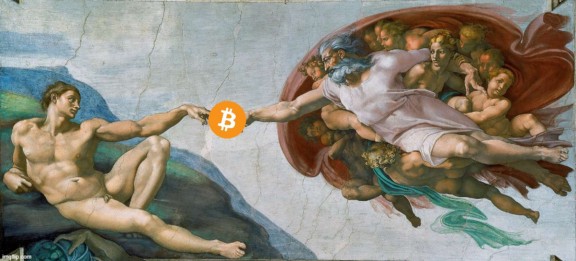
The world is experiencing one of the most disruptive, unexpected, and behavior-altering events of the last century. Billions of people are facing a new reality due to our global reaction to a Pandemic. Never in the history of the earth, have this many people been quarantined and forced to stay home under penalty. Global fear and uncertainty are sure to heighten the emotional charge of all Sapiens. What long term effects will this have on our future? History does provide some reasons to be optimistic.
One of the most influential and recognized periods in mankind’s record was launched after another world-altering pandemic experience. The Black Plague was believed to have ravaged Europe from 1347–1352. It may be no coincidence that most historians identify the mid 14th century as the beginning of the Renaissance.
The Renaissance has been defined as a transition from Medieval times and the rebirth of Humanism, derived from the concept of Roman Humanitas and the rediscovery of classical Greek philosophy, math, and science. Scholars and artists of the Renaissance were fascinated by the great cultures of ancient Greece and Rome. They believed that studying the achievements of the past was the key to creating a glorious future. The teachings and building blocks from antiquity like Thales, Pythagoras, and Aristotle were methodically unearthed and studied, shaping the beliefs and endeavors of the Renaissance man.
**The Renaissance was about the Rediscovery, Improvement, and Application of ancient knowledge.
Necessity is the mother of Invention….Plato
The Renaissance spawned 3 innovations that changed the world.
1)PRINTING PRESS -Johannes Gutenberg-1450
Knowledge is power
The invention of the mechanical movable type printing press helped disseminate knowledge wider and faster than ever before. The printing press accelerated the Renaissance by empowering ideas to spread through the democratization of printed information.
Printing powered the Scientific Revolution due to the precision of printed text and access to these ideas. ‘On the Revolution of the Heavenly Spheres’ by Nicolas Copernicus (1543) is believed to be the text that opened Europe to the power of Science. The increased availability of printed text was the impetus for the proliferation of literacy and education. This marked the inception of opinion pieces, alternative news, and propaganda.
 Scientific Text
Scientific Text
Euclid’s Elements has been referred to as the most successful and influential textbook ever written. It was one of the very earliest mathematical works to be printed after the invention of the printing press and has been estimated to be second only to the Bible in the number of editions published since the first printing in 1482.
The democratization of information and opinion destabilized power centers like the Catholic Church.
Lower cost reproduction and literacy led to people’s ability to read the Bible and gain personal insight into the word of God. The Printing Press enabled differing interpretations of the Bible to emerge, propelling Humanism as the Church lost authority as the gatekeeper to God.
 Gutenberg’s moveable type Printing Press
Gutenberg’s moveable type Printing Press
Guttenberg’s Printing Press was a precursor to the Industrial Revolution. Mechanization and Industrialization would grow to power and pay for the transition from Monarchs to the emergence of the Nation-State.
Man is too often unaware of the grand change that surrounds him.
2)TIMEPIECES — 1430
The earliest existing spring driven clock is the Chamber Clock given to Phillip the Good, Duke of Burgundy, around 1430.
The precise measurement of Time was a crucial development in the evolution of mankind.
Until the late Middle Ages, people had to rely upon sun or water clocks, which did not play any role in basic life and business activities. Mechanical, spring-loaded clocks became widespread in the 15th century as they were used in medieval monasteries to keep the regulated schedule of prayers known as Canonical hours.
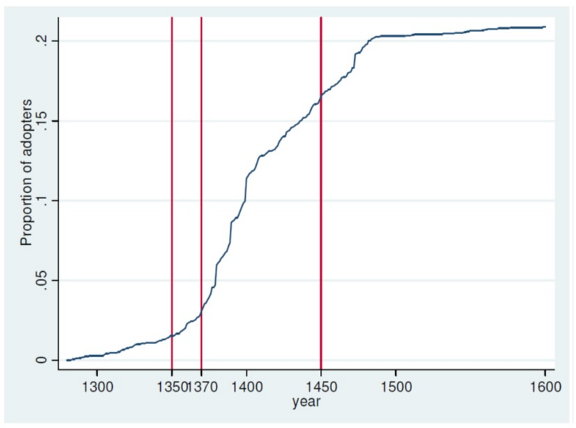 Diffusion curve of the mechanical clock
Diffusion curve of the mechanical clock
Mechanical astronomical clocks were initially influenced by the astrolabe. The astrolabe was used primarily to make astronomical measurements, typically of the altitudes of celestial bodies, however, astute philosophers, astrologers and sailors devised hundreds of uses for the instrument. Astrolabes were analog computers that had many uses, however, they fell short of solving the Longitude dilemma.
 Astrolabe
Astrolabe
To solve for Longitude, star measurement was inadequate. Due to the spin of the earth, a precise measurement of time was required to determine the hour of the sun’s zenith. This information could then be used to calculate how many hours your position differed from Greenwich Mean Time. One hour of time difference corresponds to 15° of longitude (360°/24 hours = 15°/hour). Solving the Longitude dilemma enabled sea explorers to accurately map their North/South coordinates enabling Columbus’ landing in the Bahamas. Prior to this, most open sea exploration was limited to East/West navigation using Polaris or the southern equivalent to track Latitude. Timepieces allowed for the precision of time measurement and synchronization of activity, which led to the advancement of sea exploration and celestial study.
The Heliocentric discovery altered the reality and trajectory of mankind.
Precision timepieces led to Nicholas Copernicus’ Heliocentric theory. The discovery that the Sun is at the center of our Solar system was due to his ability to more accurately track celestial bodies relative movement. This was a supremely controversial theory that was a massive threat to the Church and a direct challenge to the convention of the time. This concept was so dangerous that Copernicus chose not to publish his theory out of fear of repercussions from the Church. His findings were later publicly expanded on by Galileo, who spent the last 10 years of his life under house arrest for acts of heresy against teachings of the Roman Catholic Church.
 Geocentric vs Heliocentric
Geocentric vs Heliocentric
3)DOUBLE ENTRY BOOKKEEPING- 1340
- Earliest European record 1340 Genoa
The Black Plague was indiscriminate and ruthless. Rich lords and paupers died alike. After the death of millions in Europe, the social order was reconfigured as merchants emerged into a new elite. Historical records show that since the second caliphate, 634–644. Muslim civilizations had adopted written accounting. However, it was the Italian merchant class that utilized Double Entry Bookkeeping to advance civilization.
Assets=Liabilities+Equity
Every financial transaction has equal and opposite effects in at least two different accounts. Double Entry Bookkeeping provided a quantitative, transparent account of the financial state.
 Simple yet Profound
Simple yet Profound
In 1425, Cosimo Medici was an Italian merchant, investor, banker and patron of the arts. The Medici family was an example of the great wealth that grew, in part, due to the application of Double Entry Bookkeeping. This innovation helped expand their business interests in the region as they pioneered banking and the advent of interest.
Financiers became the patron of the arts. It was Cosimo that began to commission artists like Donatello, Michelangelo, and Leonardo DeVinci to paint, sculpt, design, and build Renaissance architecture. Double Entry Bookkeeping was the balanced financial record that enabled businesses to finance sea exploration and works of art.
This newly documented state of balance reflected the duality of entries in the system and the exchange element in transactions. This led to the inception of conservation laws of matter, momentum, the First Law of Thermodynamics, and Newton’s Third Law of Motion.
 Action/Reaction
Action/Reaction
The Printing Press, Timepieces, and Double Entry Bookkeeping were important innovations and the applications had consecutive order effects that shaped the future.
CURRENT PARALLELS
History doesn’t repeat, but it often rhymes…..Mark Twain
Humanity’s storied past is circular, one of epic struggle and achievement. Natural growth occurs as a response to resistance, just as trees reach for the sky, strengthened by the force of gravity. Today, billions of people are forced to sit and think as uncertainty has gripped the planet. How do we respond to such times?
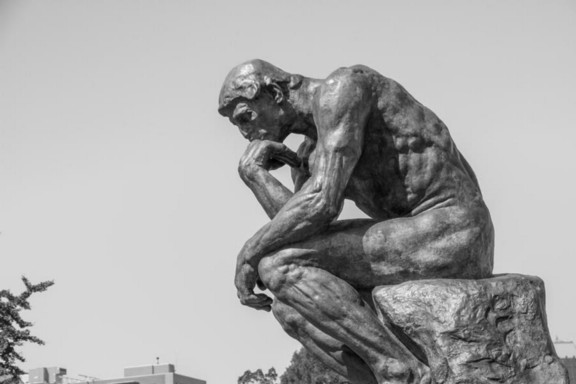 Rodin’s The Thinker
Rodin’s The Thinker
Introspection leads to creation.
Just as the Renaissance of the 14th and 15th century’s quest for knowledge was accelerated by a pandemic and the rise of Humanism. The current global slowdown and central banks’ currency creation may lead more people on the quest to rediscover the concept of Money and Trust.
The darkest hour is that before the dawn…..Proverb
Throughout the dark annals of history, victors have written the script. Similar to the Medieval Church, today’s governments and power brokers control the public narrative and psychology. As the Church was the arbiter of God’s will, governments and their central banks have become the gatekeepers to the mystery of Money. This is all about to change…
Bitcoin was presented to the world over 10 years ago as a working concept that harnessed older technologies and innovated upon them to create an entirely new paradigm. The Truth Machine. Imagine a world where no story could be sold unless agreed upon by a consensus of participants (peer review), which possess an immutable, uncensorable, record of fact. A righteous democracy.
Bitcoin is the keystone innovation to the Rebels Renaissance.
Like 14th and 15th-century scholars, today’s renaissance thinkers are rediscovering ideas of the past, but through a modern lens. The Bitcoin network is a digital settlement layer, composed of thousands of participants contributing real computational resources to support and verify the state of the transaction chain. Money is the first and most obvious application.
To understand Money, we must recognize both the properties and context within Austrian economics. The foundation of all of Austrian Economics is that each individual is a conscious actor, has chosen goals, personal preferences, and attempts to achieve desired ends. Society is seen as merely the complex of interacting individuals, not an independent entity.
Ludwig Von Mises is acknowledged as the father of Austrian economics. In 1940, Mises authored ‘Human Action’ which many considered the largest and most scientific defense of human freedom and capitalism ever published.
_Human civilization is not something achieved against nature; it is rather the outcome of the working of the innate qualities of man. _Ludwig Von Mises
Another giant of Austrian economics, Friedrich Hayek, is considered a major social theorist and political philosopher of the 20th century. His theory on how free-market price discovery communicates information that helps people determine their plans is widely regarded as an important milestone achievement in economics. In 1944, Hayek published ‘The Road to Serfdom,’ which is a treatise on the importance of Classical liberalism relative to the dangers of Centrally planned economies.
An economy is a compilation of transactions between willing participants with adequate information to make personal decisions. The information that all actors require is represented by units of account or cost. Money is the measure that provides this information to facilitate the transactions. Money is information as a measure of value similar to how a Clock provides information as a measure of time or the Ruler a measurement of length. In order to be a measuring tool, the unit must be constant.
 Standard measurements of length
Standard measurements of length
For example, we quantify speed as a ratio of a length over time (Km/hr). How could we agree on a speed limit if the measurement of a KM changed daily based on some arbitrary board that manipulates the standard measurement of length? It seems obvious that both of these measuring units must not fluctuate or this ratio would be meaningless. It is for this reason that Money must remain a constant unit as a measure of value to provide accurate information to the participants in a transaction.
Store of Value is the primary differentiation between Money and Currency.
Both Money and Currency are Mediums of Exchange, Units of Account, Fungible, Portable, Divisible, and Durable, however, only Money is a Store of Value.
A Store of Value must be scarce and difficult to replicate.
A store of value is the function of an asset that can be saved, retrieved and exchanged at a later time, and be predictably useful when retrieved. More generally, a store of value is anything that retains purchasing power into the future. Bitcoin has a coded constitution that will only allow 21 million full units to ever exist. A predictably scarce unit that takes considerable resources to create and difficult to manipulate is Hard Money.
Fiat currencies issued by central banks are not finite or a store of value. Governments around the globe are participating in currency creation at alarming rates. The currency they create competes against your earnings for the same goods and services. Imagine playing the ‘Monopoly’ board game competitively, but the other player gets to start with all the Bank’s money.
He who owns the Gold makes the rules..Wizard of Id
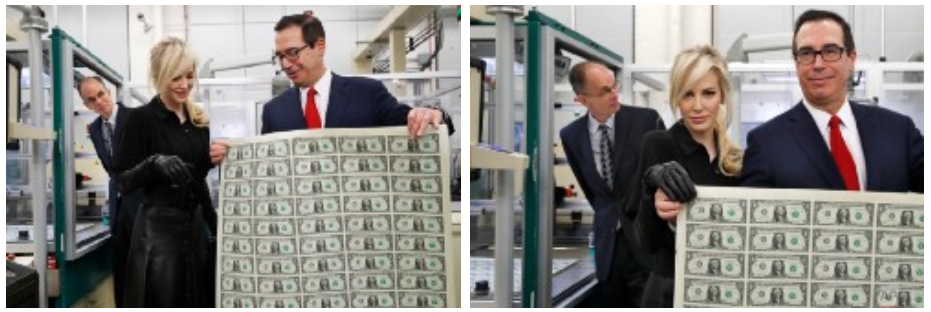 Banker USD Monopoly Currency
Banker USD Monopoly Currency
You are playing against the Bank and they get to counterfeit the currency out of thin air.
Money is a public utility and the lifeblood of a society. When contaminated, society becomes ill. Bitcoin is the people’s money which will help build a sound society for the people.
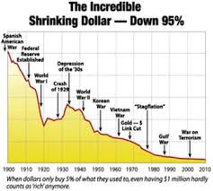
Why Does Hard Money matter?
First, you must ask what other commodity is finite? Time! Should you invest your time to earn Currency or Money? Why then do we accept Currency for our efforts? It is because Fiat Currency must be accepted for credit and debits by Government decree. Therefore as per the chart above, each hour you trade for a depreciating Currency diminishes the return on your time. Debasing a currency is theft. Currency steals Time. Why do we accept this?
Keynesian economics is a theory that says the government should increase demand to boost growth. Keynesians believe consumer demand is the primary driving force in an economy. As a result, the theory supports expansionary fiscal policy and centrally manipulated money supply. This is the antithesis of Austrian economics, which believes the production of goods and services and capital allocation based on free-market information is how prosperity is created.
Murray Rothbard stated “the fundamental political question is why do people obey a government. The answer is that they tend to enslave themselves, to let themselves be governed by tyrants. Freedom from servitude comes not from violent action, but from the refusal to serve.”
Tyrants fall when the people withdraw their support.
Bitcoin withdraws your personal support of a Fiat Currency system by moving to a Finite, Digital, Transportable, Divisible, Durable, Store of Value. Bitcoin saves Time.
Bitcoin leverages and improves upon existing innovations.
Encryption, Proof-of-Work, and Network effects all existed prior, however, it was Bitcoin that captured the synergistic power of these concepts.
Encryption is the method by which information is converted into a secret code that hides the information’s true meaning. The science of encrypting and decrypting information is called cryptography. The first known evidence of the use of cryptography (in some form) was found in an inscription carved around 1900 BC, in the main chamber of the tomb of the nobleman Khnumhotep II, in Egypt. Encryption enables users to privately and safely store and access information digitally.
Proof-of-Work was invented in 1993 to deter frivolous or malicious uses of computing power.In the Bitcoin network, each transaction or new block added to the chain of transaction or ledger is created using energy. Miners expend real-world resources in a race for computational power to secure the ledger. This concept is key to the security of the network as the ledger is protected from malfeasance by the sum of all energy utilized to create it. In other words, it would require more resources to undo a transaction than would be gained from the spoils of the attack. This race for computational power has accelerated the advancement of hardware improvements and capture of energy efficiencies through renewable resources and innovative ways to harness stranded energy. Bitcoin is now the largest, most powerful computational network in history.
Proof-of-Work is elegantly designed as the ultimate culmination of Skin in the Game, Game Theory, and a Space Race.
Network dynamics play a critical role in how we govern and value connected groups. Metcalfe’s law states the effect of a communication network is proportional to the square of the number of connected users of the system.
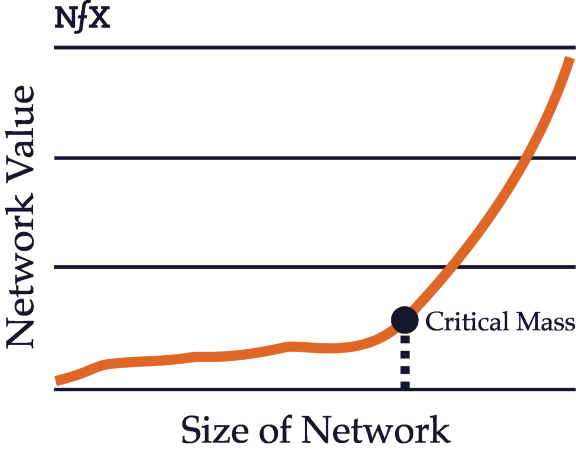
Network effects are an example of exponential growth.
Gutenberg’s printing press created a network of content creators and consumers which led to the proliferation of literacy. This network effect made printing and reading invaluable to society hundreds of years later. Similarly, Bitcoin’s network of miners, speculators, developers, and consumers are coalescing around a new technology that enables a true measure of value to be sent over communication channels. Just as Voice Over Internet Protocol (VOIP) dethroned long distance service providers, Money Over Internet Protocol (MOIP) will usurp the entrenched currency monopolies. Bitcoin is a decentralized communication network.
PERSPECTIVE
 Linear Perspective built upon principles of math
Linear Perspective built upon principles of math
Bitcoin is stored energy
Bitcoin is a base layer time chain
Bitcoin is digital time
This may be about more than money
It is possibly an immutable, universal reference point for ultimate objectivity.
Linear perspective drawing utilizes math to conceptualize reality. This advancement led to the proliferation of Renaissance art and architectural achievement. Similarly, the Hard Money characteristics of the Bitcoin protocol provide a stark contrast to the incumbent financialized whore house of today. This emerging resolution is providing a new perspective that many will use to build the masterpieces of our future.
The invention of Timepieces provided Renaissance-era scholars and explorers a new tool of precision and synchronization that revealed consecutive order effects like discovering North America and the Heliocentric reality. Bitcoin’s block sequence and consensus mechanism provide a digital beacon of relativity that new worlds can be aligned upon.
Time preference is the valuation of today relative to the value of tomorrow.
Perhaps the greatest aspect of seeing the world through the lens of a digital finite resource is the realization that our world is also finite. Mountains, streams, fresh air, and time with loved ones are limited in amount. It is with this framing that we understand that discipline and sacrifice today can lead to a better tomorrow. The Timepiece taught us precision; Bitcoin can teach us perspective. In Bitcoin we CREATE>consume.
A society grows great when old men plant trees whose shade they know they will never sit-in…. Greek Proverb
Don’t Trust……Verify
Transparency equals trust. Double Entry Bookkeeping provided the world with balance at a glance. An innovation that altered history through banking, sea exploration, and the theories of Physics. Bitcoin is a Triple Entry Bookkeeping system where all transactions are verified prior to entry through the consensus mechanism (peer review). Verification is the 3rd-degree element that has been missing in modern transactions. Bitcoin is the input, output, settlement, and audit all in one. Imagine the wonders that will be built on this trustless, transparent, settlement layer.
Cut out the Middle man
Prior to Gutenberg’s movable type printing press, church scribes were tasked with the translation and replication of books. This process was easily manipulated by revisionist agendas. In other words, even God’s word could be altered to meet the inclination of the scribes and their commissioners. The printing press enabled more accurate copies of text, in addition to the increased distribution and cost efficiency of information. Modern-day solicitors of information have become siloed and concentrated into a technocracy of censorship. Social network de-platforming and other attacks on freedom of speech have highlighted the digital information power hierarchy of Google, Facebook, Twitter, etc. In a world that is becoming less tolerant of controversial opinions, Bitcoin’s uncensorable communication network provides a non-negotiable constitution of code upon which information is unstoppable.
What about 2nd Generation technology?
A common argument against the long-term success of Bitcoin is that a newer, faster mousetrap will be designed that makes the first-generation Bitcoin obsolete. Bitcoin is less technology and more innovation.
Ideas can only be overcome by other Ideas.
Bitcoin is a new idea equivalent to the concept of placing an axel between two pottery wheels. Thousands of years later the wheel is still relevant. Flight, space travel and particle accelerators have developed alongside, however, the wheel still propels man today. Many innovations will be constructed on top of the Bitcoin base protocol. The infrastructure for Bitcoin’s future is currently being built, just as industrialists 200 years ago developed railways which provided utilility for the ideas created atop the wheel and axel.
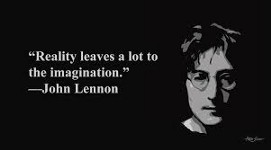 Imagine
Imagine
Today we find ourselves in a new world where the populace is forced to contemplate, question and recalibrate. For it is when we are made uncomfortable by the interruption of our habits that we begin to change. Curiosity and imagination are the main elements of creation. I posit that Homo Sapien’s superpower is to imagine and build his own future. An important question we collectively must confront is “Where do we go from here?”. Let the answer be Onward, with Life and Liberty, not by force, but by the powerful ideas of Freethinkers, Dreamers, Creators, and Pioneers.
Rediscover, Innovate, and Apply. Contribute your authenticity to the Rebels Renaissance.
Is Bitcoin Compatible with Banking?
Yes, but banking must be disintegrated
By Zane Pocock
Posted April 23, 2020
 Photo by Jason Pofahl on Unsplash
Photo by Jason Pofahl on Unsplash
In the past, banking served two distinct functions, typically operated by separate businesses: warehousing wealth and facilitating loans.
These services are immensely valuable and typically harmless on their own. But it was an integration of banking functions that ultimately cemented the normalization of today’s fractional reserve banking system, allowing for market distortions that gave rise to precarious debt-fuelled bubbles like the one we’re watching unfold right now. It thus incentivized a structural fragility that placed commercial banking in a position of outsized importance to the functioning of society. Banking used to be about providing services to the free market, not the centrepiece.
The instrument that was manipulated to conflate these two banking functions was commodity money — a cumbersome monetary technology that was inevitably centralized, captured and manipulated to the point that paper claims on it were no longer redeemable.
With its absolute scarcity, Bitcoin is positioned in stark opposition to the monetary and banking status quo, and can serve as the medium for a philosophical and practical resurgence against the fiat monetary paradigm. Further, it is designed with explicit provisions that can be programmatically harnessed to keep banking roles separate once again.
While I argue that the Bitcoin communication protocol should explicitly not be defined as “money” in the legal sense, its scarce information space has accrued value such that those who exercise control over some of it have inevitably sought solutions for its security and leverage (warehousing and loans). By understanding the history of traditional banking institutions and the unique features offered by Bitcoin, participants in the Bitcoin network can acknowledge the value offered by these services whilst being careful to harness Bitcoin’s assurances to continue separating these roles.
A Brief History of Banking
In his great treatise on money and money substitutes, Theory of Money and Credit, Mises demonstrated that fractional-reserve banking was the root cause of the business cycle, arguing that the issuance of uncovered money titles reduced the interest rate in the credit market below its natural level. If, for every dollar of silver held at a bank, the bank had issued two dollar bills with legal title to the one underlying silver dollar, then the circulating supply of money would have doubled. The law of diminishing marginal utility dictates a reduction in the relative demand for the new money and thus reduces the price that can be demanded for access to it (interest rates). Thus, businesses are likely to borrow beyond what they should (it’s cheap to do so), ultimately becoming overleveraged and misallocating resources before a market downturn corrects these inefficiencies.
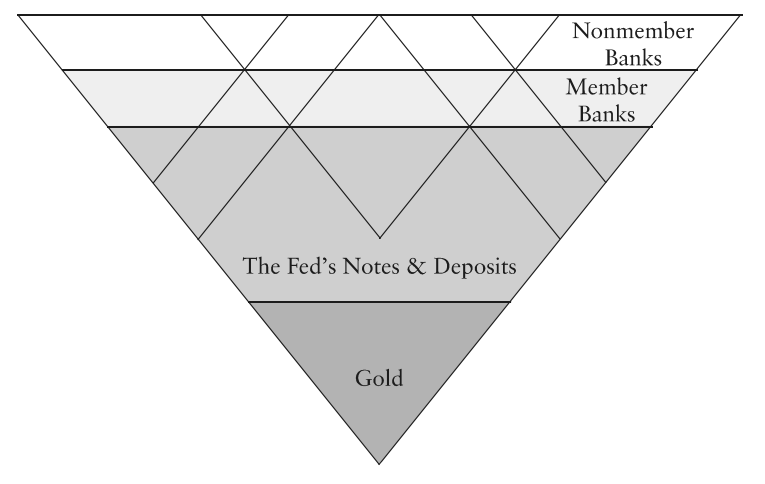 How money substitutes are inflated from an underlying asset (fractional reserves). Source
How money substitutes are inflated from an underlying asset (fractional reserves). Source
Mises’ student, Murray Rothbard, made the mechanics of this lesson more accessible to the layperson in his book The Mystery of Banking. Rothbard argued that it was thanks to the confluence of two distinct forms of banking that a fractional reserve banking system was able to flourish, ultimately creating the fiat paradigm we live under today. These distinct banking functions were those of deposit and loan banking.
A money warehousing business (a deposit bank) would offer centralized security services to safeguard monies in exchange for a fee paid by the customer. With commodity monies, the returns to violence are high — it makes economic sense for savers to employ a service responsible for defending against theft or loss. These commodity monies also suffer from inconveniences in divisibility and transportability, so another role of the deposit bank was to provide money substitutes (bank notes) that could be carried and exchanged more freely between participants in the economy, with those notes directly convertible to the real money (such as gold) held on deposit at a moment’s notice.
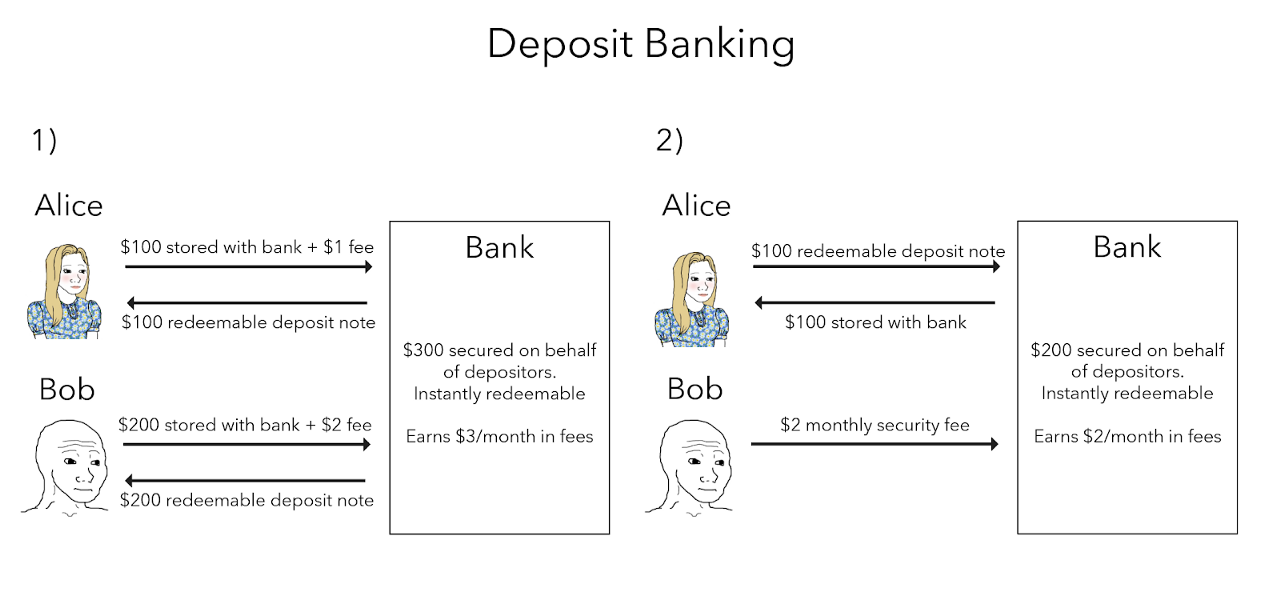
Separately, credit banking businesses, such as those observed in Venice in the Middle Ages and the Scriveners of 17th C England, might explicitly borrow money from depositors and pay them in the form of interest for the privilege and risk. These certificates of deposit would identify a fixed term; at maturity, funds would be returned to the creditor with an interest payment for taking on the default risk of loaning to the bank. The bank would make money by then lending these funds to other businesses and individuals, say for mortgages, charging a higher interest rate than they were paying to the initial client and pocketing the spread. Risk officers for the credit institute would ensure their debts reached maturity after the money they loaned out was repaid, thus remaining solvent.
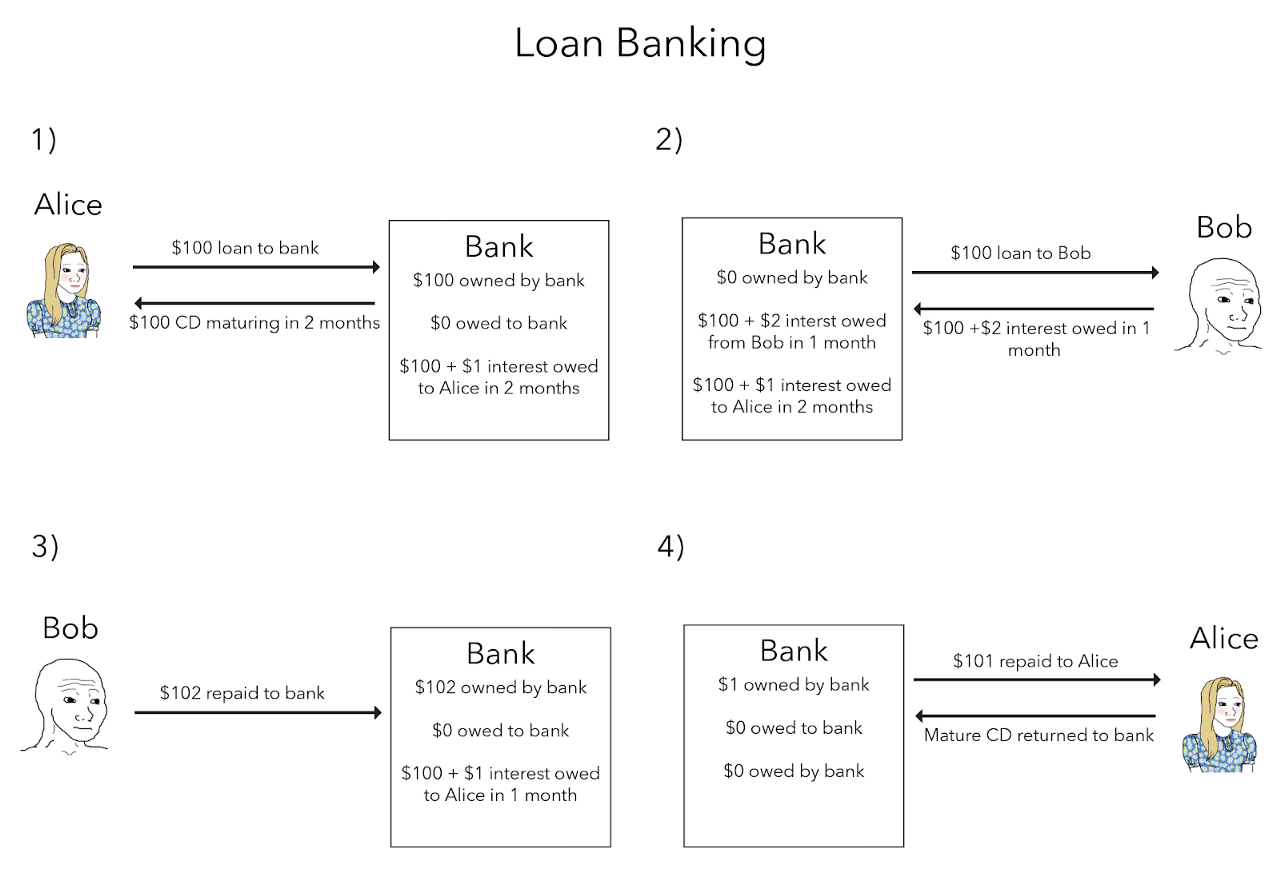
Rothbard’s insight was to acknowledge that both forms of banking businesses would fail occasionally, but that this was a good thing. Bank runs on deposit banks running fractional reserves would hurt defrauded depositors, for the institutions were effectively operating whilst insolvent. But such failures encourage greater due diligence and maintain the money supply in the long run by weeding these institutions out of the economy. Meanwhile, loan banking is explicit in its risks: there is a palpable chance that a credit institute might default if it mismanages its risk exposure. In simple terms, interest rates are the market rate for 1) buying current access to monetary instruments (the time-value of money) and 2) pricing their default risk.
Rothbard posits that a marriage between the two banking functions put an end to this age and was critical to today’s self-reinforcing cycle of fractional reserve banking, monetary inflation and central banking. He illustrates that central banks lifted the restraints on fractional reserve banking by putting a floor under the whole system that ultimately allowed for excessive credit expansion (printing money) before finally severing any relationship to an underlying asset at all (fiat money).
Legal paradigms
Another great work of economic literature was written on this issue more recently. Where Mises and Rothbard arrived at a discussion of banking by first analyzing how money comes to be used, Money, Bank Credit and Economic Cycles by Jesús Huerta de Soto starts with the two forms of banking before going on to derive the economic and legal implications of such a system.
Irregular deposits
De Soto argues that deposit banks dealing in fungible goods like commodity monies were dealing in irregular deposits, meaning that the same precise gold bar didn’t need to be returned to the depositor. Legal ownership of the specific gold bar was transferred to the bank on the proviso that gold of the same quality and quantity was available instantly to the depositor (ipso facto requiring 100% reserves) — the certificate of deposit was a fully covered money title.
What makes this important for the present discussion is by contrasting it with regular deposits, such as custody of an artwork. Irregular deposits technically transfer legal ownership of the gold to the bank while requiring that it remains fully covered, whereas custody of an artwork clearly doesn’t involve the transfer of ownership. This created a paradigm where the bank was held responsible even for an “act of God”. Thus the bank acted not only as a safekeeper, but the debt they owed to a depositor was so senior that the institutions came to serve as a form of insurance. This would be a moot point for custodying something non-fungible; a destroyed painting can clearly not be returned to the rightful owner.
If the institution is responsible even for black swan events, then the flaw in any form of fractional reserves is obvious: de Soto compellingly summarizes that “if the depositary has acted fraudulently and has employed the deposited good for his own personal use, he has committed the offense of misappropriation.” Thus, if an institution serving a warehousing role at any point does not have 100% reserves, it is comparable to a painting loaned to a gallery being sold by that gallery. The legal paradigm upholding this intuition existed until surprisingly recently: de Soto draws our attention to a decision by the Court of Paris in 1934 that convicted a banker for violating the expectation of 100% reserves.
Unfortunately, this rich history and legal precedent has been rendered trivial for now. The technical transfer of ownership involved in irregular deposits allowed for a dishonest play on definitions, with arguments successfully being made by legal counsel that conflated credit contracts (loans) and deposit contracts (warehousing) as essentially the same thing. These functions of banking are now joined at the hip.
Bailment
If uncovered money titles are the root cause of the business cycle, fraudulent, and enabled by contemporary banking structures, then in Bitcoin it will pay to strictly adhere to a different framework. Fortunately, the “not your keys, not your bitcoin” meme has lent prominence to a particular legal relationship for assets held under custody: bailment.
When an art collector lends a painting to a gallery, that painting is still the collector’s property. It doesn’t matter that the owner doesn’t currently exert possession or physical control over it. This is called bailment: when physical possession and control are handed to a third party, but the original owner retains legal title.
As Caitlin Long has been fighting for in Wyoming, legal recognition of a bailment relationship between depositors and a Bitcoin custodian is likely to be an important line of defense for those who need to employ the services of a custodian. Importantly, in a bailment relationship the asset never touches the custodian’s balance sheet, meaning a properly-written contract will ensure that rehypothecation is not legally possible in this scenario (where the custodian uses deposited assets as collateral against their own business loans). By extension, liens ought not be placed on collateral by the business’ debtors (where another party engaged by the custodian, such as an investor, might attest to seniority over assets under custody in a liquidation event).
Bitcoin Fixes This
Aside from correcting legal definitions, the Bitcoin protocol offers certain assurances that deserve far greater attention in conversations about its custody. Most importantly, if parallels between Bitcoin services and banking are to be found, it should be observed that Bitcoin natively offers tools that can be employed to explicitly delineate between custody and loans.
Bitcoin is a communication protocol, so it is helpful to first consider two distinct types of Bitcoin information: UTXOs and private keys.
UTXOs (unspent transaction outputs) encumber the protocol’s scarce information space. Think of the Bitcoin network as if it has space on a hard-drive, except instead of documents adding in size to 120GB, we have UTXOs adding in size to 21M BTC. When people say that there will only ever be 21 million bitcoins, what they mean is that there will only ever be a combined total sum of 21M BTC shared among all UTXOs on the network. It’s the information space encumbered by these UTXOs that has accrued market value.
Bitcoin UTXOs are scarce because one script, and only this one script, is locking up their value on the network. This script is unlocked by a corresponding private key. As far as the Bitcoin protocol is concerned, if one can resolve this script to the network by using the right private key, then they have the right to create a transaction with the UTXO. Because UTXOs are consumed in transactions (resulting in equally valued outputs at the other end), it is notable for our purposes here that they are best employed to explicitly transfer or lend this information space to a third party.
Private keys, on the other hand, are simply the secrets that allow this activity on the Bitcoin network. Because of the value that these secrets can be used to unlock, safeguarding them is imperative. These secrets can be known by a specialized third party offering certain assurances, much like a password manager, and thus they are well-suited to being “warehoused”.
Private Key Warehouses
In legacy finance, the role of a qualified custodian has typically been to safeguard legal title to financial products like securities. Perhaps because of confusion around what Bitcoin is, we have seen the emergence of institutions structured more like securities custodians than contemporary banks entering the space. Specialized custodians are explicitly aiming to fill the warehousing role, and they leverage the unique properties of the Bitcoin protocol to achieve this. At Knox, for example, there isn’t simply a big central storage unit and database of “bitcoins”. Customer UTXOs are encumbered by completely segregated private keys in an auditable multi-signature scheme, geographically dispersed and insured for the value of the UTXOs over which they exert control. The infrastructure is set up such that UTXOs can’t be unilaterally spent by internal operators–that requires the cryptographic authorization of the depositor that is in control.
The importance of this can not be understated. Whilst all Bitcoin participants should still be strongly encouraged to retain exclusive knowledge of their private keys, for many individual and corporate use-cases this is not practical. But warehousing private keys like this is not “reinventing banking” in the way detractors think it means.
Bitcoin private key warehouses (“custodians”) are tasked with occulting the knowledge of the private key that locks up the network value of their clients.
Given appropriate legal structures to ensure that keys are shared in a bailment relationship, technical assurances that these third parties cannot single-handedly consume UTXOs, and providing auditability through public addresses on the network, fractional reserves under such a system should not even be possible. At their most basic, these companies simply offer a private contract to keep a secret and occult their customer’s private keys. They’re security services for valuable, secret information with two major functions:
1. Act as a computational service provider
Apply signatures (information, text) with secret values (information, text) propagating the results of the computation (information, speech)
2. Act as a storage service provider
Hold onto secrets (information, text), to make 1. Possible
One of the reasons for using irregular deposits to custody fungible goods is that it’s impractical and prohibitively costly to return the exact same gold bar to its original depositor. But in Bitcoin, if it’s defined that the private keys themselves are what’s being shared, this is not only possible, but inherent to the system. While it is by no means trivial to provide these assurances and ensure rigorous key segregation, an advantage of Bitcoin’s digital nature quickly becomes apparent: once the methodology is defined and implemented, keeping private keys separate scales incredibly well, unlike a physical gold warehouse where costs would increase in lockstep with the number of customers.
Furthermore, Bitcoin participants shouldn’t trust that the services they employ are keeping these promises. While a certain segment of the Austrian school would argue to let a self-correcting free banking system simply run its course, we needn’t be so cavalier in Bitcoin. If a Bitcoin holder engages the services of a private key warehouse, auditable addresses should be demanded for the UTXOs that can be controlled by those keys.
In this context, Bitcoin’s apparent lack of fungibility (distinct UTXOs can be identified) is a feature, not a bug. Irregular deposits as defined by de Soto need not exist when we have a system that can functionally scale to segregate each customer’s private keys and addresses, while also being audited by the customer without needing to query the business’ servers.
Customers might also consider storing individual keys from a multi-signature wallet across different private key warehouses to provide an extra level of risk segregation assurance, thus requiring an incredibly complex, multi-party collusion to violate their expectation of safekeeping.
This is the technical, practical and philosophical beauty of multisig: it is consensus-enforced (non-simulated) shared ownership of a scarce asset. Until now, the concept of scarcity has described the exclusive usage and ownership of a given good by a specific individual. If someone is holding the only axe in the village, another can’t hold the same axe at the same time. It is scarce. There can be private contracts that simulate shared ownership amongst many peers, but these are not inherently enforceable, as any party can cheat. Thus, we need legal systems to punish such cheaters after the fact. Bitcoin, however, enforces this shared ownership in its very protocol, to such an extent that Max Hillebrand argues it is no longer simulated, but actual shared ownership. Of course, all of this is under the assumption that the right people keep their secrets safe.
With the fundamentals established, these assurances can be extended to services where Bitcoin is posted as collateral against a fiat loan. Obviously, a customer posting collateral can’t retain exclusive control over the asset — for example, the service might be forced to liquidate based on certain predefined scenarios. But there are interesting models such as Unchained Capital’s collaborative custody, where collateral posted against a loan is held in a 2-of-3 multi-signature scheme. Unchained Capital holds one key, another is with a third-party key agent (Citadel SPV), and the customer holds the final key. An auditable address for collateral is derived such that the customer can keep an eye on it, and having multiple parties involved can offer certain assurances. The third-party key agent must verify that a liquidation event is legitimate before Unchained Capital can claim those assets, while the customer can also work with the key agent to have collateral returned in the event that Unchained Capital fails or is otherwise unavailable. Remember, the business model for collateralizing loans ought not to be lending collateral back out as if the bank owns it: the model is instead to earn interest on the fiat loan. The collateral can simply be seen as insurance against default, and multisig schemes can be used to enforce this.
One final note: another reason for the deposit banks of old was for scalability. Bank notes served a legitimate use-case for divisibility and transport in a commodity money system. While there’s no guarantee for future scaling, the Bitcoin network doesn’t yet need the financial intermediary role of a money substitute, and it is hoped that the Lightning Network Protocol or a future protocol layer will provide this scalability that banknotes once provided without needing to derive centralized substitutes.
UTXO loan-banking
A clearly distinct class of financial infrastructure has also emerged in the early financialization of Bitcoin: interest-bearing accounts. If someone sends UTXOs to Ledn on the promise of earning a 3.6% return, it should be distinctly understood that the legal title to the information space encumbered by those UTXOs no longer belongs to the depositor. Rather, Ledn exercises property rights, ownership and control, with a debt owed to the depositor and interest paid out as a fee for the privilege.
As in historic loan banking, these UTXO loans function largely as you’d expect. There are typically term requirements for the deposit (the depositor can reclaim possession of the information space after a month or longer), and it is understood that the depositor is taking on the default risk of the company with which they hold this interest-bearing account.
If there is any gripe with this model, it ought to be in the marketing. Often, these products are implicitly marketed to help Bitcoin holders “start saving”. Where the loan banking model explicitly carries more risk than one would expect from a contemporary bank account (e.g. there is no lender of last resort and no FDIC-style depositor insurance in Bitcoin for now), it’s a savings account at a traditional bank that this market positioning brings to mind. To be blunt, these loans are more like an investment in the default risk of a fintech startup, while “saving” in the Bitcoin paradigm is a term best suited to securing private keys. After all, the supply cap of Bitcoin theoretically means that the purchasing power of UTXOs is preserved, unlike in the inflationary fiat paradigm where purchasing power is systematically diminished and investment is required simply to save. That aside, the fact that this loan structure has emerged clearly separated from the role of private key warehouse is welcome.
Subversion of Bitcoin
Having spelled out the features that Bitcoin offers its network participants, now isn’t the time to be complacent. Note that some companies are, indeed, engaging in practices that might simply recreate the trappings of the legacy financial system. Individual caution is needed.
I have written in the past about my thoughts regarding BlockFi, for the company appears indifferent to the opportunities of the Bitcoin protocol put forward in this article. BlockFi’s interest-bearing account is very high risk, but this is transparent enough and one might have few qualms with that (an 8.6% return on some deposits should be the only market indicator you need to establish this conclusion).
What might be worth more consideration in the context of the current thesis is that Blockfi also offers a bitcoin-collateralized loan. Presumably, one might expect the company to hold the Bitcoin collateral in an auditable, segregated wallet under a bailment relationship — as with Unchained Capital, you’d expect that their business model is to earn interest on the fiat loan being repaid while safely custodying the UTXOs posted as collateral. Alas, the UTXOs held under both the interest-bearing and collateralized schemes appear to be commingled and the company reserves the right to rehypothecate — that is, Bitcoin posted as collateral can be re-lent by BlockFi as if it were theirs, exposing depositors to additional counterparty default risk. This is very much akin to the contemporary banking system. The market is the great arbiter of such trade-offs, but given the assurances offered by the Bitcoin protocol it might be considered that competitors provide better assurances in the way they handle collateral.
Bitcoin Can Work With Banking
As most would have expected, it’s becoming very clear that Bitcoin is being financialized at a rapid rate. Fortunately, the nature of something truly scarce means that fractional reserves can not be sustained for long. Whether by design or accident, such schemes will tend to be discovered and collapse in the absence of a lender of last resort. But while this secures Bitcoin against any systemic risk — blocks will still be mined every ten minutes, oblivious to what participants do with it — such failures can cause a lot of suffering to those defrauded by them.
Bitcoin offers assurances that ought to be harnessed by alert network participants to ensure the safety of their holdings. By forcing a segregation between services akin to deposit banks (custodians) and loan banks, and demanding certain verifiable assurances from both, these services and participants alike can thrive while supporting the early financialization of Bitcoin and avoiding the trappings of Wall St. Both of these banking functions, with their different risks, are likely necessary for the ethical financialization of Bitcoin, so long as one remains alert.
Special thanks to Max Hillebrand, Ben kaufman and Ben Prentice for review and guidance, Stephan Livera for pointers and as always Thib and Daskalov for brainstorming, support and reviews.
Knox is working on the ethical financialization of Bitcoin with a focus on private key custody. If you would like to know more about how Knox can support the security of private keys, attempt to poke holes in our model or otherwise hear more, please reach out and speak to our team!
Issue #723: Take action. Bitcoin is a vote.
It’s time to stop complaining with your voice about your current plight.
By Marty Bent
Posted April 23, 2020

My mother has been a bit taken aback by the tone of this rag so far this week, so I figured I’d take today to dial it back a bit and focus on the positive side of things and focus on how Bitcoin can help individuals combat the encroachment on civil liberties and individual critical thinking.
As Ben Hunt pointed out on TFTC earlier this week, the solution to the system of institutional betrayal cannot be solved with an election. Voicing our opinions via a vote in a presidential election does not make sense any more. The options we are force fed are simply illusions of choice put forth by the establishment oligarchic empire. Meet the new boss, same as the old boss. Getting one’s hopes up for hope and change or making the land great again are pipe dreams. The system cannot be fixed from within. It is simply too far gone.
The only way out is just that, to see ourselves out. To exit this system of corruption and rot. Individuals the world over need to come to the logical conclusion that there is no other way. They must build and transition to new systems that are completely separate from the captured system they are subjected to.
Bitcoin is an example of one of these systems that allows us to take action and exit the system. It is a system that cannot be controlled by the institutions that have brought our world to the brink while plundering the masses for the benefit of a very small group of people. They cannot tinker with the levers that make Bitcoin work as they can tinker with interest rates and the monetary base. NO ONE can tinker with the levers of bitcoin. It would take everyone within the network to tinker with its levers. Creating and inherently fairer, more just system. The best part is, individuals are able to vote 24/7/365. The exit ramps to this new system have been constructed and more are popping up every day. Each exchange that is erected and each merchant that begins accepting sats for payment of goods and services increases the ability of the masses to exit a corrupt system.
Even better, the new system that Bitcoin represents is getting better every day. It is becoming easier to use this new system. The number of things one is able to do with a UTXO is increasing. The number of people helping to build it out across all layers is continually increasing. All the KPIs are improving drastically as the prospect of Bitcoin’s success is becoming more obvious by the day. This new system has a lot of potential.
It’s time to stop complaining with your voice about your current plight. It has become glaringly obvious that this has absolutely no effect on the outcomes of the machine we are currently beholden to. It does what it wants no matter how loud you yell. Walk away. Come help build the peer-to-peer system of the future. You can do this by deciding to store some of your wealth in bitcoin.
Fix the money and you fix the world.
Bitcoin is a Catalyst for Human Evolution (Symbiosis) — Part 4/4
Exploring Bitcoin through the lens of natural selection, evolution, and symbiosis
By Brandon Quittem
Posted April 24, 2020

This is a story of how symbiotic relationships can change the course of history forever.
Just as fungi and plants formed a symbiotic relationship to successfully colonize dry land, humans can form symbiosis with Bitcoin to improve individually and to advance our species.
In this article we’re going to explore Bitcoin as a catalyst for human evolution, through the lens of geological timescales, evolution, and symbiosis.
Definition of Symbiosis: when two dissimilar organisms live together in intimate association (as in parasitism or mutualism). Example: Clownfish and Sea Anemones
This is part 4 of “The Mycelium of Money,” here’s the whole series for reference.
- Part 1: Bitcoin is a Decentralized Organism (Mycelium)
- Part 2: Bitcoin is a Social Creature (Mushroom)
- Part 3: Bitcoin is the Antivirus to Uncertainty (Medicine)
- Part 4: Bitcoin is a Catalyst for Human Evolution (Symbiosis) → this one
Let’s begin.
Bootstrapping Life on Terra Incognita
Five hundred million years ago, all biological life lived in the oceans. Dry land as we know it was a sterile volcanic wasteland devoid of life. That is, until plants and fungi formed a fateful partnership that changed the course of history forever.
This symbiotic partnership created a cascade of evolutionary forces leading to the creation of all terrestrial life, including homo sapiens.
Fast forward to modernity, humans now organize around network based technologies, such as the internet and Bitcoin, which are reincarnations of the ancient mycelial archetype out of which we emerged.
Take a deep breath. Life is amazing.
Ok, so how did we get here?
First, a quick biology lesson. Organisms are classified as either Autotrophic or Heterotrophic.
Autotrophs are organisms that make their food. For example: plants convert sunlight and carbon dioxide into food via photosynthesis.
Heterotrophs are organisms that find their food. For example: lions eat the gazelles and fungi produce enzymes to externally digest their environment.
Like human settlers, organisms colonizing new territory are most vulnerable in the early days. In order for fungi to colonize dry land (terra), they needed to secure a reliable food source.
Fungi effectively domesticated photosynthesis machines (algae) to harness a self sustaining food source. We can think of these algae as little solar panels bolted onto fungal networks which made colonizing virgin dry land possible.
Soon after getting established, the fungi began digesting the volcanic rock upon which they sat. This ultimately liberated valuable nutrients which were then traded with other nearby fungi, algae, bacteria, etc. Together, these early settlers bootstrapped life on dry land. Let’s see how this compares to Bitcoin.
How Satoshi bootstrapped embryonic Bitcoin
In order to colonize the internet (terra incognita) with a new form of money, Satoshi needed to form a symbiotic partnership.
Fortunately, he found the perfect partnership and made a series of wise decisions that maximized Bitcoin’s chance of survival during the bootstrapping phase.
How satoshi “partnered with the algae” to bootstrap Bitcoin’s life on the internet
- High early issuance rate disproportionately rewarded early adopters (the early issuance rate might have been _too _aggressive)
- Launched on the Cryptography mailing list (if anyone could incubate Bitcoin it was the Cypherpunks on that email list)
- Timing the launch during the 08/09 financial crisis (was this blind luck?)
- Satoshi’s message in the genesis block “Chancellor on the second brink of bailout” (rallying cry to gain ideologically motivated supporters)
Mutualism or Parasitism: Examining the Cypherpunk-Satoshi-Symbiosis
Were the algae complicit in the fungal partnership (mutualism)? Or were the fungi taking advantage of the algae’s ability to make food at the expense of the algae (parasitism)?
It appears to be mutualism. The algae may have been initially kidnapped, however in exchange for photosynthesizing, they gained a mycelial security system, and the opportunity to colonize a new niche.
Were the cypherpunks complicit and did they benefit in the partnership (mutualism)? Or did satoshi take advantage of the cyberpunks because he needed an initial distribution strategy (parasitism)?
“It’s very attractive to the libertarian viewpoint if we can explain it properly. I’m better with code than with words though.” — Satoshi Nakamoto
Most cypherpunks dismissed Bitcoin initially, however a select few (most notably: Hal Finney) jumped onboard. Considering they were first to learn about Bitcoin, they had a chance to acquire Bitcoin’s native monetary units in exchange for the marginal electricity cost to mine (essentially nothing). With the advantage of hindsight, acquiring Bitcoin during the first few years would lead to wealth beyond measure.
“The possibility of generating coins today with a few cents of compute time may be a good bet, a payoff of something like 100 million to 1!” — Hal Finney
(Economic) Evolution by Natural Selection
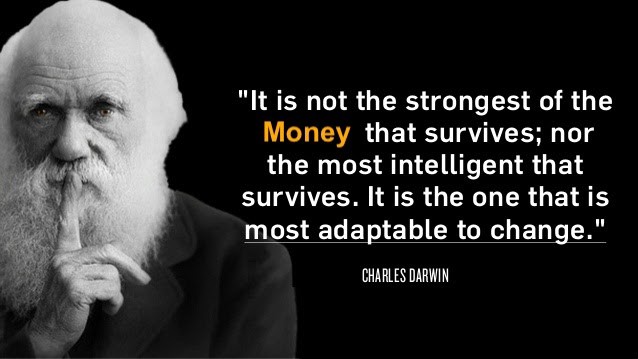
With the initial conditions of life on land set into motion, the fungal-plant alliance can start welcoming new market participants (organisms) to enter the ecosystem.
Fungi interact with the world through chemistry. They secrete enzymes to externally digest their environment. Volcanic rock was the only restaurant in town. These early fungi liberated molecular resources by metabolizing the volcanic rock upon which they stood.
This enabled a proto-economy made up of primitive fungi, plants, and bacteria. They traded essential molecules required for carbon based lifeforms (carbon, nitrogen, oxygen, etc).
Fungi were essentially turning rocks into fungible biology tokens. These biology tokens were then traded on top of mycelial rails connecting all nearby life. Fungi both created the market and facilitated trade leading to an explosion of biodiversity on dry land.
Terra takes her first breath
Before plants colonized dry land, our earth’s atmosphere wasn’t very hospitable. As you know, plants inhale CO2 and exhale O2. This ultimately led to the formation of our oxygen rich atmosphere — planet earth was taking her first breath.
In a sense, fungi unleashed free market dynamics in a new market which led to an incredible proliferation of life. Now let’s explore the parallels with Bitcoin.
Bitcoin enables a new economic paradigm
Just as novel organisms emerge (via speciation) to occupy newly created niches on dry land, Bitcoin evolves it’s DNA (code) to produce new phenotypes (novel features) to take advantage of new niches.
In other words, Bitcoin enables novel financial use cases that were not possible before. This increases the size of the economic pie, thus generating wealth for society.
Novelty provided by Bitcoin:
- The first and only implementation of absolute scarcity (hard to overstate)
- A global, near instant, apolitical, settlement system
- Neutral money not easily captured by special interests.
- Uncensorable medium of exchange for black/grey markets
- Democratization of basic financial services
- Non-sovereign store of value with negligible barrier to entry
Bitcoin and mycelium improve trade
Mycelial networks act as a resource transport layer and communications network connecting organisms in the biosphere. This enables organisms to voluntarily trade resources and knowledge across species lines. Increasing trade leads to increased specialization (division of labor), further increasing biodiversity (wealth and resilience) in the ecosystem.
Currently, our governments form economic monopolies which prevent many citizens from accessing the global markets.
Think about all the unproductive human capital siloed in countries like Iran, Venezuela, and Argentina. Without access to a common economic language (Bitcoin) many people are unable to participate in global trade.
As Bitcoin becomes ubiquitous, it unleashes human productivity leading to increased innovation, specialization, and trade. We’re already seeing some basic examples such as freelancers in Venezuela using Bitcoin as a bridge currency to access USD which effectively evades financial controls.
We can extrapolate “Bitcoin being used as a bridge currency” into a grander vision of the future where everyone speaks the same economic language. A global market for talent leads to more goods and services produced for a cheaper price. Not to mention, increased trade with developing countries will help lift people out of poverty.
Bitcoin enables economic evolution by natural selection
Darwinian evolution by natural selection is a biological engine designed to reward successful actors and eliminate unsuccessful actors. When the antelope gets eaten by the lion, it dies, no one bails out the antelope. Nature has skin in the game. This feedback loop is crucial. Individuals are fragile in order to ensure the system is antifragile.
Market based economics is an engine designed to seek more efficient uses of capital by rewarding successful ventures and punishing the unsuccessful. However, our current form of “capitalism” is more like cronyism or as Travis Kling said: “socialism for the rich.”
Instead of letting companies fail, we bail them out. This results in broken incentives which create a moral hazard making the entire system more fragile. Not to mention, disproportionately hurting the working class. Heads I win, tails you lose.
A sound money system (like Bitcoin) improves this economic engine by tightening the feedback mechanism that rewards value creation and punishes failure. In a Bitcoin world, bailouts aren’t really possible because monetary expansion is restrained by a fixed monetary base. Bitcoin ensures individual people/companies are fragile in order to ensure the economic system remains antifragile.
In other words, Bitcoin increases economic “skin in the game” which improves the feedback loop leading to economic evolution by natural selection. Economic Darwinism for the win.
Taming of the Tenrec

Due to a symbiotic relationship with fungi and plants, and evolution by natural selection, our pale blue dot was transformed from a barren rock to the garden of eden. Truly marvelous.
Let’s zoom in to the tail-end of the Cretaceous period (~65 million years ago). The planet was dominated by dinosaurs both on land and in our oceans. Mammals were hardly relevant. Narrator: but things were about to change.
A giant meteor crashed into present day Mexico ending the dinosaurs and most life on planet earth. The impact caused a short term spike in surface temperatures followed by an extended cooling due to debris blocking out sunlight.
Although most organisms were culled during the cataclysm, some species thrived during the chaos. Most notable for our story are Fungi (of course) and a small shrew-like mammal known as the Tenrec (surprising).
Without sunlight, most plants quickly perished. However, the Fungi thrived because they don’t rely on sunlight (remember they find their own food). Fungi were happily decomposing all the newly deceased organisms.
What about the Tenrec?
As temperatures declined and food became scarce, most animals who survived the initial shock were killed by fungal pathogens or eventually starved to death as the global food chain seized up. However, not the Tenrec.
Tenrecs are humble shrew like mammals that lived underground which protected them from hostile conditions on the surface. Their favorite foods (insects and aquatic plants) were relatively unaffected.
Tenrecs are capable of hibernating for up to 9 months at a time. This protects them from short term volatility and enables them to outlast their competition. The best offense is a good defense.
Bitcoin reminds me of the tenrec, both live underground and thrive on volatility. Like the tenrec, Bitcoin simply needs to outlast it’s competition.
“If you wait by the river long enough, the bodies of your enemies will float by.” — Sun Tzu
Give thanks to the tenrec
Turns out, the tenrec is the common ancestor to all living placental mammals. In other words, the only reason both you and I are alive today is because the tiny tenrec survived the dinosaur-ending apocalypse 65 million years ago.
Standing on the Shoulders of Mycelium
Although mammals got off to a slow start, we’ve really come into our own over the last million years. One particular great ape, the homo sapien, achieved global dominance in a relatively short timespan.
Current evidence suggests Humans have only been around for about ~500k years, making us a relatively young species. For comparison, modern elephants have been around for ~5m years.
Like our fungal forefathers, humans have formed symbiotic relationships with our environment throughout history. In fact, we owe our lives to the networked based organisms we call fungi.
Humans begin to settle down
One especially relevant fungal organism is Saccharomyces cerevisiae, otherwise known as brewers yeast.
Human agriculture appears to have begun around 11,500 years ago (although it might be much older). Interestingly, the first crops we cultivated were also the best grains for brewing beer. This begs the question: did we settle down for food/stability or to brew more beer?
Turns out fermented drinks (beer, wine, etc) provided a safe way to stay hydrated as water often contained pathogens that killed ancient man.
Although we didn’t know it at the time, humans formed symbiotic relationships with fungi in order to produce healthy drinking options that saved many lives.
Unbeknownst to most moderns, we still heavily rely on our fungal allies today. Without fungi, say goodbye to all beer, wine, chocolate, bread, and many medicines such as penicillin.
Like ancient man partnered with fungi to survive, us moderns have a similar opportunity to partner with Bitcoin…
Achieving Symbiosis with Bitcoin
We’ve established how both fungi and Bitcoin symbiotically partner with other organisms to bootstrap life and build antifragile ecosystems. Now let’s finish up by exploring how humans can partner with Bitcoin to improve individually and to advance our species.
“The real problem of humanity is the following: we have Paleolithic emotions; medieval institutions; and god-like technology.” — E.O. Wilson
Money is the most important coordination mechanism for society and our existing fiat system is driving our species off a cliff. Instead of arguing red vs blue, it’s time we address the root cause of our societal malaise. It’s time to unfuck the money.
Fiat money has appeared periodically throughout history, however, it’s the exception not the rule. Throughout most of history, humans coordinated around a free market for money. Gold and silver, mainly. Time to wake up from our fiat money coma.
Bitcoin is an Extended Phenotype for humanity
Extended Phenotypes are behaviors that extend an organism’s natural capabilities. Beaver dams are a good example. Bitcoin is an Extended Phenotype for humanity — it lowers the trust required for a global society to communicate value, which enables more sophisticated cooperation.
This offers a unique opportunity to re-architect society based on the separation of money and state aka “natural money.” A huge win for humanity. As such, it’s our duty to form symbiosis with such a force.
Take another deep breath as we’re fortunate to be alive during such an inflection point.
It all starts with individuals forming symbiosis with Bitcoin
Bitcoin was the best performing asset of the last decade. This created unimaginable wealth for early adopters. Besides financial gain, individuals also can benefit from bitcoin in other ways. Interestingly, the values imbued into bitcoin seem to rub off on its adherents.
As a deflationary asset, Bitcoin teaches us to delay consumption today in order to reap greater benefits tomorrow (low time preference).
In a world fulfilled with uncertainty, Bitcoin provides something to be optimistic about. Rather than change the system from the inside, we can put our energy towards a parallel system.
Bitcoin forces us to take personal responsibility for our wealth, both a blessing and a curse. In a world that doesn’t value personal responsibility, Bitcoin serves as a wakeup call.
Partnering with Bitcoin is good for the individual but is it good for mankind?
Cryptography is fundamentally about defense
Bitcoin is the largest implementation of public key cryptography the world has ever seen. A world with strong cryptography shifts the balance of power towards defense. Defense from tyranny, censorship, overarching governments, and surveillance capitalism.
Cryptography allows us to assert our natural rights. Bitcoin protects free speech, ensuring we can “vote with our money.” Free speech is the foundation of open societies. Forming symbiosis with Bitcoin preserves freedoms for our future generations. A cause worth fighting for.
Bitcoin metabolizes fiat infrastructure
We can use fungi to clean up oil spills, halt erosion, create natural pesticides, and even decompose nuclear waste at Chernobyl. In a similar manner, Bitcoin can be used to clean up our dilapidated fiat infrastructure.
Fungi Fact #1: Fungi have already solved many of our problems, yet we barely understand them. Mycoremediation is a promising new field that leverages our understanding of mycology to improve our environment, essentially “applied mycology.”
We’re experiencing a period of unprecedented monetary expansion. Bitcoin as a fixed supply monetary good serves as a counter force to unfettered money printing. Short term, individuals using Bitcoin to avoid capital controls and hedge against local currency risk. Long term, Bitcoin may force conservatism onto central banks, starting with developing nations.
In the richest country in the world (America), average people work for 40 years and never get ahead. The legacy system was designed to siphon wealth from the bottom to the top, most notably during each financial crisis. Since time is money, this forced wealth transfer system should be considered systemic time theft. Make no mistake about it, we should be radicalized by this.
Every time you buy Bitcoin you’re selling dollars. It’s time to join the peaceful revolution. Occupy UTXOs.
Opportunity cost of delaying Bitcoin
Think of all the waste created from a fiat system. Bank bailouts, never ending wars, and capital misallocation are greatly reduced (if not eliminated) under a hard money system.
Each year we delay, we incur increasing opportunity costs. Instead of destroying wealth unnecessarily, how can we invest precious capital into worthy causes?
“We were promised flying cars and all we got was 140 characters” — Peter Thiel
What about colonizing mars? Or reducing the risk of civilization “enders” such as pandemics or nuclear war? How about dyson spheres? Asteroid mining? Or eliminating infectious disease and infant mortality for good?
Let’s embrace the Bitcoin renaissance.
Bitcoin wears risk on its sleeve
Rather than persist in an opaque financial system designed to enrich the few at the expense of the many, let’s embrace a more transparent financial system. A system where risks are laid bare for all to see, rather than buried under bureaucracy and deception.
Fiat money is an inorganic system similar to a monocrop industrial farm. Centrally planned, susceptible to disease, unsustainable, and fragile. Fiat offers short term price stability, at the expense of long term systemic risk. In other words, we don’t account for the “fat tail risks” such as banks blowing up or global pandemics. Both examples lead to wealth transfer furthering wealth gaps.
Bitcoin, on the other hand, is an organic system similar to an old growth rainforest. Fierce competition, incremental growth, sustainable, and antifragile. Bitcoin accepts short term price volatility in exchange for long term systemic stability.
Bitcoin enables an antifragile monetary system, a huge win for humanity.
Bitcoin promotes energy independence
Bitcoin has an insatiable demand for low cost energy. Miners scour the earth for cheap energy assets, acting as the energy buyer of last resort. This incentives innovation in low cost energy production such as excess natural gas and stranded hydroelectric.
Hash rate has been steadily rising, even when price is not. Bitcoin miners are inherently long BTC. What do the miner’s know that you don’t? Rather than putting our heads in the sand, it’s time to form a partnership with reality.
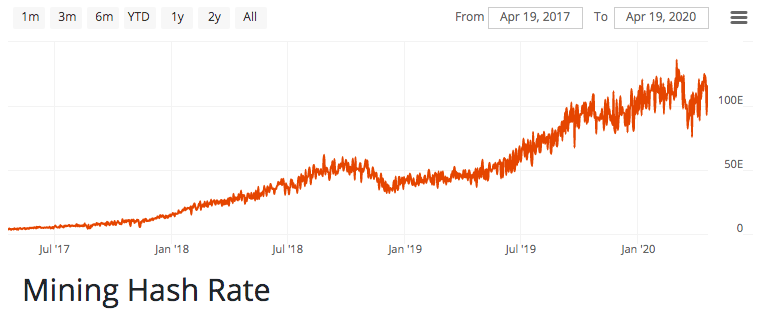
Let’s assume Bitcoin continues it’s monetization path. Eventually, Bitcoin mining becomes a matter of national security. Those countries who produce their own energy (and mine Bitcoin) will have further geo-political advantage over countries reliant on importing energy.
Fungi Fact #2: fossil fuels (hydrocarbons) carry the energy of ancient sunlight originally captured by plants through photosynthesis. Interestingly, earth’s entire supply of coal was formed during the “carboniferous” period which ended ~300m years ago when fungi learned how to digest lignin. Lignin is the polymer that gives plants their rigid structure AND it’s a prerequisite to forming coal. Coal is simply plant material that was “half-digested” by primitive fungi. Modern fungi digest lignin which prevents new coal from being produced.
This creates another incentive for nations to secure local energy sources — whether from fossil fuels, nuclear plants, renewables, or otherwise. Long term, a world with more localized energy production is a more robust world. Like fungi, Bitcoin is an invisible membrane improving the health of the ecosystem it occupies.
Humanity will coalesce on neutral money
The current geo-political game rewards those who exert influence over money production. This means large powerful states, politicized money, and special interests groups competing for influence.
“Give me control of a nation’s money and I care not who makes the laws.” — Mayer Amschel Rothschild
Instead, Bitcoin is a neutral money. A system designed to prevent special interests from exerting undue influence over the money. This creates a more fair game.
Why would any government give up control of their printing press?
In a post-dollar regime, nation-states won’t agree on a new reserve currency. Logically, each state prefers to settle debts in their own currency. We’re already seeing cracks in the dollar hegemony coming out of places like China, Russia, and Iran. Bitcoin is well suited for this problem.
Bitcoin is fully auditable, hard capped, and offers final settlement quickly. The perfect neutral money for untrusting nation-states to settle debts. Under this light, Bitcoin is money for enemies.
It’s time to upgrade humanity by forming symbiosis with Bitcoin.
Let’s Wrap Up
The story of life on earth can be summed up as: success comes to those who form symbiotic relationships with network based organisms (particularly fungi).
As humble apes, it’s our duty to form a symbiotic relationship with Bitcoin. We must strive to understand this phenomenon so that we may shepherd her through adolescence.
Just like fungi colonizing dry land was the catalyst for biological evolution on terra, Bitcoin is a catalyst for human evolution.
Let’s embrace Bitcoin or suffer the fate of the dinosaurs.
Thank you, Brandon
Let’s Connect: Follow me here on medium, check out BrandonQuittem.com, and come say hi on twitter.
P.S. Who’s driving the ship?
Fungi enabled complex life on earth, which eventually gave way to humans. Now humans are creating the internet (and Bitcoin) which both embody the same mycelial archetype of which we came.
We didn’t consciously choose to mimic mycelial networks in these designs. However, animals did taxonomically branch off from fungi millions of years ago. Humans came full circle, the student became the teacher.
Was this inevitable?
The mycelial archetype appears to be embedded into our species. Over time, network based structures continually appear whether due to embedded wisdom or blind luck. These Mycelial inspired network technologies, once discovered, seem to persist due to their antifragile nature.
Many people claim we “discovered Bitcoin.” I’m sympathetic to this idea, however it’s more accurate to say we _re_discovered Bitcoin. The mycelial archetype is an emergent property of biology which means Bitcoin was inevitable.
Acknowledgements
- Thanks to Gigi, Robert Breedlove, and Nic Carter for providing thoughtful notes during the editing process
- Thanks to the mycological community for inspiring my fascination with fungi (the bitcoin community welcomes you)
Humans Can’t Be Trusted To Govern Over Our Money
By Nik
Posted April 24, 2020
 Trust code, not governments.
Trust code, not governments.
Introduction
The importance of the separation between money and state today has never been more critical to the human race when it comes to our freedom. Even Coronavirus has struck fear into the masses and has them begging for big government to take away their freedom for “security”. Not only were they previously striving to take away our freedoms for more control, but this situation now gives them the green light to ruthlessly rule over us in any way they want. Our freedom is slowly dwindling and fading away, but there is hope to take it back.
Throughout the year’s governments all over the world have taken complete control of their citizens by changing and creating the perfect currency that benefits them as the cost of their citizens. And that currency is their fiat national currency (USD, GBP, Euro, Yen, etc). Ever since the gold standard ended in 1971, governments have been in control of currency issuance, what they deem as money, censoring people’s transactions, and more. If you control the money, you control the people; it’s as simple as that.
There is a severe lack of financial education amongst the masses, with many even still thinking that the US Dollar is backed by gold. This has been a common issue for ages with even Henry Ford saying “it is well that the people of this nation do not understand our banking and monetary system, as if they did, I believe there would be a revolution before tomorrow morning”. The legacy financial system is something our founding fathers and other great American legends would be extremely disappointed in. Bitcoin fixes this.
How Does Bitcoin Fix This?
 Who would win: a complex financial system that’s run by all governments in the world or, some Japanese guys’ math project?
Who would win: a complex financial system that’s run by all governments in the world or, some Japanese guys’ math project?
Humans are greedy, code is pure. Once the Bitcoin code was programmed and put into place, that was it. Game over for the legacy system. We can’t change it and honestly, that’s the beauty of it. Because no one is essentially in charge of Bitcoin, there is no room for corruption. The Bitcoin blockchain runs like clockwork producing blocks about every 10 minutes, and everyone with a full node can confirm this claim. Gone are the days of corrupt bankers, politicians, and government officials. Under a Bitcoin standard (with great infrastructure) we have the perfect shot at separating money and state.
This has the potential to increase wealth distribution, as in corrupt government officials and politicians will not be getting their outrageous big pay. Why? Because the people of said country are defunding them with Bitcoin, keeping more for themselves and keeping it in their communities. It’s going to take a while, but eventually, it’s going to be extremely hard and near impossible to tax people. obviously resulting in people keeping their hard earned money. And the general public will thrive. IMO though in countries where you don’t have the right to bear arms, things, things could get ugly.
Bitcoin also has the potential to take your financial privacy to a whole new level. Holding your coins in a cold storage wallet after coinjoining is a great start, but can improve. After coinjoining the government can prove you bought the Bitcoin (if boughten from a KYC exchange) BUT they cant prove you still have ownership over those coins. This is massive and very important is one’s freedom as it makes it that much harder for governments to confiscate. Because you are NOT free in using a financial tool that any central authority can come and take. More development needs to be done to reach a fully private Bitcoin world, and after looking at core developers, the future looks bright!
Incompetent Leaders
 Steve Mnuchin right here.
Steve Mnuchin right here.
The leaders of our monetary system have proven time and time again that they are not fit to be in charge, so who is? Nobody. Humans have proven time and time again no matter how good hearted they may seem, greed will always be their downfall. Eventually, our leaders always let us down in some way. This does not justify and wrongdoing, but that’s how humans are. We are not perfect, we make mistakes, we’re greedy, and we put ourselves and loved ones first before others.
These and more are all reasons why we are unfit to rule over our money. No matter who we put in charge, we will witness the same outcome time and time again. I constantly think about why these idiots are put in charge to rule over everyone’s finances, they’re so out of touch with reality it’s crazy. Don’t believe me? Watch this video where he says he thinks American citizens can survive on a $1,200 stimulus check for 10 (yes ten) weeks. People’s rent alone for a 1 bedroom apartment in my area costs $1,500 per month.
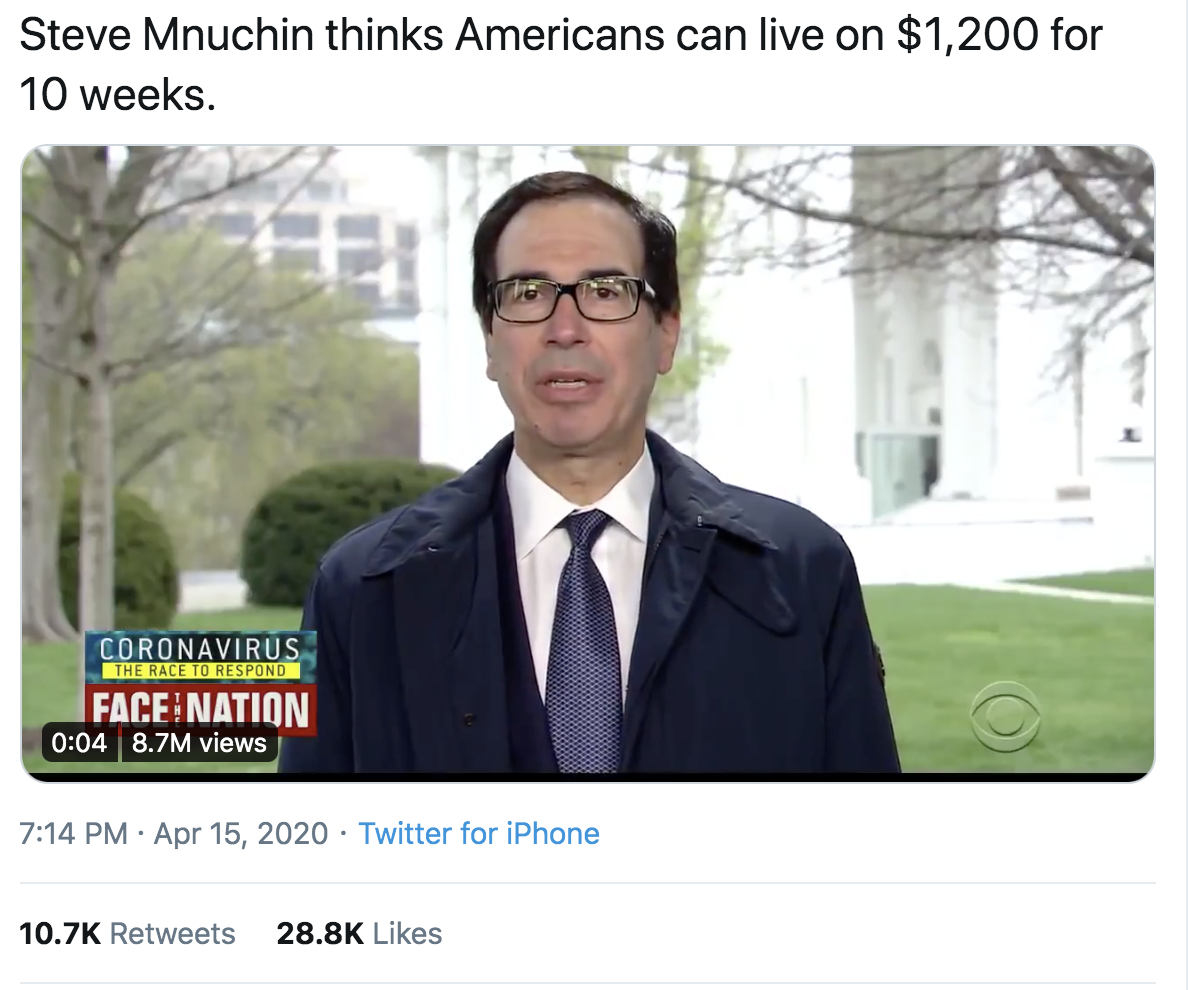
Your Wealth Is No Longer Stolen Via Inflation
Governments and central banks who have permission to print and issue currency devalue your hard earned money without your consent. Inflation rates vary in different countries, so depending on where you’re reading this from, you may have different short term views; as foreign currencies may inflate faster or slower than yours. But after enough time, your money is devalued costing prices of goods to rise and costing you more. More fiat, more time, and more effort just to keep purchasing the same good you used to. This makes it harder to raise a family (as I’m sure all parents can agree from experience it’s not cheap) and really progress in life.
You were born and forced into a broken system, you didn’t choose it. And ever since January 3rd, 2009, you now can choose a better financial system. You have to power to choose deflationary hard money over inflationary soft money. The chance to hold onto your money and have the potential to increase its value without the need for investment. The answer can’t be any clearer, now it’s on you to have to courage to act on it.
Eventually, we will see hyperinflation from the trillions and trillions bound to print. Families’ entire savings getting wiped out, small businesses getting obliterated, and more tragedy. There are so many reasons as to why this will happen, and once you get into Bitcoin, it seems like you’re on edge like this could happen at any moment (especially after seeing what happened in Venezuela these past couple years). But do not underestimate how long governments can kick the fiat can down the road for. Because unfortunately, the US government is not giving up their power without a fight and will do anything to keep their precious fiat top dog.
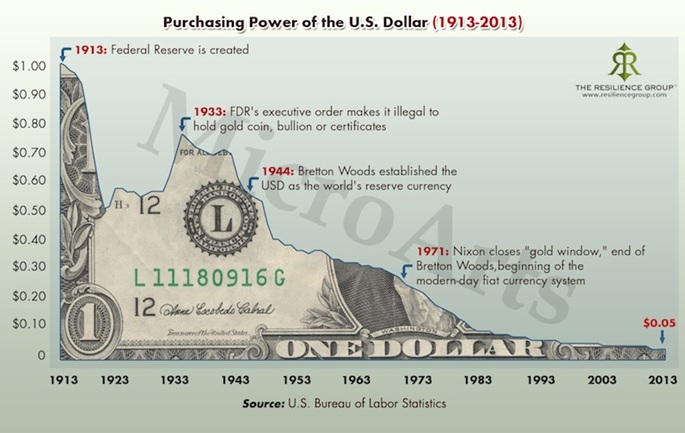 “Bitcoin is a bubble and will go to $0” - People who religiously hold this garbage.
“Bitcoin is a bubble and will go to $0” - People who religiously hold this garbage.
Conclusion
It is unfair and has proven to be criminal to let a few select people rule over our monetary system. Bitcoin gives everyone a level playing field at the cost of corrupt officials. Since they are no longer in charge, their days are over. Following the guidelines of computer code with decisions made by social consensus is much more “human” than these lizard people will ever be. Bitcoin saves you from inflation and gives you freedom and privacy where you need it most. Human governing mixed with the fiat system allows for endless war, which Bitcoin can help put a stop to. The USD is a violent scam, and in result came the peaceful protest that is Bitcoin. Thanks for reading homies, I really appreciate it.
Peace and love,
-Nik
Hey Bitcoin, Slow Down!
By mtcbtc
Posted April 25, 2020
 Modified version of photo by Paulo Carrolo
Modified version of photo by Paulo Carrolo
A look at one humble bitcoin’s mining velocity
It currently takes about 48 seconds to mine a single bitcoin. This is based on a target block completion time of 10 minutes and a block reward of 12.5 BTC. At the May 2020 halving — when the block reward halves to 6.25 BTC — mining velocity for a single bitcoin will slow, for the first time, to above one minute. 96 seconds to mine one BTC.
Over the next three mining epochs, bitcoin production velocity continues to halve every four years. And in just 12 years — in 2032 — we will finally breach the 10 minute mark for mining one bitcoin.
Three more mining epochs and halvings will come and go, with bitcoin production velocity — reliably — dropping each time.
Epitaph, for another half.
In 2044 — 24 years from now — while we’re all eating lunch, miners across the world will (for the first time) compete for >one hour to win just one bitcoin.
Four epochs on, we reach another major milestone in bitcoin’s velocity drop. If you didn’t think Bitcoin was revolutionary before now, brace yourself; some time in 2060, it will take one full spin of the Earth’s axis to mine one bitcoin. Production velocity: >one day per BTC.
12 years later, we slide into 2072. Hardworking miners now require >one week to find a whole bitcoin.
“And on the seventh day, a miner found a bitcoin — and it was orange”
Eight years after this, in 2080, our bitcoin’s mining velocity finally aligns with the maternal lunar cycle. One month to mine one bitcoin. Wen moon? ‘Dis wen, friend. Stick it on an advent calendar and chalk-off the sleeps until Santa drops one BTC down the chimney.
In 2096 — the final halving before the turn of the next century — we will see one bitcoin’s production pace match Earth’s orbit around our star. More than one year to mine one bitcoin. Cosmic!
If we had started mining bitcoins in 2009 at 2096’s pace, our $140BN market would be shared by just 11 bitcoins. How’s your cold storage coping with that? I’d be sending mine to Antarctica. In a fridge. Set to zero degrees. Kelvin.
But hodl onto your sats, because in 2108 we drop to bitcoin being mined at a glacial pace. It would take 10 years to mine one bitcoin now — if there were any whole bitcoins left to be mined! But, alas, there won’t be; Satoshi’s Wholecoiner Inn is closed now, sorry. Try the folks over in Satsville.
And get this.
By 2112, one lucky miner could get married, start a family and celebrate 25 years of wedded bliss in the time it would take to mine one whole bitcoin. Still think you’re too late to this party? LMFAO! 🤣
Four years later, we hit 2116. It’s time to mark bitcoin’s mining pace now equalling 50 years; a “golden” anniversary. Congratulations!
“But what’s gold, Daddy?”
In 2120, singular bitcoin production now operates at a rate that we mortals struggle to match. >100 years are now needed to mine one bitcoin. Honeybadger running at centenarian pace. And she still DGAF!
In 2124, the rate slows again (like a psychopath) and we hit a tectonic rate of knots. 200 years to mine one bitcoin. Oh my!
At the very next halving, in 2128, we are down to one bitcoin’s production speed clocking 400 years. If you could walk that backwards in time, you would stand a chance of stopping central banks from getting a stranglehold on England. Legend status from all of mankind: unlocked.
2132 sees the arrival of yet another pace drop — now >800 years to mine one bitcoin. Want to go back and see the Magna Carta being signed? Make it happen on-chain with at least three confs, my dude.
And finally, 2136 will bring us the last halving event. The final hardening.
None of us will be there to see the next four years of the final mining epoch unfold, but our wealthy progeny might. And if they’ve looked after their private keys — with the grippiest of grips — they might get to meet the one lucky miner who wins the last satoshi. If they do, I hope they congratulate them on the fact that it took more than 8 minutes to win that sat!
What will life be like for our offspring then? Will there be time machines by 2140? If there are, maybe they’ll retrace the 1600 years it would now take to mine just one bitcoin.
They could go back to Ancient Rome.
They could take Satoshi’s white paper.
And they could teach them about this thing called Bitcoin.
It might just save us all a whole lot of trouble.✌️
Written with 🧡 during 🦠 by @mtcbtc
Make sense? New to Bitcoin? Got comments/questions? Fire them at me @mtcbtc. I’m working on a Bitcoin-flavour project so follow me if you want to be first to know when it goes 🚀
Shout out to my brothers and sisters in the Bitcoin world. Satoshi 🙏, Hal (RIP), the cypherpunks, the coders, builders, writers, podcasters, artists, miners, full node runners, toxic maximalists, the steadfast sentinels, the quiet revolutionaries, the rabidly curious and the insatiably free. You are the blocks beneath my sats and we’re gonna f***ing win 👊
Dear Family, Dear Friends,
A letter to all of you who still have no bitcoin.
By Gigi
Posted April 27, 2020
I am writing this letter because I am convinced of two things: (1) our current money is fundamentally broken (2) using superior money will benefit you in particular — and society in general — in the long run.
Money is a touchy subject — most people don’t like to talk about it, either because they have little and are ashamed, or because they have lots and are afraid. Even fewer people know anything about the nature of our money, which is quite shocking — after all, money is an essential tool of our civilization.
The world has changed drastically in the last couple of decades, as has the world of money. I’m afraid, however, that the underlying nature of our monetary system has not changed for the better. The simple fact that governments around the world are conjuring up trillions (with a T) of dollars out of thin air is a testament to how disconnected our monetary system is from reality.
I hope that this letter will plant the seeds for a better future. A better future for you, personally — and a better future for us all. In part, I am writing to you because I’m worried about what is yet to come. And yet I am hopeful, because this time, we have a way out — we have a Plan B.
Plan B
By now, you have probably heard about Bitcoin. It is a household name, frequently featured in major news outlets, on TV (I’m looking at you, CNBC), and referenced in pop-culture (The Simpsons, Mr. Robot, Silicon Valley, The Big Bang Theory, Grey’s Anatomy, Family Guy, and The Simpsons again). Whatever you might know or think you know about Bitcoin — there is more to it than meets the eye.
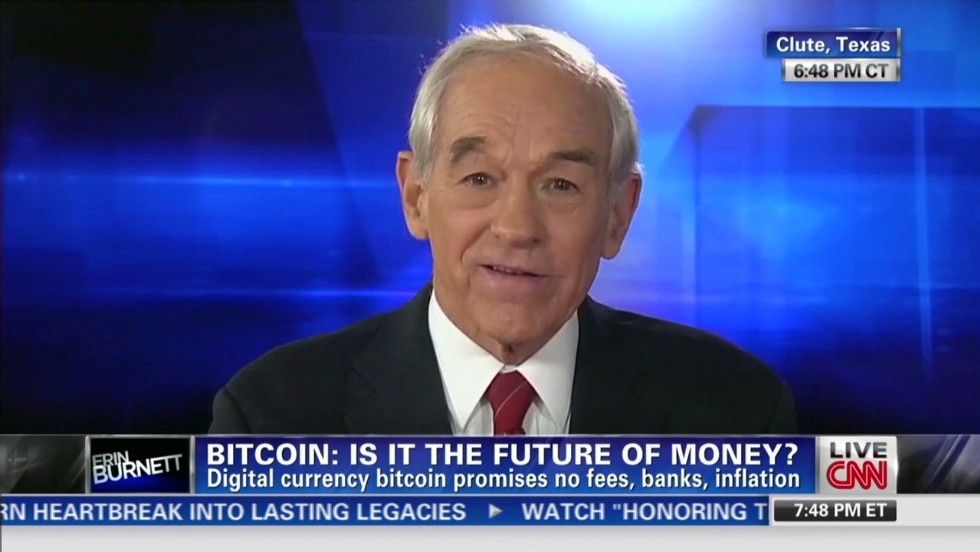 Bitcoin: it is the future of money.
Bitcoin: it is the future of money.
While Bitcoin has been covered in the mainstream media quite a bit, what Bitcoin is and what its role in the world will be is still widely misunderstood. However, in part thanks to more and more reckless monetary interventions by the Fed and similar institutions, even the mainstream narrative is beginning to shift. Bitcoin is not a synonym for criminality and darknet money anymore. Today, it is more and more becoming a synonym for sound money, a hedge against the current system, a vote for freedom, a different paradigm.
If you are reading this and still have no bitcoin you might want to think about starting to get some. It was never as easy as it is today to get your hands on some sats (tiny fractions of a bitcoin) and become an early adopter of the global money of the future.
Be warned: I will not tell you how Bitcoin works. I will not tell you about its captivating history, or its mysterious inventor, or about the marvelous design, cryptography, and game theory behind it. I will not talk about economic theories, or monetary properties, or the history of money. There are plenty of resources that go into that. After all, this is supposed to be a letter, not a book.
However, since I care about you, I will tell you one thing, over and over again: start stacking sats, as soon as you can.
Start Stacking Sats, Today
You might think that you’re late to the party, that the ship has sailed. Wrong. You’re still early. Bitcoin will continue to march on, growing in size and value, eating up the government-controlled fiat currencies that rule the world today. How do I know that these are still early days? Well, while most people have heard about Bitcoin by now, very few people own or use it. Further, if we compare the market capitalization of Bitcoin to other assets and/or monies, Bitcoin still has tremendous room for growth.
As of this writing, Bitcoin’s market cap is around $137 billion. The total market cap of gold is around $9 trillion (~65 times larger than Bitcoin). That of real estate, globally, is $228 trillion (~1664 times larger). Bitcoin may capture some (in the case of real estate) or all (in the case of gold) of this value, demonetizing these and other assets in the process. Again: these are still early days.
“We are in the process of repricing the world in sats.” — Bitcoin Tina
Granted, buying and holding bitcoin is nuanced. It is easy to shoot yourself in the foot. It is easy to get scammed. It is possible to lose access to your bitcoin for good. Thus, a word of warning: educate yourself, and err on the side of caution.
Unfortunately, I didn’t have a “Bitcoin Guy” who understood what was going on. I didn’t have this one friend who told me “trust me, just buy some bitcoin” — or, even better: “trust me, just buy a little regularly.”
So I would like to be this Bitcoin Guy now, for you. Here is what I would say to you, as a friend: “start stacking sats, today.” If you already do, good. If you don’t, start stacking. It’s not that difficult!
Why Bitcoin Is Necessary
We, as a society, need Bitcoin more than it needs us. Money is an essential tool for any large-scale cooperation. It is a measuring device, a solution to the problem of barter, a vehicle to store your wealth over space and time, and many other things. In short: money is essential for a complex society to function. However, a series of financial crises and recent events around a certain virus outbreak have clearly shown that our money is fundamentally broken.
“The root problem with conventional currency is all the trust that’s required to make it work. The central bank must be trusted not to debase the currency, but the history of fiat currencies is full of breaches of that trust.” — Satoshi Nakamoto
The virus not only reminded us of the fragility of human life, but it also revealed the fragility of our supply chains and other global systems. In particular, it highlighted the ridiculousness of our financial and monetary system. In a matter of days, we went from printing billions to trillions, to proposals of minting trillion-dollar-denominated platinum coins, to unlimited QE and infinite cash. Economists and politicians speak of saving the economy, of injecting liquidity, of quantitative easing, of reverse repurchase agreements, of bailing out those who are too big to fail (again) — of doing everything in their power to prolong the inevitable collapse, to kick the proverbial can even further down the road.
While the lingo is fancy, the repercussions are simple: an essential tool of our civilization is bent and distorted. Hyperinflation is what happens when this tool finally breaks under constant pressure. Hyperinflation or not, the repercussions for the individual are always the same: the money you save gets devalued, its purchasing power diminished. Whether your money is sitting under your mattress or in your bank account doesn’t even matter.
“The world has gone mad and the system is broken.” — Ray Dalio
As Ray Dalio explains so eloquently: our debt-based system of money is inherently broken. Bitcoin fixes this. It fixes this because it is not based on debt. It fixes this because it has a strictly limited supply. It fixes this because it can’t be created arbitrarily; because there are no gatekeepers, no central powers that might corrupt it.
Bitcoin is the antidote to modern monetary theory. It is necessary to straighten out the crooked world of fiat money.
The Best Money We Ever Had
Bitcoin’s monetary properties are designed from the ground up to be superior to all other forms of money. It is extremely portable, perfectly scarce, highly divisible, easily verifiable, durable, fungible, and extraordinarily resistant to censorship. As a friend of mine likes to say: Bitcoin is pieces of super-gold flying inside an unstoppable PayPal. It is the best money we ever had.
No central authority bestows these properties upon bitcoin. They emerge naturally from within the system, a fact that is as beautiful as it is important. Thus, Bitcoin is the people’s money: for the people, by the people. Not controlled by anyone; auditable and useable by everyone.
“Buy land. They ain’t making any more of the stuff.”
Will Rogers had the right idea: scarcity has value. However, as a store of value, Bitcoin is superior to land (and gold, for that matter) in many ways. No other asset can be magically beamed across the internet or other communication channels. Bitcoin has the highest value density of all assets since it is pure information. You could have a billion dollars worth of bitcoin in your head, retaining your wealth even if stripped naked.
While there are many misconceptions about Bitcoin, the following are probably the most prominent:
- Bitcoin is too expensive
- Bitcoin is old technology
- Bitcoin is too complicated
- Bitcoin is risky and speculative
- Bitcoin will be replaced by another coin
Let’s briefly go through these one-by-one.
Bitcoin is too expensive: To the contrary! Don’t let the “I need a whole coin” unit bias fool you. Bitcoin is still very cheap. However, if you think that way, you’re in good company. People have been thinking that bitcoin is too expensive since its inception. It will always be too expensive if your perspective is still rooted in fiat money.
Bitcoin is old technology: First of all, Bitcoin is a monetary invention rather than a technological one. It aims to replace the monetary base layer of our society — it isn’t the next viral app for your smartphone. Second of all, Bitcoin is improving and evolving at a rapid pace. It’s virtually impossible to keep up with all developments across the board.
Bitcoin is too complicated: Granted, Bitcoin isn’t exactly easy to understand. (But neither is the traditional financial system.) Luckily, as with all other complex technologies, usage doesn’t require complete understanding. If it would, you probably couldn’t use your smartphone, use the internet, or drive your car. And in terms of usage, Bitcoin becomes easier every day. Just like using the internet a couple of decades ago wasn’t exactly easy, using Bitcoin today can be challenging at times.
Bitcoin is risky and speculative: Don’t speculate. Stay humble and start stacking sats. If that’s not good enough for you, how about the fact that a portfolio of 5% bitcoin and 95% cash outperformed stocks on risk and returns every year for the past 6 years? Still too risky?
Bitcoin will be replaced by another coin: Bitcoin is the undisputed king and the only serious contender for digital scarcity. It has the best network effects, the highest liquidity, and the highest security by many orders of magnitude. Nothing else comes close, and I don’t want to waste any digital ink naming any other coin. All I will say about Bitcoin’s copy-cats is this: do not touch them. While the Siren’s song of shitcoins is hard to resist, they are called shitcoins for a reason. Bitcoin can’t be copied. It is a path-dependent invention in a winner-takes-all environment.
“There is bitcoin, and then there is shitcoin.” — Warren Davidson
Shitcoins are a dead end. Don’t go down this path. Nothing but pain and sorrow will await you there.
Why Stacking Sats Is Superior
As of this writing, $1 will buy you 14,488 sats. Spend $70, and you are a satoshi millionaire. Bitcoin is expensive. Sats are cheap.
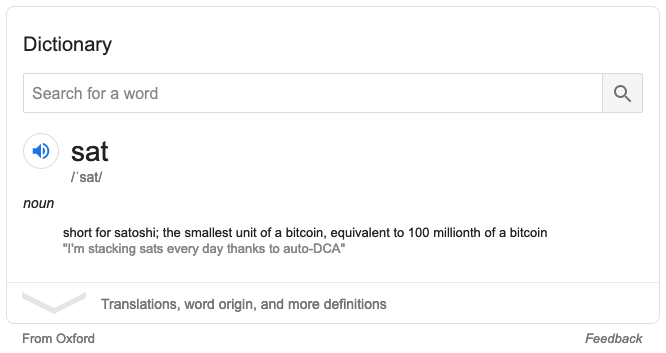 “I’m stacking sats every day thanks to auto-DCA”
“I’m stacking sats every day thanks to auto-DCA”
As mentioned above, bitcoin is highly divisible. Again, don’t let any unit bias fool you: there is enough bitcoin to go around for everyone. Trying to buy large sums of bitcoin usually leads to trying to time the market. Stacking sats removes this psychological pressure. Even better: plenty of services exist which let you automate the process of stacking sats. Set it and forget it, and your stack will grow automatically. No need to worry about the perfect timing, no frantic checking of price, no exposure to custodians.
We all know the old proverb: “The best time to plant a tree was 20 years ago. The second best time is now.” The same is true for stacking sats — only Bitcoin didn’t exist 20 years ago. It is now a bit over 11 years old, bursting into global consciousness just a couple of years ago.
“The best time to buy bitcoin was 10 years ago. The second best time is now.”
The point is this: don’t beat yourself up having a 0% allocation to bitcoin. It’s not too late to get off zero. Again: it’s not too late. You are still early. Currently, you are still able to exchange other money for bitcoin. In the future, you will probably have to earn it. Think of it this way: if the trajectory that Bitcoin is on continues, there will never be a bad time to exchange your fiat currency for bitcoin.
Bitcoin is a game of accumulation. Once you realize that, stacking sats becomes the obvious strategy. Inelastic supply and the relatively small market capitalization make bitcoin more volatile than other assets. (Although, compared to recent movements in the traditional markets, bitcoin is relatively stable.) Stacking sats enables you to ignore the volatility of the market. The focus is on passive accumulation, not trading.
“Bitcoin is a new type of money that is digital and independent of world governments or corporations. It is hard to seize, block, or inflate and easy to send around the world. It is the best money we have ever had. As more people realize this, the price should rise.” — Matt Odell
Zoom out far enough and it becomes obvious that the price movement of Bitcoin is up and to the right. There are reasons to believe that this trend will continue. Even with this upward trend intact, the price of bitcoin will probably remain volatile for quite a while. My advice: ignore the price. Get off zero. Do you still have zero sats to your name? Stop slacking — start stacking!
Some things to remember:
- Don’t trade
- Get off zero
- Automate with Auto-DCA
- Everyone thinks they are late
- You can buy a fraction of a bitcoin
- Trusted third parties are security holes
- Time in the market beats timing the market
- There is gold and there is fool’s gold — stay away from shitcoins
You might think that you don’t have enough money to start stacking sats. I doubt it. If you are reading this, you are probably on level 4 and able to spare a dollar or two per day. Remember: a couple of dollars will buy you tens of thousands of sats. There are also indirect ways to stack sats, such as cashback services that pay you back in sats. You can also kick a bad habit and start stacking sats with the money you save. Two birds with one stone, and all that.
Sats are still stupidly cheap. I’d bet that there will soon come a time where it won’t be possible to acquire tens of thousands of sats for $1. The purchasing power of the dollar is going down continually; the purchasing power of bitcoin has been going up, historically. However, even if the price of bitcoin keeps rising drastically, you will probably still be able to get your hands on a couple of sats for $1 or less for the foreseeable future.
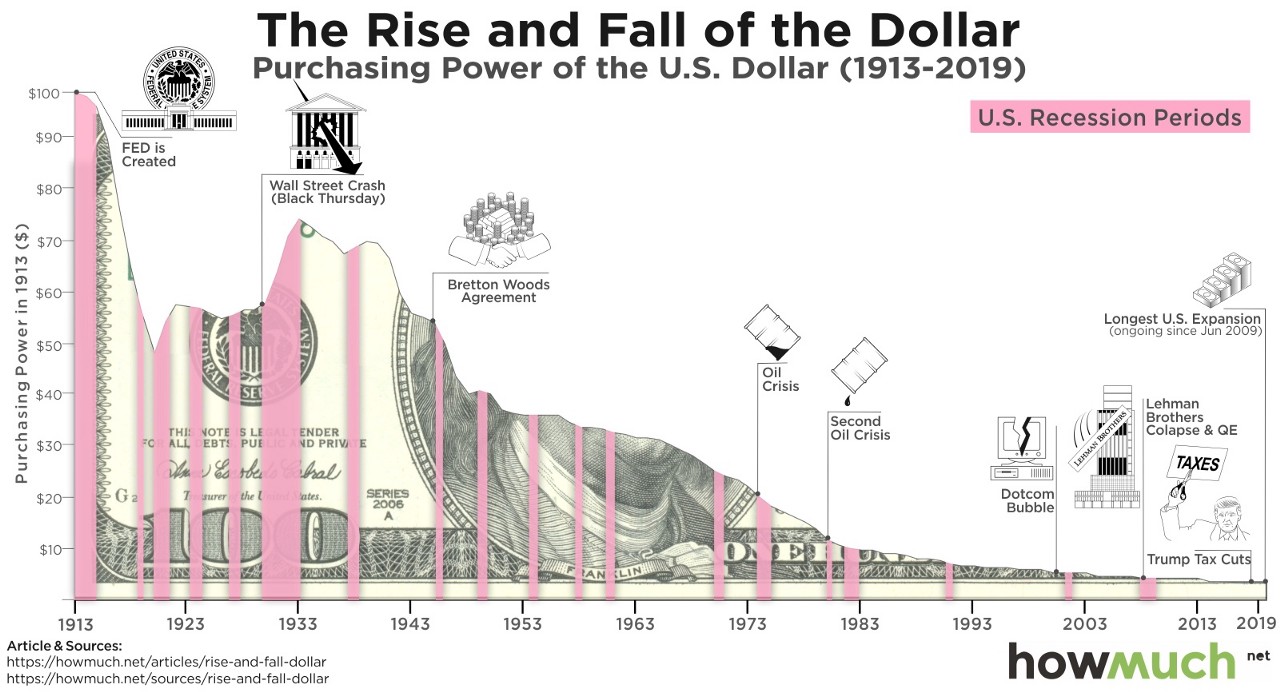 Believe it or not, it can go lower still.
Believe it or not, it can go lower still.
You’re skeptical, I get it. I was skeptical too. It took me a very long time to understand what Bitcoin is about. It took me even longer to trust this magic internet money enough to buy some. And after that, it took me a while to stop trading and start accumulating. I hope to save you some time and a lot of heartaches by passing on the following: start stacking sats. The earlier you start, and the more automated the process, the better.
All that being said, a word of caution:
- Start small. Don’t put in more money than you are willing to lose.
- Stay humble. Don’t get greedy. Don’t over-extend yourself.
- Not your keys, not your bitcoin. Do not trust custodians. Always remember that trusted third parties are security holes.
- Don’t trust, verify. Assume that everyone is a scammer.
- Do your own research. Bitcoin is open by nature, so you are free to study what it is and how it works. I curate a comprehensive list of resources if you need a starting point.
There was never a better time to start saving in bitcoin. Many services exist which let you automatically convert a certain amount of your local currency into bitcoin every week, month, or day. I will refrain from any recommendations here since they might be outdated soon. What the best service is for you is yours to find out. Contact your local friar or the bitcoin guy closest to you. If he doesn’t know what stacking sats means, find a better bitcoin guy. (And if I happen to be that guy, please reach out to me.)
“Owning bitcoins is one of the few asymmetric bets that people across the entire world can participate in.” — Vijay Boyapati
While Bitcoin is an investment in the future, I don’t necessarily view it as a speculative investment. I also do not view it as an asset that is to be sold again for dollars, euro, or yen. As the meme goes: When you’re ready, you won’t have to sell your bitcoin.
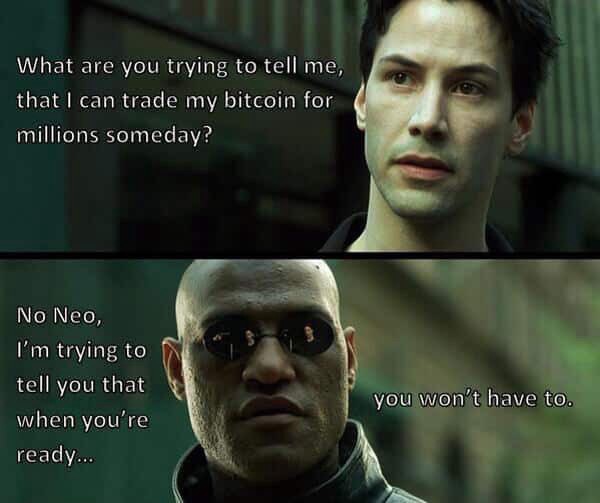 Neo has taken the orange pill and is tumbling down the rabbit hole.
Neo has taken the orange pill and is tumbling down the rabbit hole.
Ready When You Are
Exchanging your fiat money for bitcoin is a move from an inherently unstable system to an anti-fragile one. It is wealth insurance and a vote for a better, more honest base layer of society. I believe that bitcoin still has a very high potential upside. Thus, the sooner you start to get exposure to this emerging money the better equipped you might be to benefit from its rising purchasing power. In other words: you want to start stacking sats as soon as you can. However, I also believe that Bitcoin will be understood by you as soon as you are ready. Consequently, I believe that the first fractions of a bitcoin will find you as soon as you are ready to receive them. “You can lead a horse to water, but you can’t make it drink,” as the saying goes.
You will find that owning bitcoin requires personal responsibility: you will have to do your own research, learn how to use and store it securely, and do many things yourself that are usually done for you by a third party. Nothing in life is free, and the freedoms granted by Bitcoin come at the price of personal responsibility.
In any case, Bitcoin is ready when you are. It won’t go away, and nobody will be able to stop you from acquiring some if you are ready to do so. That’s the beauty of Bitcoin: it will always be there for you, whether you make use of it or not.
Granted, Bitcoin is a strange beast. It is complicated, overwhelming, maybe even a bit scary. However, the sooner you befriend this strange creature, the better you will be equipped for the future. And I believe that the best way to befriend it is to start stacking sats. As a wise old man once said: “Just buy bitcoin, it’s not that difficult.”
Disclaimer: This should go without saying, but I’m afraid I’ll have to make it explicit: This is not financial advice. This is not investment advice. I wrote this letter to have something at hand whenever friends or family reach out to me in all matters bitcoin. I published it because I thought others might find it useful as well. If you don’t know me in real life I’m just a random guy from the internet. I might as well be a dog. Act accordingly.
Get started
- Setting Up Your First Bitcoin Mobile Wallet
- 12-Step Intro to Start Using Bitcoin
- Getting started with Bitcoin
Further Reading
- The Bullish Case For Bitcoin by Vijay Boyapati
- Gradually, Then Suddenly series by Parker Lewis
Further Listening
- Explaining Bitcoin to Traditional Investors by John Vallis
- The Beginner’s Guide to Bitcoin by Peter McCormack
Further Resources
Acknowledgments
- Thanks to Brekkie and Fab for their valuable feedback on earlier drafts of this letter.
- Thanks to Hass for proofreading and his willingness to die on the AutoDCA hill.
Translations
- German translation by ge3onim0 and Fab The Fox 🦊
- Brazilian Portuguese translation by pensaduras
- Portuguese translation by Sparkpay
Dear World: Open Letters in Anticipation of the Next Era
- Dear Legacy People
- Dear Bitcoiners
- Dear Family, Dear Friends
This work is published under the Creative Commons Attribution-ShareAlike 4.0 International (CC BY-SA 4.0) license and also available on dergigi.com

